TEAM BUILDING IN SA PA

Back H’mong women in front of Sa Pa Church. Photo: Exotic Vietnam
Location: 37km from Lao Cai (¾ hour by car), 376km from Ha Noi (5 hours by car or 10 hours by train), 280km from Dien Bien Phu (6 hours by car).
Introduction: At an elevation of 1,500-meters, Sa Pa is Viet Nam’s most picturesque hill station and is well off the beaten tourist track. In 1903, the French founded the village on the slope of the Hoang Lien Son Mountain, known as the Tonkinese Alps and used it as a cool getaway. This place is proud of both its fine, rugged scenery and its rich, diverse culture. From the town center, visitors can look up the Indochina’s highest peak, Mount Fansipan at the height of 3,143m, or trek on trails along crystal clear streams, steep terraced vegetable gardens and dense evergreen forest. Sa Pa is also home to 5 of Viet Nam’s famous ethnic tribes (Black Hmong, Red Dzao, Tay, Giay, and Xa Pho) where their rustic villages can be found within a few kilometers around town. Nowadays mass tourism has been changing Sa Pa quickly with huge crowds, large-sized buildings, record-breaking cable cars and giant concrete pagodas.
Highlights: Mount Fansipan, Ham Rong Mountain, Cat Cat village, Ta Phin village, Ta Van village – Lao Chai village, Bac Ha Sunday market.
Facilities & services: trekking through hill tribe villages, cultural show, restaurants, hotels and international standard resorts & hotels.

Fansipan Peak, with the height of 3,143m, known as “The Roof of Indochina”. Photo: Exotic Vietnam
Mount Fansipan
Founded in 2002 and recognized as the ASEAN Heritage Park in 2006, Hoang Lien National Park aims to strictly protect and preserve its diversity of flora and fauna as well as environment and landscape. Considered the core zone of national park, Mt. Fansipan, the Roof of Indochina at the elevation of 3,143m always gives a breathtaking experience for everyone.
For nature enthusiasts, the trek takes them through tiny remote villages, rainforest canopies, thrilling ridges and deep valleys to its summit in 2 – 3 days from Tram Ton, Cat Cat or Sin Chai. From 2016, mass tourists can conquer Fansipan in just 30 minutes, first take a cable car and then step up on 600 stairs to reach the pyramid topmark.
Huge temples, long staircases, giant Buddha statues were in full bloom right at the habitat of moss-covered trees in cloud forest before. Mt. Fansipan has turned into a large-sized pagoda complex in traditional architecture in the Red River Delta. Many Buddhist-colored ceremonies for devotees and travelers were held there.

A panoramic view from the top of Mt Ham Rong. Photo: Exotic Vietnam
Mount Ham Rong
Mt. Ham Rong lies close to Sa Pa Town, it’s nearly 2,000m high and looks very much like the dragon’s head in the clouds. A climb on stone steps to the peak is an excitement for all visitors. About midway, visitors, taken by surprise, will be in orchid gardens, more than 400 species are in colourful blooms. There is also a folk performance where visitors will enjoy songs and dances performed by ethnic girls and boys. A little further will be a mini stone-forest where thousands of stone columns, pillars that surprisingly open visitors’ eyes. A stroll among these pillars seems to be a walk in the fairyland, then visitors proceed to the heavens gate, a beaten trail leads to the cloud-yard and a TV station. San May (Cloud Yard) is an ideal location to view the whole panorama of Sa Pa.
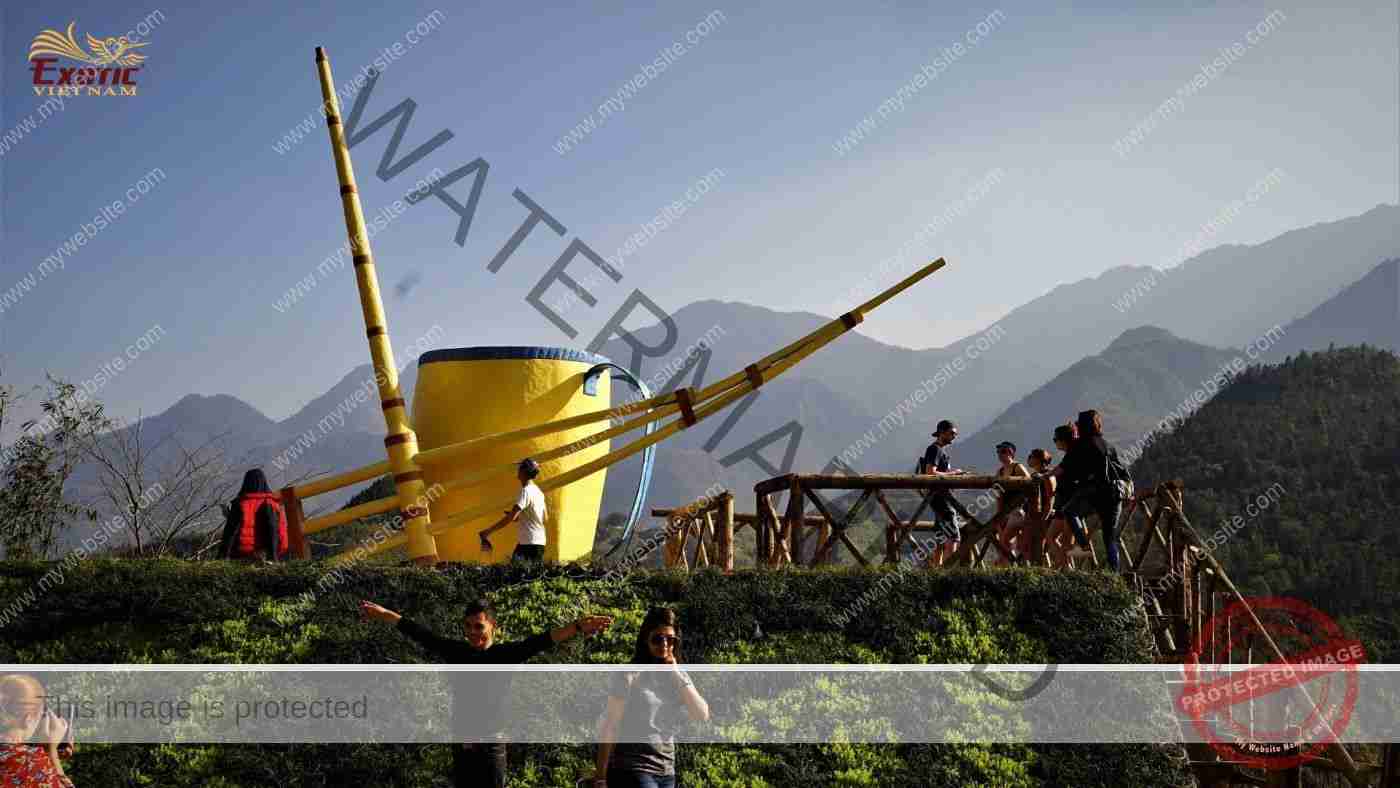
Black H’mong village at Cat Cat, a place of interest with many shops & small parks. Photo: Exotic Vietnam
Cat Cat Village
About 3km from Sa Pa, Cat Cat is the residence of the Black Hmong ethnic people. This village is surrounded by amazing rice terraces and flower gardens, beautiful valleys, rolling green hills and dazzling waterfalls. It’s only a 3-km walk down to the valley where you can visit wooden-roof houses dotted on the hill sides. This village used to be famous for producing fabrics. At the valley bottom, you can relax at the small waterfall where the French built a hydro-power station in 1925. There is the small stage where a traditional performance of ethnic people is presented for free throughout the day. There are too many stalls selling souvenir products originating from other localities. Today, it is rare to see the locals dressed in daily traditional clothes along the sightseeing pathway or maybe the indigenous Hmong really disappeared in their own village.
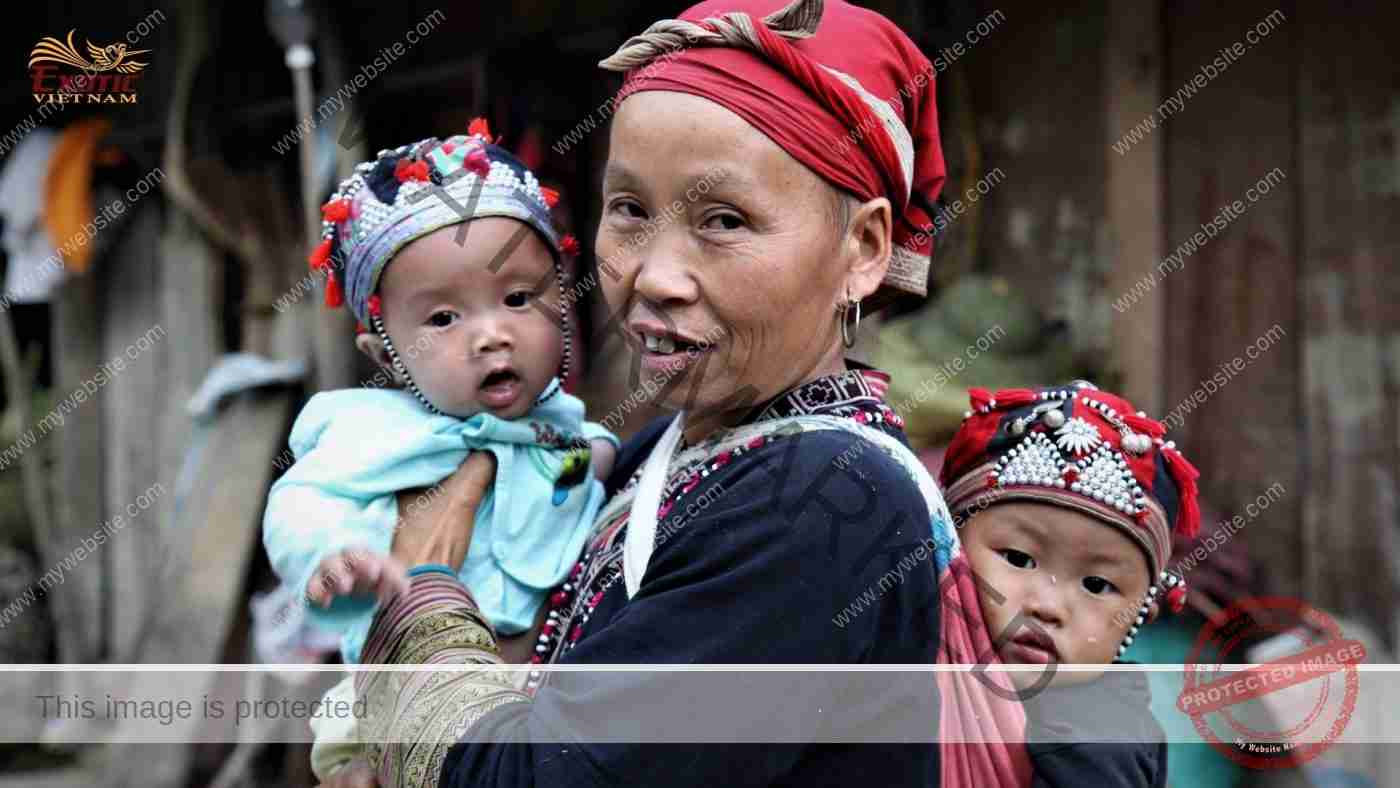
Ta Phin village, where visitors learn about the daily life of the Red Dzao people. Photo: Exotic Vietnam
Ta Phin Village
Only 15km from Sa Pa, Ta Phin has an exotic scenery. It takes visitors only 15 minutes to get there by motorbike or jeep (both are available for hire) with the mountain sloping side of the green terraced fields. On the way to Ta Phin, visitors will see the ruins of a French church. The locals here are mostly Red Dzao. They are very friendly and rich in custom. Their handicrafts are very famous for the colour and embroidery. These products have a lot of unique lines which is reflected in the pattern of flowers, plants, birds… About 1km from Ta Phin headquarter, Ta Phin Cave is about 5 meters high, 3 meters wide and has a pathway to the ground. Inside the cave there are many stalactites sparkling with various shapes.
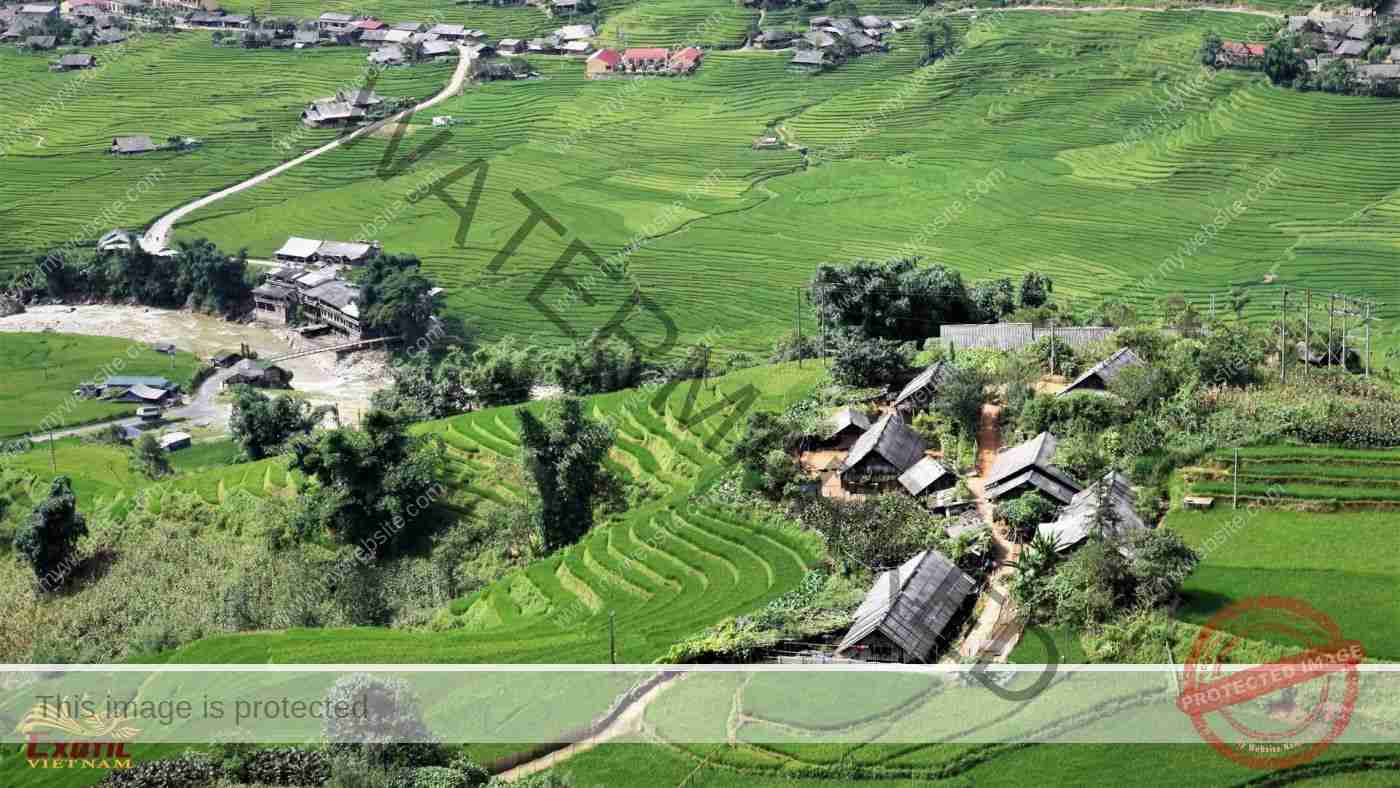
Rice fields and villages of Dzay, Dzao, Black H’mong people along Muong Hoa stream. Photo: Exotic Vietnam
Lao Chai village – Ta Van village
About 7km from Sa Pa, Lao Chai is the residence of the Tay and Day ethnic people. It’s only a short walk there. After visiting Lao Chai, visitors can get to Ta Van village by keeping trekking (5km) around the bottom of Sa Pa valley. Surrounded by mountains and terraced rice fields, Muong Hoa Valley is supposed to be the most beautiful in the area. This is home of many ethnic groups such as Hmong, Giay, Dzao….

Bac Ha Market, held on Sundays, is famous for the vibrant colors of Flower H’mong’s costumes. Photo: Exotic Vietnam
Bac Ha Sunday market
About 100km from Sa Pa, Bac Ha Sunday market is one of the most interesting ethnic markets in Viet Nam and possibly everywhere in South East Asia. It is every Sunday when various hill-tribesmen gather in huge crowds to gossip, exchange the latest news, buy necessities and eat a copious lunch. People come here by horse or motorbike, but most come on foot, from villages as far as 20km away. Although there are several hill-tribesman at the market, the Flower H’mong women stand apart with their vibrant dress. They wear a number of skirts and underskirts all made with very colorful fabric and some batiks. Their tops are embroidered, often with flower motifs, and their heads are covered with elaborately shaped and balanced scarf.
TEAM BUILDING IN HA NOI
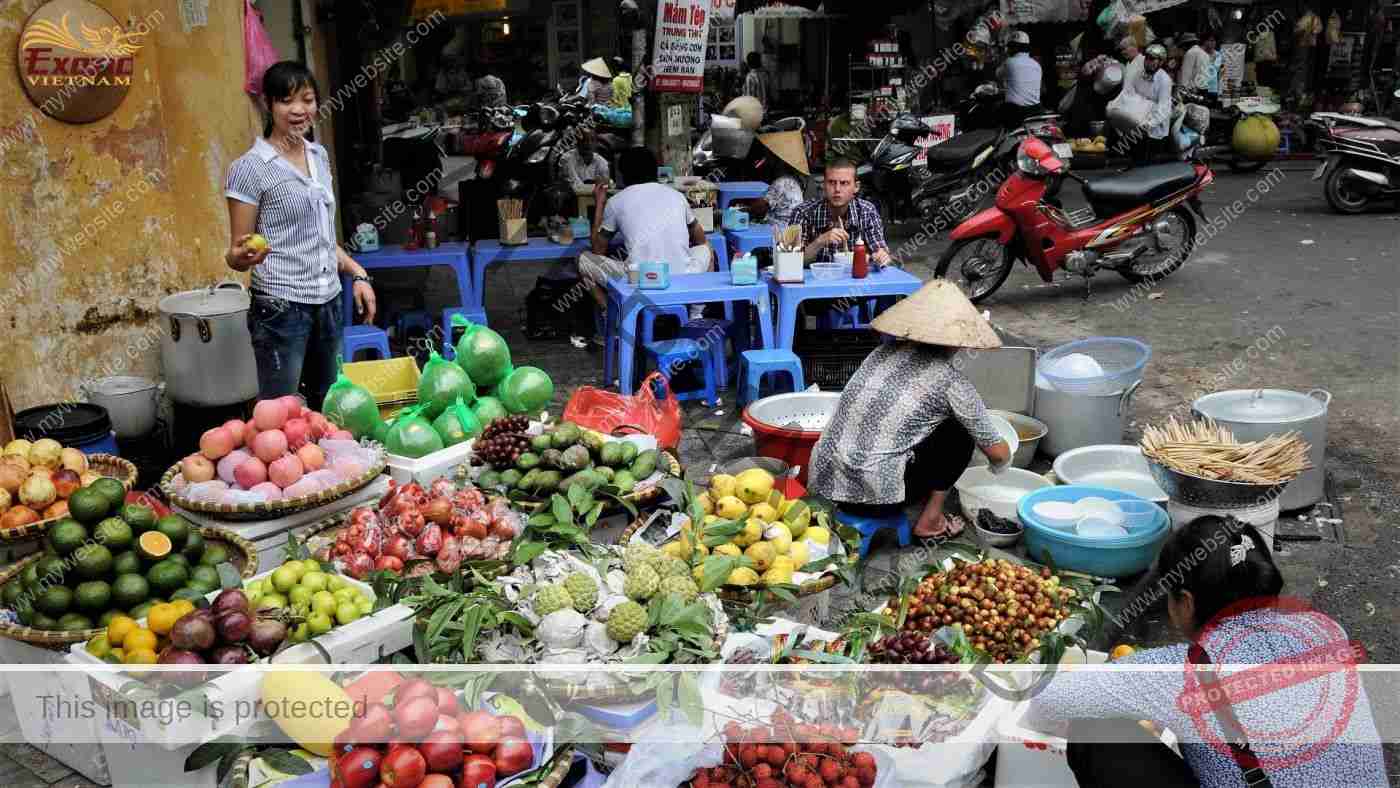
Right in the heart of Ha Noi, visitors can easily find busy small streets with a variety of street foods and seasonal fruits. Photo: Exotic Vietnam
Location: The capital of Viet Nam, 1,760km north of HCM City (1¾ hours by plane from HCMC, 1 hour and 45 minutes by plane from Bangkok, 1 hour and 50 minutes by plane from Hong Kong).
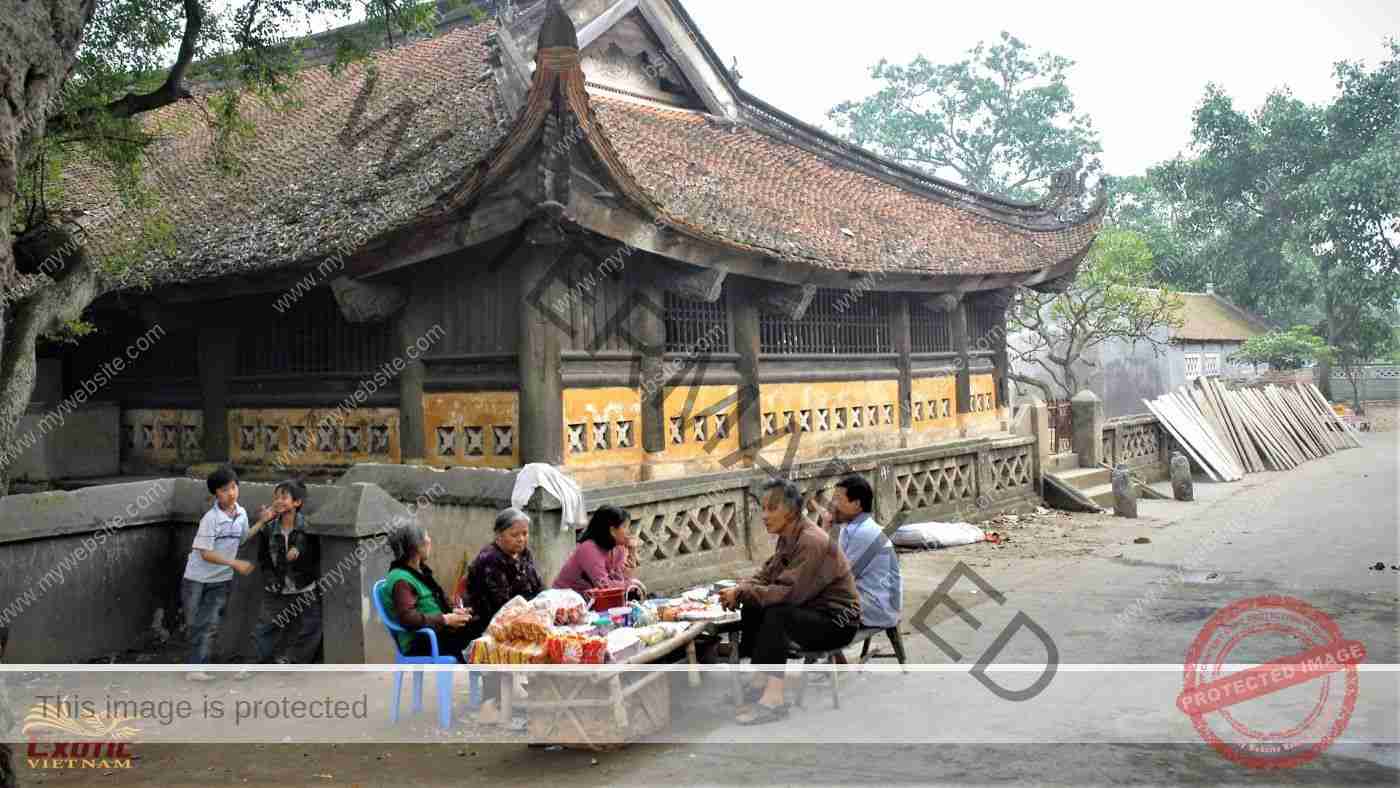
Around the suburbs of Ha Noi and neighboring provinces, images of banyan tree, public well, communal house, etc. surrounded by bamboo ramparts, as well shared interests in the community are the unique cultural features of traditional villages that visitors can find. Photo: Exotic Vietnam
Introduction: Ha Noi, the capital of the Socialist Republic of Viet Nam, is a pleasant and even charming city, in large parts because of its famous lakes, shaded boulevards and verdant public parks. The city center is an architectural museum piece, its blocks of ochre buildings retaining the air of a peaceful and austere provincial town, contrary to the fast-living and bustling air of Saigon.
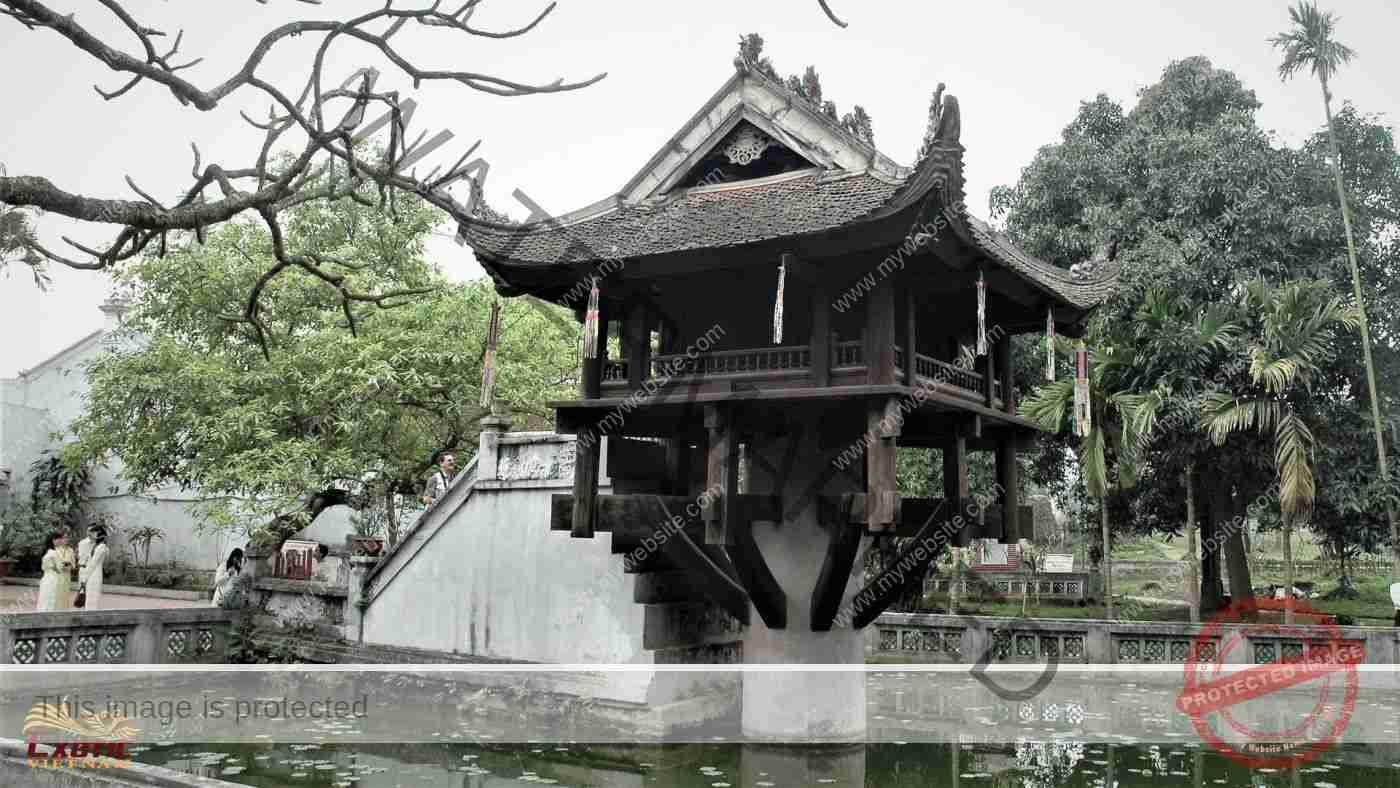
Not only having a long history, One Pillar Pagoda is also impressive with its distinctive style of architecture which resembles a lotus flower in bloom. Photo: Exotic Vietnam
In the past, Ha Noi was first chosen by King Ly Thai To as the capital of the country and was named Thang Long (Ascending Dragon) in 1010. Through several successive dynasties, it remained as the country’s capital city, the heart and soul of the whole nation, and has borne a variety of names, including Dong Kinh (Eastern capital), from which the Europeans derived the name they eventually applied to all of northern Viet Nam, Tonkin. The city was finally named Ha Noi (the city in a bend of the river) by Emperor Minh Mang (Nguyen Dynasty) in 1831. From 1902 to 1953, Ha Noi served as the capital of French Indochina.
The city of Ha Noi is a small part now of Greater Ha Noi (by merging Ha Tay province and a part of Vinh Phuc province into it), which has a land area of 3,325 sq.km and a population of about 8 million. The archaeological site of the Thang Long Imperial Citadel right in the herat of Ha Noi have been recognized as a world heritage site by UNESCO in 2010.
The rich cultural heritage blends in perfect harmony with rapidly growing modernization, as Ha Noi claims its position as the heart of Viet Nam. Ha Noi is also the gateway to places of interest in northern Viet Nam.

A unique mark of Ha Noi is the blend of French-built architectural heritage with the bustling living space of its residents. Photo: Exotic Vietnam
Highlights: The Ethnology Museum, The Thang Long Imperial Citadel, the Fine Arts Museum, the History Museum, the Hoa Lo Prison museum, Lake West & Tran Quoc Pagoda, Lake Hoan Kiem & Ngoc Son Temple, the old quarter, President Ho Chi Minh’s Mausoleum, the Temple of Literature, Duong Lam Ancient Village, Tay Phuong Pagoda, Van Phuc Silk Village, etc.
Facilities & services: an international and domestic airport, international standard hotels, exhibition halls, art galleries, hopon-hopoff city-tour bus, conference centers, international banks, shopping areas, stylish restaurants, theaters, nightclubs, bars, cafes.
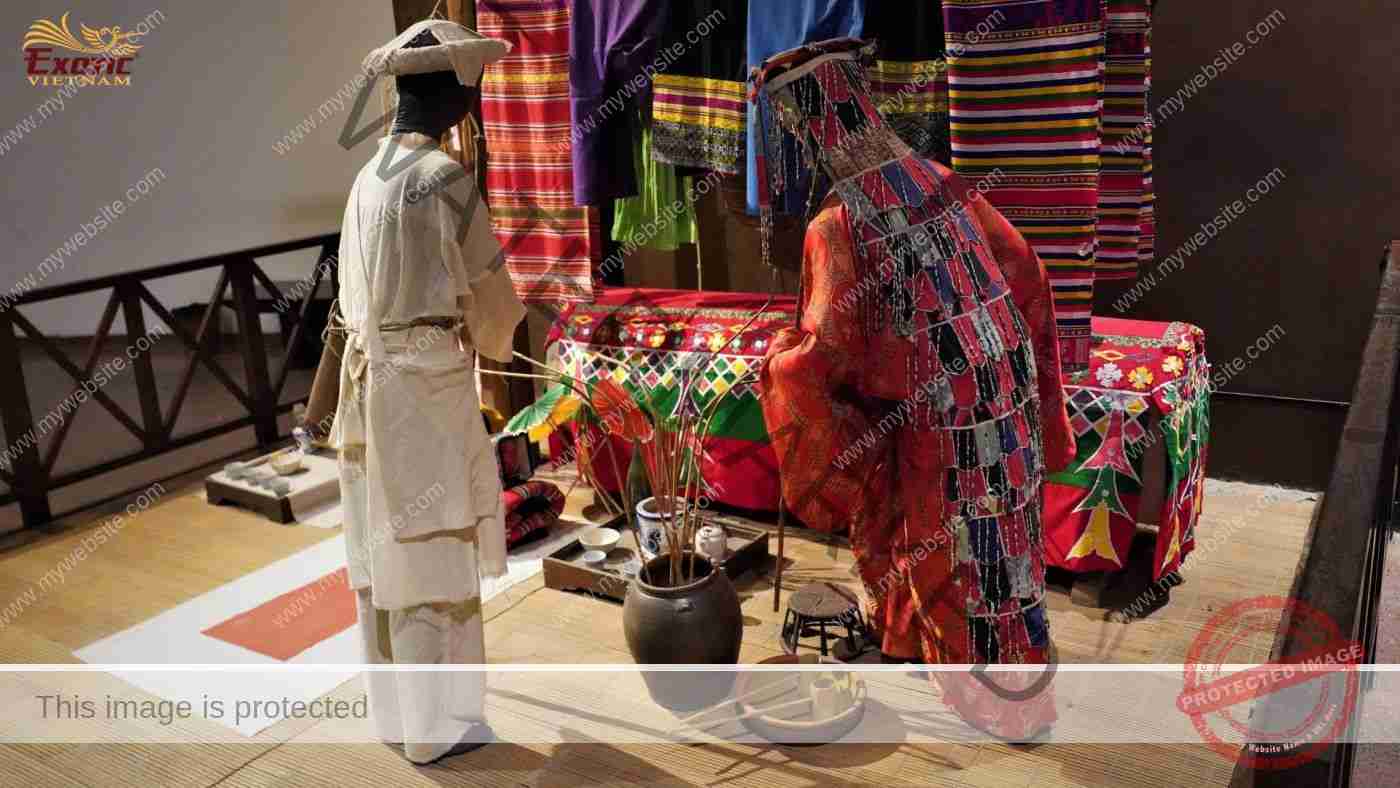
Ethnology Museum is a place to display and preserve the cultural values of 54 ethnic groups across the country. Photo: Exotic Vietnam
Ethnology Museum
Open at the end of 1997, the museum has attracted the attention of visitors, ethnographers and researchers from all over the world. With its astounding collection of 1,000 objects, 15,000 photos and hundreds of tapes about the 54 ethnic groups of Viet Nam, it has successfully recreated the daily life together with the religious rituals and the symbolic festivals of each ethnic group. Its indoor exhibition space can be viewed via a virtual tour which includes the Viet, Muong, Tho, Chut, Tay, Thai, Ka Dai, H’Mong-Dao, Tang, San Dui, Ngai, Mon-Khmer, Nam-Dao, Cham, Hoa and Khmer ethnic groups. There are priceless antiques on display alongside everyday objects such as pipes, baskets and knives. The outdoor display area exhibits a variety of Vietnamese homes as full-scale replicas, with great attention paid to the varying architectural styles set within the authentic and tranquil gardens. In addition, there are also leisure pursuits on display including traditional water puppet theatre and calligraphy.
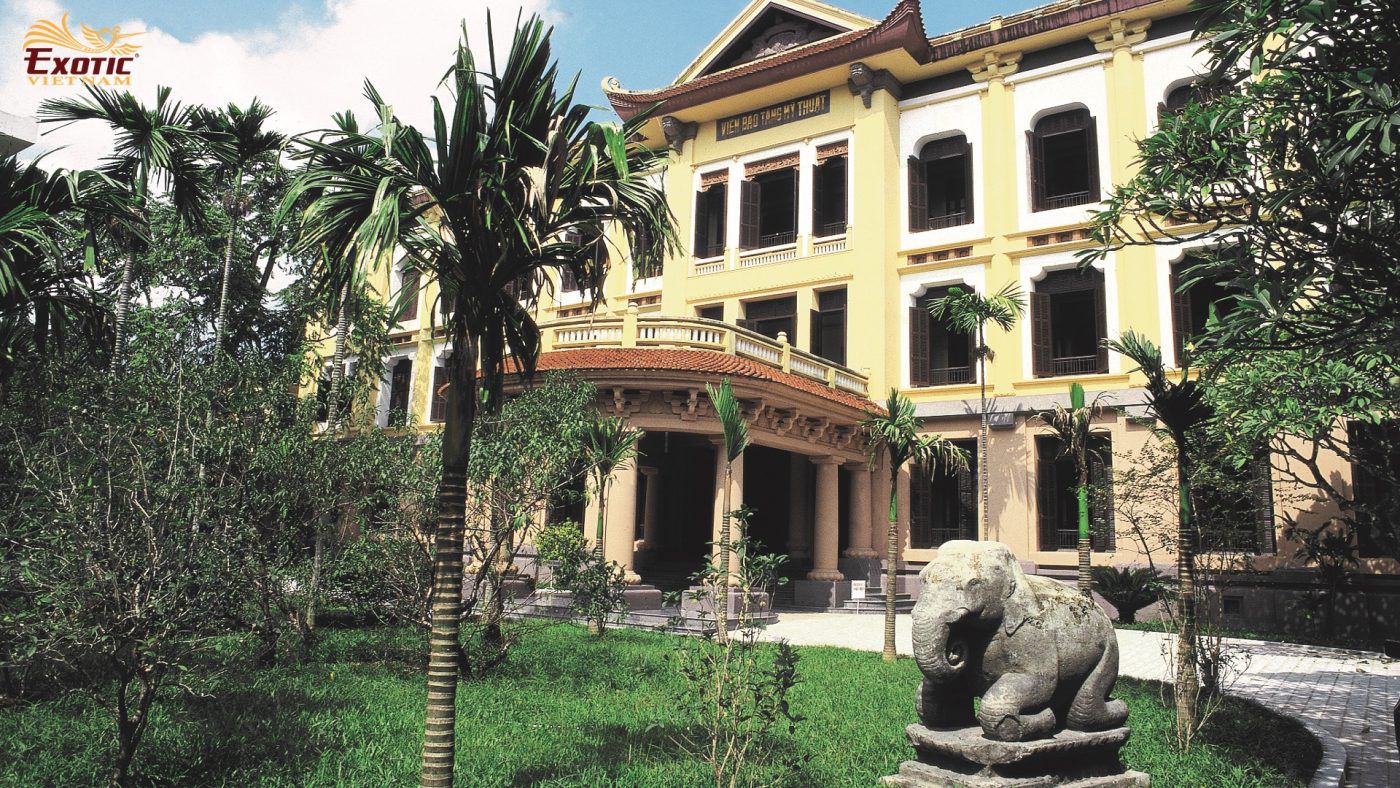
Fine Arts Museum, which keeps a number of national treasures and many famous works of art. Photo: Exotic Vietnam
Fine Arts Museum
First built in 1937 as a Catholic college for young girls in the time of French Indochina. This building superbly mixes Eastern and French architectural styles. In 1966, it officially became Viet Nam Fine Arts Museum where stores many of Vietnamese artistic essences. The museum is divided into 5 different sections: prehistoric art, Vietnamese art from the 11th to the 19th century, Vietnamese art in the 20th century, popular art collections and Vietnamese ceramic art. With 2,000 exhibitions of specific fine arts collections including ancient stone sculptures, antique pottery, ethnic minority paintings, lacquerware, etc. the Viet Nam Fine Arts Museum is a lively historical treasure depicting the origins and evolution of Vietnamese fine arts.

History Museum contains a large collection of valuable objects depicting Vietnam’s history of construction and defense. Photo: Exotic Vietnam
History Museum
Built berween 1926 – 1932, once the museum of the Ecole Francaise d’Extreme Orient, the building remains one of Ha Noi’s most stunning architectural showpieces. It preserves an extensive collection of over 200,000 objects of valuable artefacts from Viet Nam’s turbulent past including prehistory, Dong Son culture, etc. to various Vietnamese dynasties as well as the Vietnamese struggles against foreign invaders.
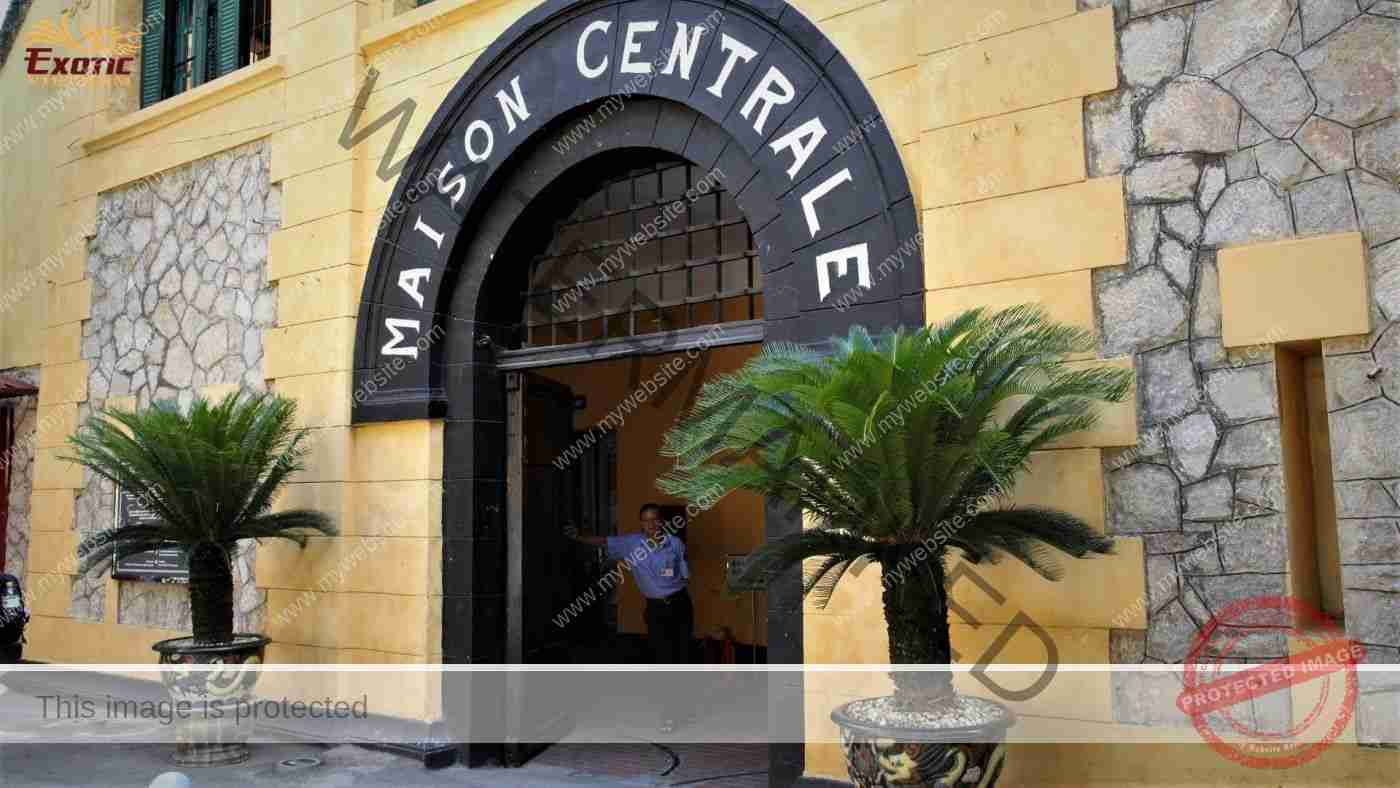
Hoa Lo Prison, where American pilot prisoners often satirize with the name “Hanoi Hilton”. Photo: Exotic Vietnam
Hoa Lo Prison Museum
The remains of this penitentiary, ironically dubbed the “Ha Noi Hilton” by US soldiers who were held captive here during the Viet Nam War, chronicles the experiences of prisoners of war in Viet Nam, from Vietnamese revolutionary martyrs who suffered at the hands of French colonialists to American POWs. Displays include a French guillotine, chilly cells with rusted iron stocks and the flight suit and parachute of John McCain, war vet and later US Senator and Republican presidential nominee. Night tour to visit Hoa Lo has also been introduced for visitor.
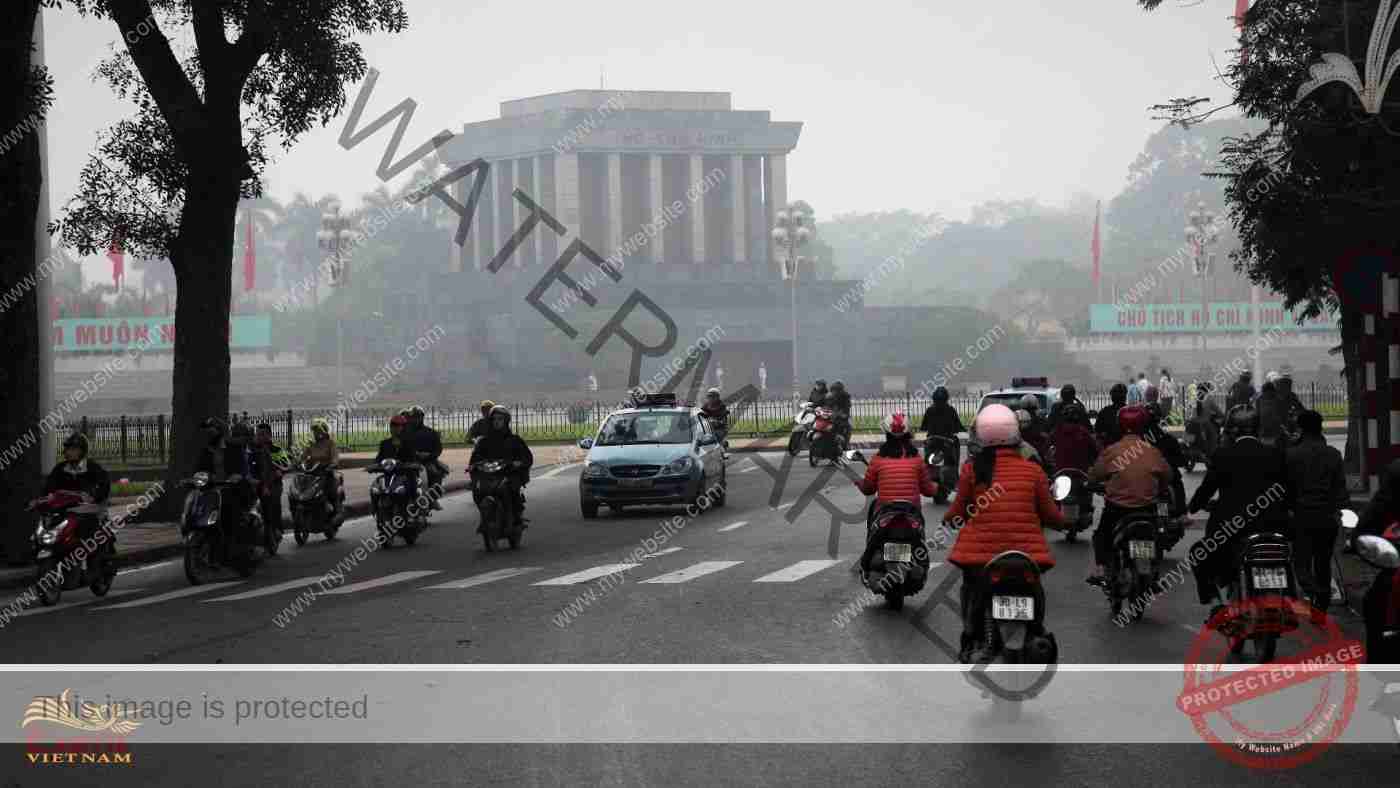
President Ho Chi Minh’s Mausoleum is a part in the complex of Ba Dinh Square, Presidential Palace, Ho Chi Minh’s Stilt House, Ho Chi Minh Museum and One Pillar Pagoda. Photo: Exotic Vietnam
President Ho Chi Minh’s Mausoleum
President Ho Chi Minh’s Mausoleum, the final resting place of President Ho Chi Minh, was constructed between 1973 and 1975 of native materials gathered from all over Viet Nam. It now becomes a site of pilgrimage for Vietnamese as well as for foreign visitors. Just some steps from the mausoleum, visitors can visit One-Pillar pagoda resembling a lotus blossom and also the Ho Chi Minh Museum depicting a view of President Ho’s life.
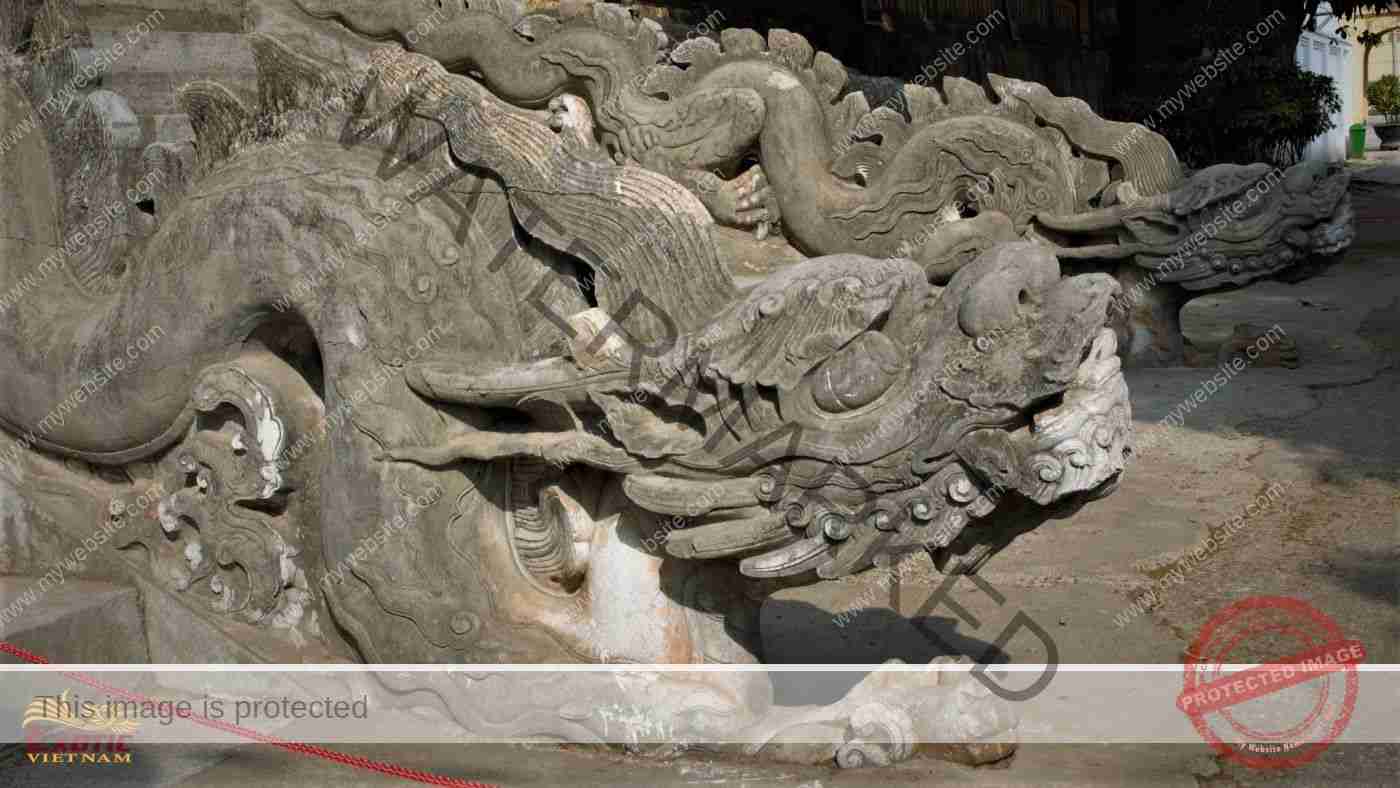
Thang Long Imperial Citadel, a 1000-year-old relic, a UNESCO world heritage site in the heart of Hanoi. Photo: Exotic Vietnam
The Thang Long Imperial Citadel
As the imperial city of Viet Nam under the Dynasties of Ly (1009-1225), Tran (1225-1400), Le So (1428-1527) and Mac (1527-1592), the central sector of the Imperial Citadel of Thang Long is home to priceless cultural-historical relics of Thang Long Imperial Citadel. Recognized as a World Cultural Heritage by UNESCO in 2010, the site contains a lot of invaluable cultural and archaeological artifacts of ancient citadel. These artifacts reflect lively the styles of architecture, sculpture and also culture of each dynasty. There are also top secret command bunkers in the Viet Nam War including military maps and 1960s communication devices that were used by the legendary general Vo Nguyen Giap. Night tour features the fabulous leds and performances that is well worth to visit the museum in the evening.
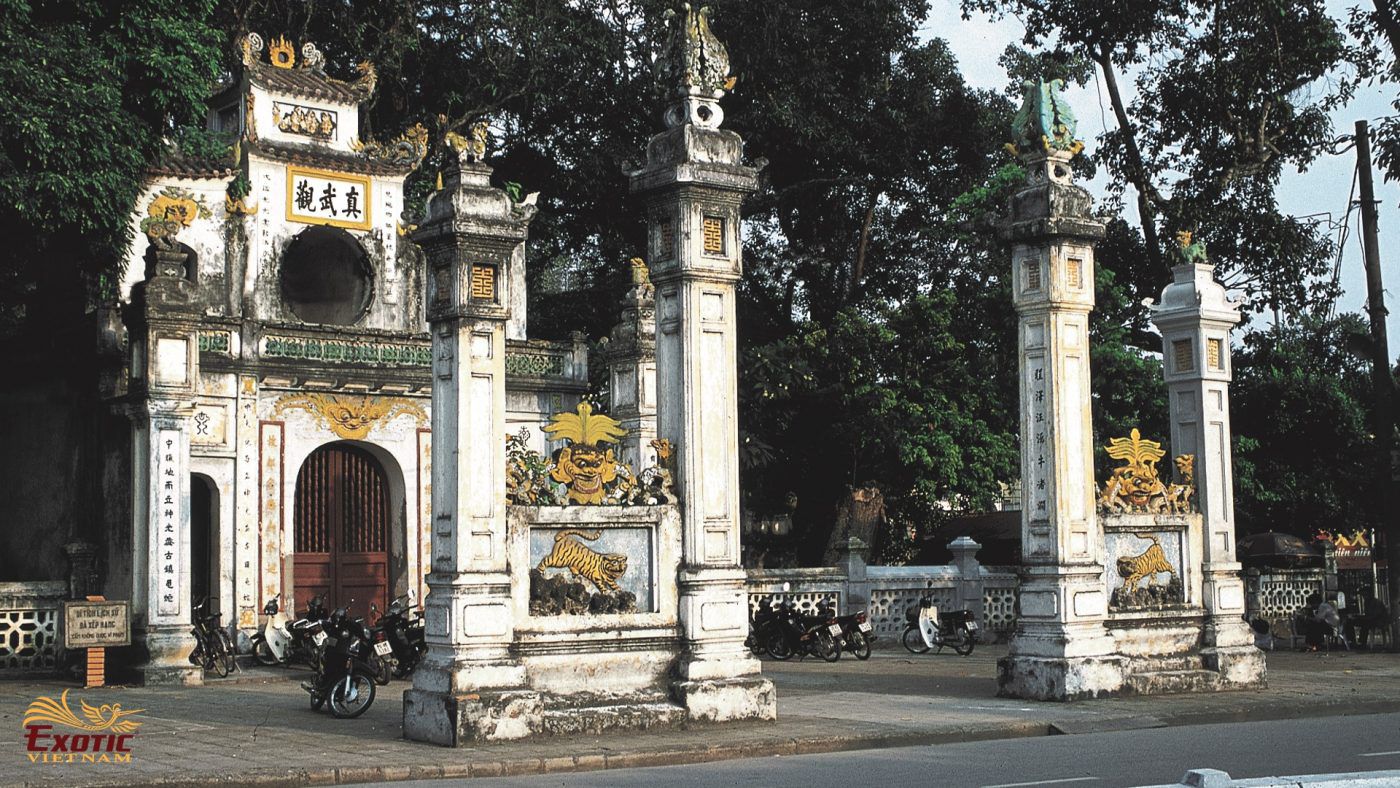
Quan Thanh Temple, one of the historical sites around West Lake. Photo: Exotic Vietnam
Lake West & Tran Quoc Pagoda
Lake West, the largest lake in Ha Noi, and Lake Truc Bach are an attractive part of the city. The two lakes are separated by Thanh Nien St. with rows of willow trees offering a picturesque site in the heart of the country. In the past, West Lake was once a resort for mandarins and kings. Now it is a very popular recreational place for Ha Noians to enjoy fresh air, peaceful atsmosphere and typical dishes. We wouldn’t forget to mention Tran Quoc Pagoda right on the shore of Lake West which is one of the oldest pagodas in Viet Nam.

Amidst Lake Hoan Kiem, The Huc Bridge and Ngoc Son Temple is a cultural symbol of Ha Noi. Photo: Exotic Vietnam
Lake Hoan Kiem & Ngoc Son Temple
Lake Hoan Kiem, considered the most beautiful lake in Ha Noi, is an enchanting body of water right in the heart of the city. Lying on a small island in this lake is Ngoc Son Temple (Jade Mountain), founded in the 18th century and dedicated to the Scholar Van Xuong, General Tran Hung Dao (who defeated the Mongols in the 13 th century) and La To (patron saint of physicians). Ngoc Son Temple is reached via the red-painted, wooden bridge – The Huc (Rising Sun) constructed in 1885.

Old Quarters, as one of the city’s hot-spots, offers an impressive insight into the daily life of Ha Noi. Photo: Exotic Vietnam
Old Quarters
Ha Noi’s Old Quarters of over a-thousand-year history, or 36 streets with each taking a different name after its product, remain one of Viet Nam’s most lively and unusual places, where visitors can buy anything from precious stones to silk kimonos. Some of the specialized streets here include Hang Bac with a trip of snazzy jewellery shops or Hang Ngang with a row of clothing shops and tailors’. Moreover, a stroll through this historic Old Quarter with a stop at Dong Xuan Market is highly recommended for visitors can get a good dose of Vietnamese culture and some insight into the country’s long history. Cyclos or trams are ideal means for visiting the old town.
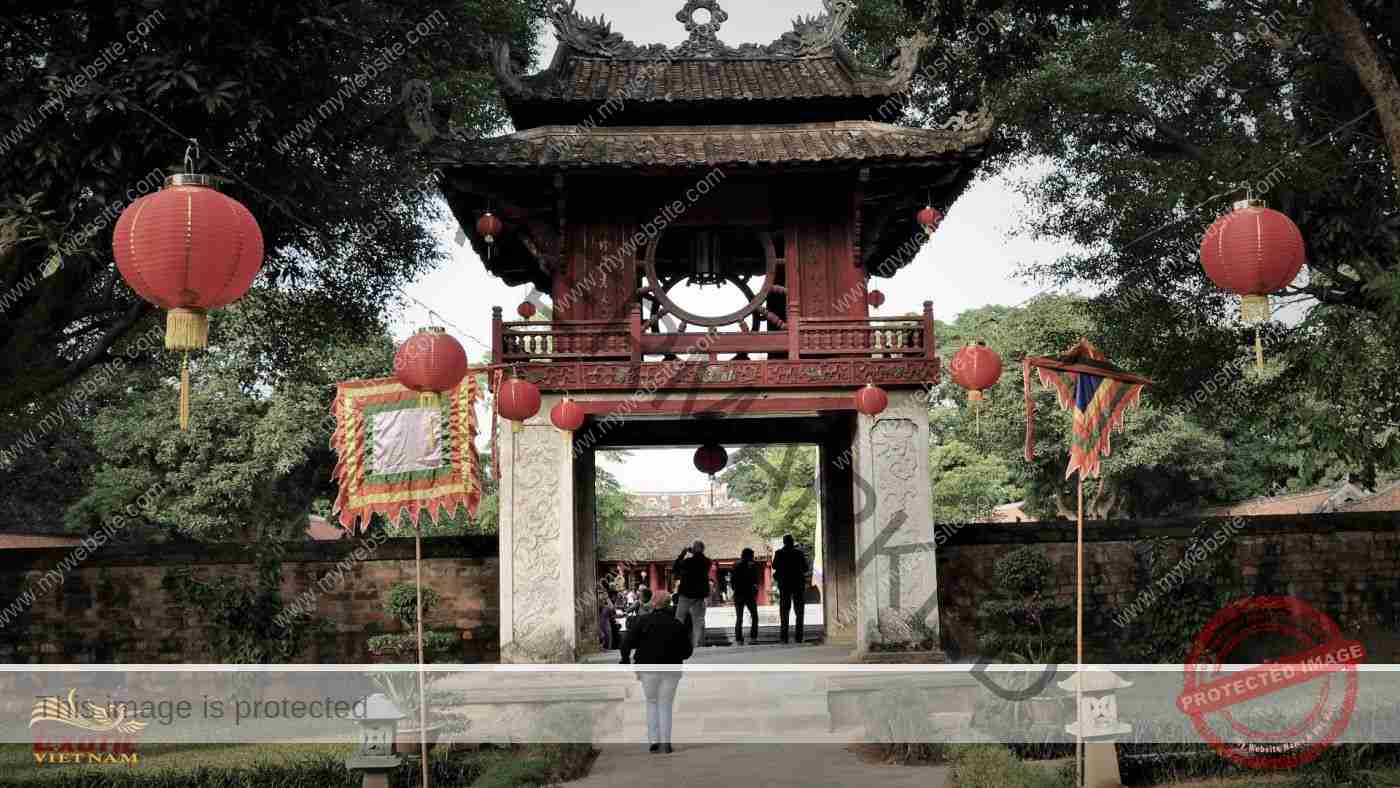
Temple of Literature, an example of well-preserved traditional Vietnamese architecture where is dedicated to the Confucius & honors Viet Nam’s finest scholars. Photo: Exotic Vietnam
Temple of Literature
The Temple of Literature (Van Mieu) is a pleasant retreat from the streets of Ha Noi. Founded in 1070 for the worship of sages of Confucianism, it constitutes a rare example of well-preserved traditional Vietnamese architecture and is well worth a visit. Viet Nam’s first university was established here in 1076 to educate the sons of mandarins. In 1482, King Le Thanh Tong ordered the erection of stelae with inscriptions of the names, places of birth and achievemnets of the graduates who had taken examinations since 1442. The stelae are erected on the tortoise shells which surely give visitors many impressions. Presently, 82 stelae stand at the Temple of Literature. Visiting the Temple of Literature visitors can discover historic buildings from the Ly and Tran Dynasties in a revered place that has seen thousands of doctors’ graduate in what has now become a memorial to education and literature.
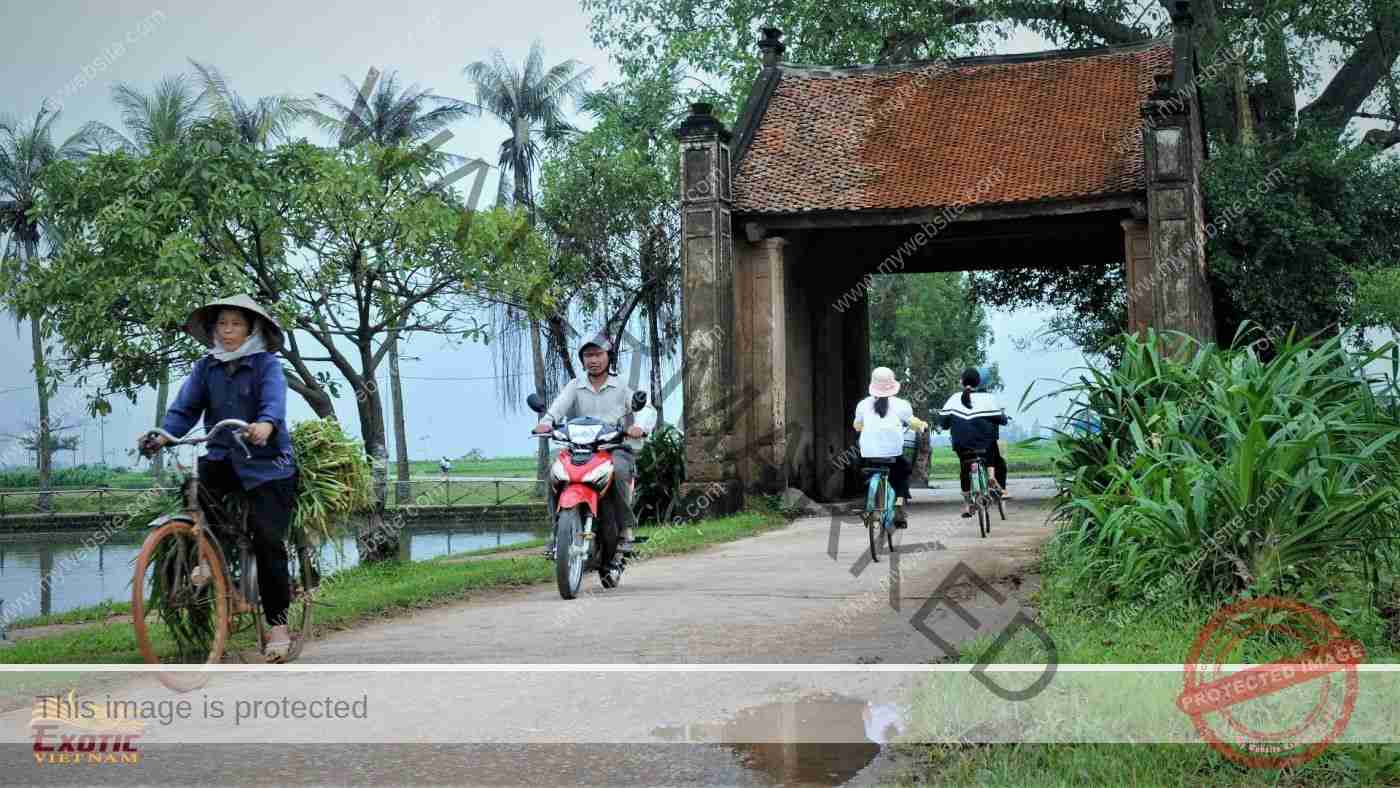
Renowned for its unique laterite houses, Duong Lam Ancient Village preserves typical features of old villages in the Red River Delta. Photo: Exotic Vietnam
Duong Lam Ancient Village
About 48km from Ha Noi, the village boasts of several unique features: a 700-year-old communal house that is surprisingly intact, most of the village built of laterite – an ancient building material, and being the homeland of two famous kings, Phung Hung (767 – 791 AD) and Ngo Quyen (939 – 944 AD). The village is considered as a symbol of Vietnamese country village with ancient temples, zigzagging country lanes, old wells as well as the agricultural life where the people spend almost time on paddy fields and still wear leaves to keep off the rain. For a half-day trip from Ha Noi, visitors can combine a visit to the village with Tay Phuong Pagoda. Mong Phu was being preserved by Japanese experts and will apply to UNESCO to be designated as a world heritage site.
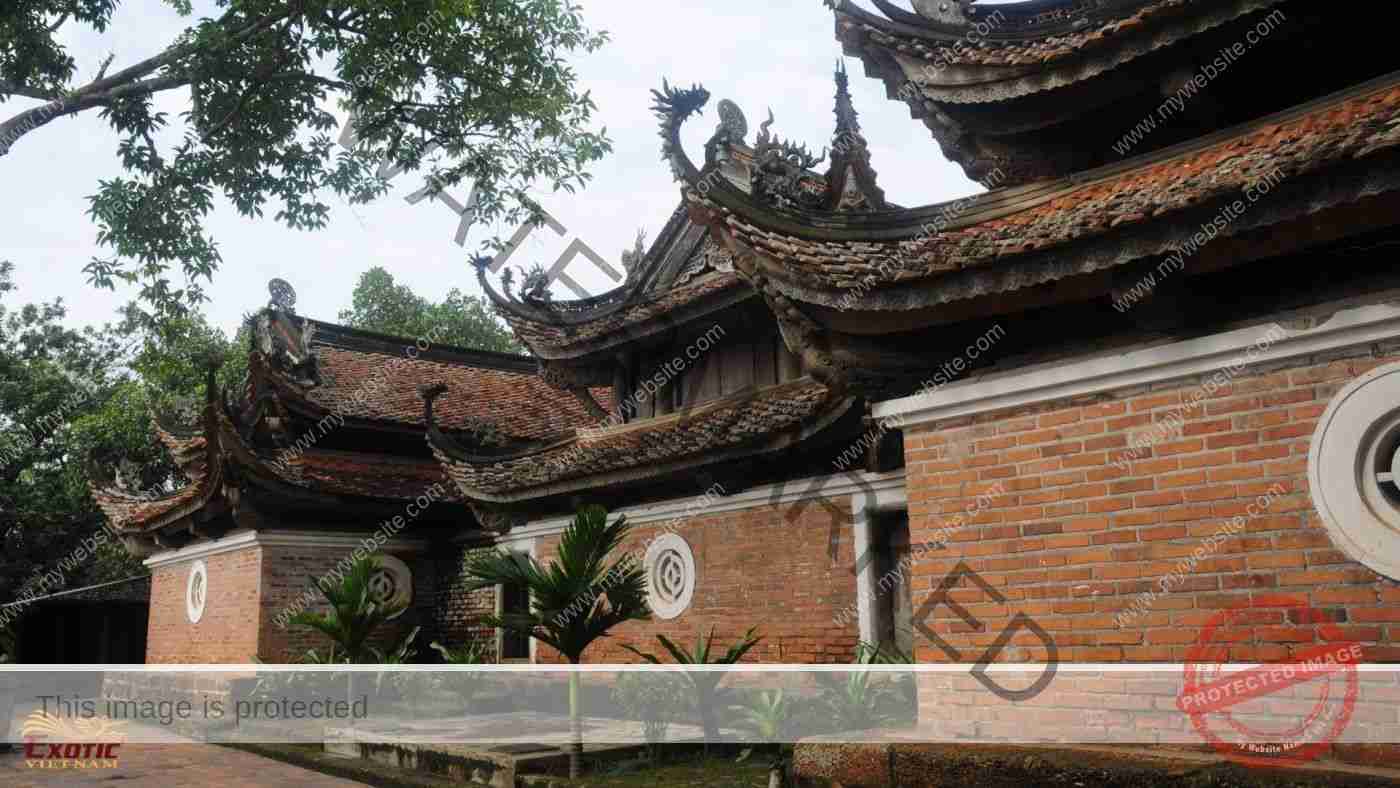
Tay Phuong Pagoda is well known for its collection of invaluable 70 wooden lacquer-covered statues. Photo: Exotic Vietnam
Tay Phuong Pagoda
The pagoda was built in the 3rd century and was undergone several restorations. In 1794 under the Tay Son regime, it was completely renewed, hence its present design. It comprises three successive constructions: the Hall of Prostration, the Main Shrine, and the Sanctuary, all with doubletiered roofs. It seems that this architectural arrangement is inspired by Buddhist and Confucianist thought: the three constructions symbolize the three forces governing the world. All the wooden parts of the pagoda are beautifully sculpted following farniliar folk motifs: mulberry leat Ficus leat lotus flower, chrysanthe mum; dragon, phoenix, etc. But the Tay Phuong pagoda is mostly famous for the statues it contains, magnificent wooden sculptures representing Buddhas as well as Vajrapanis (Kim Cuong) and Arhats (La Han) who are middle-ranking Buddhist deities. One in particular portrays Sakyamuni in meditation at the foot of Tuyet Son (Snow Mountain). He was then leading a life of extremely severe ascetism, and his emaciated body, as represented by the statue, shows good knowledge by the artist of human anatomy.

Van Phuc silk village is renowned for its traditional weaving and premium quality silk products. Photo: Exotic Vietnam
Van Phuc silk village
Just 14km from Ha Noi, Van Phuc is a very famous silk weaving village in Ha Dong. Silk from this area is often called “Ha Dong silk” which has a long history 2,000 years ago and was yearly required to supply to mandarins and kings as “respectfully offer” during the feudal time. Nowadays, almost villagers still produce silk, but roaring generators and clanking mechanized looms have replaced the slow creak of handlooms. Coming to the village, visitors will see the process of the silk weaving from feeding silkworms, getting the silkworm cocoons, unraveling silkworm cocoons, making silk threads and weaving. To buy a souvenir made of real worm silk is a “must-see” for everyone coming to Van Phuc because of her high quality of cloths and garments and warm hospitality of villagers.
TEAM BUILDING IN NINH BINH
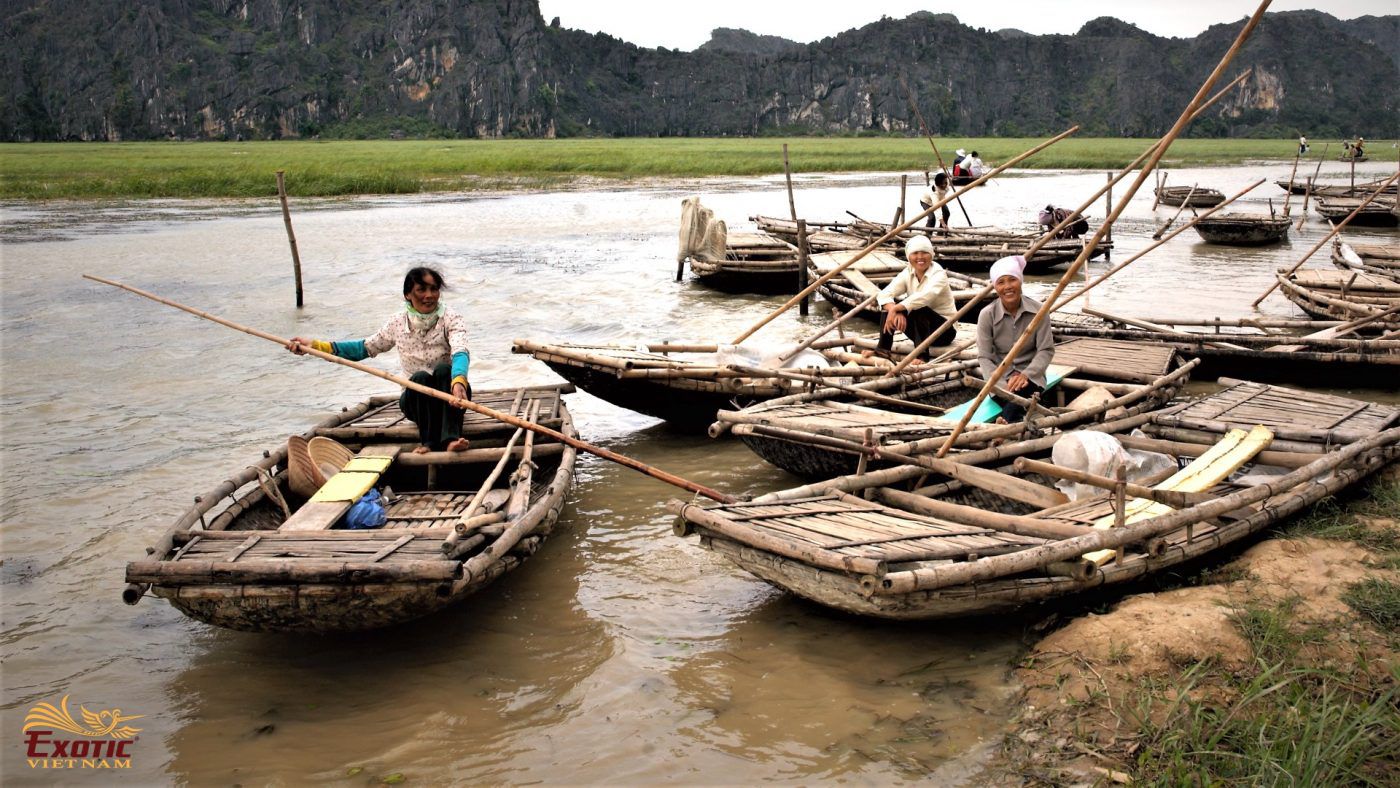
The peace of daily life, the majesty of the limestone mountains and the epic of centuries-old history will bring lasting experiences in the journey to discover Ninh Binh. Photo: Exotic Vietnam
Location: 91km south of Ha Noi (2 hours by car), 122km from Hai Phong (3½ hours by car), 126km from Hoa Binh (3½ hours by car).
Introduction: Ninh Binh is a nice town by Day River, which is surrounded by a number of lesser known interesting sites. In this province, Hoa Lu was chosen as the first capital of the independent Viet Nam, under the Dinh dynasty and the early Le Dynasty (968-1009). There are few remains of the ancient citadel in this provincial capital, two old sanctuaries exist. The area is now widely known as Viet Nam’s “inland Halong Bay” owing to its huge rock formations jutting out of rice paddies. The Trang An Landscape Complex is a mixed cultural and natural property contained mostly within three protected areas: Hoa Lu Ancient Capital, Trang An-Tam Coc-Bich Dong Scenic Landscape, and Hoa Lu Protected Forest. In 2014, Trang An Complex is recognized by the UNESCO as a cultural and natural heritage site.
Highlights: Hoa Lu ancient capital, Tam Coc valleys, Trang An Eco-tourism Complex, Phat Diem cathedral, Cuc Phuong National Park, Van Long Nature Reserve, Bai Dinh Pagoda.
Facilities & services: sampan ride, world class hotels and restaurants.
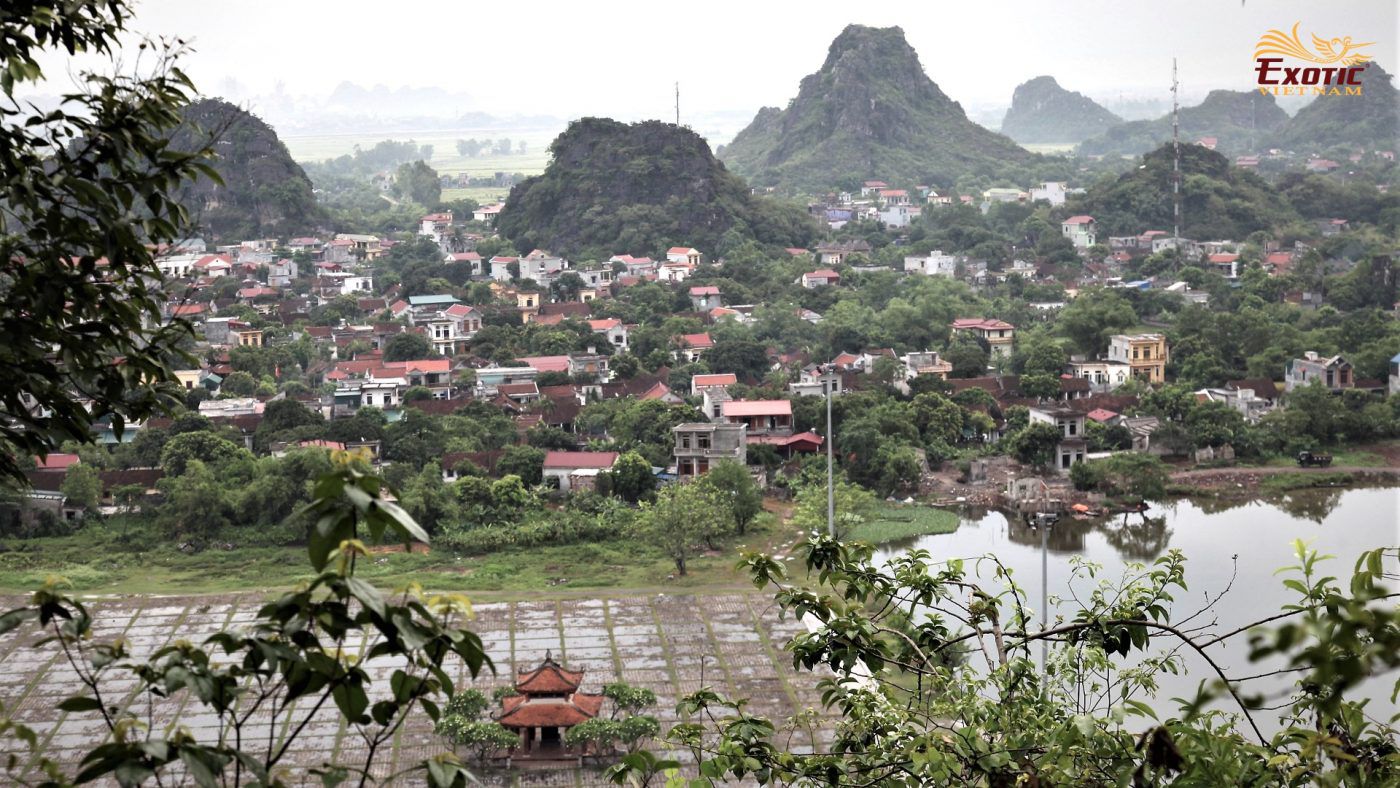
Surrounded by craggy limestone mountains and meandering tributaries like natural walls and moats, Hoa Lu ancient capital was once a strong defensive fortress on a wide and flat valley. Photo: Exotic Vietnam
Hoa Lu ancient capital
Hoa Lu was the capital of Viet Nam under Dinh Dynasty (968-980) and Early Le Dynasty (980-1009). The site is an attractive place which is said to resemble inland Ha Long Bay. The ancient citadel of Hoa Lu, most of which has been destroyed except Dinh Temple & Le Temple, covered an area of about 3 sq.km.
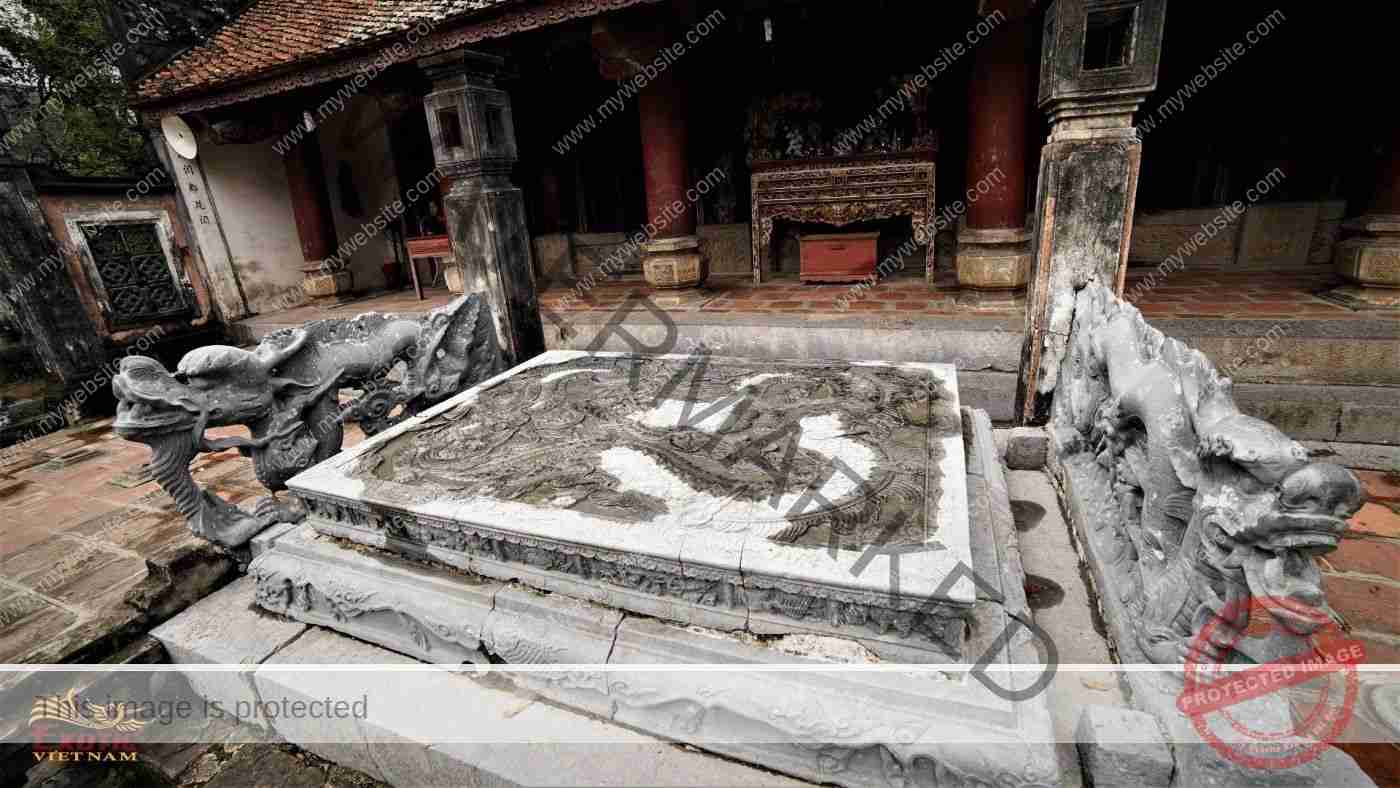
The photo taken in front of the main sanctuary of Dinh Dynasty’s Temple shows the most beautiful and valuable stone royal bed in our country with skillful stone carving art. Photo: Exotic Vietnam
Dinh Dynasty’s Temple
Dinh Temple was built in the shape of a Chinese character. Through the first entrance called Ngo Mon, there is a stone royal bed with Nghe (imaginary animals of the old times) standing on both sides. Inside the temple is Khai Thanh in worship of Emperor Dinh’s parents. The temple consists of three parts: Bai Duong for the community, Thien Huong in honour of mandarins, and Chinh Cung where Dinh Tien Hoang’s statue is located. On his left is the statue of his eldest son Dinh Lien, and on his right are those of Dinh Hanh Lang and Dinh Toan. On each side of the altar, there is one stone dragon similar to the ones placed near the royal bed.
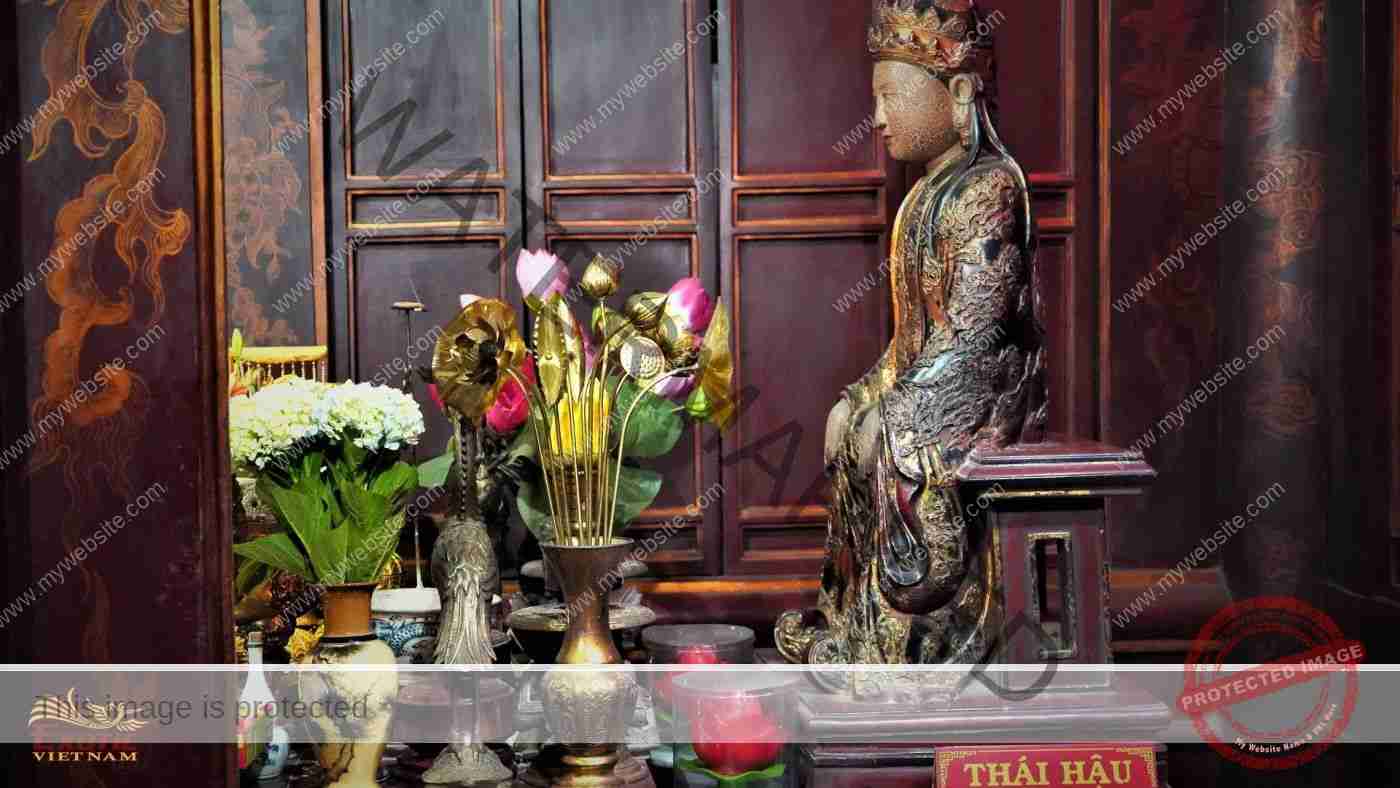
Statue of Queen Duong Van Nga can be found in the sanctum of Le Dynasty’s Temple. She made great contributions to the prosperity of the two Dinh – Le dynasties. Photo: Exotic Vietnam
Le Dynasty’s Temple
Le Temple is almost the same as Dinh Temple in term of architectural design, except for some details. Le Temple also consists of three parts: Bai Duong, used for the community, Thien Huong, in memory of the royal mandarins of Le King, and finally, the altar in memory of the King. The statue of Le Hoan is at the centre, on the left is the statue of Queen Duong Van Nga and on his right is that of Le Ngoa Trieu, his fifth son and the third King of the First Le dynasty

The blend of green rice fields, towering limestone cliffs and the idyllic life of the locals makes Tam Coc Valleys a natural paradise that you can hardly find elsewhere in the world. Photo: Exotic Vietnam
Tam Coc valleys
Tam Coc valley is considered as “inland Ha Long Bay” with limestone mountains erecting right from rice paddy fields. Visitors can take a gentle, three-kilometer cruise down the Ngo Dong River to enjoy the fragrance of rice, the fresh air of the karst formations and the friendliness of the locals. Tam Coc valleys leads to 3 caves: Hang Ca, Hang Hai and Hang Ba. These caves are adorned with beautiful stalactites and stalagmites of different shapes and colours that sparkle like gemstones. Around at the jetty, it is worth to see the girls of Van Lam village making embroidery. The best time to go is March through May, when the farmers will be growing rice in the field.
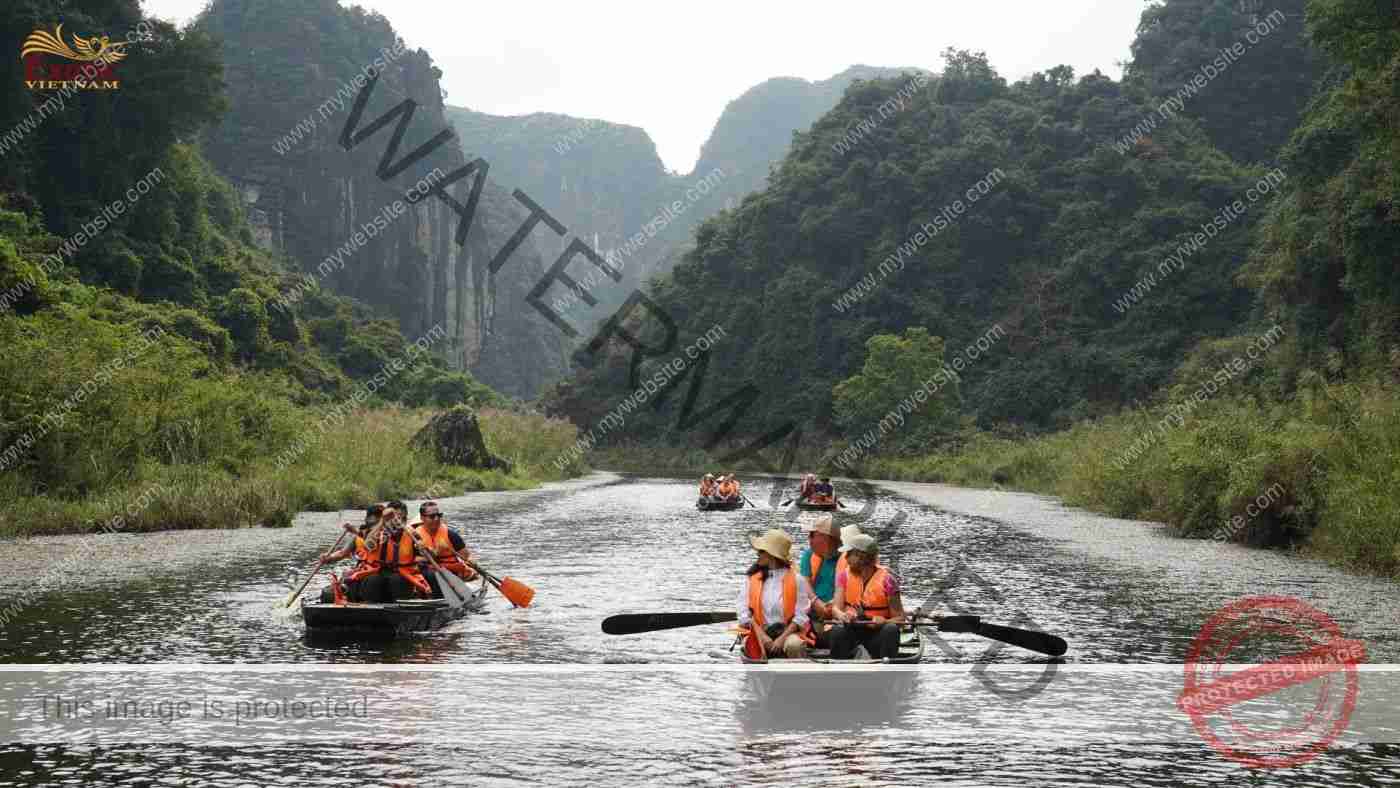
Made up by multi-shaped mountains and many mysterious caves, Trang An Eco-tourism Complex is where marks the 1000-year history of struggle of the Vietnamese people. Photo: Exotic Vietnam
Trang An Eco-tourism Complex
Surrounded by mountains of limestone, lakes, caves and a rich ecosystem with hundreds of different species, Trang An Eco-tourism Complex is the comnination of wild natures and rich cultures. It covers an area of 2168 ha which is dominated by the large and separated limestone karst peaks covered in plants. There are 48 caves connecting with 31 wetlands and 2km of waterborne caves like Sang (Light) cave, Toi (Dark) cave, Ba Giot (three-drop) cave, Nau Ruou (Brewing wine) cave, Dia Linh cave, Ao Trai cave, Si cave, Sinh cave and so on. Each cave features exactly like its own name. Rivers cross each other to create a highlight of Trang An and make water ways for tourists to paddle along. There is 1 of the three choices of rowing routes for your exploration of Trang An:
- Route 1: Boat landing – Trinhtemple – Toi cave – Sang cave – Nau Ruoi cave – Tran temple – Ba Giot cave – Seo cave – Son Duong cave – Phu Khong temple – Bao Hieu pagoda – Khong cave – Tran cave – Quy Hau cave – back to boat landing (3.5 hours)
- Route 2: Boat landing – Lam cave – Vang cave – Thanh Truot cave – Suoi Tien temple – Dai cave – Vu Lam temple – back to boat landing (2.5 hours)
- Route 3: Boat landing – Trinh temple – May cave – Suoi Tien temple – Dia Linh cave – Dai cave – Vu Lam temple – back to boat landing (3 hours).
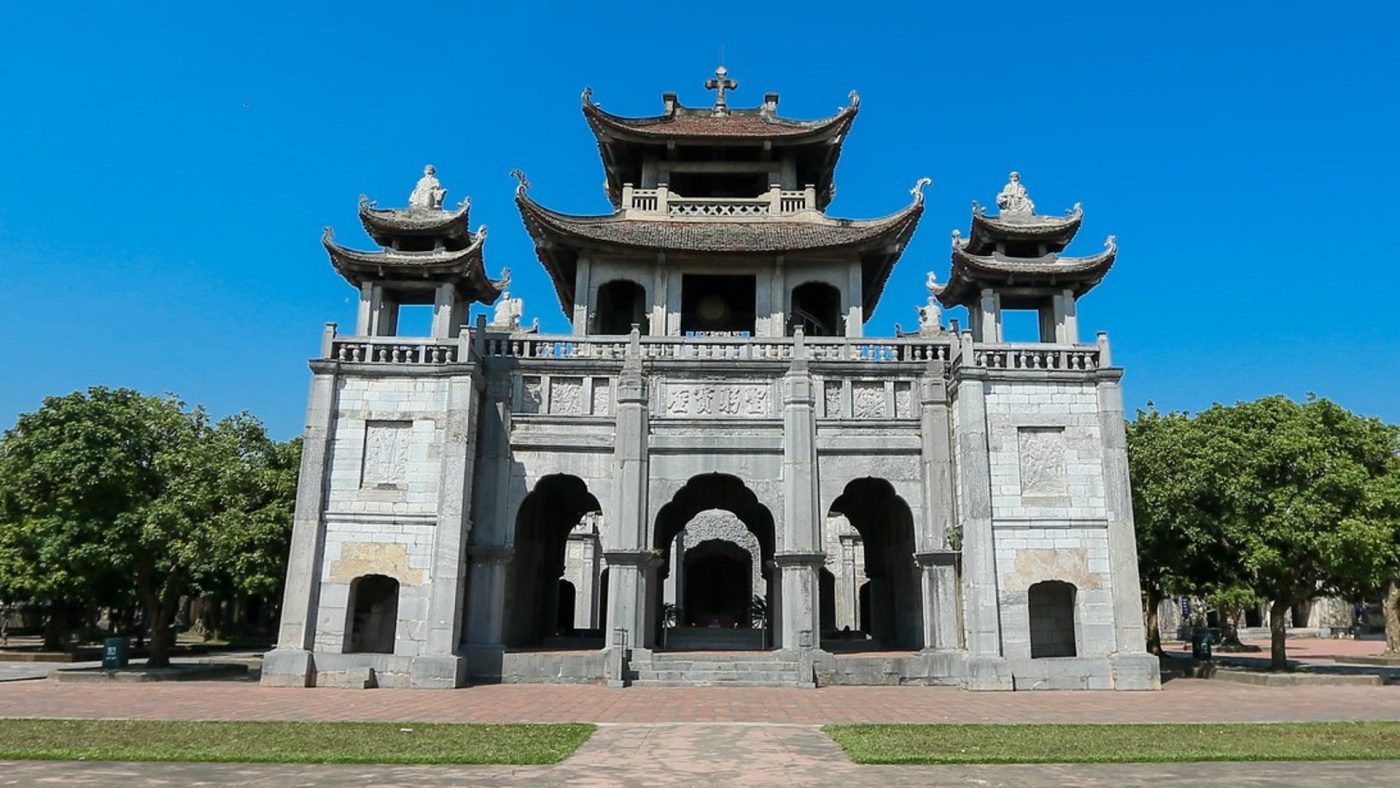
Built from 1875 – 1898, Phat Diem cathedral is called as “Stone church”, because of its walls, columns, earth, pubs to tie beams all made of stone. Photo: Internet
Phat Diem cathedral
Located 28km southeast of Ninh Binh, Phat Diem Cathedral was built between 1875 and 1899. The church and its annex buildings cover an area of 8ha. It is 80m long, 24m wide, 18m high and supported by wood columns. Indeed, with its multi-tiered, curling roofs and its 48 lime wood columns (the largest of which weigh seven tons), the church is a far cry from a European cathedral. Stone relief angels overlook carved dragons and the cathedral’s two-ton bell is accompanied by a giant brass gong. Phat Diem Church is really an interesting architectural complex combing the traditional pagoda architecture of Viet Nam with the Gothic style of Christian architecture. The best day to visit Phat Diem Church is on a Sunday, when the district’s roads are full of people, walking or cycling towards the cathedral or one of the dozens of neighbouring churches.
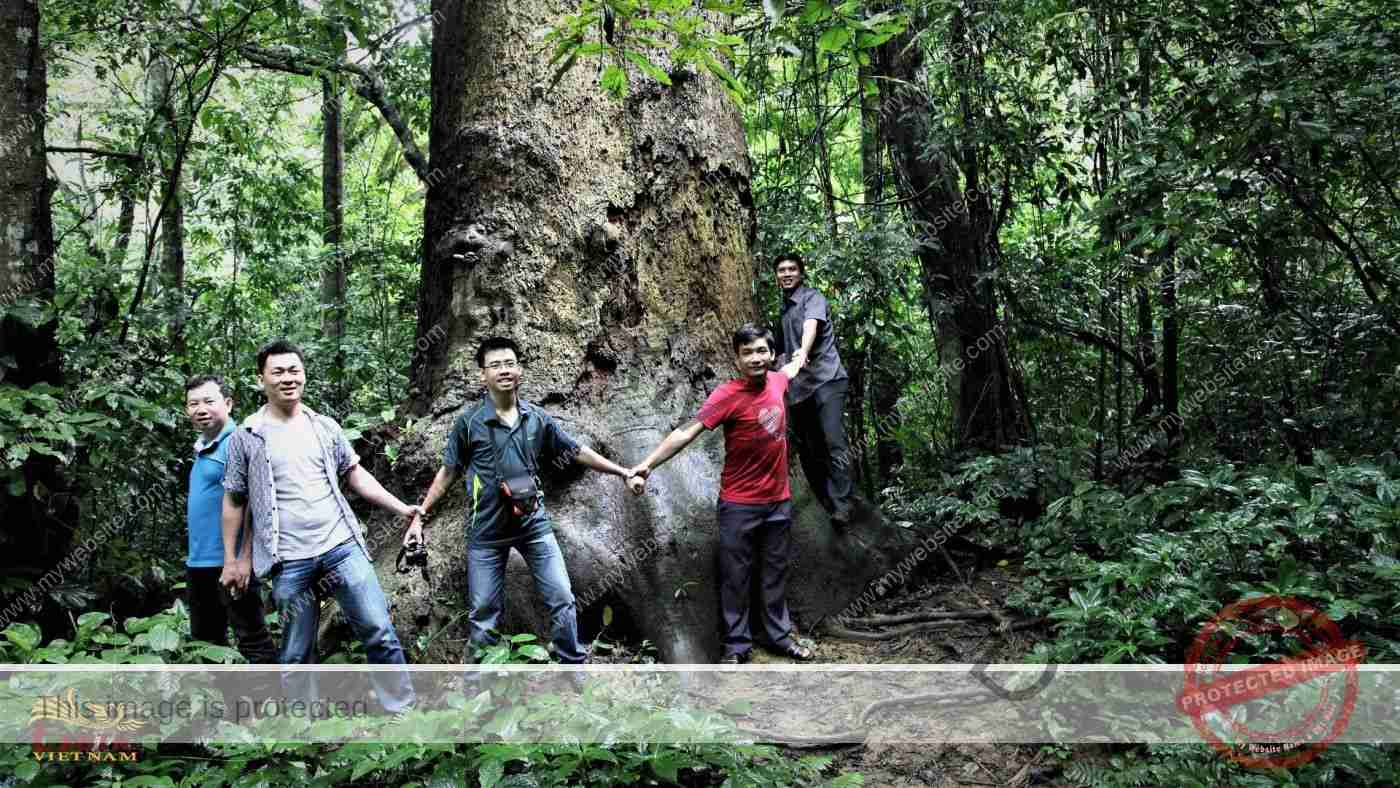
The diversity of its fauna and flora, the beauty of its nature and its many cultural and historical features make Cuc Phuong National Park one Viet Nam’s most important protected. Photo: Exotic Vietnam
Cuc Phuong National Park
46km from Ninh Binh, Cuc Phuong National Park covers an area of 25,000ha, three-quarters of which are limestone mountains with altitudes ranging between 300m and 600m above sea level, including the highest being May Bac, meaning “silver cloud,” with a height of 656m. The park was discovered in 1960 and officially claimed as the first national park in Viet Nam two years later. It is home to some 2,000 species of flora and 450 species of fauna accounting for 38% of the national fauna. The best time to visit Cuc Phuong National Park is during the dry season, from December to April, when the hard forest rain accounting for 90% of the annual rainfall is over.
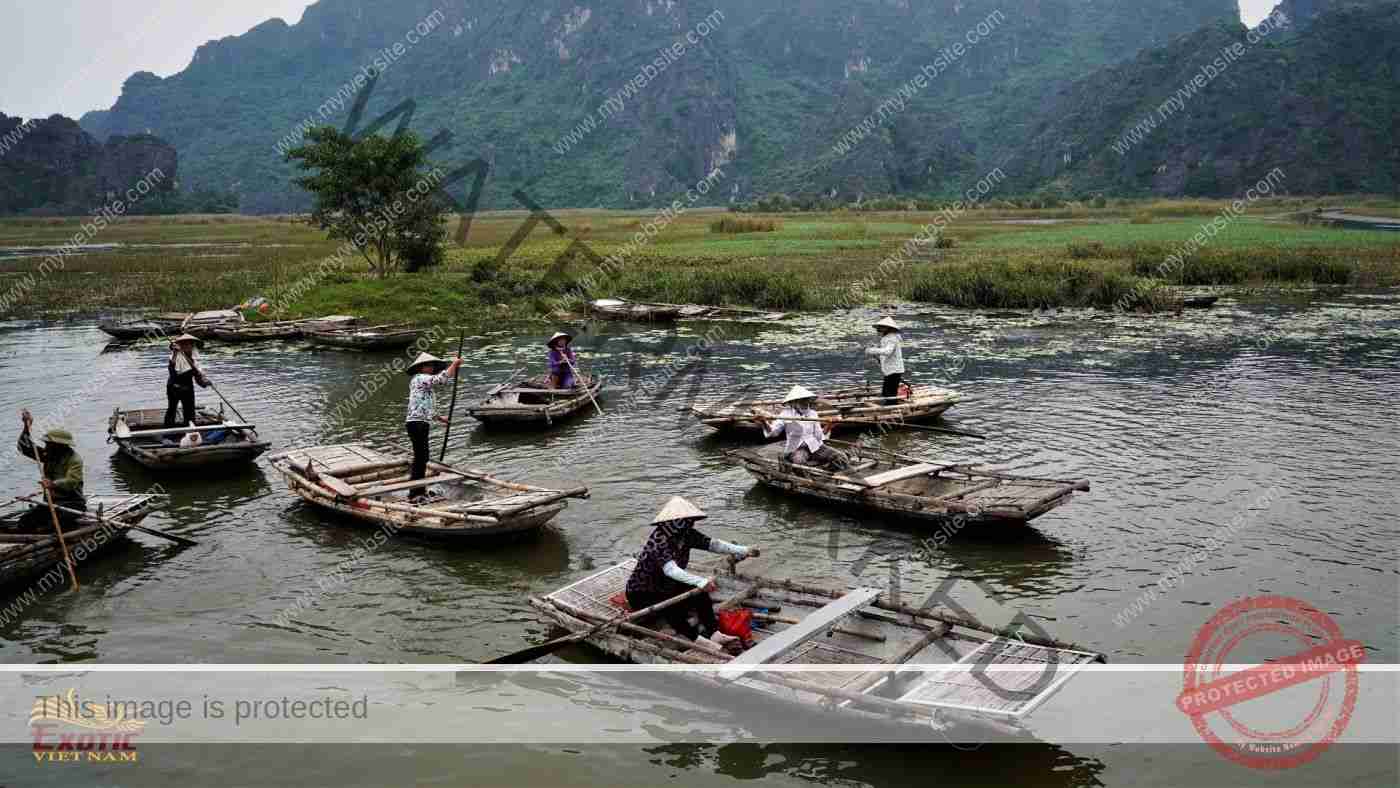
This is the only place in Ninh Binh where visitors can ride genuine bamboo sampans through high reeds into the wilderness to explore the largest wetland reserve in the Red River Delta. Photo: Exotic Vietnam
Van Long Nature Reserve
16km from Ninh Binh, the Van Long wetland covers an area of 2,643ha. There are 457 species of plants and 39 species of animals, some of which are listed in Viet Nam’s Red Book. Until now, local people and visitors can spot in the reserve a critically endangered primate, the Delacour langur, a black monkey-like animal weighing up to about 35 pounds, with a white band around its abdomen that gives him the local nickname “Mr. Whiteshorts.” Naturalists say this is the largest population of Delacour langurs anywhere in the world.
It is not only famous for its nature reserve, there are many cultural and scenic sites in the area. At the marshy foot of an embankment that divides the town from the protected wetland, there is a small dock for traditional woven-bamboo boats, punted by young men or women with long poles that suit the shallow water better than paddles or oars. Eco-tourists would change nothing here. The boats are perfect for meandering silently through the labyrinthine rock formations to view scenery of mountains of Nghien, Hom Sach, Da Ban, Meo Cao, Co Tien, Voi Dung, Canh Cong and Moi Coi, and to explore some of 32 nice caves in the reserve, including Fish, Shade, Tortoise, Lemon caves…
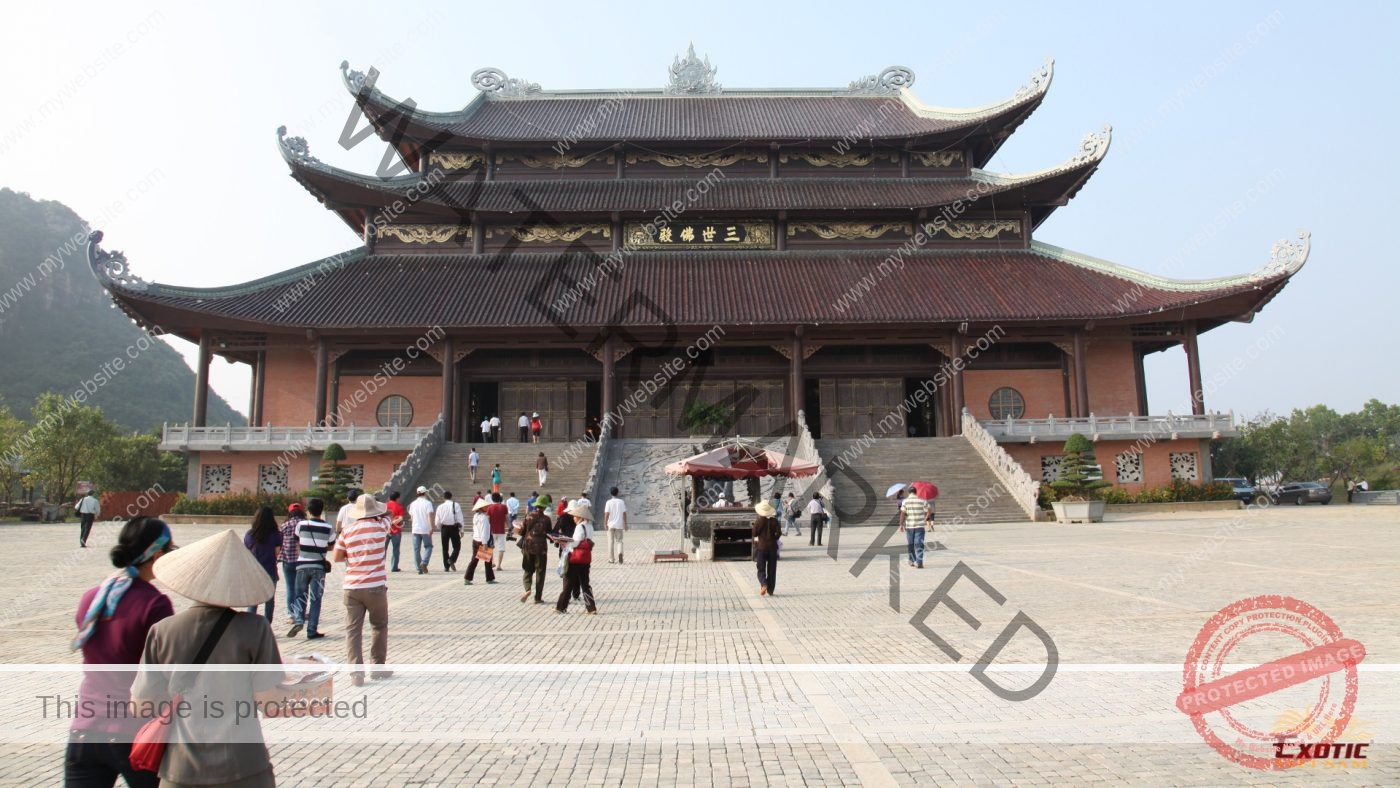
Leaning on the reputation of a small ancient temple of the same name, the new Bai Dinh Pagoda, a massive concrete complex, has claimed a long list of Vietnamese and Asian records. Photo: Exotic Vietnam
Bai Dinh Pagoda
Covering an area of 539ha, the complex of Bai Dinh Pagoda includes an ancient pagoda, dating back to 1136, founded by Nguyen Minh Khong and a new pagoda built in 2003. The pagoda is located on a mountain slope, between vast valleys and limestone mountains, about 9km from Dinh & Le Dynaties Temples. The massive new pagoda architecture is made of giant concrete and large natural trunks. This complex is famous with many Asian and Vietnamese records as the pagoda with the largest gold-plated bronze Buddha statue in Asia, the longest Arhat corridor in Asia, the largest bronze statue of Maitreya in Southeast Asia … The pagoda attracts a huge crowd of local devotees and travelers to look for sightseeing and pray for their fortunes.
TEAM BUILDING IN CAT BA – HAI PHONG
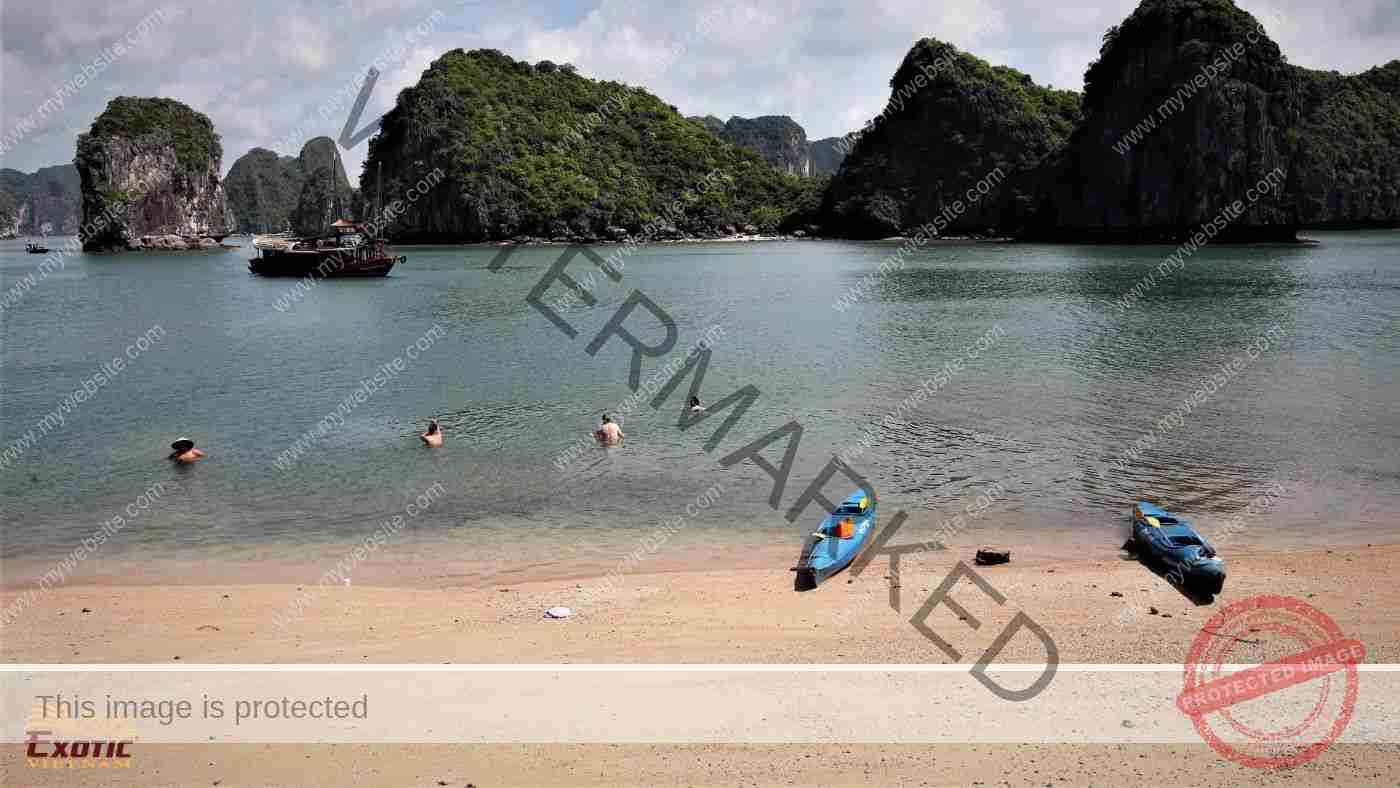
Lan Ha Bay has about 300 small islands scattered in 7,000ha. Most of them are isolated and untouched where swimming, snorkeling, and kayaking are the most popular things to do. Photo: Exotic Vietnam
Location: 105km from Ha Noi (2½ hours by car or train), 64km from Ha Long (1 hour by car), 122km from Ninh Binh (3½ hours by car), 50km from Cat Ba Island (2 hours by car & ferry or 55 minutes by hydrofoil).
Introduction: Located 105km east of Ha Noi, the port city of. For hundreds of years, the Chinese, Japanese, French, Spanish, and Portugese have been coming here to trade. Nowadays, Hai Phong is a reminder of Ha Noi some decades ago with graceful tree-lined boulevards, an impressive array of colonial-era mansions, old riverfront residences and bustling local activities. Moreover, thanks to a wide range of seaside resorts and varied nightlife, Hai Phong is a great destination for holiday makers. Visitors can enjoy a lot of beautiful landscape as well as interesting festivals such as Cat Ba Island, Do Son Beach, the buffalo fight festival, etc., just to name a few.
Highlights: Cat Ba Island, Du Hang Pagoda, Do Son Beach, Hang Kenh communal house, Municipal Theatre & Municipal Theatre Square.
Facilities & services: gambling, international standard hotels and restaurants.
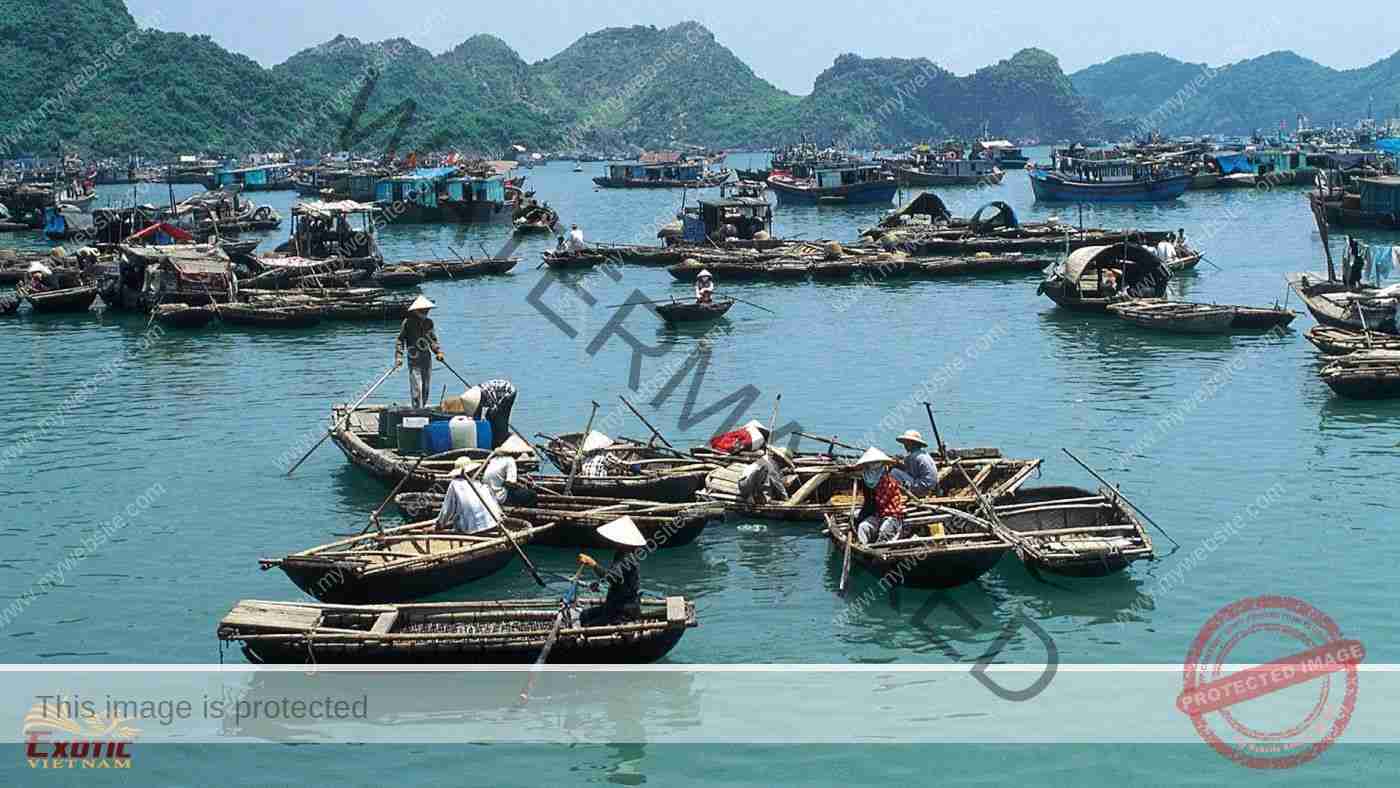
Cat Ba Island boasts of its natural beauty, biodiversity and long-lasting fishing tradition of local residents. Photo: Exotic Vietnam
Cat Ba Island
With an area of about 100km2, Cat Ba Island is the largest island in an archipelago made up of 368 large and small limestone islands rising from the sea. On the island, the highest peak is Cao Vong 331m and the lowest is Ang Tom, 30m lower than sea level.
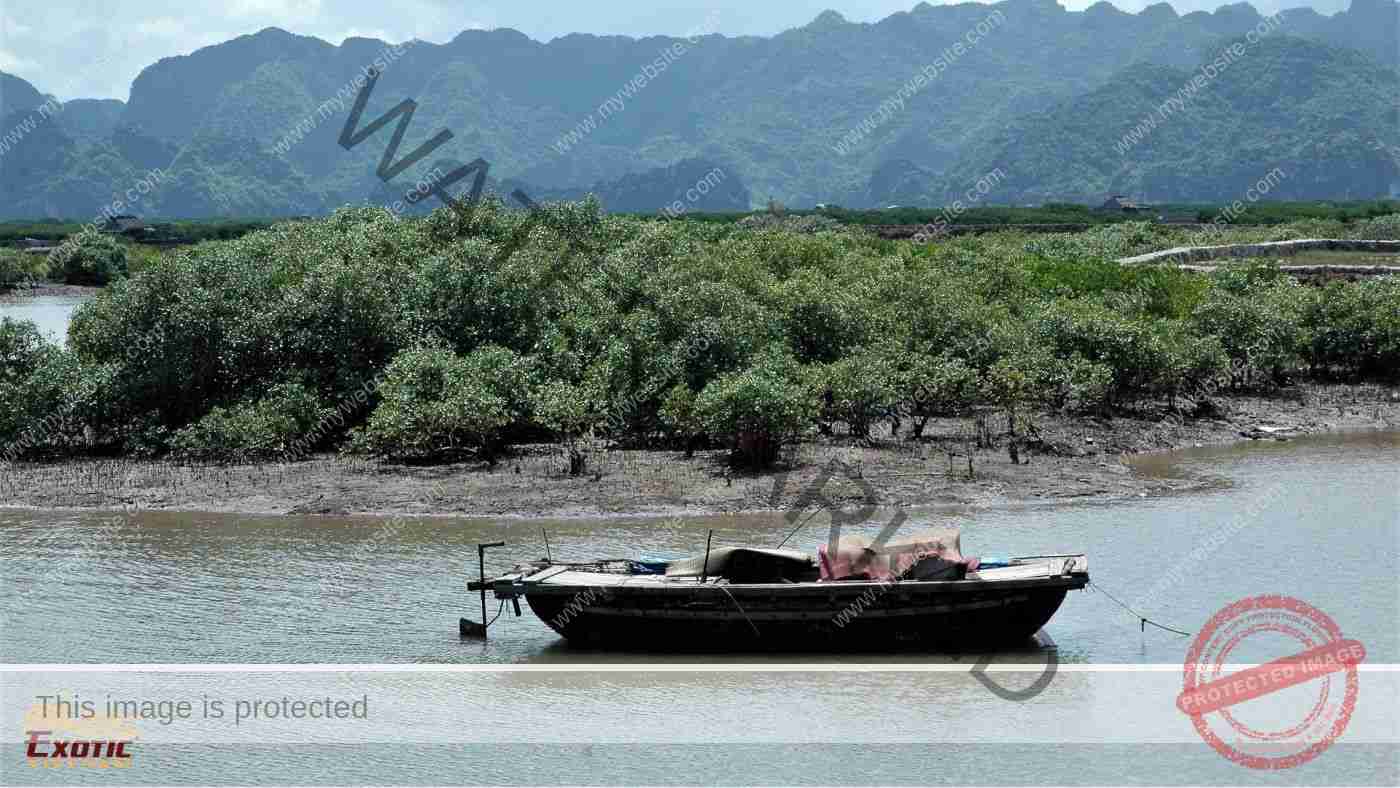
Mangrove forest as part of Cat Ba National Park provides habitat for many species of aquatic animals (fish, shrimp, mussels, crab, etc.) and migratory water birds. Photo: Exotic Vietnam
Cat Ba is a limestone mountain area, hiding many mysterious caves and dense tropical forests. Part of all this is still very dense and unknown to the civilised world. This is the common home of the diverse world of flora and fauna. With an area of 152km2, including 90km2 of forests, 54km2 of the sea, Cat Ba National Park was declared a national park in 1986 in order to protect the island’s diverse ecosystems. In 2004, Cat Ba World Biosphere Reserve was also recognized by UNESCO with an area of 262km2, where many unique natural worlds converge, considered the best model of high concentration of typical tropical & subtropical ecosystems. Travellers can also enjoy a day of trekking, caving, and rock-climbing on Cat Ba Island, specifically on the trekking trail from the national park quarter to Viet Hai hamlet (9km).
To the east is Lan Ha Bay, a prominent coastal sea with countless small islands covered with green trees, ringed by smooth white sand beaches and scattered “tung ang” like a small pond surrounded by mountains in the sea. Swimming, snorkelling, and diving are the most popular things to do on these islands in Lan Ha Bay.
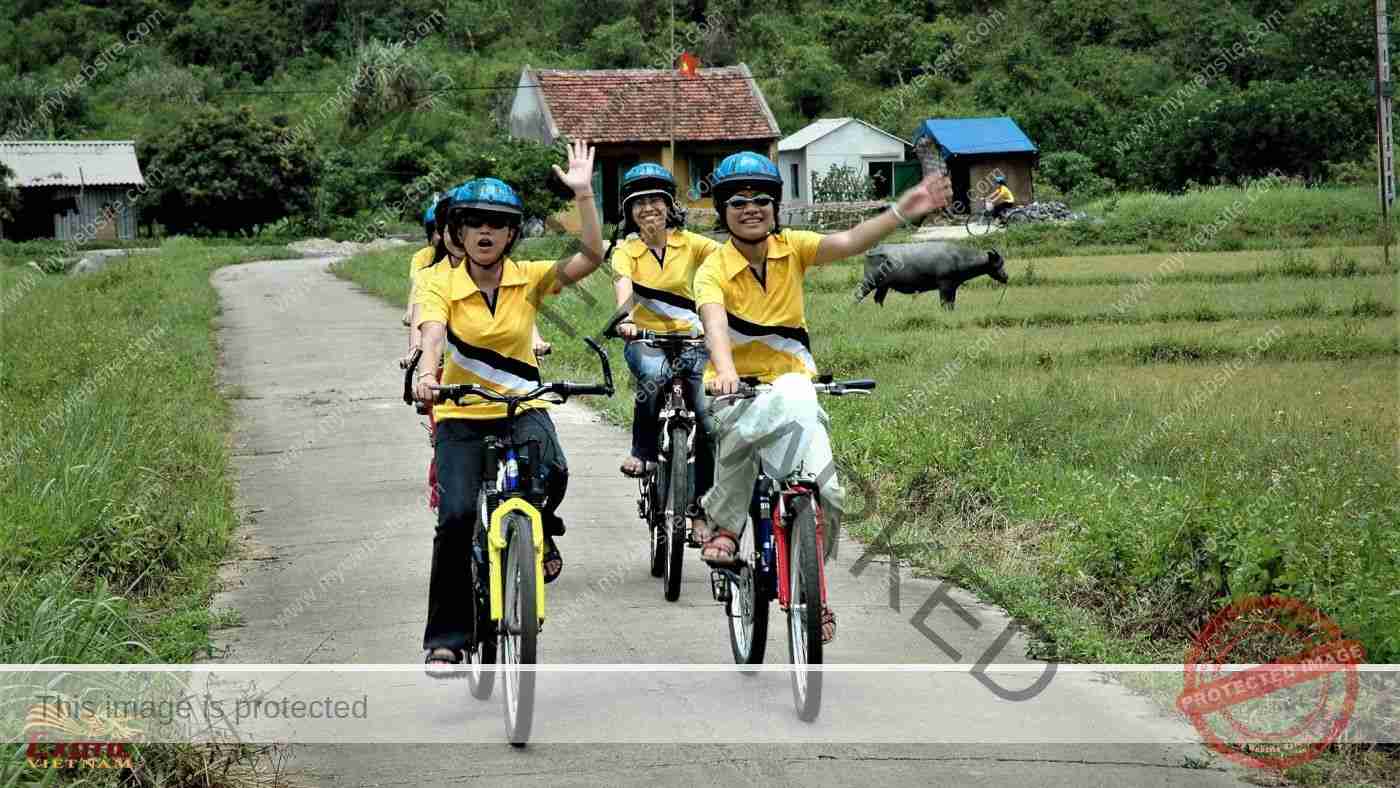
Located 18 km from Cat Ba Town, Viet Hai Village can be reached by an 8-km trek through the forest or a 45-minute boat ride from Beo Pier. This is a perfect place to do team building activities in Cat Ba Island. Photo: Exotic Vietnam
With a length of 15.63km (5.44km bridge & 10.19km path), Tan Vu – Lach Huyen bridge, built in 2014 – 2017 is the longest sea-crossing bridge in Viet Nam and one of the longest sea-crossing bridges in the South East Asia. Tan Vu – Lach Huyen Bridge makes it easy for visitors to reach Cat Ba Island. From Ha Noi to Cat Ba (152km) by bus takes about 4 hours, including a ferry (25 minutes from Got Wharf to Cai Vieng) or cable car (10 minutes from Cat Hai to Phu Long). From Hai Phong to Cat Ba (52km) by speedboat with a travel time of 60 minutes from Ben Binh to Cat Ba. From Ha Long to Cat Ba (45km) by bus takes about 2 hours, including a 60-minute ferry from Tuan Chau to Gia Luan.
Coming to Cat Ba, visitors always feel the cool and temperate climate throughout the year, but in July – August there are often storms, due to strong southeast wind, and November – February often have drizzle and haze due to cold northeast wind. Cat Ba Island is an ideal place for team building activities, from Survival Challenge in the national park or on sea to the Amazing Race right in Cat Ba town.
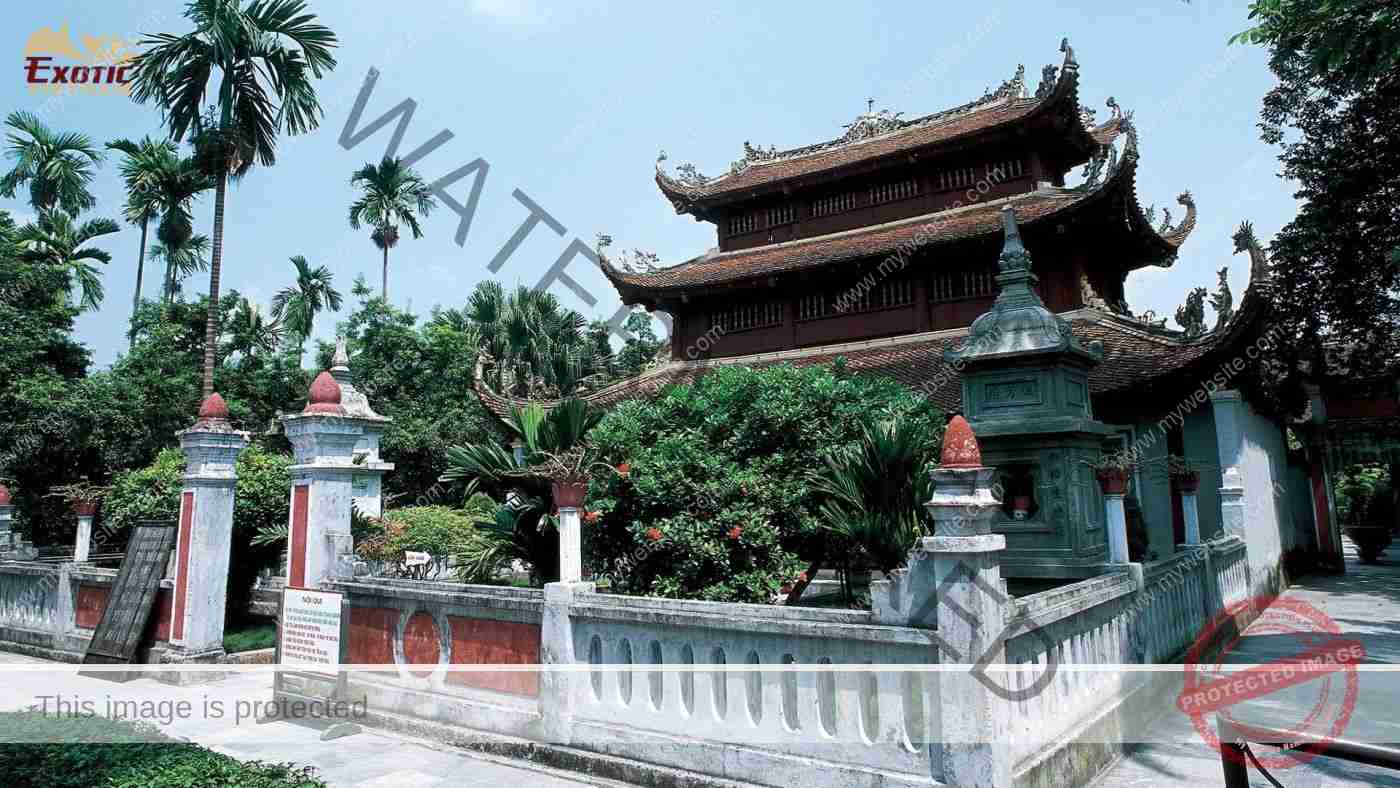
Built in 17th century and is still intact today, Du Hang Pagoda is the most sacred one in the city with stunning carvings and fantastic ornaments. Photo: Exotic Vietnam
Du Hang Pagoda
The pagoda is located in Le Chan District, 2km southeast of the centre of Hai Phong. It was built during the Early Le Dynasty (980-1009). King Tran Nhan Tong, a devout Buddhist, used to preach at this pagoda. Though it has been repaired and restored several times, it remains a good example of traditional Vietnamese architecture and sculpture. The pagoda is now listed as a historical site containing many relics, including Buddha statues, bronze urns, bells, gongs, and especially the prayer book of Trang A Ham, an ancient Buddhist script.

Do Son beach at zone 2 is the main beach, attracting the most visitors in Do Son, with a long stretch of fine sand suitable for swimming, playing, water sports as well as canoeing, parachuting, etc. Photo: Exotic Vietnam
Do Son Beach
Do Son, 21km southeast of central Hai Phong, lies between the mouth of the Lach Tray River and the mouth of the Van Uc River. This 5km-long promontory is dotted with a succession of beaches, hills and quiet pine forests. In the past, the French turned Do Son into a summer resort for their expatriate community and the Vietnamese upper class. Now it is a popular seaside resort with many places of interest such as the former summer residence of Bao Dai, Do Son casino, etc. Moreover, the town is famous for its buffalo fights which are held annually on the 10th of the eighth lunar month.
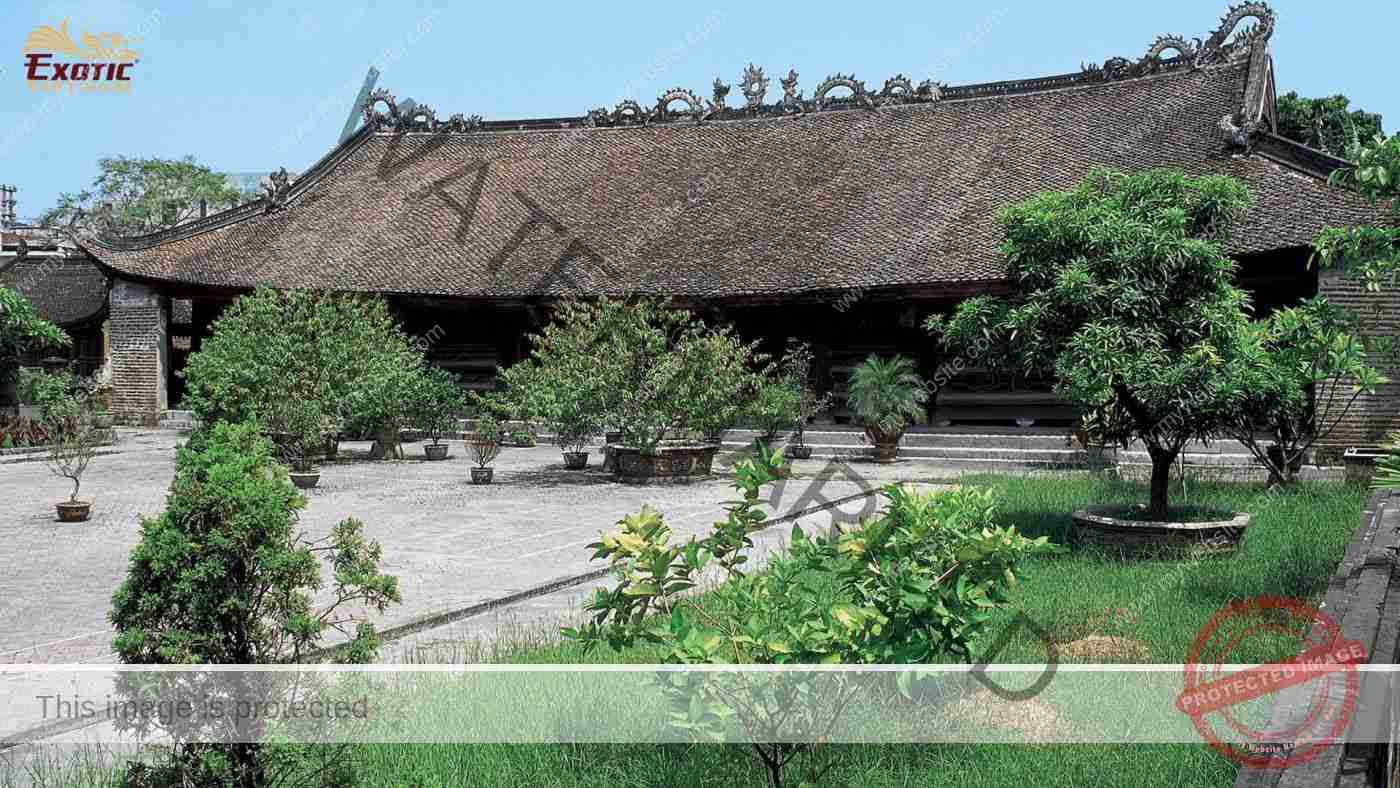
Built in 1719, Hang Kenh Communal House not only has great value in architectural art but also sculpture art with 100 carved pieces of dragons, a sacred symbol of the Vietnamese people. Photo: Exotic Vietnam
Hang Kenh Communal House
Located on Hang Kenh St., the Hang Kenh Communal House was built in 1856 and expanded in 1905. It is known for its valuable wooden sculptures, of which there are 156 pieces with dragons as the main theme. Altogether, there are 308 dragons of different shapes and sizes. The pagoda also houses a statue of Ngo Quyen and a palanquin. Every year on the 16th–18th of the 2nd lunar month, ritual ceremonies and festivals are held at the communal house attracting large crowds.

Built from 1904 to 1912 by the French, Municipal Theatre is a copy of the Palais Garnier in Paris. Photo: Exotic Vietnam
Municipal Theatre & Municipal Theatre Square
The Municipal Theatre, also called the Great Theatre, was built in 1904 in the heart of Hai Phong. The entire project was supervised by the French; the materials were imported and the architects were French. The theatre is a two-story building with a seating capacity of 400. Especially, the ceiling is ornamented with flower frescos and the names of famous writers and artists. All great festivities of the city are held in the Municipal Theatre Square.
TEAM BUILDING IN HA LONG
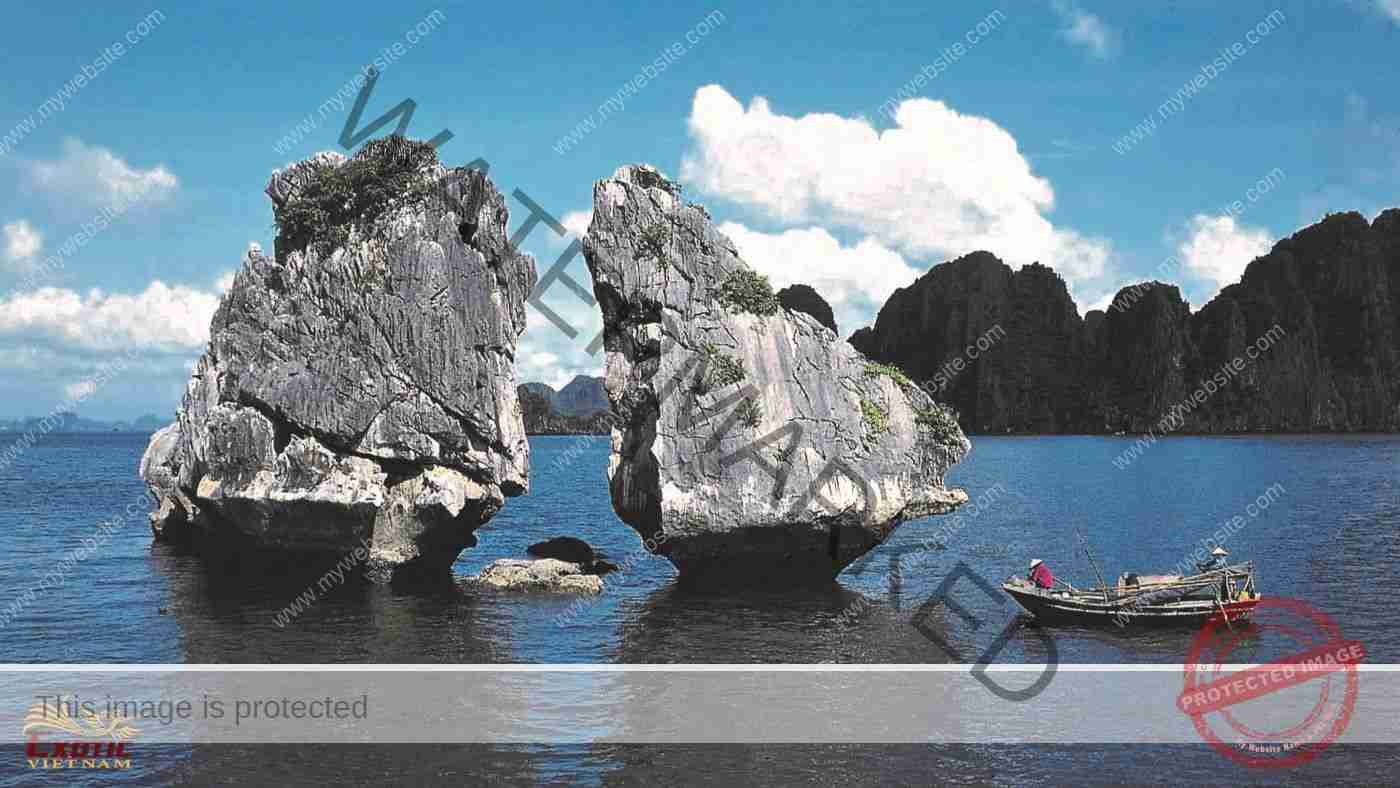
Sculpted by nature over geological time, Ha Long Bay is a spectacular seascape that displays the full range of karst formations from clusters of conical peaks to isolated towers and associated notches, arches and caves. Photo: Exotic Vietnam
Location: 170km from Ha Noi (3 hours by car), 65km from Hai Phong (1½ hours by car).
Introduction: Ha Long Bay, literally translated as the “Bay of Descending Dragons”, is one of the most magnificent scenic spots in all of Viet Nam and was designated by UNESCO as a World Natural Heritage in 1994. It is a picturesque bay with some 1969 islets rising from the clear emerald waters of the Gulf of Tonkin. Washed by water and lapped by waves for hundreds of thousands of years, the limestone basin has been carved into stalactic caves, crescent beaches and odd-shaped formations. Ha Long Bay is also famous for its varied ecological system with thousands of kinds of fish, hundreds of sorts of coral and other sea creatures. Moreover, the global value of Ha Long Bay in terms of geological process has been highly appreciated. In late 2000, UNESCO acknowledged Ha Long Bay as being a kastic geological foundation, a second World Heritage criterion. Ha Long Bay really becomes a must in the trip to Viet Nam. There is a list of things you can see and do around the bay susch as pristine crescent beaches, natural stalactite caves, picturesque islands and unique fishing villages to explore.
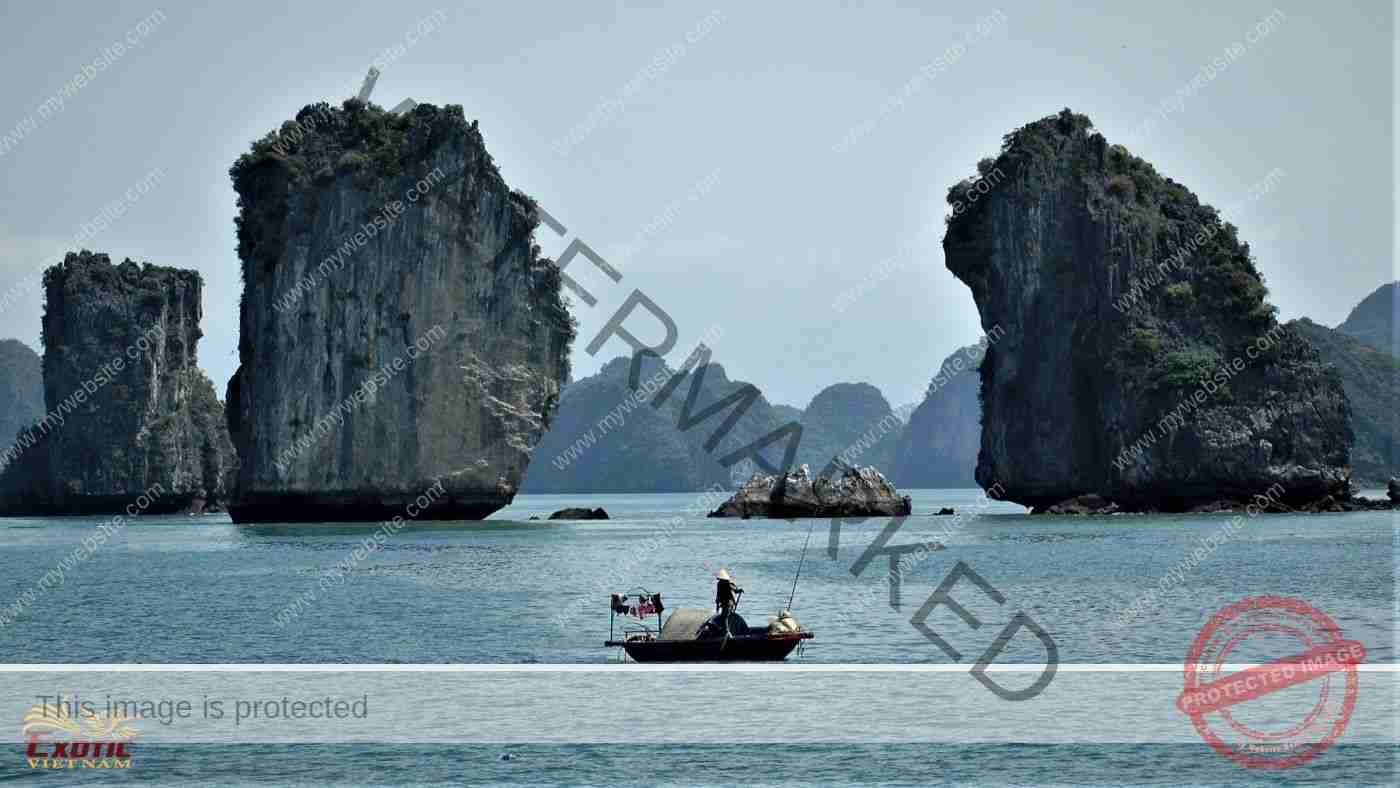
Cua Van, Vung Vieng, etc. are fishing villages on Ha Long Bay. Coming to this place, visitors don’t only admire the natural beauty but also know more about the idyllic traditional culture of the local people. Photo: Exotic Vietnam
Highlights: Ha Long City, Bai Tho Mountain, Long Tien Pagoda, Hon Gai Market, limestone islets, Caves and grottoes, Tuan Chau Island, Quang Ninh Museum.
Facilities & services: boat ride, luxury cruise, helicopter/ seaplane ride on the bay, international standard hotels and restaurants.

Separated by Cua Luc Strait, Ha Long City has been transformed into a modern city. The coastal waters have been gradually filled to build amusement parks and high-class villas. Photo: Exotic Vietnam
Ha Long City
Cua Luc Strait divides Ha Long City into 2 parts: Bai Chay and Hon Gai. Once upon a time, in order to cross the strait, visitors had to take a ferry boat. For the time being, Bai Chay Bridge, a suspension bridge of 903m in length was completed in 2006 to connect the 2 sides of the city. The world’s biggest cable car, called the Queen was also opened here in 2016, with big cabins with a capacity of 230 people per trip.
Hon Gai used to be a coal-exporting port and is now one of the most important commercial centres for transporting passengers and goods in northeastern Viet Nam. Bai Chay, a low gently sloping range of hills running along the sea for 3km, was planned to be a seaside resort in the French time. Since 2015, huge investments have quickly spent on filling and leveling coastal waters, islands and mountains to turn them into construction land. Tourism has been big business in Ha Long with an explosion of infrastructures such as man-made sandy beaches, premium marinas, fine restaurants, luxury villas, international standard hotels and modern recreational parks.
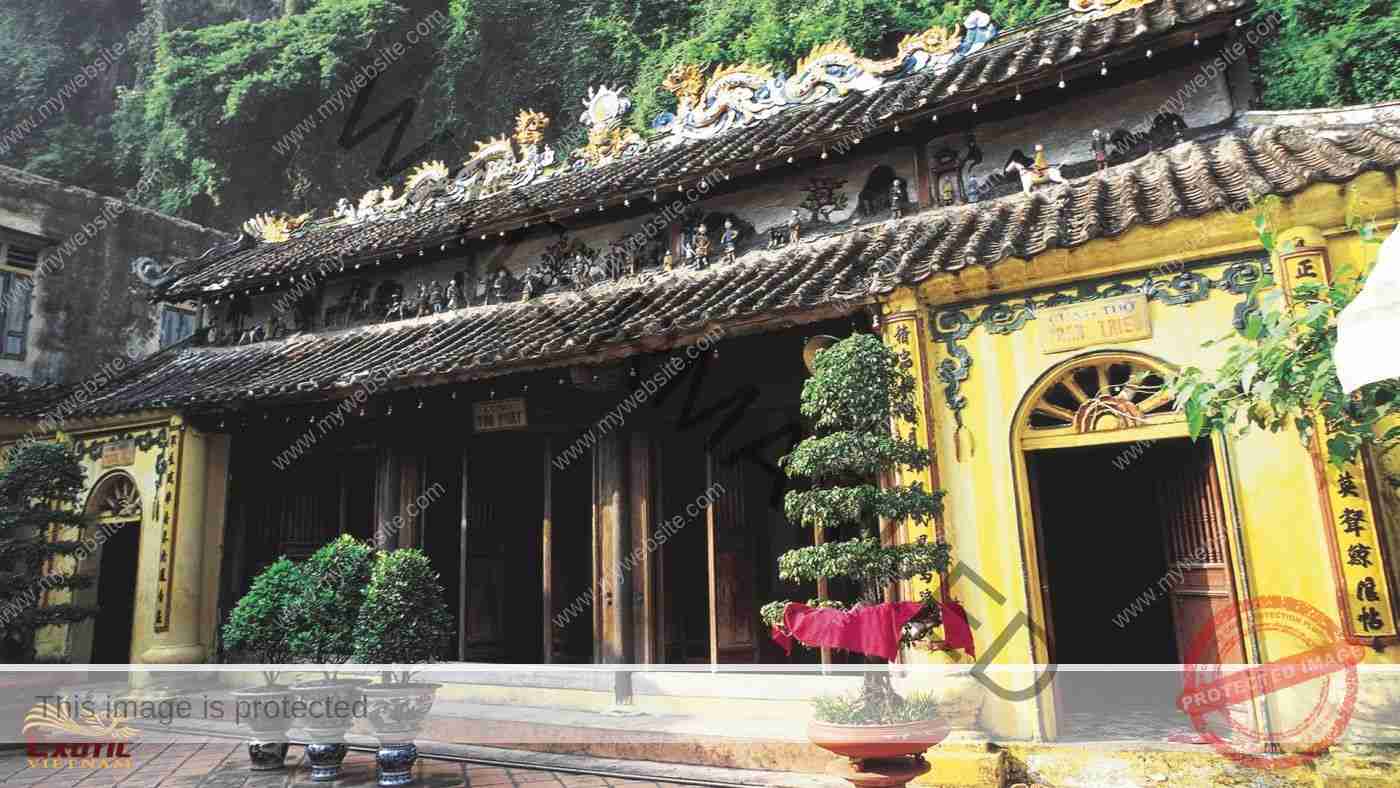
Built in 1941, Long Tien Pagoda has original and unique architectural style of the Nguyen Dynasty. The pagoda worships Buddha and Tran Dynasty’s generals who have made great contributions to the country. Photo: Exotic Vietnam
Long Tien Pagoda
Long Tien Pagoda, the biggest in Ha Long, was built at the end of Nguyen Dynasty (1941). In addition to Buddha, this pagoda is also dedicated to the “Holy Mother” and to the heroes of Nguyen Dynasty. The mosaic dragon & phoenix decoration of the pagoda symbolizes the typical style of the architecture of Nguyen Dynasty. Moreover, it has a good collection of religious icons. Hence, the pagoda has become a site of pilgrimage for the local people and other visitors. On the 24th of the 3rd lunar month each year, Long Tien Pagoda organizes a procession of holy palanquins which draws big crowds.
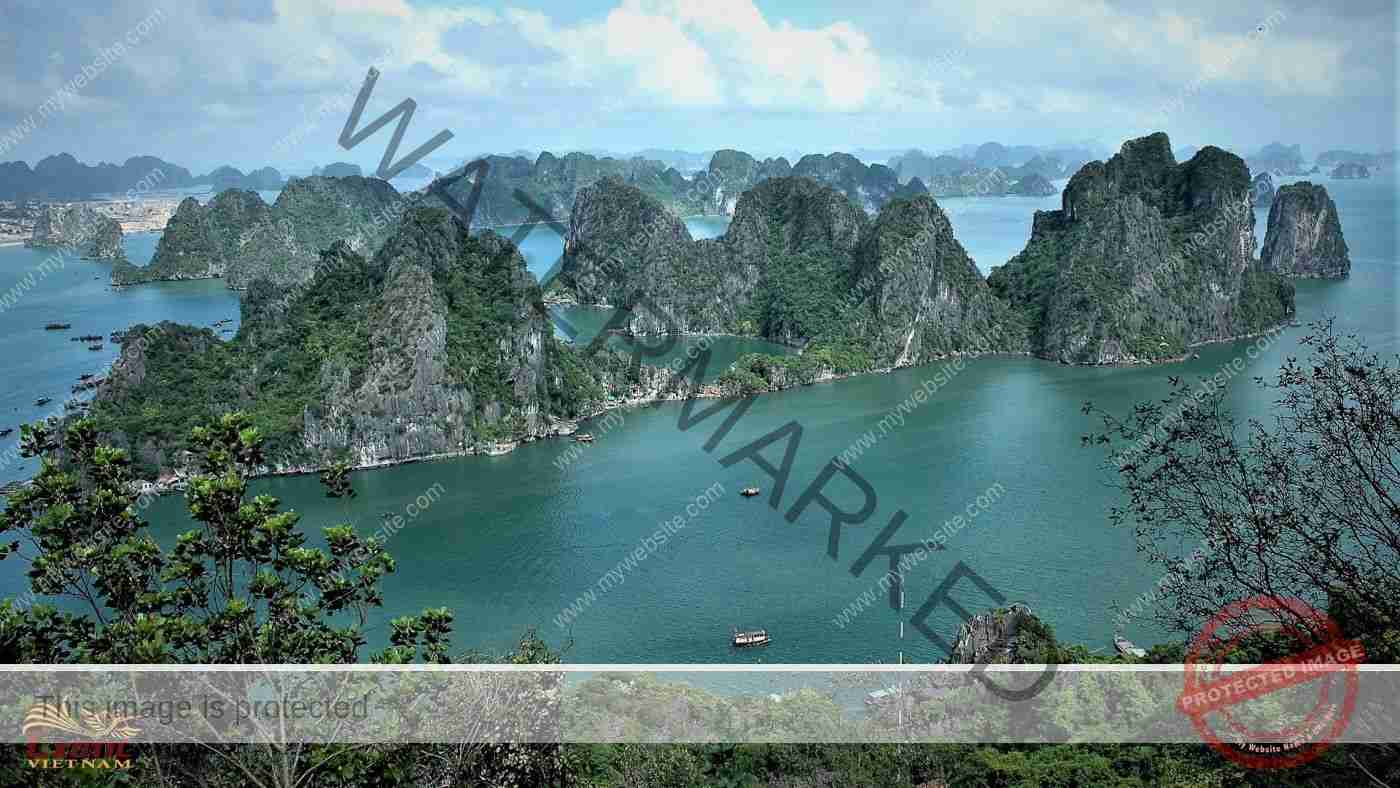
Ha Long Bay is home to countless large and small islands rising from the jade waters over thousands of years. Most of them have caves to explore with plenty of excitement, pristine beaches to indulge any whim and high cliffs to challenge yourself. Photo: Exotic Vietnam
Limestone islets
With its 1969 islets, 980-plus of which have been given names, Ha Long Bay has become one of marvels of Viet Nam. These islets give a picture of a lively life right on the clear, emerald waters with such names as “Cock Fight”, “Horse Saddle” and “Old Man & The Sea”. While navigating on the green clear waters, visitors may feel lost in the legendary world of these islets, whose shapes change depending on the sunlight or the position of the boat or ship visitors are on. The treasure of the islets are the very wonderful caves and grottoes to be discovered.
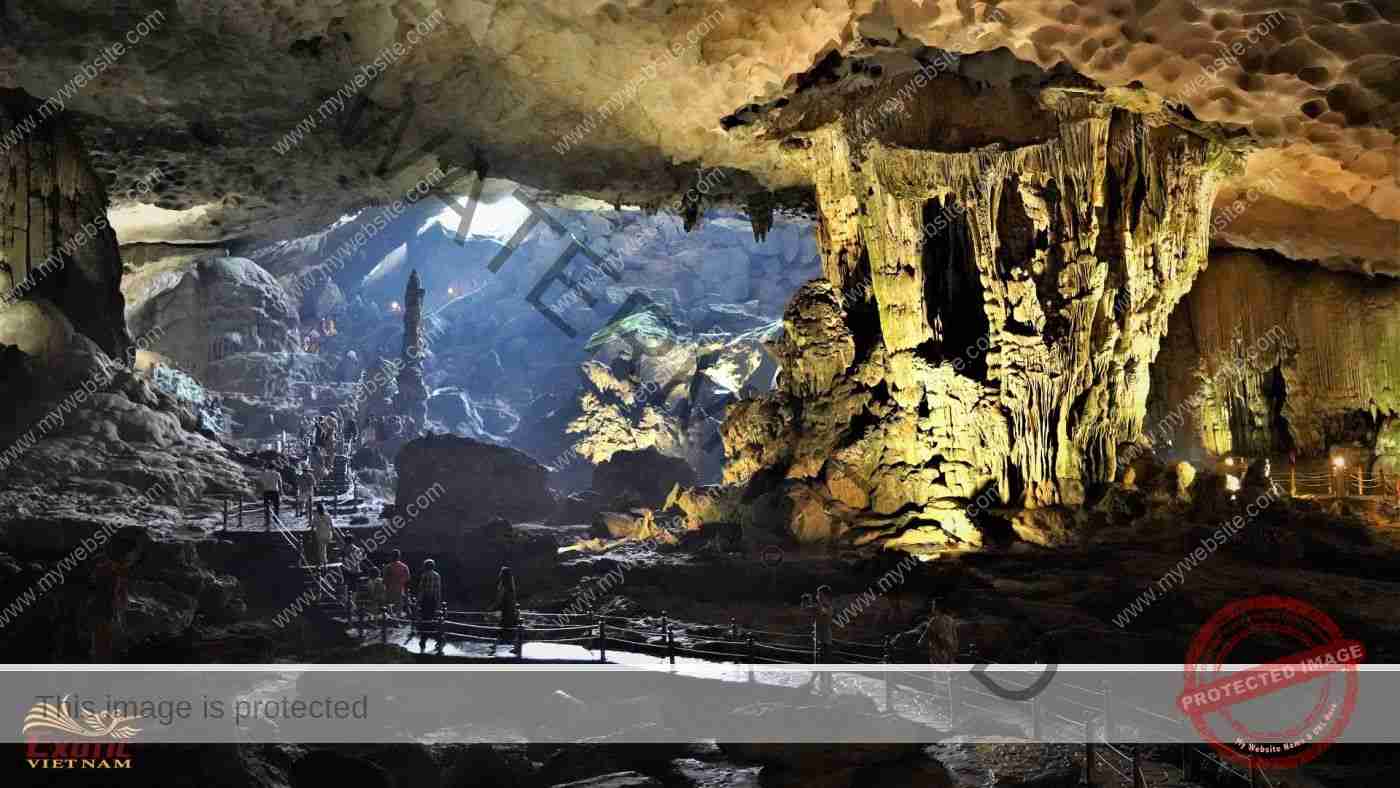
Waters move in fissures within the limestone that have continuously dissolved and recrystallized over millions of years to hollow out the mountains. This process creates a large number of caves with spectacular stalagmites and stalactites in Ha Long Bay such as Thien Cuong, Dau Go, Sung Sot and more. Photo: Exotic Vietnam
Caves and grottoes
Due to the rock type of the islets, Ha Long Bay is endowed with thousands of caves and grottoes, of which 50 have been discovered and exploited in tourism. Visitors can see an elysium right on earth with pictures of the heavens, fairies or simply the lives of all living beings. Thien Cung – Dau Go Caves, Me Cung Cave and Sung Sot Cave are easily visited thanks to newly-installed electric lights and beaten paths. Visitors to other caves and grottoes must be equipped with flash-lights and get permission from management board because of their virgin nature.
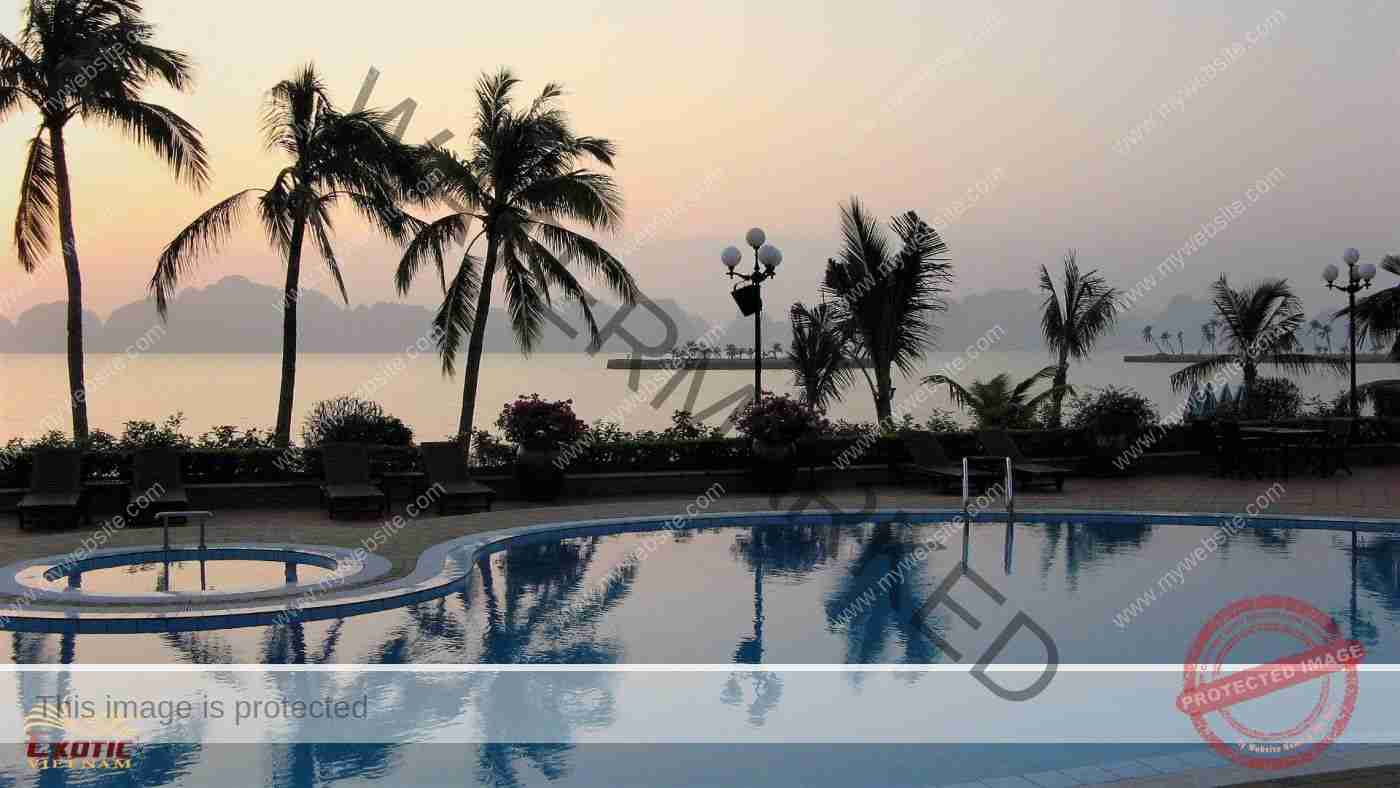
With themed parks, high-class resorts, white sandy beaches, a sheltered harbor, Tuan Chau Island still keeps its calm feeling and breathtaking views to Ha Long Bay. Photo: Exotic Vietnam
Tuan Chau Island
Situated 8km southwest of Ha Long City and 3km west of Dau Go Islet, Tuan Chau Island from the original about 220 hectares, has been expanded to over 600 hectares. With a 2.2km-long road, it connects the island with the mainland in 1999. The island also has a rich archaeological history and traces of Ha Long culture – whose people occupied the area from 5,000 to 3,000 years ago – have been found there. With a smooth terrain, it used to be an important staging ground in naval battles against the Mongols in the 13th century. In 1958, President Ho Chi Minh spent his holiday on Tuan Chau Island, and the house in which he stayed now is a memorial site
At present some big projects have been carried on the island. Tuan Chau International Port offers a capacity of harboring more than 2,000 ships, depth up to 10 meters, length of 6.5km, max width of 750 meters. Tuan Chau Island is now one of the tourist hubs in Ha Long. There is a lot to do consisting of amusement park, golf course, musical fountain, shows of dolphin, sealion and animal, water sports, and a range of 5-star hotels, villas, restaurants, entertainment facilities, conference facilities nestled under canopies of green trees.

Simulated as magnificent black pearls, Quang Ninh Museum is the most impressive architecture in Ha Long City where the values of geology, biodiversity, history and culture in Ha Long are shown. Photo: Internet
Quang Ninh Museum
Designed by the Spanish architect, Salvador Perez Arroyo, opened in 2013, Quang Ninh Museum and Library includes 3 blocks of museum, library and convention. It looks like 3 giant coal cubes connected together by sky bridges. Covered by 14,000m² of black glass, the building is like countless mirrors reflecting daily life of the locals and grandeur of the world natural heritage in Ha Long.
The museum has 3 floors. On the first floor, biodiversity and natural resouces are displayed with 4 themes: geology, sea, insect, plants and animals to introduce the natural conditions of Quang Ninh. On the second floor, history theme is displayed including the prehistoric period (Pre-Ha Long culture, Ha Long culture, Metal age), the Feudal period (Dai Viet era) and the Modern period (Revolution, Resistance). On the third floor, the exhibit recreates the development of coal industry through numerous plaster figures, photographs, artifacts and mock-up models of underground mining.
The museum fully reflects the differences in tradition, life, history, culture, art, nature and people of Quang Ninh
TEAM BUILDING IN NAM DINH
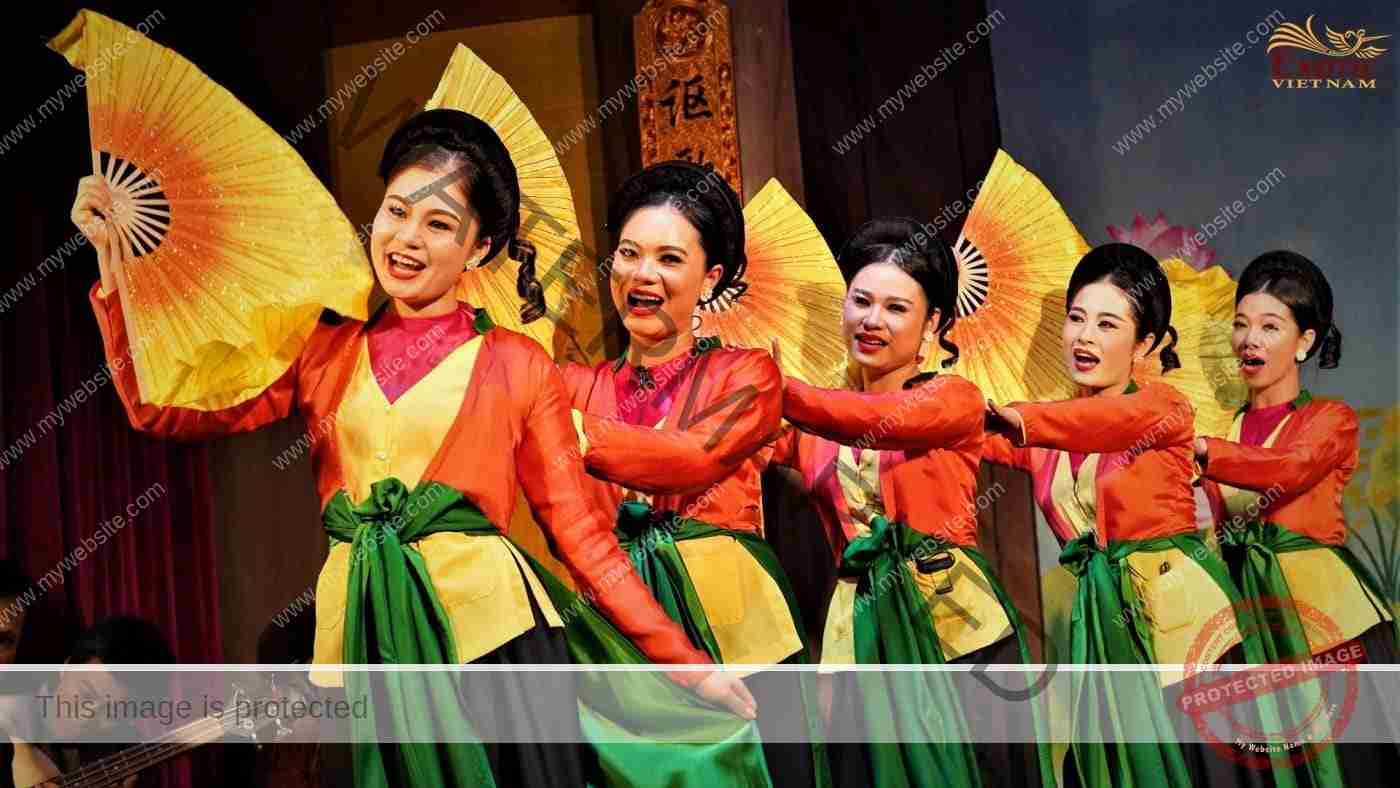
There’s so much for you to explore, whether it’s cycling in the Hai Hau countryside, visiting the Tran’s Dynasty Temple, wandering around the parishes, or even just a leisurely boat cruising along a winding tidal creek in Xuan Thuy National Park. Nam Dinh is also proud to be the cradle of the country’s many performing arts and home to an impressive array of dishes, especially Nam Dinh’s heirloom beef noodle soup. Photo: Exotic Vietnam
Location: 85km south of Ha Noi (1¾ hours by car), 32km from Ninh Binh (45 minutes by car), 90km from Hai Phong (2 hours by car).
Introduction: 85km south of Ha Noi, Nam Dinh is a coastal province with a long history in the Red River Delta. From the 13th century, the Tran Dynasty built Phu Thien Truong with many palaces to serve the royal family in Tuc Mac village, where the Tran family originated. Palace architecture as well as administrative organization in Thien Truong are similar to those in Thang Long Imperial Citadel, so this place is likened to the second capital of the country during this period. In 1533, the coastal area of Nam Dinh was the first place where Portuguese missionaries set foot in Viet Nam. This led to the establishment of hundreds of parishes with lots of Catholic churches in the years that followed, some of which remain to today as historical witnesses. In 1921, Nam Dinh was recognized as a city under the French colonial period, home to the largest chain of textile factories in Indochina.
Today, Nam Dinh City’s vicinity attracts tourists with its traditional farming villages surrounded by big rivers and vast rice fields. Many ancient architectural works such as traditional houses, family temples, village communal houses, Buddhist pagodas, … and Catholic churches are found everywhere. The church bells hum slowly, spreading down every street corner, rustic villages, peaceful rice fields which create a unique melody only in Nam Dinh. In addition, many trades inherited through several generations such as weaving, growing ornamental plants, carpentry, water puppetry, etc., and unique customs, folk beliefs, performing arts and folk festivals, are still preserved and developed in modern life.
Eco team building in Nam Dinh is a journey to bring participants into the authentic world of the Red River Delta’s countryside, where they can fully and vividly feel about the intangible cultural values presenting in people’s routines. The challenges are simulated from activities in rice farming, salt making, fishing, clam raking, etc. to help people bond together, share work for a common goal in laughter and joy.
Highlights: Nam Dinh City, Xuan Thuy National Park, Pho Minh Tower, Tran Dynasty’s Temple, Churches in Nam Dinh, Hai Hau countryside, etc.
Facilities & services: world class hotels and restaurants.
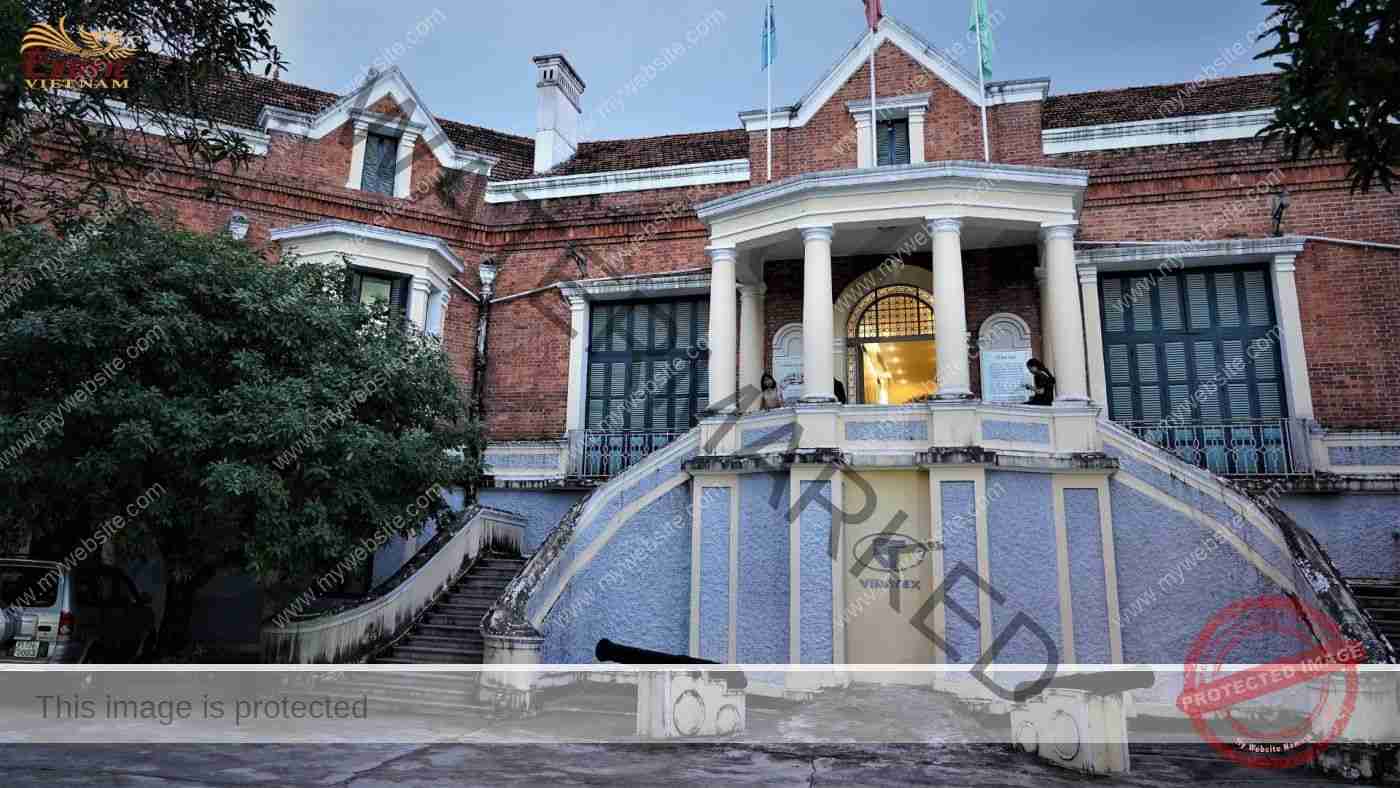
It’s a mix of old Chinese quarters and French monuments, where you reminisce about an old Nam Dinh with its huge noisy looms and steam locomotives filled with smoke. Not only connecting with the scenic spots in Ninh Binh, Nam Dinh City is the starting point for your journey to discover little-known things about hundreds of ancient Catholic churches and authentic local life associated with rice fields and craft villages. Photo: Exotic Vietnam
Nam Dinh City
Not far from Ha Noi, located at the confluence of the Red River and Nam Dinh River, Nam Dinh City has an important strategic position in the Red River Delta. In 1804, Nam Dinh citadel was built by Emperor Gia Long according to Vauban architecture, which aimed at both an administrative center of the region and a solid fortification. Currently, the remaining vestiges are only a section of northern gate with a length of about 220m and the flag tower. However, the flag tower was destroyed by a US air raid in 1972, and was restored to its original form in 1997.
In the French colonial period, Nam Dinh was one of the first cities established in Indochina in 1921. Thanks to the convenience of river and railway transport, Nam Dinh quickly became the largest textile center in French Indochina and a hub for goods trading in the North. Do Quan Wharf and a number of small streets as trading quarters such as: gold, porcelain, candy, and so on along with Rong Market, Big Church, Vong Cung Pagoda, etc. located along the banks of Nam Dinh River, conjuring up the image of a busy commercial port in the centuries-old history of Nam Dinh.
Once to Nam Dinh, you visit not only prominent hotspots such as Lake Vi Xuyen, Cua Dong crossroads, Temple of Literature, Tran Dynasty’s Temple, Nguyen Du flower street, … but also feel the unique charm associated with small streets (during the blooming season of red silk cotton flowers, the best brilliant in March), the local specialties, the whistle of the textile factory and the hospitality of the Southern Citadel’s people.
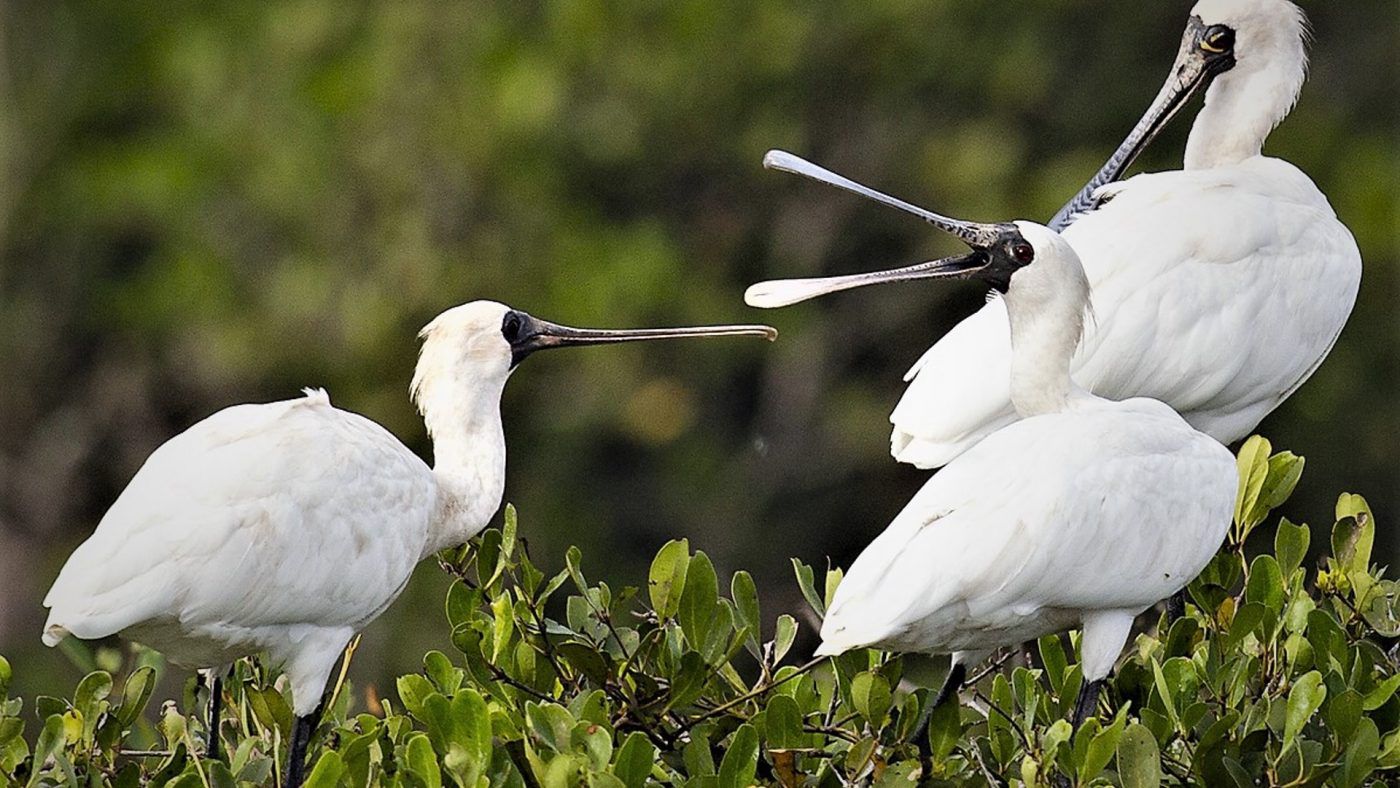
Thanks to its favorable geographical position along with the biodiversity of flooded ecosystem, every year thousands of wild birds from the north leave their homeland and migrate to Xuan Thuy National Park to find a little sunshine and fresh food in the south. The park offers an unforgettable experience for those who want to explore the beauty of wildlife, from rich mangroves to little-known waterfowl species. Photo: Internet
Xuan Thuy National Park
The fertile alluvium of the Red River and coastal sea currents have created a unique wetland at the mouth of the Red River (the Ba Lat estuary). In 1988, this area was recognized by UNESCO as a Ramsar site. In 2003, in order to preserve the wetland ecosystem where a great diversity of plants and animals that live here, especially aquatic species and water birds, migratory birds, Xuan Thuy National Park was established on an area of 14,500ha, of which the core zone is 7,100ha. In 2004, UNESCO continued to recognize Xuan Thuy National Park as the core area of the World Biosphere Reserve in the coastal areas of the Red River Delta provinces.
In the park, there are 192 species of vascular plants, of which nearly 20 species are adapted to flooded conditions to form a system of mangroves in an area of over 3,000ha. In terms of animals, in addition to 17 species of mammals, 37 species of reptiles & amphibians were recorded and rich aquatic resources with over 500 species of benthos and zooplankton (shrimp, fish, crab, oysters, clams, etc.) have also been identified. The park is an important resting and wintering place for 136 migratory waterfowl species with tens of thousands of individuals from November to March every year. This place regularly records the presence of
endangered waterbird species in the Red List such as the Black-faced Spoonbill, Spotted Greenshank and Spoon-billed Sandpiper, etc. However, the park faces challenges to prevent illegal human activities such as bird trapping, fishing, cutting mangroves for wood in the core zone because the wetlands still play a major part in local livelihoods and income.
Con Ngan and furthermore Con Lu have a history of over 100 years, and Con Mo (also known as Con Xanh) which was built up about 20 years ago. They mostly belong to the core zones of the national park, where the natural environment is strictly protected, but in some areas the locals are still allowed to have natural clam collection on tidal flats and earn living from other natural resources from wetlands. This is also a place where visitors can admire tranquil tidal creeks, watch a lot of strange birds roaming around and learn about the lives of the people by riding boats through the mangroves.
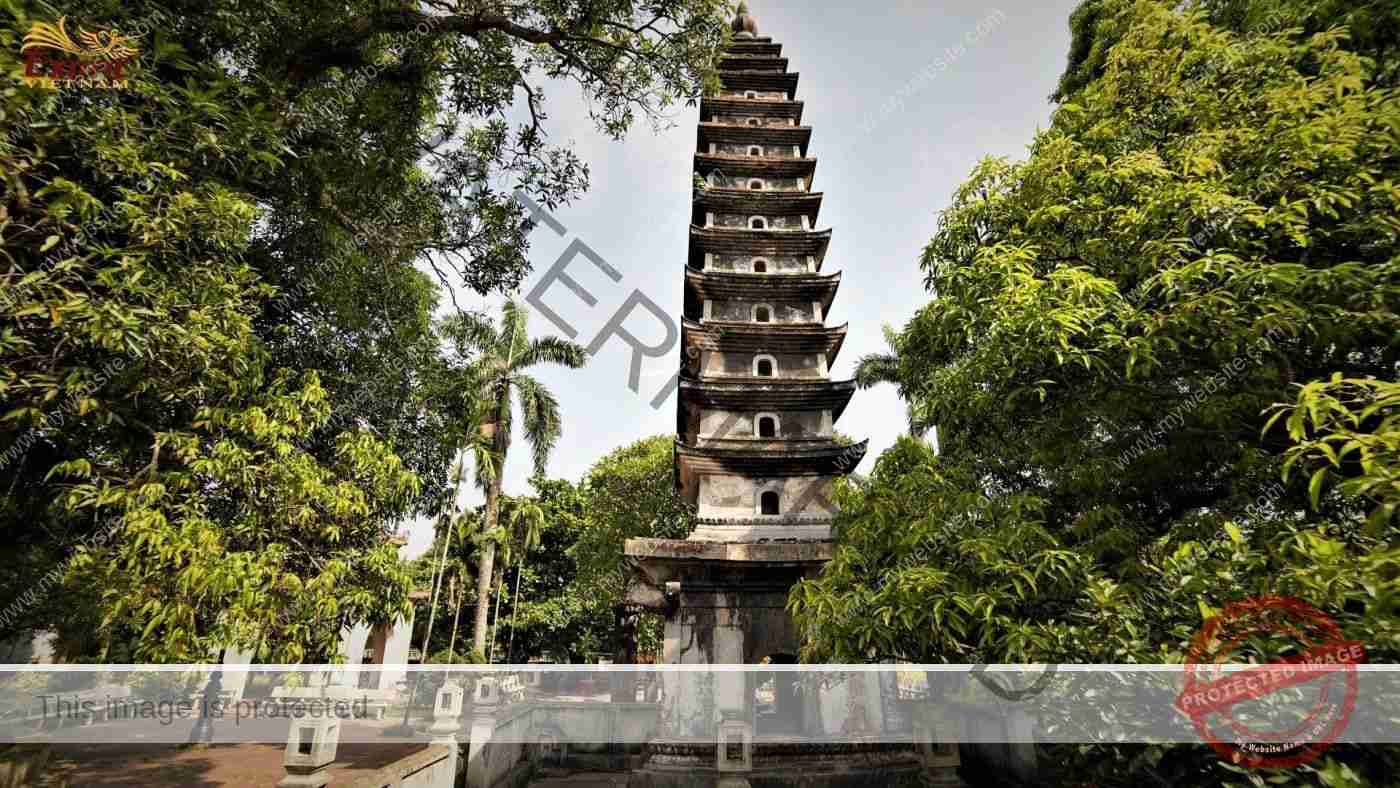
As a royal Buddhist temple, Pho Minh Pagoda used to be the place to organize Buddhist religious ceremonies for the emperor and the royal family. The architectural works and carvings here still retain the imprints of the Tran and Mac dynasties such as ironwood doors, Pho Minh tower, etc. With a history of more than 700 years, the pagoda is really a national treasury. Photo: Exotic Vietnam
Pho Minh Pagoda
5km from centre of Nam Dinh City, Pho Minh pagoda was originally built during the Ly Dynasty and later expanded in 1262 during the Tran Dynasty. It was a place for many Tran Dynasty’s emperors and high-ranking mandarins to chant the Buddhism scriptures. According to historical books, in 1308, after Tran Nhan Tong’s death at Yen Tu mountain, his son Emperor Tran Anh Tong placed 7 of the 21 sarira of his father in a stone palanquin and built Pho Minh tower above.
Pho Minh Tower was built in a square shape like a lotus, including 14 floors, 19.5m high. The two lower floors are made of stone, the remaining floors are built with bare bricks. At the foot of the tower, there are also stone markers where a very large copper cauldron used to be placed, which is classified as the four bronze wonders of An Nam. This cauldron was melted down by Ming Dynasty’s army to make weapons in 1426 while in siege.
Besides Pho Minh Tower, there are many valuable artifacts in Pho Minh Pagoda. Previously, the pagoda had 120 statues, but due to the destruction of time and war, now there are only more than 50 red-lacquered and gold-trimmed statues, many of which are beautiful in shape, balanced in proportion, and highly artistic. You can find the statue of Emperor Tran Nhan Tong entering Nirvana, the statues of the three founders of the Truc Lam Buddhist Sect, Tran Nhan Tong, Phap Loa and Huyen Quang in the pagoda.
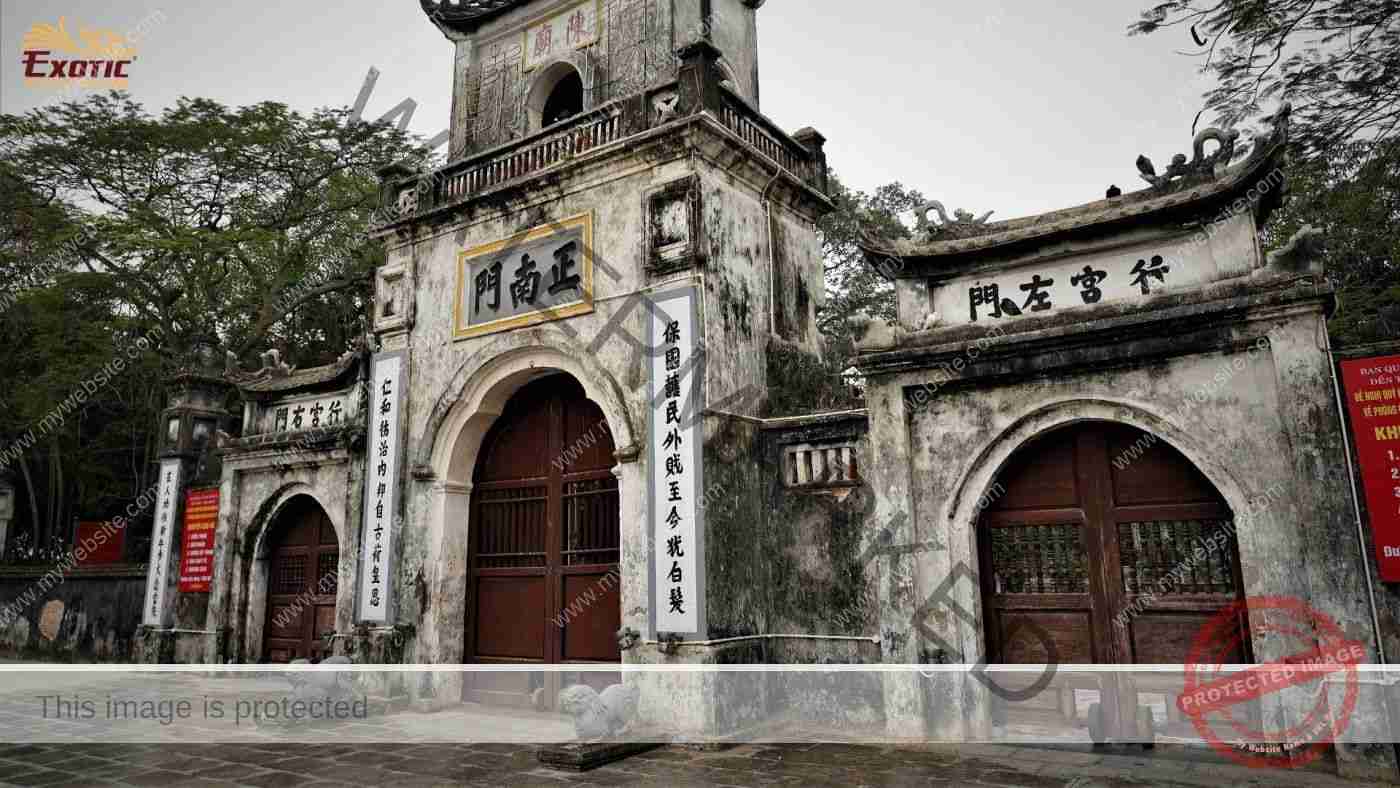
Covering on an area of about 8ha, the Tran Dynasty relics are located on a high ground. Surrounded by Vinh Giang River, the land has the form of a lying dragon. According to feng shui theory, Tuc Mac is the land of kings. Although the original architecture is no longer there, the cluster of temples built in the late 17th century now is always a must visit in Nam Dinh. Photo: Exotic Vietnam
Tran Dynasty’s Temple
The outstanding feature of Tran Dynasty’s Temple is that it’s structured by three architectural works: Thien Truong Temple (Upper Temple), Co Trach Temple (Lower Temple) and Trung Hoa Temple have the same design and equal size. Each temple consists of 3 main buildings: a 5- compartment front hall, a 5- compartment middle hall and a 3- compartment main sanctuary.
Located in the centre, Thien Truong Temple was built in 1695 on the foundation of the former Thai Mieu – the ancestral temple of the Tran family and the former Trung Quang Palace – where the grand emperors lived and worked. The front hall is the place for worshiping the mandarins with great merits to assist the Tran Dynasty. The middle hall is laid the tablets of the 14 emperors of the Tran Dynasty. The main sanctuary worships the four ancestors of the Tran family, and the queens and royal concubines.
Located to the east of Thien Truong Temple, Co Trach Temple was built in 1894 on the old house of Hung Dao Vuong, a hero of the Tran Dynasty who commanded the Dai Viet armies that repelled two major Mongol invasions in the 13th century. The front hall is placed tablets of three Tran Hung Dao’s trusted generals, Pham Ngo, Pham Ngu Lao and Nguyen Che Nghia. The central hall worships tablets and statues of Tran Hung Dao, his 4 sons, Pham Ngu Lao and the left right generals. The main sanctuary is placed the tablet of his parents, and his wife (Princess Thien Thanh), 4 sons and 4 daughters-in-law, daughter and son-in-law.
Located to the west of Thien Truong Temple, Trung Hoa Temple was built in 2000 on the foundation of the old Trung Hoa Palace – where the reigning emperor received advice from the grand emperor. In Trung Hoa Temple, there are 14 bronze statues of the 14 Tran Dynasty’s emperors, located in the middle hall and the main sanctuary.
Attracting a large number of visitors from all over the country who want to be promoted and successful in career, Tran Dynasty’s Temple annually organizes the Seal-opening Ceremony on January 15 (lunar calendar). This festival dates back to the old days when the emperor worshiped Heaven and the court opened the national seal to return to normal work after the Lunar New Year holiday.
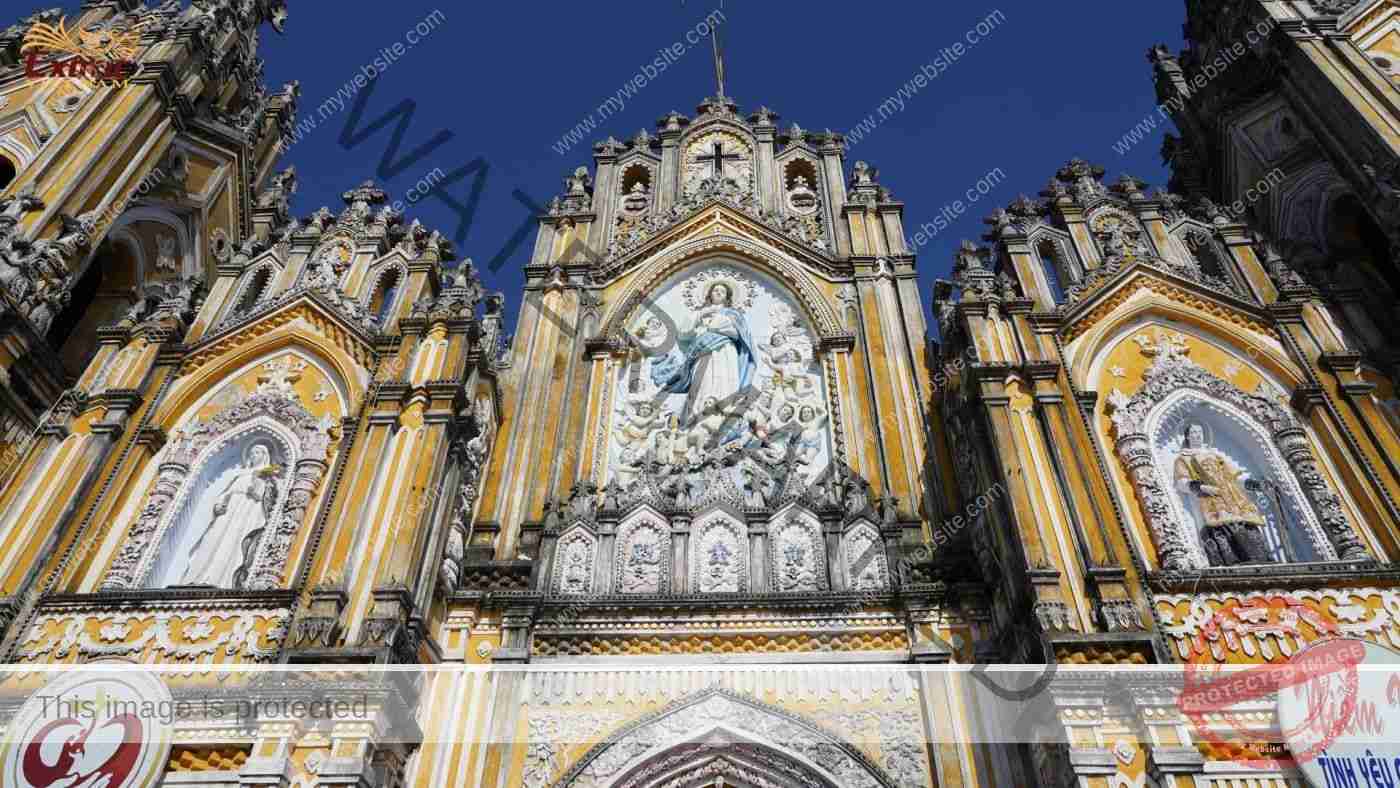
Regarded as the cradle of Christianity in Viet Nam, Nam Dinh is home to one of the oldest and largest Christian communities in the country and has an incredible number of splendid churches. The churches here stand out with their groundbreaking architecture and make a strong impression on both believers and non-believers. Photo: Exotic Vietnam
Churches in Nam Dinh
The year 1533 marked the history of mission in Viet Nam with the presence of the first Portuguese missionary to the coastal villages of Truc Ninh, Hai Hau and Xuan Truong districts of present-day Nam Dinh province. By 1659, after less than 50 years preaching of the Jesuits with language differences, cultural barriers, a separate diocese was still not established, yet Catholicism had spread all over Son Nam county (Nam Dinh, Ninh Binh and Ha Nam provinces now) with 183 churches built out of a total of 340 churches in the country. Since the 17th century, the Jesuits have missioned here, also there were Société des Missions étrangères de Paris, the Order of Discalced Augustinians, and especially the Dominicans.
Founded in 1659, experienced many ups and downs in history such as 1848 – 1936 and 1954 – 1989, the current Bui Chu diocese is located in Nam Dinh province, divided into 13 deaneries with 181 parishes and a number of believers possibly reaching 90% of the population in some places. The development of Catholicism also makes Nam Dinh home to more than 600 churches, large and small. At some viewpoints, just standing in place and looking around you can see 9 to 10 church bell towers in the distance, looming in the villages and rice fields. Spanning a long history, churches are mainly built in Gothic and Baroque architectural styles, but some clearly show traditional Vietnamese architecture such as façade in the style of three-arched-entrances gate or interior with gilded wood.
The church is considered as the common house of the community in the village, showing the attachment of not only religious rites but also the memories of a person’s life from first baptism, confirmation, marriage to funeral. Therefore, each church is both a splendid and unique architectural masterpiece in harmony with the natural landscape and the pride of every devoted believer in the parish.
In Xuan Truong and Hai Hau districts, just a few kilometers away, you can see prominent churches with many meticulous patterns and harmonious colors, large arched doors and soaring bell towers. Some of beautiful churches can be visited such as Phu Nhai (Basilica since 2008), Bui Chu, Kien Lao, Trung Lao, Phuong Chinh, Bao Dap, Ninh Cuong, Trung Linh, Thuy Nhai, etc., especially the ruined and mossy relics of Hai Ly church at Xuong Dien fishing village due to coastal erosion.
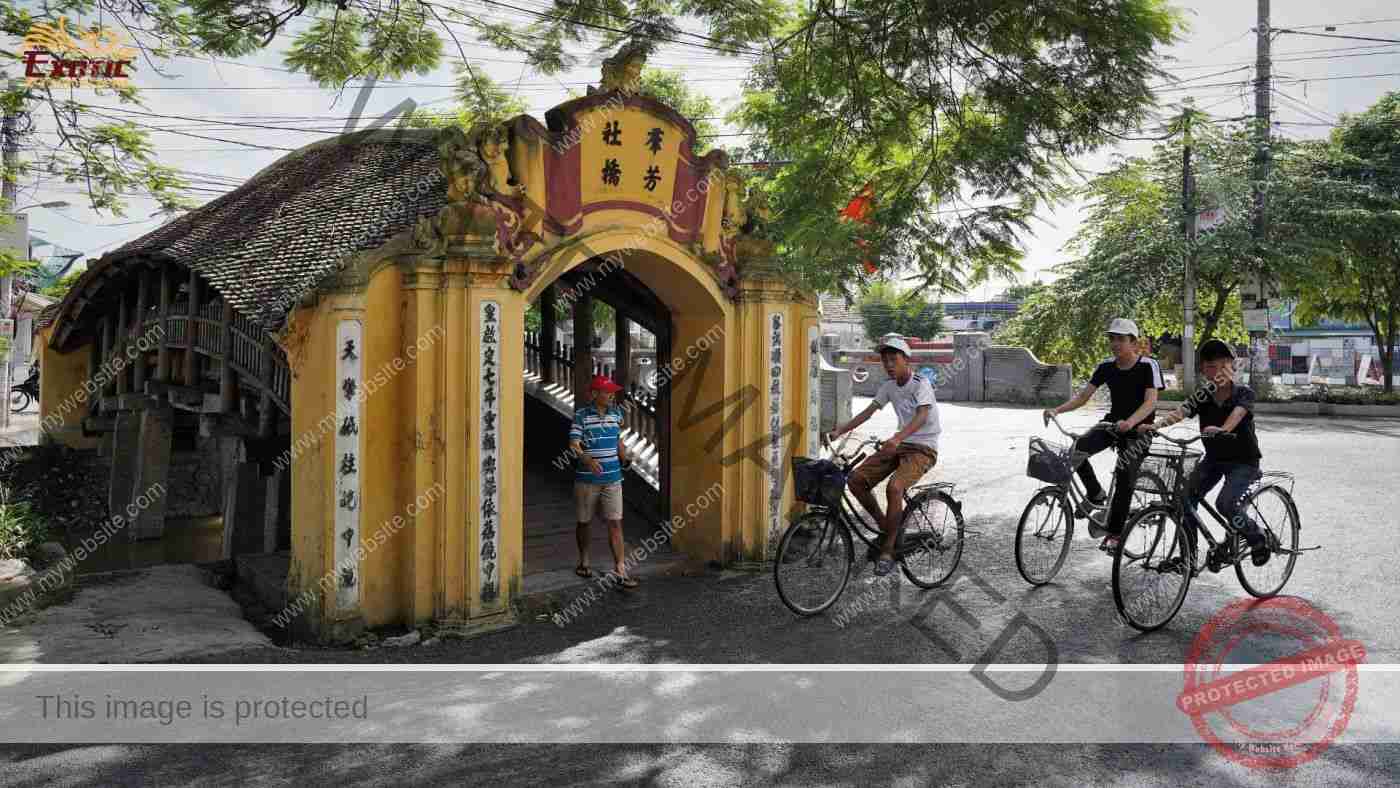
Leisurely bikers, photographers, nature lovers and history seekers will revel in decades of kilometres of scenic rice fields, rustic agricultural villages and unspoilt wetland that make up the dramatic landscape of Hai Hau countryside. Admire the artistic interiors of a Catholic church before experiencing the craftsmanship in the households, travel back in time with a visit to an ancient tile-roofed bridge, or step into quaint villages, market towns and live like a local, sampling longan-shaped cakes, char siu cakes, grilled fish, etc. right at their home. Photo: Exotic Vietnam
Hai Hau Countryside
In 1461, Emperor Le Thanh Ton issued policies to encourage people to reclaim in coastal alluvial areas. History books record four pioneers including Mr. Tran Vu, Mr. Vu Chi, Mr. Hoang Gia, Mr. Pham Cap and their descendants who came to the sea of Hai Hau today, established Phu Cuong quarter, later changed to Quan Cuong hamlet, in 1511 changed to Quan Anh commune. The first large-scale salinity prevention dyke, Hong Duc dyke, running along the coast of the Red River Delta, was completed in the late 15th century. Along with the opening of creeks, the Xe river was excavated to bring fresh water to remove salt from the fields, in a short time, the deserted flooded grounds full of reeds, became fertile land of lush rice fields. By 1888, Hai Hau district was established consisting of many rich villages, living mainly on wet rice cultivation, and secondary income from fishing and salt making.
Hai Hau is also famous for countless Catholic churches, each with a different architectural mark. Many churches are hundreds of years old, ancient and mossy, sone of which have been restored or newly built, but still keep their original appearance. This is followed by a visit to Cho Luong tile-roofed bridge which was built from 1509 -1515 (restored in 1922 and 2010) across the Hoanh River, is a must stop for all visitors to take a picture of the ancient architectural heritage. Coming to Hai Hau, visitors have the opportunity to explore the daily life of the locals, learn about the customs and habits of ancestor worship, visit traditional craft villages such as silk nursery, bronze trumpet making, water puppetry, carpentry, and so on, taste local specialties, and above all feel the sincerity and simplicity of locals.
Exotic Vietnam introduces a team building program in the format of The Amazing Race or Treasure Hunt. That’s a fun and unique rural adventure and takes participants to move with bicycles, on foot, inflatable rafting or local vehicles. The players have got a close up to the communities and give hands on interaction with their daily works to find hidden clues. Rach village – water puppetry, Hai Ly – church ruins, Bach Long – salt field, Xuan Thuy – national park, etc. are among the places to be found by GPS devices or maps. Here, the team building challenges are designed to simulate local values, helping players both expand local knowledge and improve teamwork. The impression of a rustic Hai Hau countryside, from rice fields, ancient architecture, to hospitable residents will be kept forever in everyone’s mind.
TEAM BUILDING IN QUANG BINH
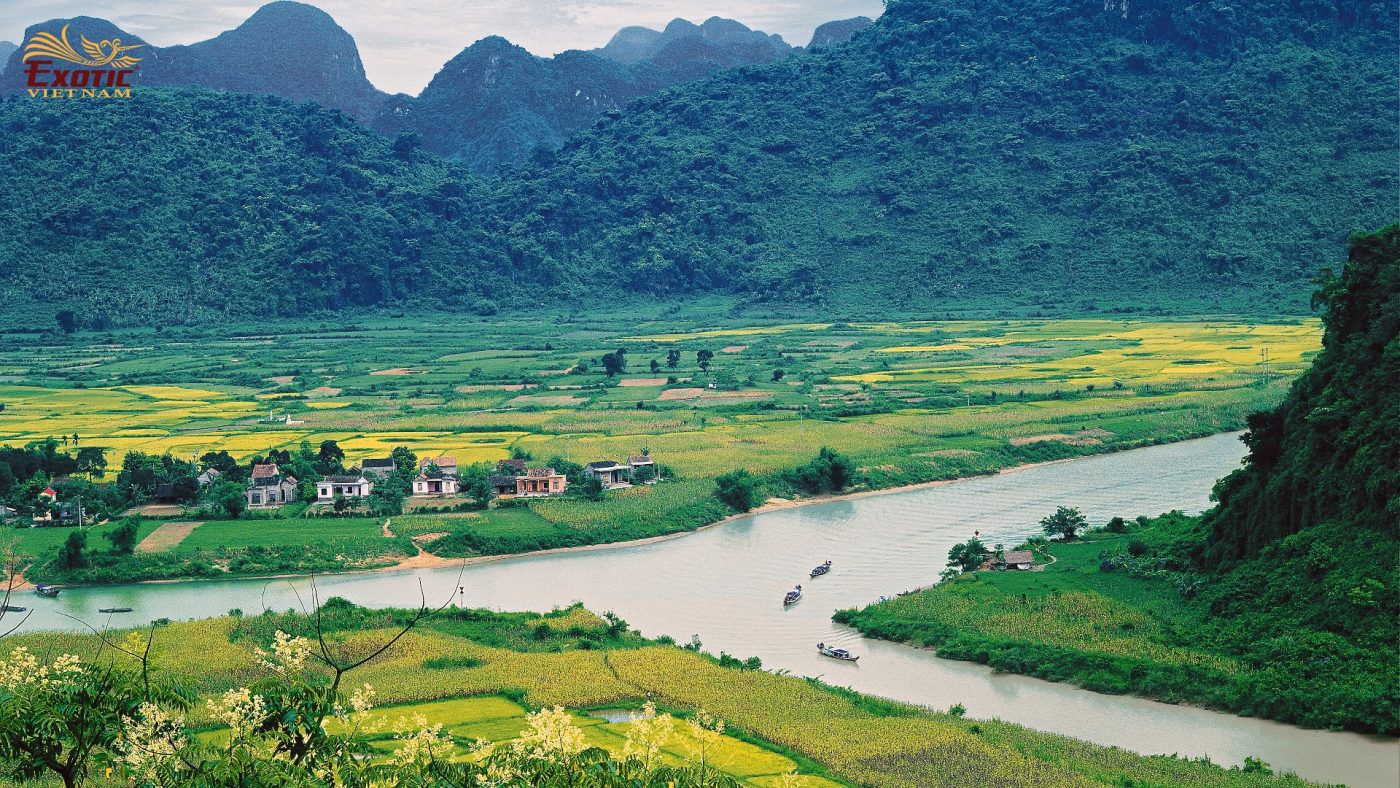
Known as the “land of caves”, Quang Binh is home to the largest limestone massif in Indochina with so many natural wonders and unique phenomena. Among the best things to do in karst is a visit to some of its 300 caves and underground rivers. Photo: Exotic Vietnam
Location: 162km from Hue (3½ hours by car), 200km from Vinh (4 hours by car).
Introduction: Dong Hoi, the capital of Quang Binh Province, has graceful rivers, fragrant lotus lagoons, white sand dunes and wild beaches. A little further northwest is Phong Nha – Ke Bang National Park, a World Heritage site recognized by UNESCO in 2003. Known as the land of caves, the park protects one of the world’s two largest karst regions with several hundred majestic caves and grottoes in which Son Doong Cave was accidentally known by a local named Ho Khanh in 1990 and then discovered by British cavers in 2008. It has quickly taken the title of the largest cave by the Guinness World Records in 2009. Besides its famous value of the karst landscape, the park is also testified to its globally outstanding biodiversity. The legendary Ho Chi Minh Road and war vestiges can be seen en route.
Highlights: Phong Nha Cave, Tien Son Cave, Eight-lady Cave, Thien Duong Cave, Son Doong Cave, Dark Cave, Tu Lan Cave, Va cave, En Cave, Cha Loi Cave, etc.
Facilities & services: boat ride, cave exploration, world-class hotels & resorts and restaurants.
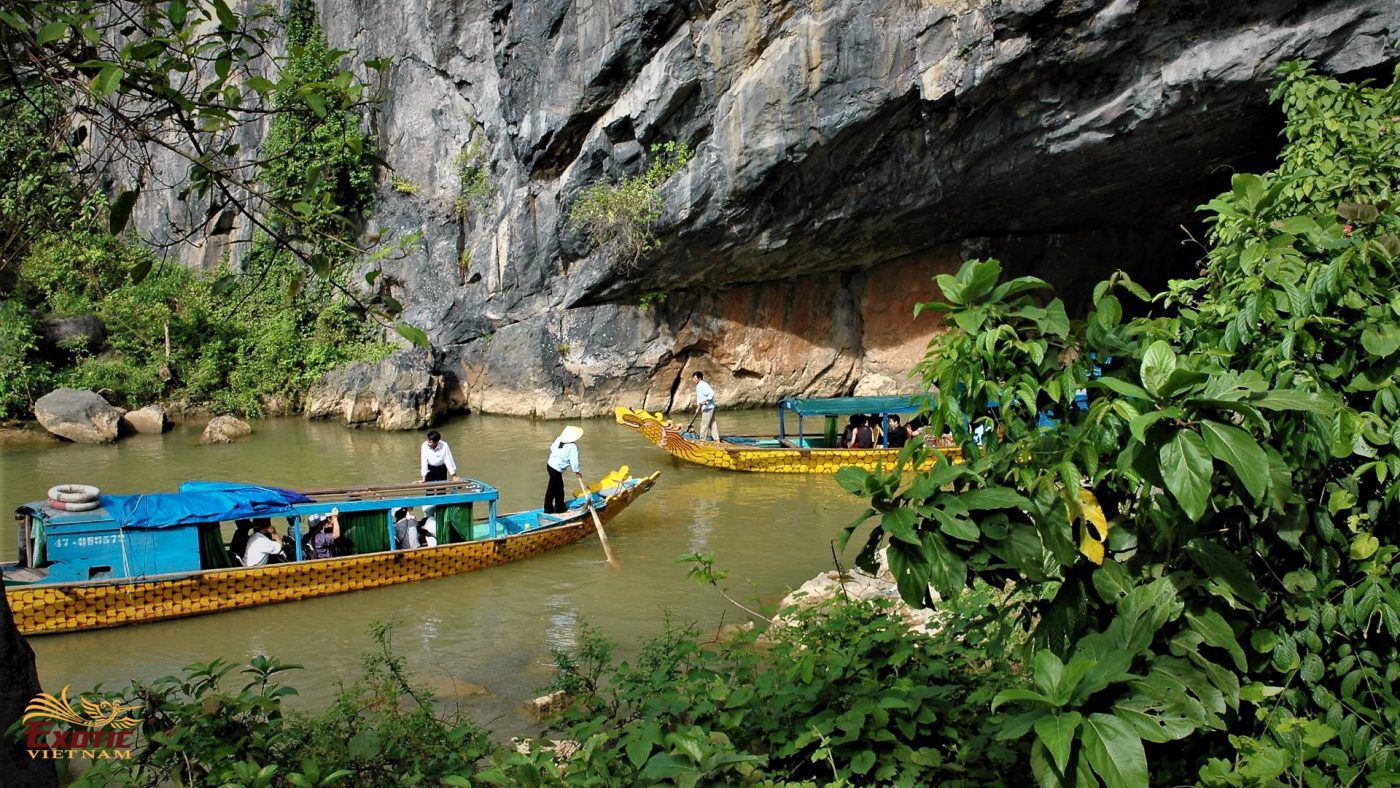
Discovered by the Cham people since ancient times, Phong Nha Cave has also been carved into one of the Nine Dynastic Urns at Hue Imperial Citadel. Photo: Exotic Vietnam
Phong Nha Cave
Phong Nha Caves, 50km northwest of Dong Hoi, lie under the limestone massif of Ke Bang in Quang Binh Province. The main cave system contains 14 chambers, linked by an underwater river that runs for decades kilometres. Secondary corridors branch off in all directions. For tourism, visitors can do sightseeing from the open to some 600 meters long into the cave. The first stop is the Bi Ky Cave, where they step out of the boat to explore a fantastic landscape of white sand stretch and colourful rock. Stalactites and stalagmites jut out like strange trees, exciting their imaginations. Thien Cung cave and Cung Dinh cave are also worth to visit. All three caves are lighten by hidden coloured bulbs.
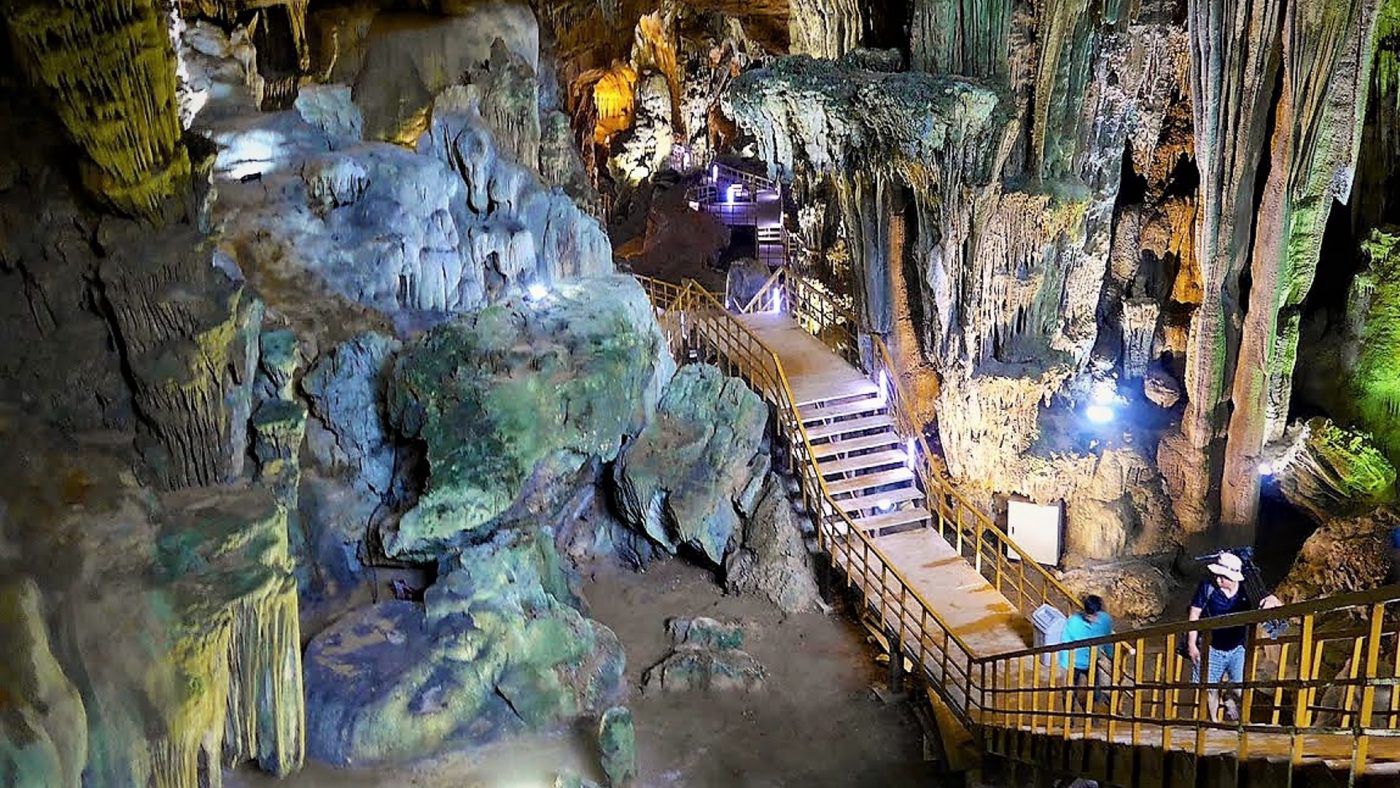
Tien Son cave is the past image of Phong Nha cave. The tectonic movement made this massif rise up, causing the underground river to erode in depth, forming Tien Son dry cave above. Photo: Internet
Tien Son Cave
Tien Son Cave was discovered in April 1935 in the limestone mountain of Ke Bang. It is about 400 metres away from the famous Phong Nha Grotto and at a height of 135 metres. Tien Son Cave is more than 980 metres long. At present, nearly 400m of the cave have been installed with lighting system to make it safe for visitors. The cave looks marvelous inside with hundreds of stalagmites and stalactites of different sizes and shapes. Some look like a man or an animal, and there is one that looks like the Leaning Tower of Pisa in Italy. On the cave ceiling, there are glittering gold and silver-like veins. Some stalagmites produce an echoing sound when slightly knocked.
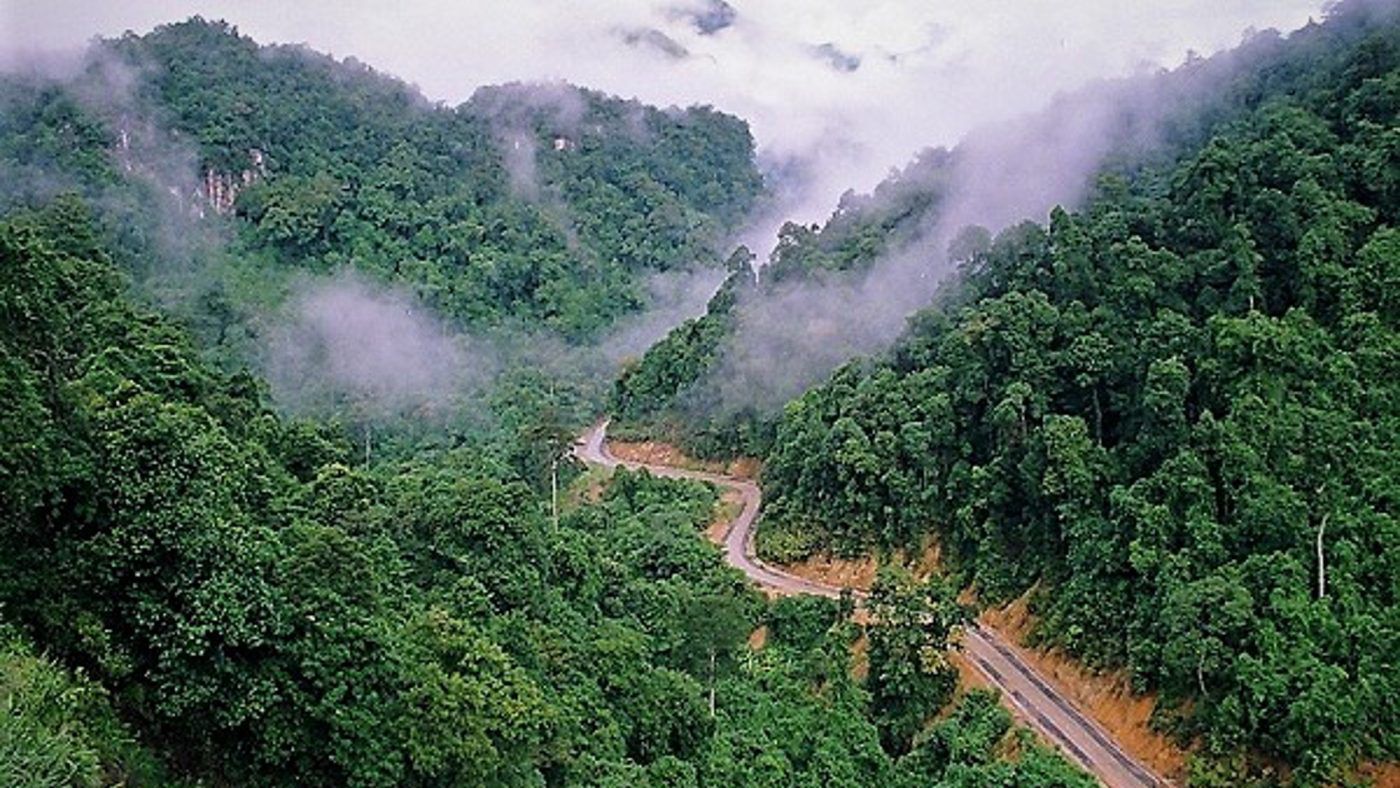
On the Road 20, a branch of Ho Chi Minh trails full of bombs in the past, Eight-lady Cave is considered as a Martyrs’ memorial to tribute the great sacrifice of the volunteer girls and artillery soldiers who were tragically trapped in the cave after a bomb strike. Photo: Internet
Eight-lady Cave
The sacred cave is a popular stop for those traveling on Road 20 on the way to the Paradise Cave. The women starved to death in 1972 in a rock cave when they were hiding from U.S. raids. U.S. bombs caused an immense 100-ton rock to fall over the only exit of the cave that the women were hiding in. Great efforts to rescue the women were in vain. Soldiers stationed nearby recalled that they heard cries for help resounding from within the cave. The voices were steadily weaker day after day and stopped after the ninth day. In 1996, the remains of the eight women were taken out of the cave for official burial.
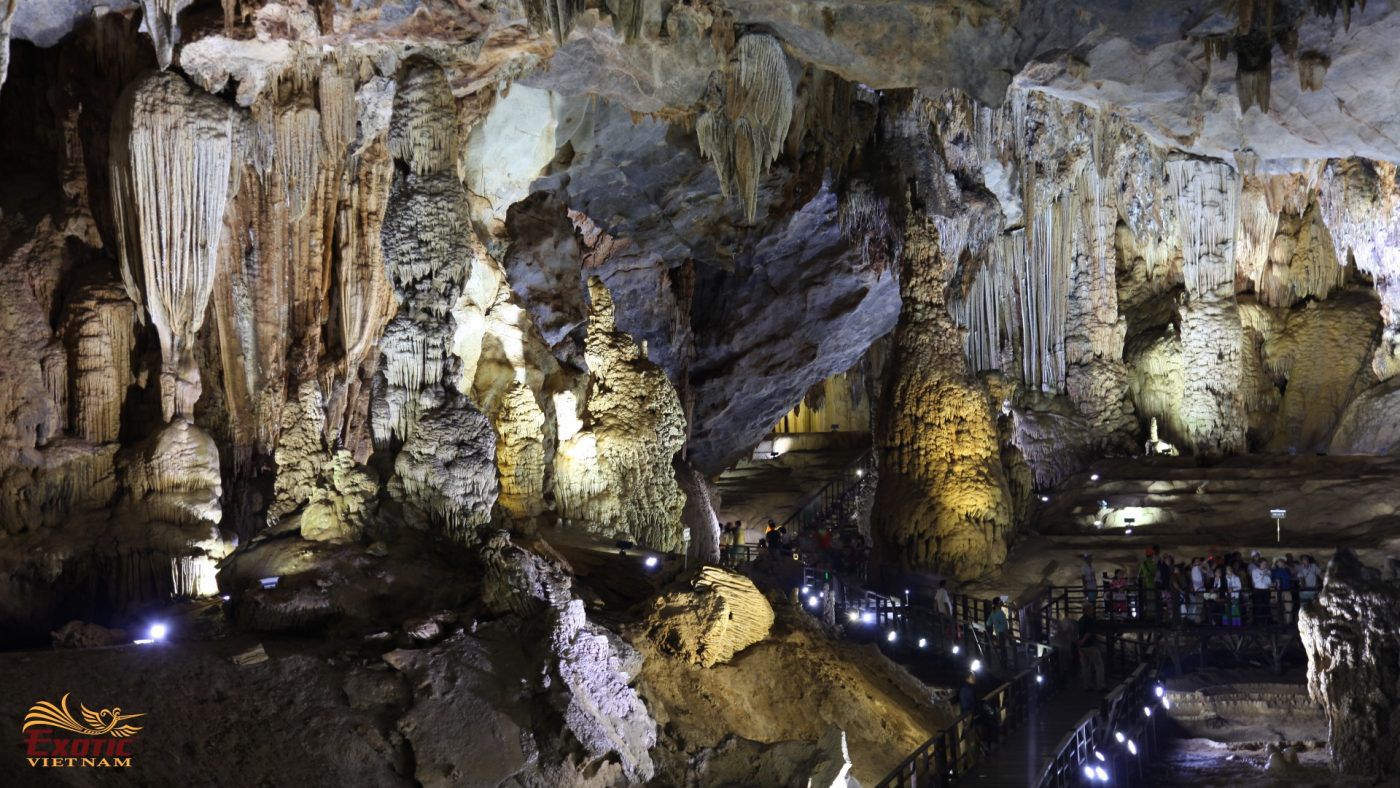
Surrounded by forested karst peaks, Thien Duong Cave can receive a large amount of sightseers at the same time with buggies, wooden staircases and multi-colored lighting system. Photo: Exotic Vietnam
Thien Duong Cave
Thien Duong Cave (Paradise Cave) is a cave in Phong Nha – Ke Bang National Park, UNESCO’s World Heritage Site. Located at an elevation of 200 meters above the sea level, the cave was discovered by a local man in 2005 and 5 first km of this cave was explored by explorers from British Cave Research Association in 2005, the whole 31km was explored and publicly announced by the British cave explorers. This cave is 31km long, longer than Phong Nha Cave which had been considered the longest cave in this national park. The cave can reach to 100m high and 150 wide. The limestone formation is also more spectacular than that of Phong Nha Cave. Only the 1-km path is open to travelers since 2010.
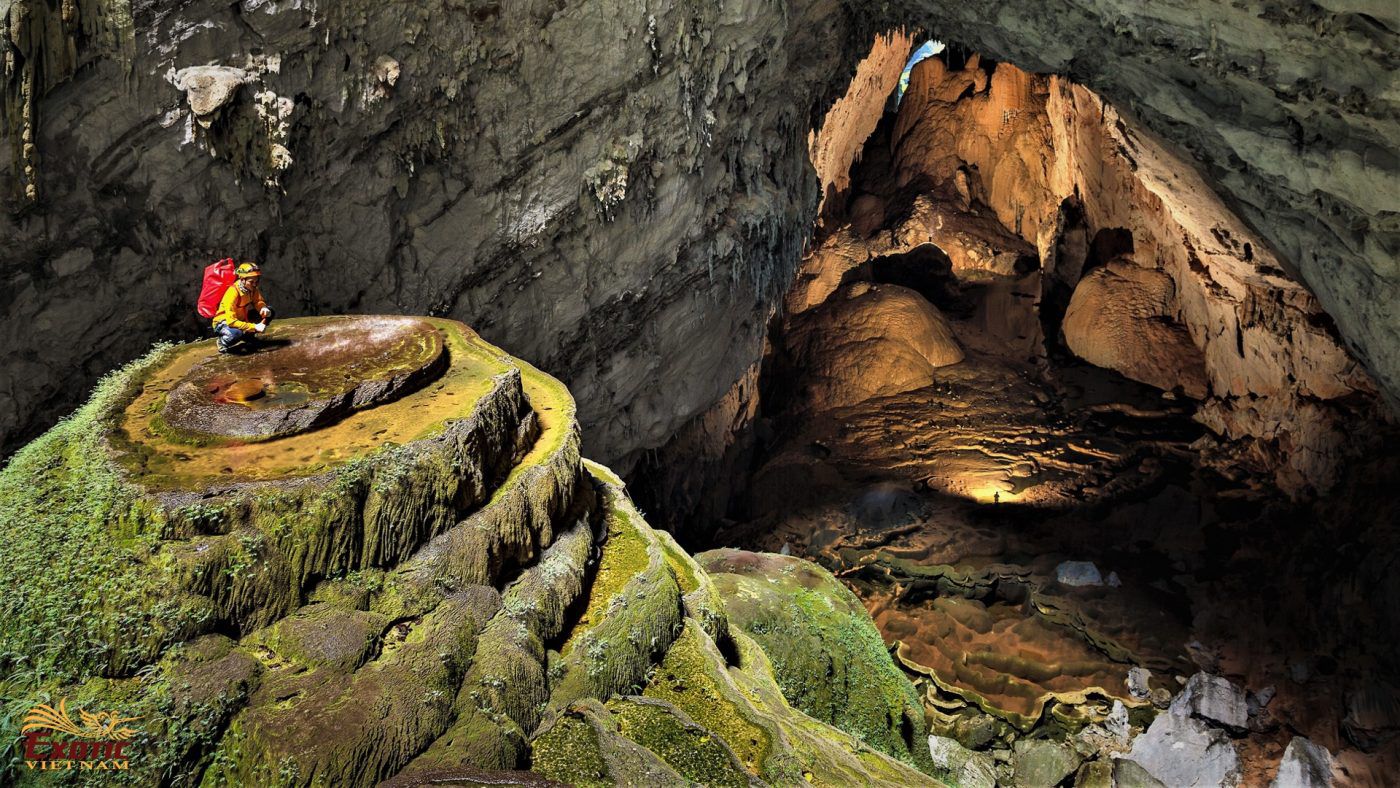
Known as the world’s largest natural cave, Son Doong Cave houses many amazing grottoes, stalactites and stalagmites. It is a must visit for adventure travelers to experience “A Journey to the Center of the Earth” as a tittle of Jules Verne. Photo: Courtesy of Ryan Deboodt
Son Doong Cave
Son Doong Cave was discovered in 1990 in the Phong Nha Ke Bang National Park. It was only first explored in 2009-2010 by the British Cave Research Association. It was created 2-5 million years ago by river water eroding away the limestone underneath the mountain Where the limestone was weak, the ceiling collapsed creating huge skylights… The length of Son Doong cave is nearly 9km, in some places the ceiling height is up to 200m, 160m wide. With an estimated volume of 38.5 million cubic meters, Son Doong was officially confirmed as the world’s largest cave, five time the size of Malaysia’s Deer Cave. The stalagmites in Son Doong rise up to nearly 80m. This deep underground scene shows that the world still has many beautiful landscapes to explore.
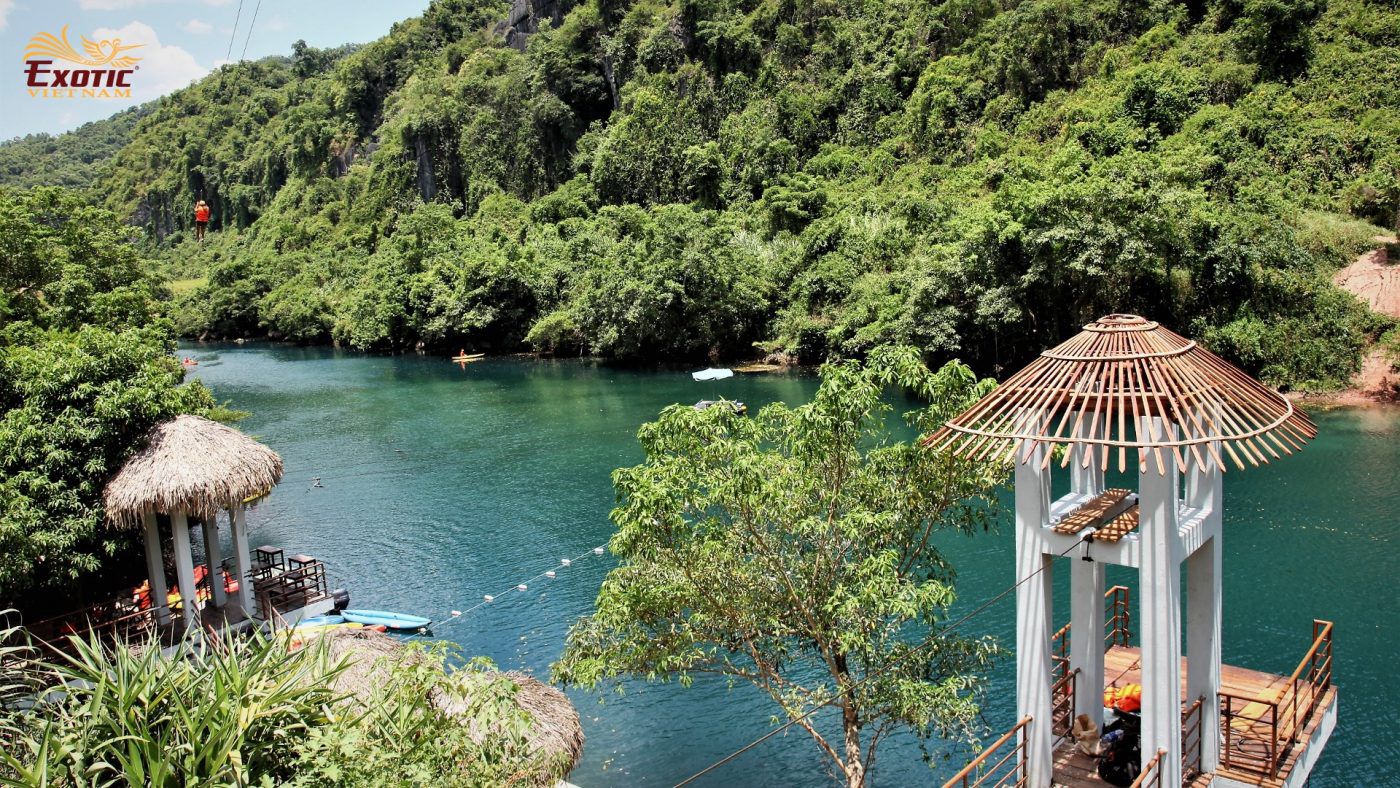
Dark Cave is where fun and adventure meet. Its attractions include zip-lining, swimming, kayaking, mud bathing, and cave exploring. Photo: Exotic Vietnam
Dark Cave
50km to the northwest of Dong Hoi, Dark cave (Hang Toi) was evacuated very early, during the war against American army and was used by the local people as shelters to avoid bombs. In 1992, the British Royal Caves Adventure Association conducted surveys, mapped and measured Dark Cave with an entrance of 40m high & 20m wide, a horizontal length of 5,558m, a height of 80m. Dark cave has a very strange beauty. The cave is still pristine with thousands of stalactite columns with diverse and unique shapes and is the refuge of many animals such as bats and swallows. In particular, the area of the cave is also a shelter for Ha Tinh langurs – one of the primates listed in the Red Book of Viet Nam. Although the name of the cave is Dark but actually not dark at all. The light from the outside cleverly knit into the cave, shoveling the cliffs a little wave of the sun, reflecting the surface of the water shimmering. Not only swimming and kayaking, zipline is a challenging, fun activity that attracts many visitors here.
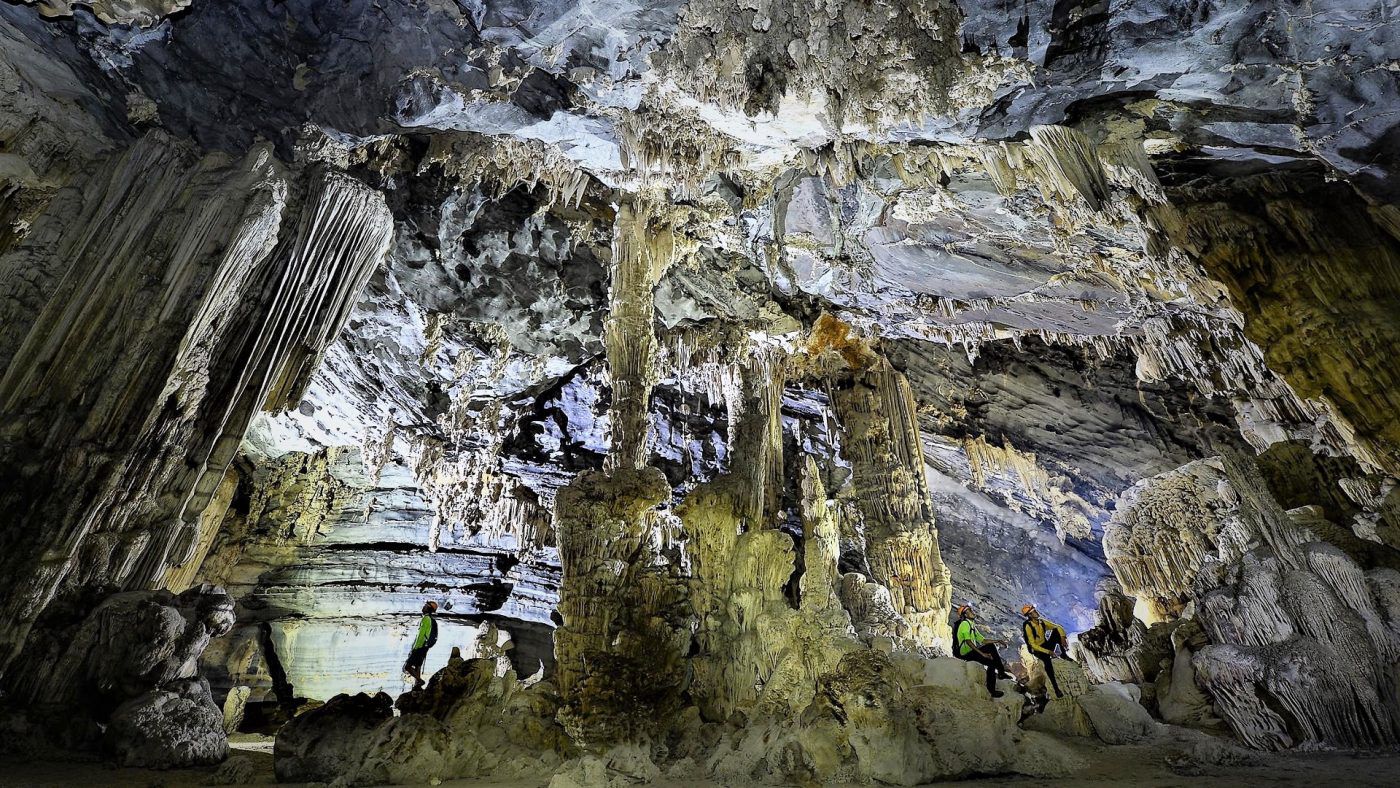
The Tu Lan cave system comprises of more than 20 wet and dry caves. Explore these caves with activities like swimming, climbing, and picnicking that will give you an adventure of a lifetime. Photo: Internet
Tu Lan Cave
About 100km north of Dong Hoi, Tu Lan cave system consists of 8 caves, was discovered from 2009 – 2012. Tu Lan cave system has the main cave system, including Tu Lan cave and the other caves: Song cave, O Sao cave, Chuong cave, Hung Ton cave, Kim cave, Ken cave and Co Mat cave.
Tu Lan cave system is still unspoilt, capturing the secrets of the majestic nature in limestone mountains, with underground rivers and endless waterfalls. To conquer this cave, you will have to go through the rugged mountains, cross the jungle, walk among the vast valleys, muddy slides, and swim through the rivers while suffering the cold under 20 degrees C. With the magical beauty of stalactites, the mysterious underground river plus wild nature of the mountains will make you forget everything once coming here.
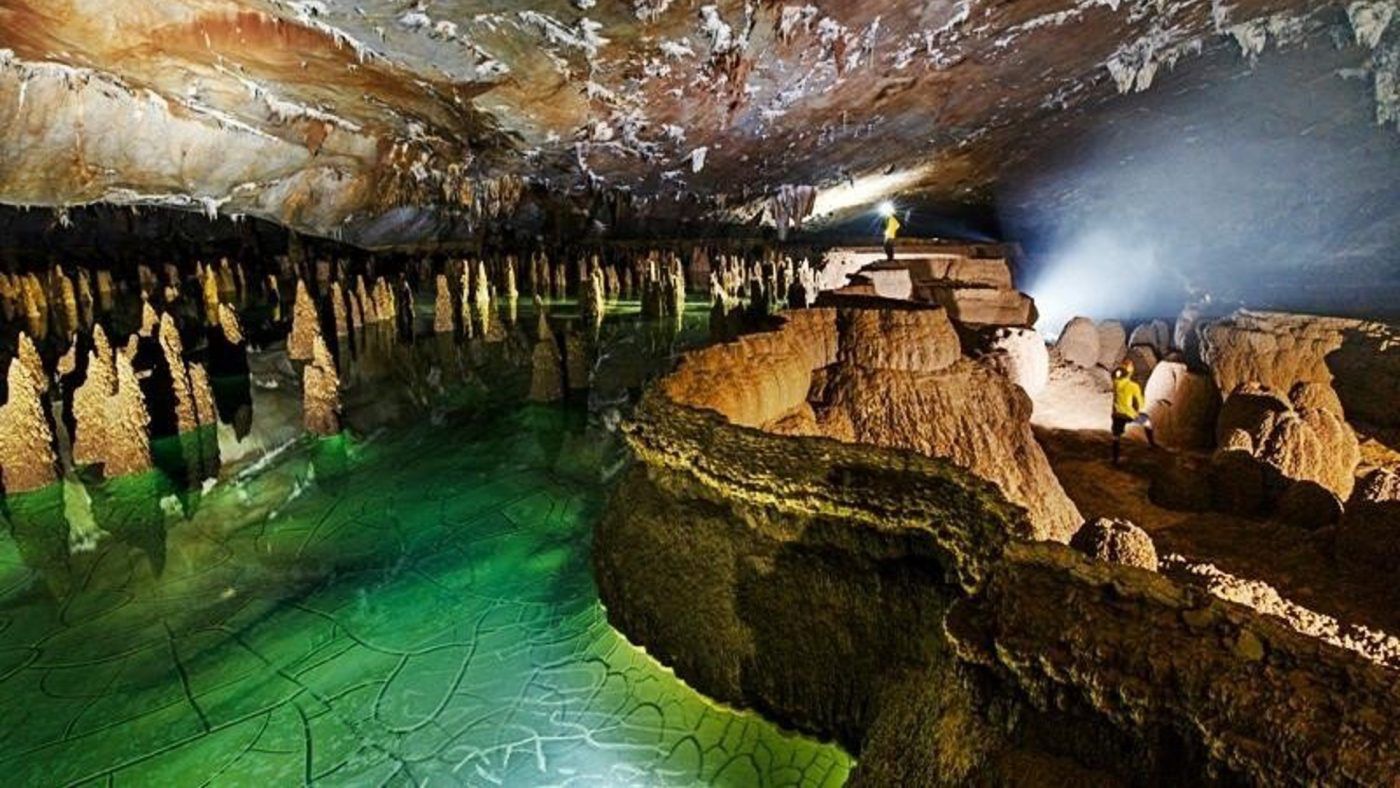
Hang Va is famous for more than a hundred unique stalagmites. These formations rise from emerald water in shapes of raft & tower. Photo: Internet
Va Cave
Located in the heart of Phong Nha – Ke Bang National Park, about 400m from Son Doong Cave, Va Cave was discovered in 2012, and opened to tourism in 2015. It is a million-year-old cave and a mysterious underground river. This cave is 1.7km long and easy to access and explore. The entrance to Hang Va has a collapse in the floor mading up a small steep valley, with cliffs to the north. A descent of about 15m leads into a stream passage, 5m high and wide, which is full of water throughout the dry season. Va Cave is famous for the most unique stalactite formations in shapes of raft & tower cones in the world.
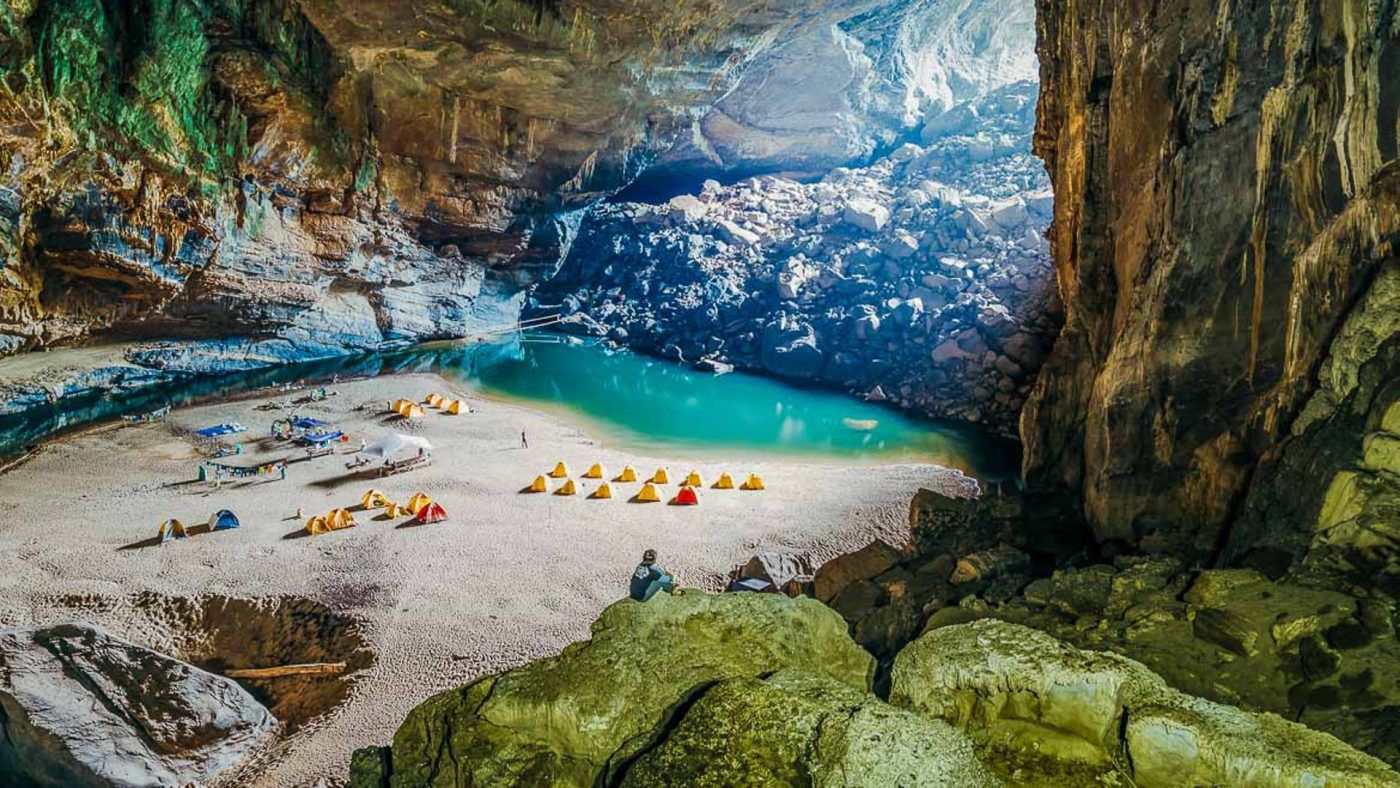
Recognized as the third largest cave in the world, En cave is part of Son Doong cave. The unique feature of En cave is the campsite on fine sand at the cave entrance and the magical world of light and dark at sky caves when magical golden spotlights through the humid air into the green rivers. Photo: Internet
En Cave
Located in the heart of Phong Nha – Ke Bang National Park, about 9km from Ho Chi Minh Road, formed about 3 million years ago, En Cave was first found by the British Caving Association in 1994. The cave is named En (Swallow) because of habitat of many swallows. The cave is 1,645m long, 120m high, 170m wide and has three gates. Two of which are entrance gates at mountain foot and the other one being exit gate at mountain slope. This gate style is a rare feature of cave structure in Viet Nam. There are 3 lakes separated by small alluvial grounds and stones overlapping one another. On ceiling, cliffs of the cave also have many stalactites in unique shapes and swallow nests. The unique feature of En Cave is the holes on the ceiling creating “sky wells” to shine Rao Thuong Stream.
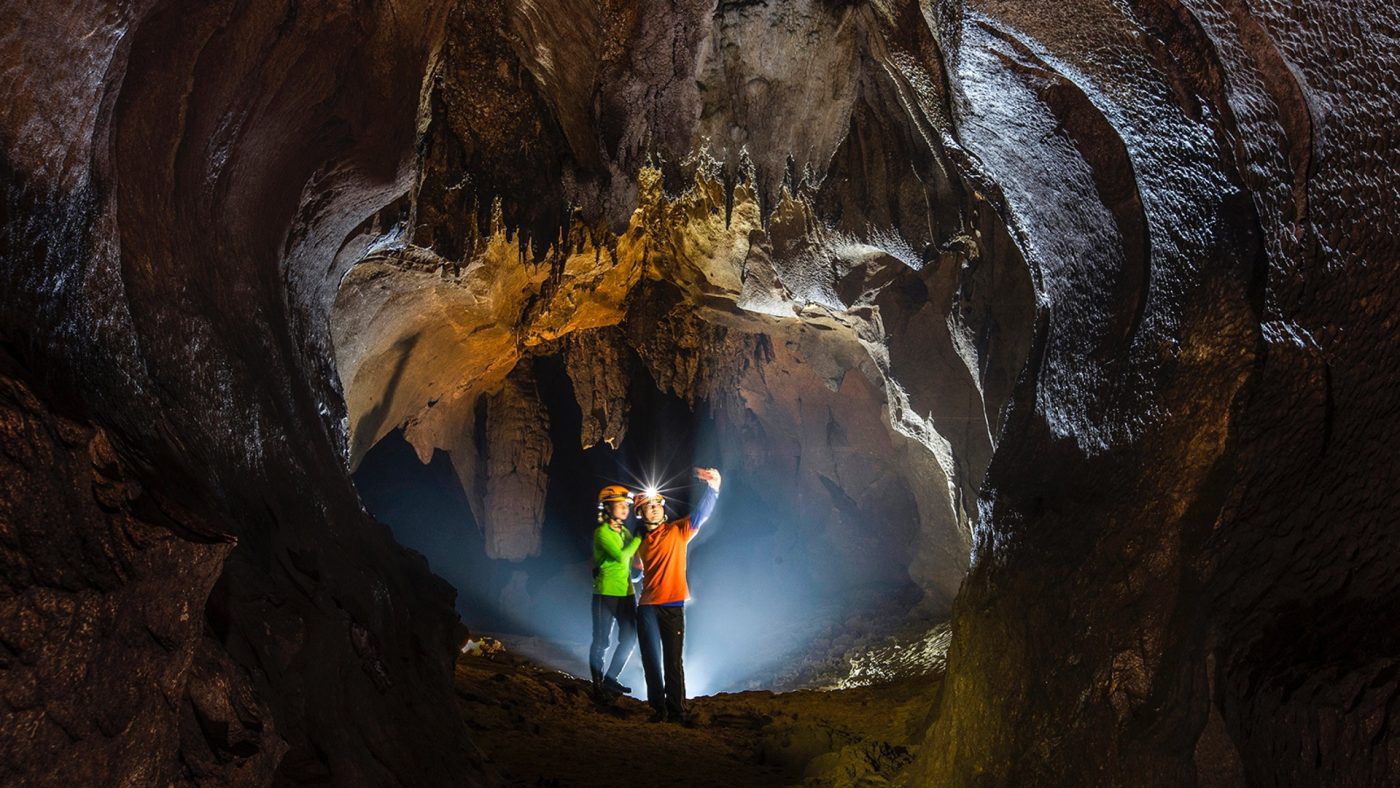
In 2019, Cha Loi cave, a new magnificent and mysterious cave is opened to the public. It’s amazing to explore an underground river with imposing stalagmites and stalactites that is a habitat for many special species of shrimp and fish. Photo: Internet
Cha Loi Cave
Operated as a tourist site since 2019, Cha Loi Cave is located about 40km southwest of Dong Hoi city, this place has once imprinted General Vo Nguyen Giap’s footprints and also the living place of the ethnic local people, Bru Van Kieu. Behind a narrow entrance of only 4m2 is an extremely large mysterious world. The cave has 3 floors, the width of 30 to 100m, the average height of 60m, the highest ceiling at about 90m high. The cave also has a cool and blue underground river, small lakes, where some species of shrimp and fish have a very special transparent color. Stalactites in the cave contain many calcium crystals, so every time the lights shine on, they become beautifully shimmering.
TEAM BUILDING IN HUE
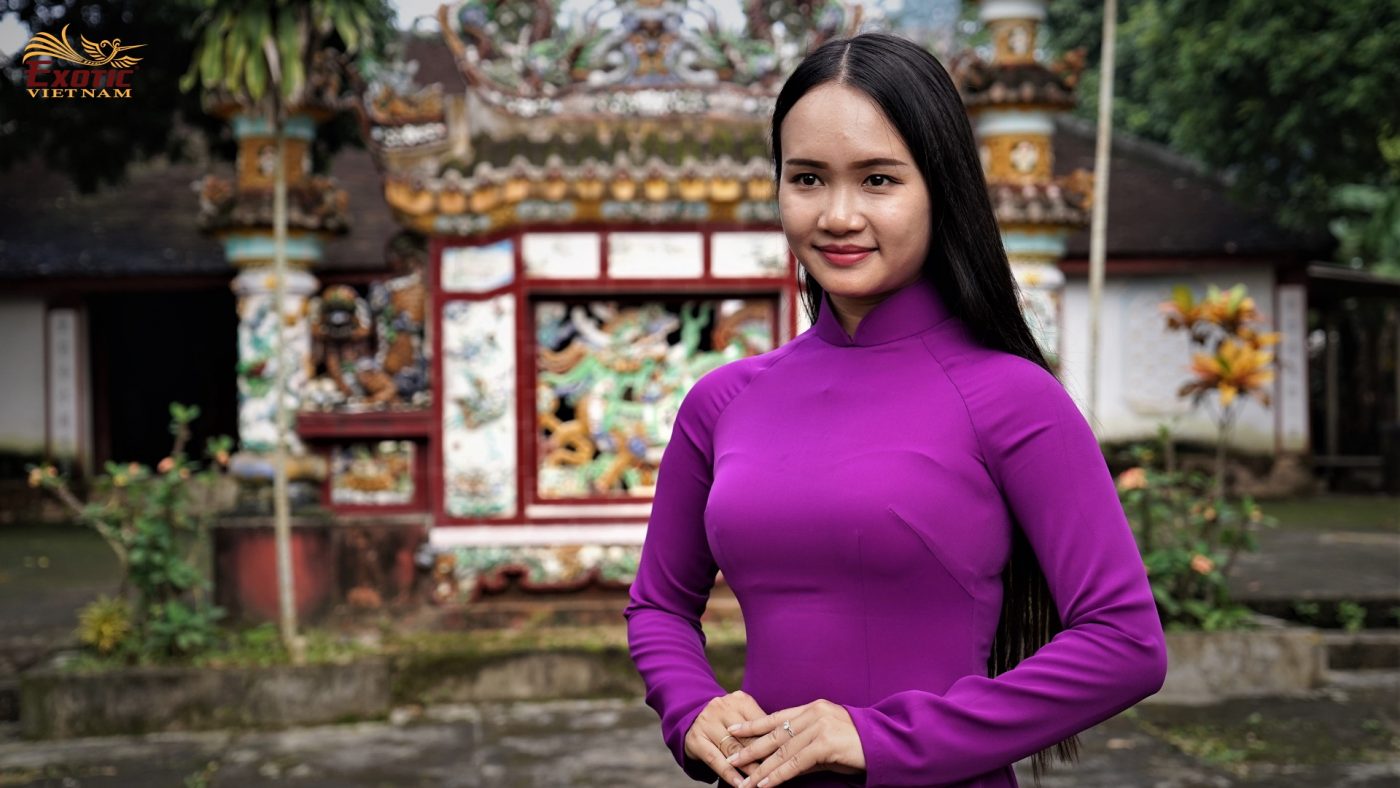
Inherited a long-standing cultural heritage from the Nguyen Dynasty (1802-1945), Hue ancient city impresses visitors through rich historical stories and ancient royal relics, along with the traditional beauty of Hue girls in purple ao dai. Photo: Exotic Vietnam
Location: 660km from Ha Noi (1 hour by plane or 12 hours by train), 1,100km from HCMC (1½ hours by plane or 20 hours by train), 105km north of Da Nang (3 hours by car).
Introduction: Being Viet Nam’s feudal capital from 1802 to 1945 under the Nguyen dynasty, Hue is widely known for the magnificent architecture of its citadels, palaces, royal tombs, pagodas and temples set in a poetic background of greenery on the banks of the Perfume River. All were laid out in harmony with nature and in accordance with the principles of geomancy (feng shui). Besides monuments, Hue still retains much of its past glory in daily routines and activities in religion, gastronomy, handicraft, music, the performing arts and traditional festivals. With those vestiges and cultural treasures, Hue became Viet Nam’s first World Cultural Heritage site recognized by UNESCO in 1993.
Highlights: Bach Ma National Park, Dong Ba Market, Thien Mu Pagoda, Garden houses, Royal citadel, Museum of Royal Relics, Perfume River, Royal tombs (King Tu Duc’s, King Khai Dinh’s, King Minh Mang’s, King Gia Long’s).
Facilities & services: boat ride on the Perfume River, cultural shows, international standard hotels and restaurants.
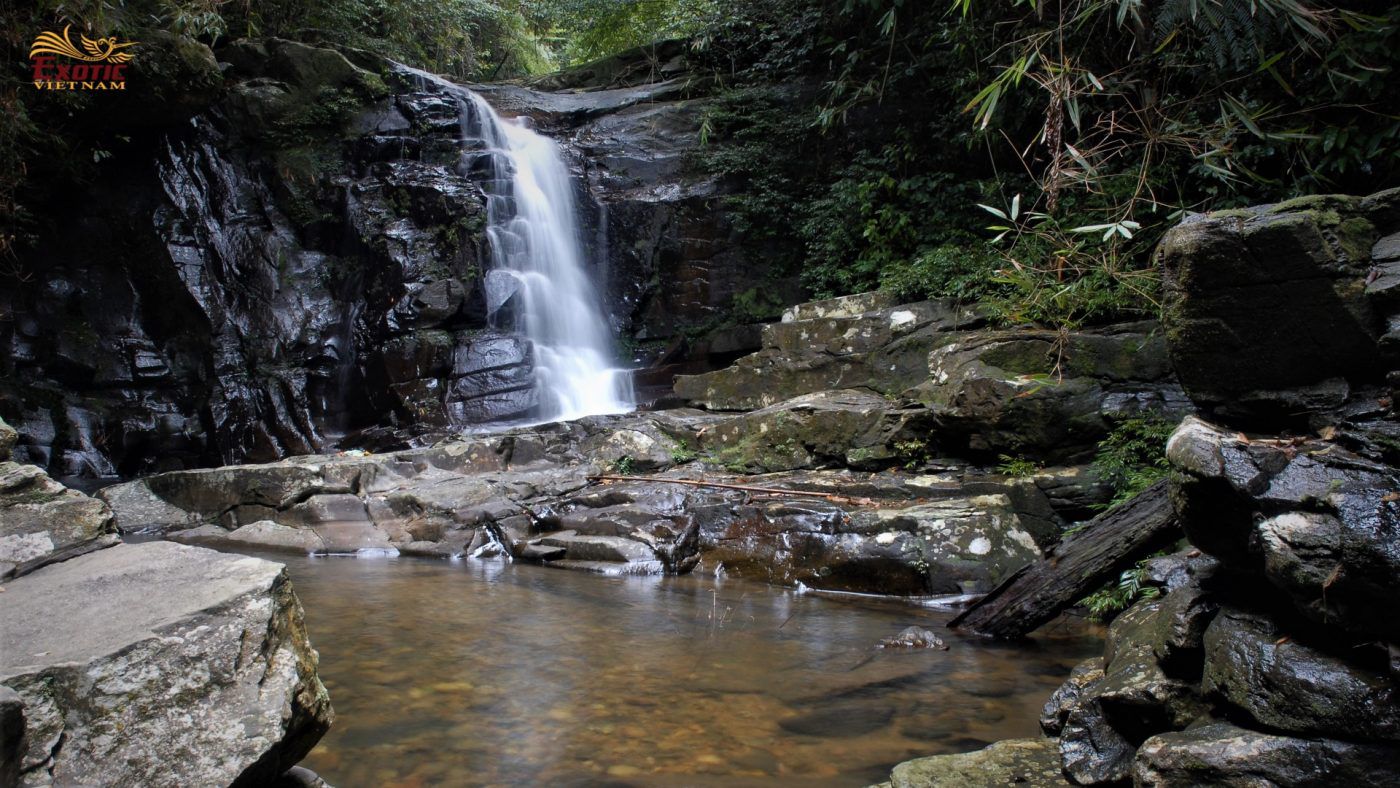
With cool waterfalls, multi-layered canopies and old French villas, Bach Ma National Park offers opportunities to participate in outdoor activities such as hiking, climbing, swimming, sightseeing among the wildlife. Photo: Exotic Vietnam
Bach Ma National Park
Just 45km south of Hue, Bach Ma National Park, is home to old French hill station on Mt. Bach Ma which rises 1,450m. In 1932, this summit was discovered by the French engineer, M. Girard to become a hill station with 139 villas and hotels. During the war, Bach Ma was soon forgotten and the villas abandoned. In 1986 the area was established as a national park. Covering an area of 37,487 hectares, Bach Ma still retains quite a good amount of immense primeval forest with diverse flora (2,147 species) and fauna (more than 1,500 species), in which 93 species are listed on the Red Book of Viet Nam. Waterfalls, crumbling villas, hiking trails, and a wealth of wildlife, including pheasants, langur monkeys, and muntjac deer, make a magnetic spot to spend a day or longer. Visitors can find exciting trekking routes and romantic guest housed in this park. The best time to visit Bach Ma National Park is from April to September, which is the dry season. You should avoid visiting during October to January, because of the rainy and flood season.

With a full array of stalls selling household goods, handicrafts, clothes and fresh food, Dong Ba market attracts visitors not only to bargain to get the best price, enjoy authentic Hue dishes, but also have a lot of sighseeing and capture the everyday moments of the locals. Photo: Exotic Vietnam
Dong Ba Market
Located on the southeastern corner of Hue Citadel, Dong Ba Market has been one of the most famous commercial centers in Viet Nam for more than 100 years. Built in 1899 and then destroyed in 1968, the market was rebuilt on an area of 5ha in 1986. Up to now, all the typical features of a traditional Vietnamese market are still there such as the sampan landing, the bus station and the bazaars. Dong Ba market is a paradise for snapshots of daily activities as well as for shopping with everything from souvenir items to bronze goods, Hue sesame sweetmeat, conical poem hats, etc.
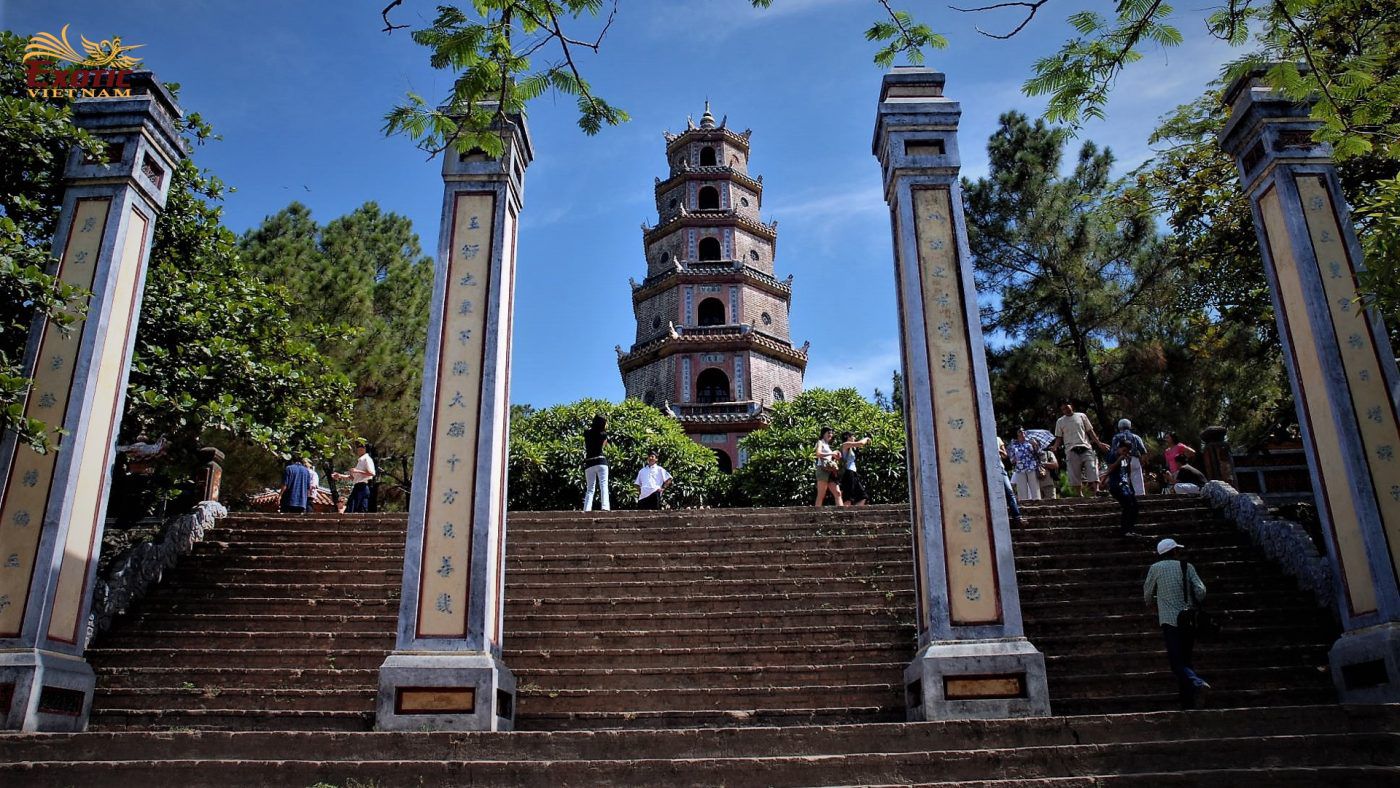
Built on a small hill overlooking the poetic Perfume River, Thien Mu Pagoda adds its charm to this beautiful natural setting. Photo: Exotic Vietnam
Thien Mu Pagoda
Thien Mu Pagoda, also known as Linh Mu Pagoda, was originally founded in 1601 by Lord Nguyen Hoang. This pagoda, built on a hillock overlooking the Perfume River, is one of the most famous architectural structures in Viet Nam. The most striking feature of the pagoda is the 21m-high octagonal tower, the 7-storeyed Phuoc Duyen Tower. The tower was built by King Thieu Tri in 1844 and has become the unofficial symbol of Hue. Lying on Ha Khe Hill, 7km from Hue, the pagoda can be reached either by car or by boat. Visitors often come here late in the afternoon in order to enjoy sunset on the Perfume River and to attend the daily prayer service at 5 pm.
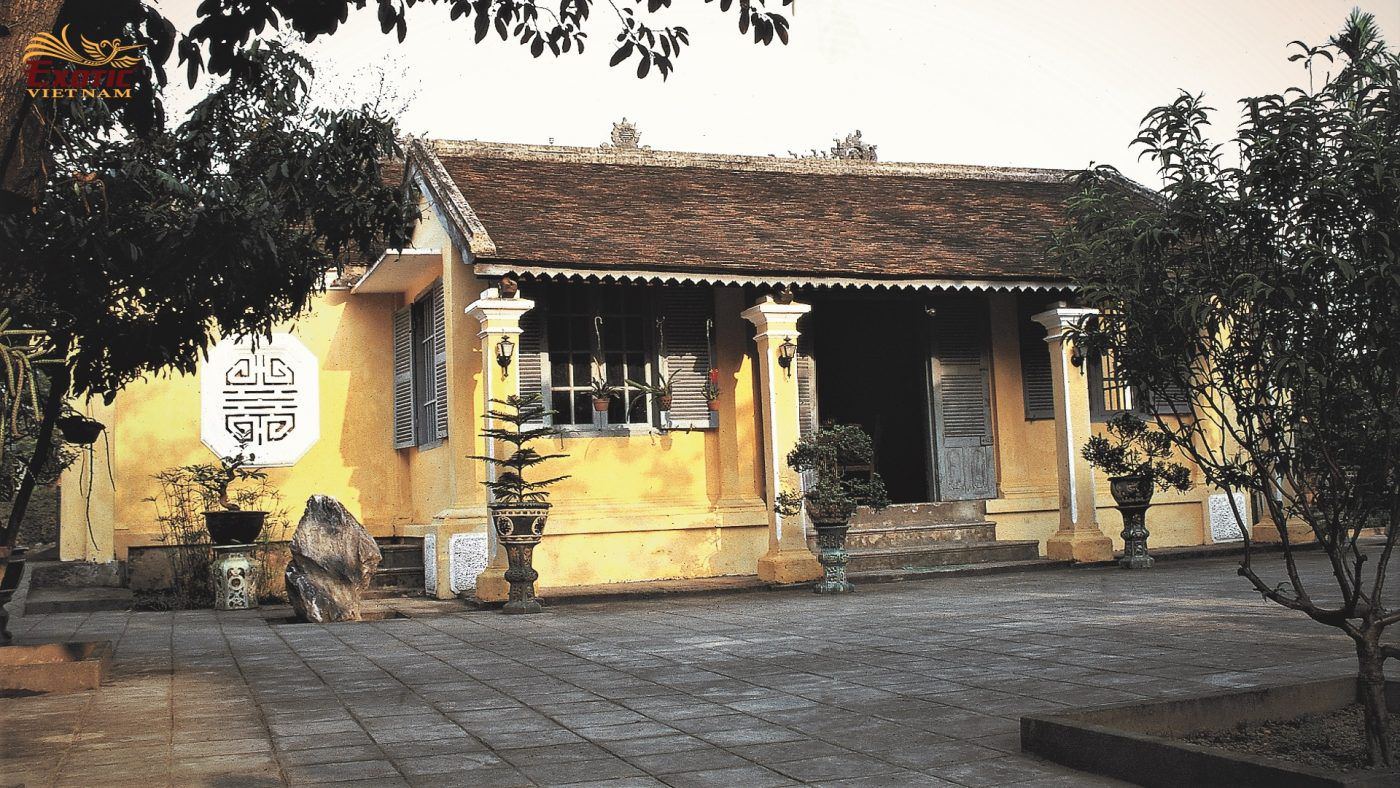
Surrounded by lush, well-trimmed gardens, Hue garden house is not only a blend of landscape and architecture, but also a unique legacy thanks to the inheritance of long-standing cultural values. Photo: Exotic Vietnam
Garden houses
Hue owes its beauty not only to the Perfume River, Mount Ngu Binh and royal mausoleums but also to garden houses. This kind of house is a prominent feature of Hue. Each garden house has an area of about 2,000m2. In front of the house, there is always a tile-covered gate. Around the house is a garden with all kinds of fruit and flowers. The highlight in a garden house is a small rock-garden which is an artificial wood and mountain made of rock, water and plants. The house and the garden, the people and the landscape, etc. all blend harmoniously in a colorful atmosphere. All shows the love of nature of the owners, which is one of Hue people’s characteristics. Visitors can visit some garden houses such as Lac Tinh Vien (65 Phan Dinh Phung St.), Princess Ngoc Son (29 Nguyen Chi Thanh St.), Y Thao (3 Thach Han), etc.
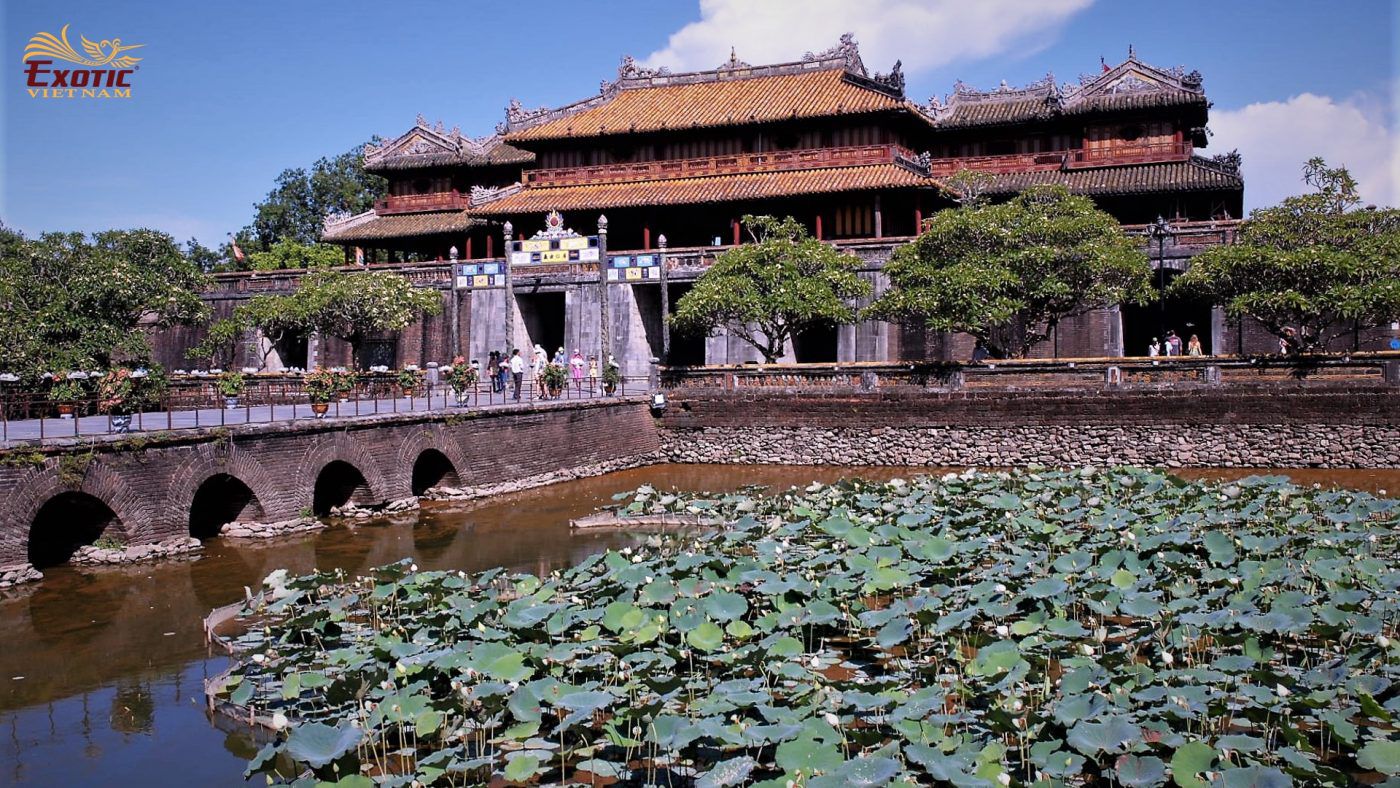
Combining the concepts of Chinese geomancy and the military principles of the French architect Vauban, the royal citadel of Hue is the perfect harmony of palaces and temples, ramparts and moats, among large courtyards full of trees. Photo: Exotic Vietnam
Royal citadel
The construction of the moated citadel, which has a 9,950m-long perimeter, was begun in 1805 on the northern bank of the Perfume River by King Gia Long. The citadel was originally made of earth, but between 1818 and 1832 it was paved with a 2m-thick layer of bricks in the style of the French architect Vauban. The king’s official functions were carried out in the Royal Enclosure, a citadel-within-a-citadel with a perimeter of 2,450m. The Royal Enclosure has 4 gates, the most famous of which is Ngo Mon Gate (or Southern Gate) used as the main entrance. Within the Royal Enclosure is the Forbidden Purple City, which used to be the living quarters of the king. With more than 100 buildings such palaces, temples, fortresses, etc., the Citadel is the most interesting place to visit in Hue.
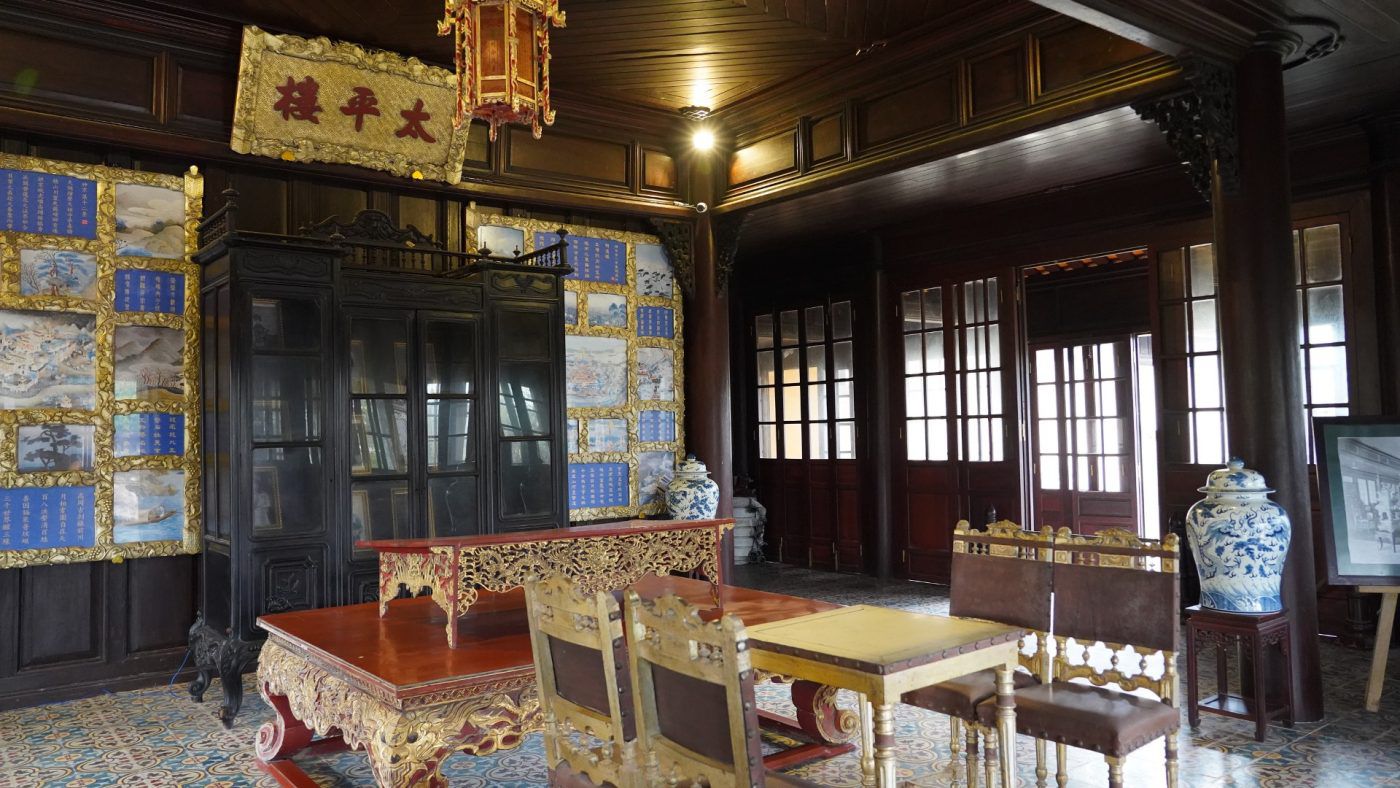
Located in Royal citadel, Museum of Royal Relics is a place preserving tens of thousands of invaluable artifacts, mostly related to the Nguyen Dynasty. Photo: Internet
Museum of Royal Relics
The beautiful hall that houses the Museum of Royal Relics was built in 1845 and restored when the museum was founded in 1923. This is a precious wooden construction of Hue’s unique palace architectonics. The house was built after “trung thiem diep oc” model (sloping successive roofs) with 128 pillars. The first sight catching visitors’ eyes is the walls inscribed with 1,000 poems written in chu nom – Vietnamese script. Most of the exhibits displayed here bear characteristics left by the last Vietnamese feudal dynasty. Here visitors can find the everyday utensils (such as clothing, sedans, gongs, etc.) of the King and the royal family and other aesthetics decorative works in the palaces of Hue.
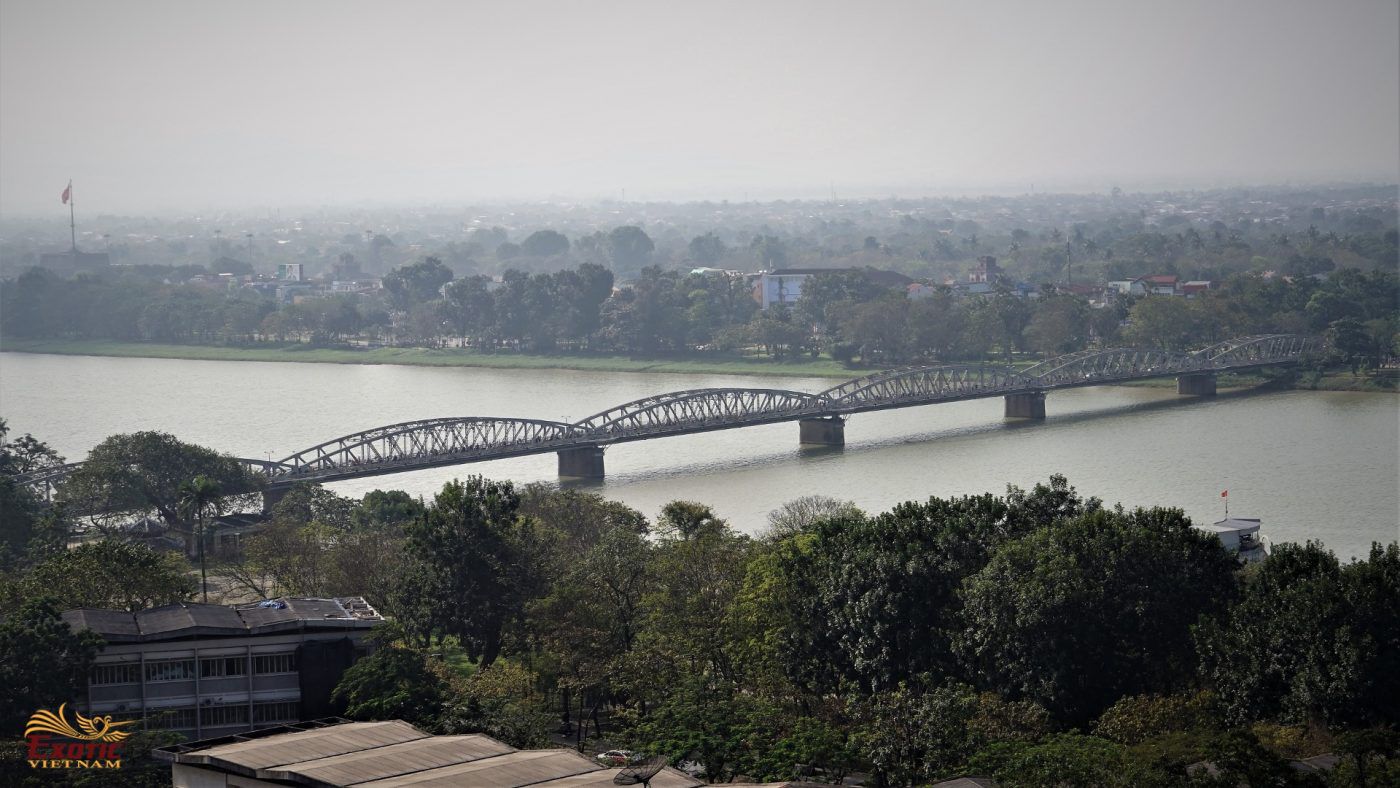
Considered a symbol of Hue, the Perfume River not only creates feng shui elements in the architecture of the Hue Citadel but also inspires many poets, musicians, and painters in their compositions. Photo: Exotic Vietnam
Perfume River
A visit to Hue would be not complete without a boat excursion on the Perfume River (Song Huong). This 100km-long river owes its name to the fact that it flows through many forests of aromatic plants before reaching Hue, bringing with it fragrances of tropical flora. A boat cruise will offer visitors a general view of the daily life of Hue people. When night falls, the surface of the river glistens under the moonlight and the folk melodies of Hue make the lovely river even more poetic and musical. It is said that Hue is peaceful and tranquil mostly thanks to the Perfume River.
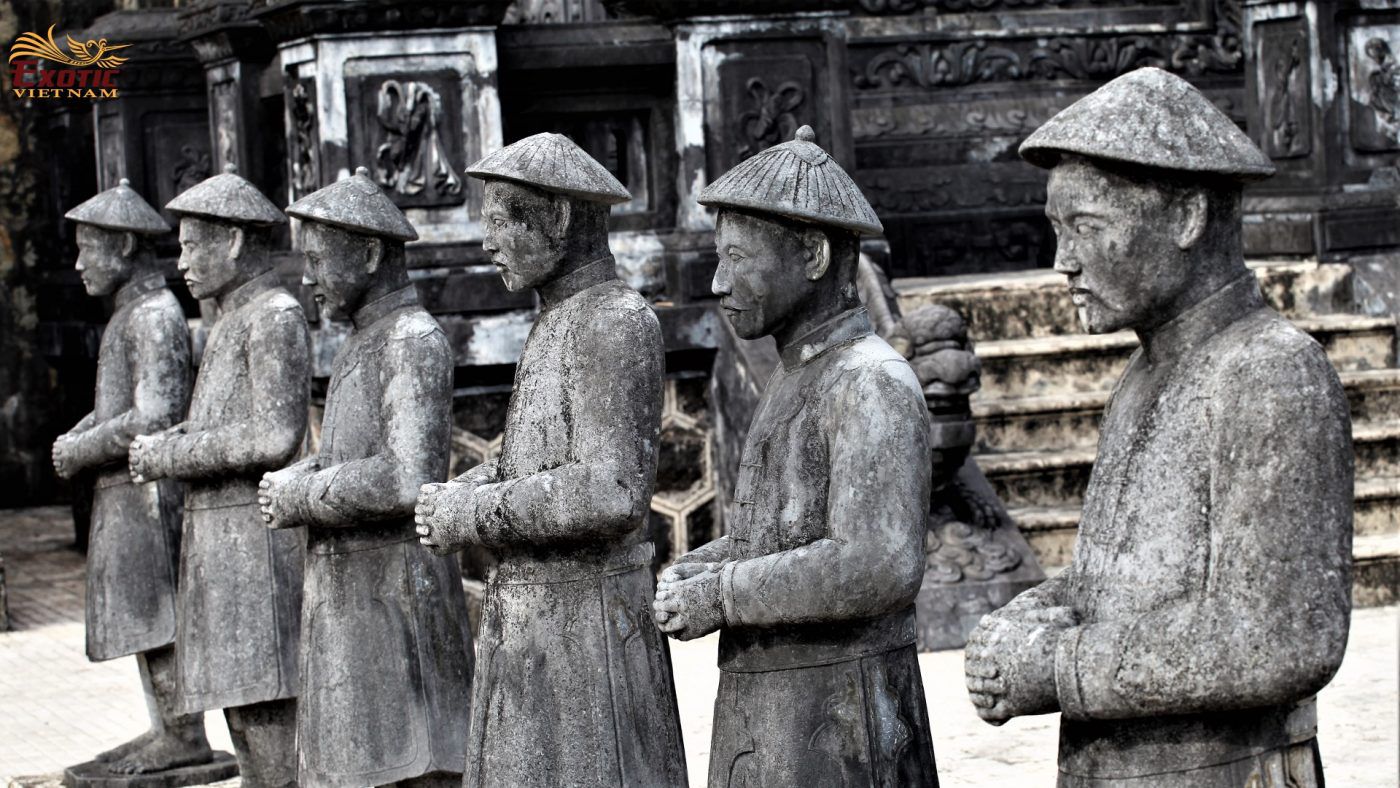
Reflecting the personality and philosophy of each king, the royal tomb in Hue was built with much effort to make the landscape architecture as impressive and majestic as possible. Photo: Exotic Vietnam
Royal tombs
There are eight royal tombs in Hue that are the final resting places of the Nguyen kings. Among them, Tu Duc’s Tomb, Khai Dinh’s Tomb, Thieu tri’s Tomb, Minh Mang’s Tomb, Gia Long’s Tomb are often visited. The construction of each tomb was very meticulous and usually started while the reigning king was still alive. Most of the tombs face the south-west, the direction of the Royal City. Although all are unique in structure and design, most of the tombs consist of two compounds. The first is reserved for funeral services and the second is the tomb proper. Generally, each tomb is enclosed by a surrounding rampart. However, the internal configuration of each tomb is different, since these particular arrangements reflected the tastes and personality of the monarch.
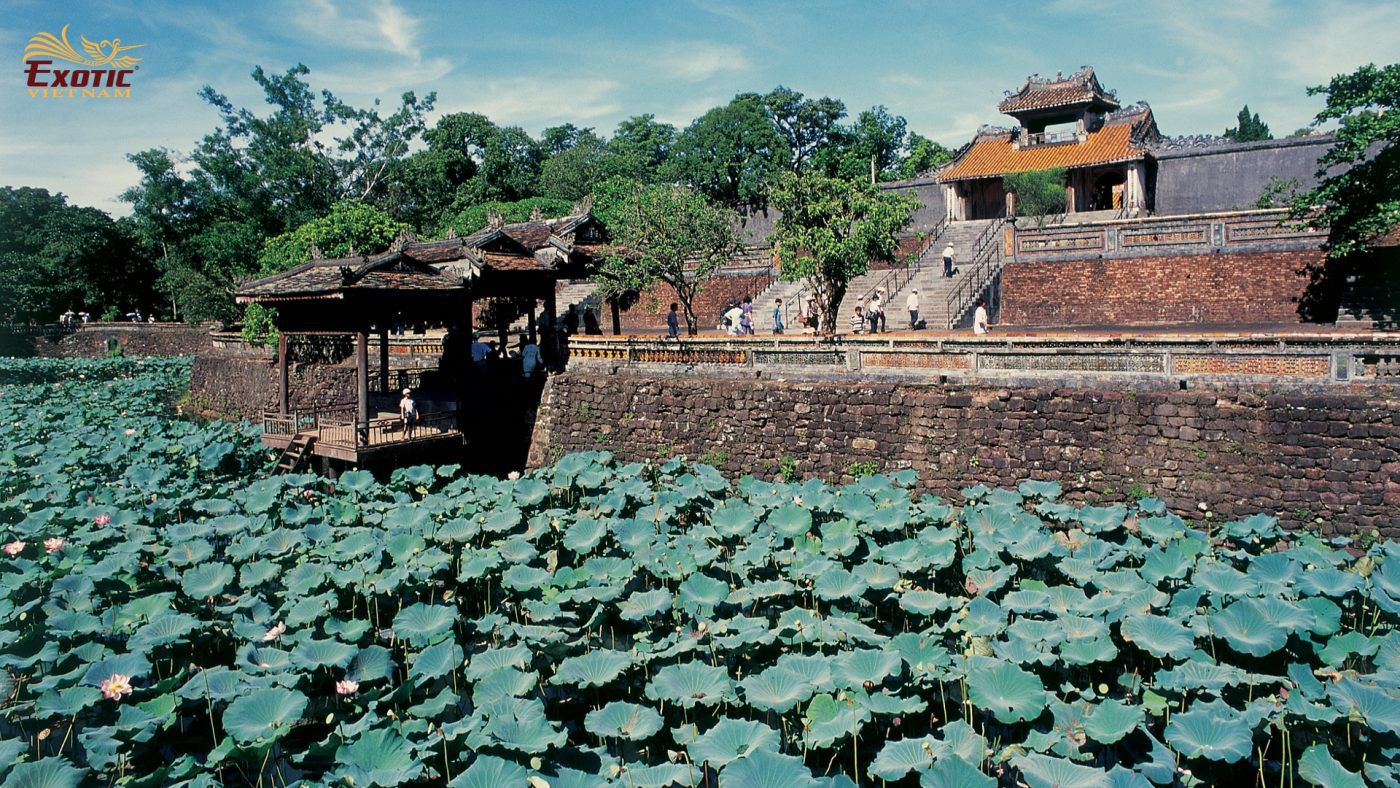
King Tu Duc’s Tomb – Lyricism. Photo: Exotic Vietnam
King Tu Duc’s Tomb
7km far from Hue city, King Tu Duc’s Tomb (Khiêm Lăng) is surrounded by a brick wall. Tu Duc was the fourth king of Nguyen Dynasty. He had his tomb constructed in 1848 when he was still on the throne. The tomb was built according to the plan based on two axes: one for the mausoleum and another for the palace. The tomb comprises of an important number of buildings, man-made ponds full of nenuphars and lotuses, crossed by various bridges and covered by frangipanniers. This is one of the most romantic and splendid masterpieces.
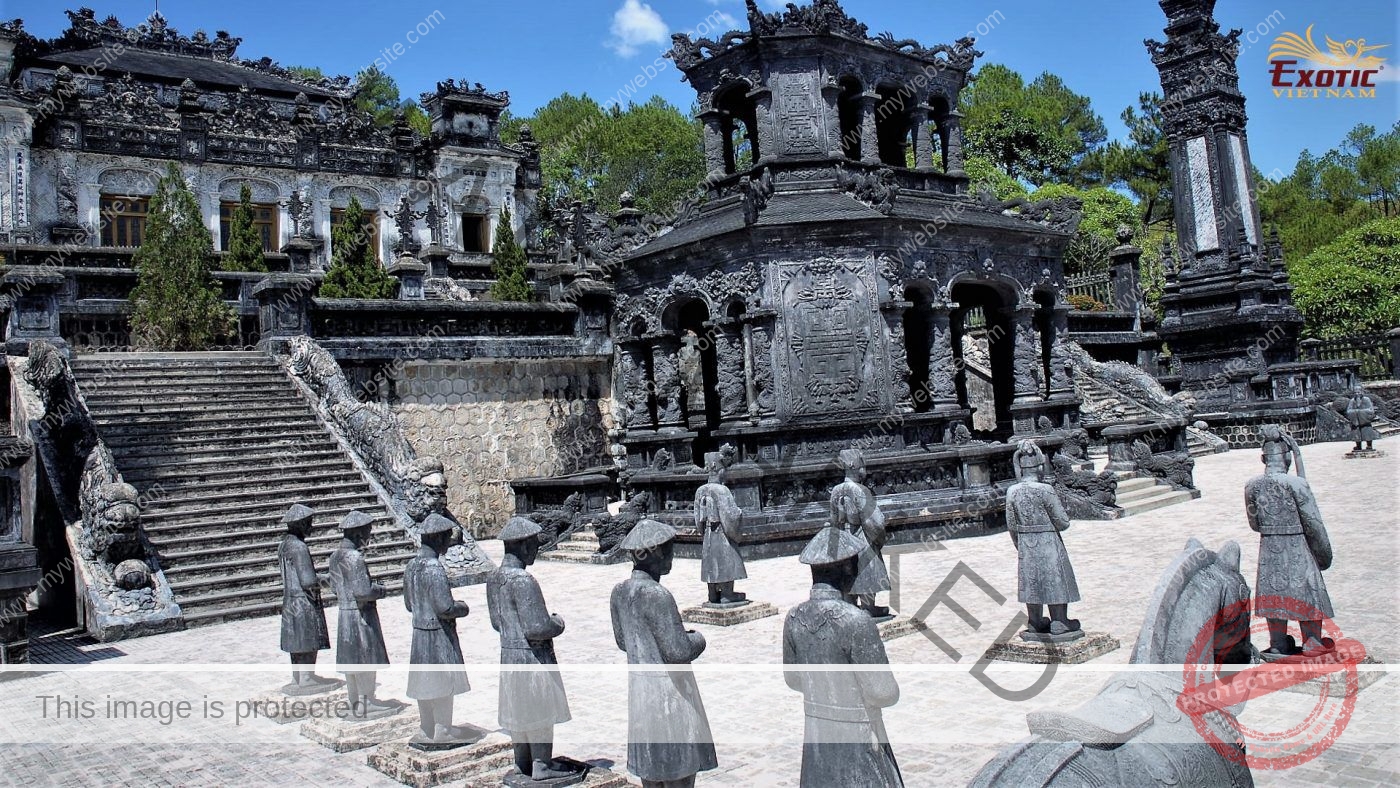
King Khai Dinh’s Tomb – Sophistication. Photo: Exotic Vietnam
King Khai Dinh’s Tomb
10km far from Hue city, Khai Dinh is the twelfth king of Nguyen Dynasty and he is also the father of King Bao Dai, the last king of Viet Nam. The construction of the tomb (Ưng Lăng) started from 1920 to 1931. The conception of its architecture and decoration got the European influence. The multi-colored ceramic inlaid style makes his mausoleum gracious and magnificent.
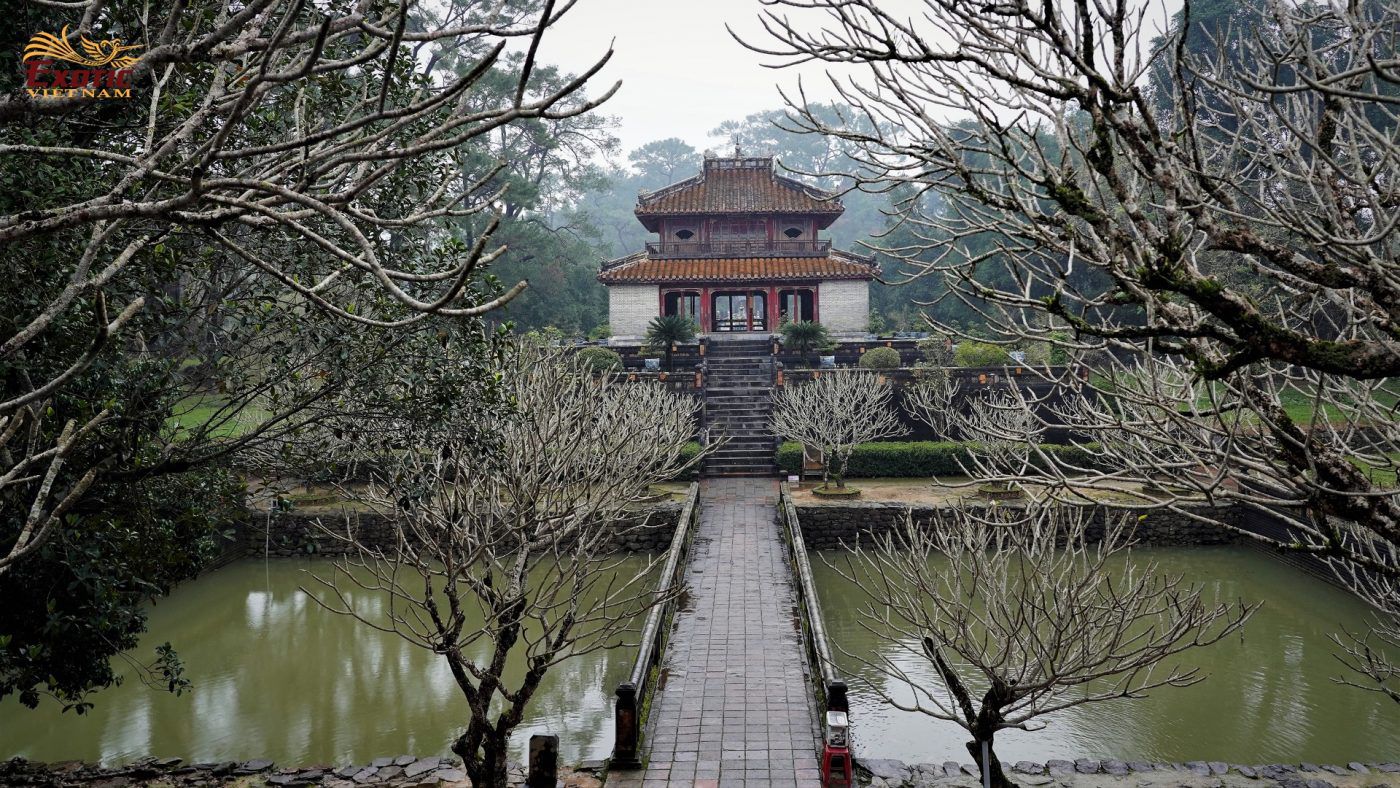
King Ming Mang’s Tomb – Solemnity. Photo: Exotic Vietnam
King Minh Mang’s Tomb
12km far from Hue city, King Ming Mang’s Tomb (Hiếu Lăng) is located on the left branch of the Perfume river. The tomb was built as the plan drawn out by the king himself and the middle of the pine forest. The construction started in 1841 after the king’s death. The palace, the pavilions and the entrances are harmoniously built around two big lakes that make these more luxurious and peaceful.
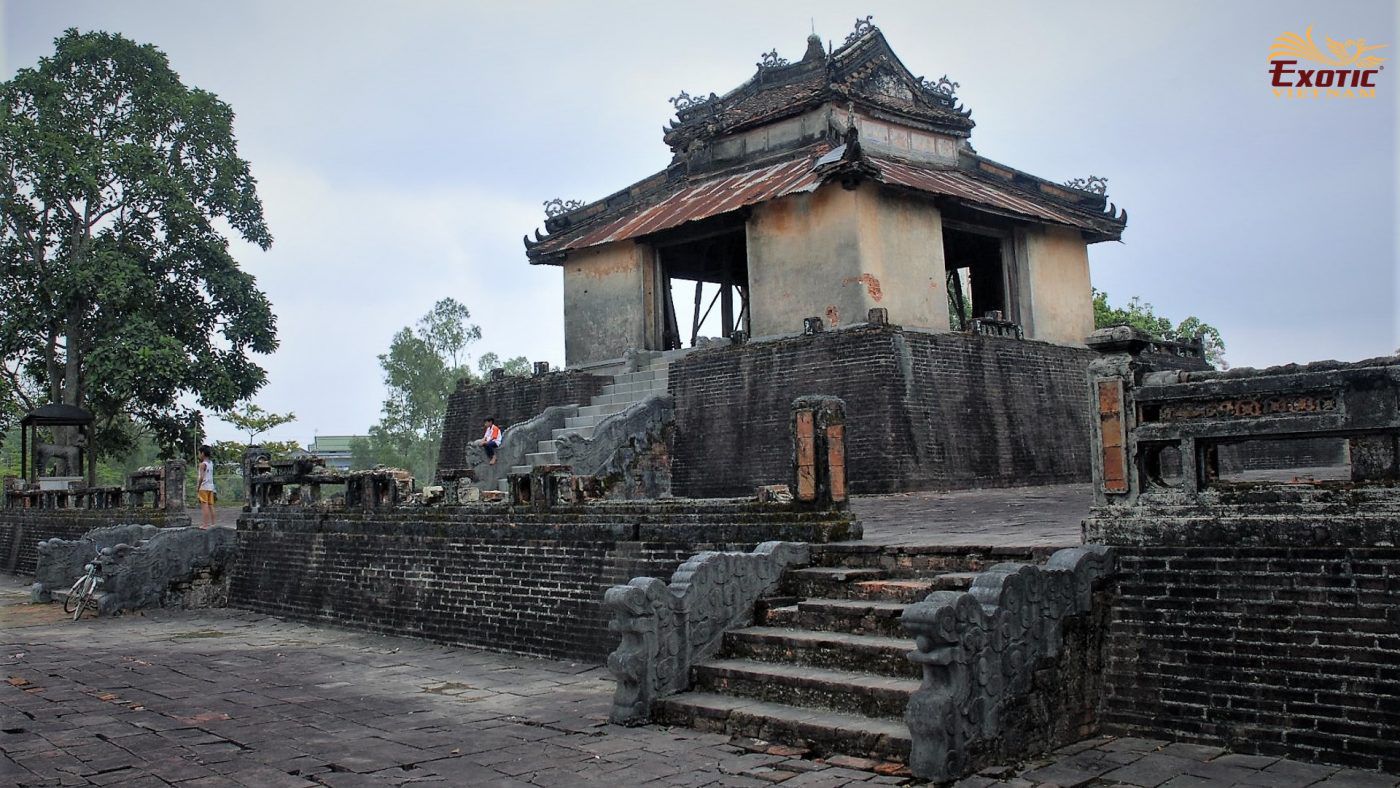
King Thieu Tri’s Tomb – Freedom. Photo: Exotic Vietnam
King Thieu Tri’s Tomb
8km far from Hue city, King Thieu Tri’s Tomb (Xương Lăng) was built in early 1848 and completed in only 10 months to promptly bury the king’s body. Surrounded by rice fields and gardens as a natural guard line that makes the peaceful and tranquil atmosphere of the architecture. Its structure is the combination of the two previous tombs’ architectures (Gia Long’s & Minh Mang’s tombs) with two axes including tomb axis on the right and worshiping axis on the left standing 100 meter away from each other.

King Gia Long’s Tomb – Strength and serenity. Photo: Exotic Vietnam
King Gia Long’s Tomb
16km far from Hue city, King Gia Long’s Tomb (Thiên Thọ Lăng) is a complex of several royal tombs including the tomb of his mother, the tomb of himself and his wives, and tombs of other royal family’s members, mainly built in 6 year, from 1814 to 1820. This tomb is the resting place of the first king of the Nguyen Dynasty. Among the Nguyen emperors’ tombs, this is the largest tomb area with about 28 km2, which is rated as “a magnificent picture of the coordination between nature and architecture”.
TEAM BUILDING IN DA NANG – HOI AN
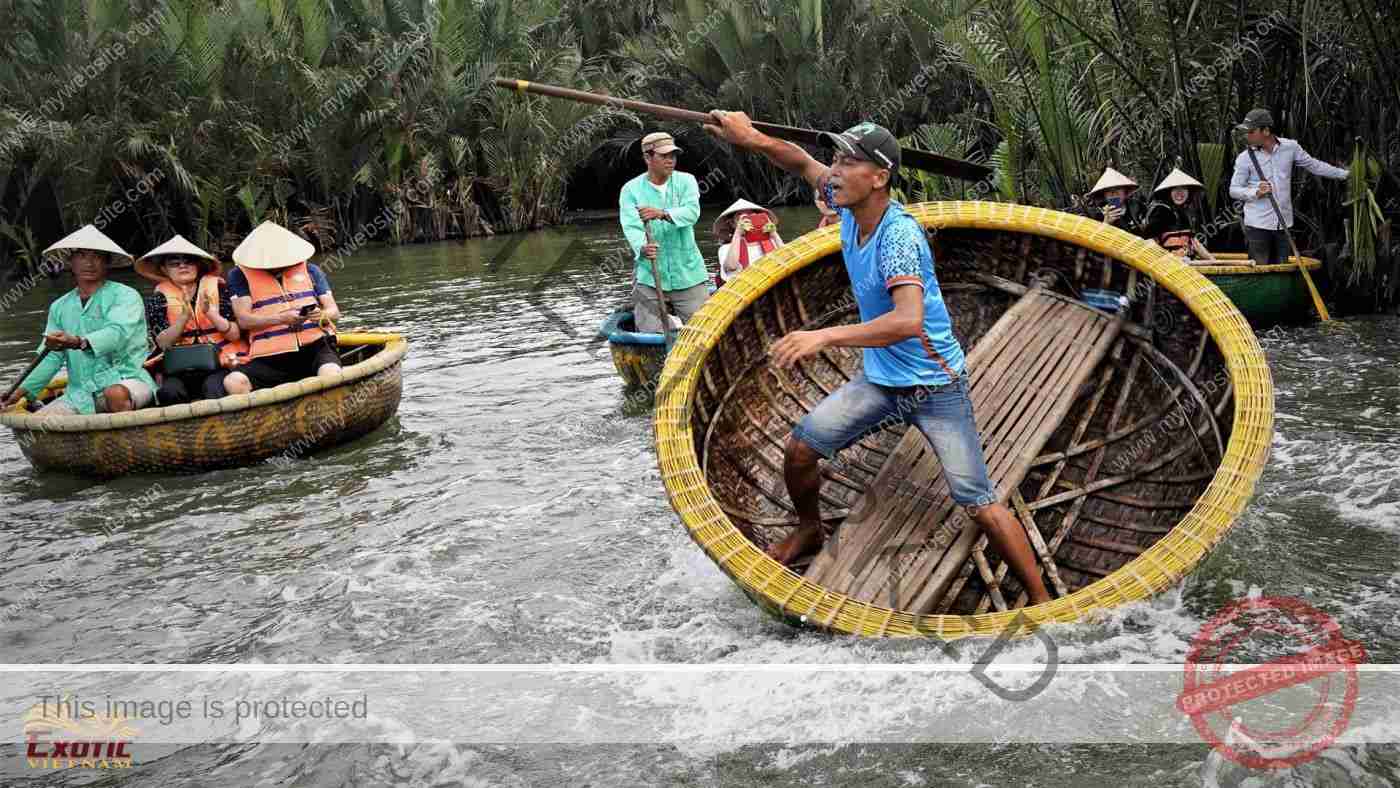
This land has been changing drastically to become a modern metropolis. But the cultural and historical values from the relics of Cham Pa, the ancient town of Hoi An to the traditional way of life inherited through many generations are still preserved. Photo: Exotic Vietnam
Location: 970km from HCM City (1 hour and 10 minutes by plane, or 17 hours by train), 750km from Ha Noi (55 minutes by plane, or 16 hours by train), 107km from Hue (3 hours by car), 300km from Quy Nhon (6 hours by car).
Introduction: The busy seaport of Da Nang in central Viet Nam is the country’s fourth-largest city. The French named the city Tourane after it succeeded Hoi An (Faifo) as a vital deep water trading port in the 19th century. The port was an important military base for the French and later the Americans and has some remarkable colonial-style architecture, a bustling market, lovely pagodas and idyllic white sandy beaches. More recently, Da Nang boasts as “the city of bridges” where there are 10 spectacular bridges spanning the Han River. Now served by a growing number of international flights, Da Nang is also the gateway to Central Viet Nam’s rich legacy of UNESCO World heritage sites such as nearby Hoi An and My Son and Hue and Phong Nha–Ke Bang to the north.
Highlights: Hoi An Ancient town, My Son Holy See, Cham Sculpture Museum, Marble Mountains, My Lai Massacre, Ba Na Hills, Non Nuoc Carving Hamlet, Cham Islands.
Facilities & services: international standard hotels and restaurants, resorts, hopon-hopoff city-tour bus and water sports: jet skiing, parasailing, surfing etc.
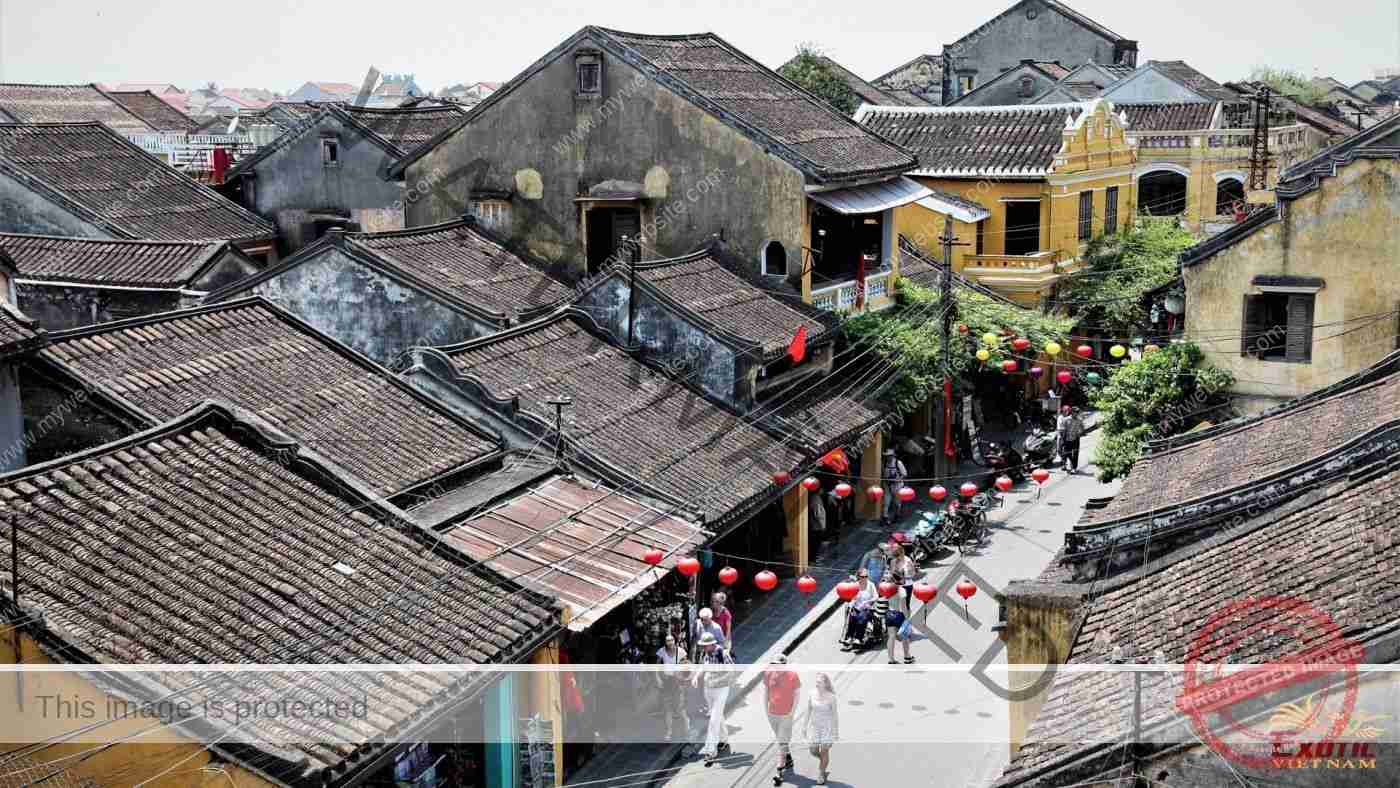
On the banks of Thu Bon River, Hoi An Ancient Town is a living museum of a South-East Asian trading port dating from the 15th to the 19th century. Photo: Exotic Vietnam
Hoi An Ancient Town
30km southwest of Da Nang, the tranquil town of Hoi An rests on the shores of the Thu Bon River. Known as Faifo to early Western traders, Hoi An was a vital commercial seaport in South East Asia from the 17th to the 19th centuries attracting merchants from China, Japan, Portugal and France. The long houses built by the merchants reflect the architectural styles of their homeland and remain in near perfect condition today. Visitors can take an early morning walk through the market and marvel at the quaint narrow streets and centuries-old communal houses and pagodas. Moreover, monthly festival on full-moon night is worth a visit. Recognized as a UNESCO World Heritage site in 1999.

Among the mountains encircled by jungle, My Son Holy See is a sacred valley where abandoned Hindu architectures were found. This place is known as one of the major religious centers of the Cham Pa kings many centuries ago. Photo: Exotic Vietnam
My Son Holy See
Located 40km southwest of Da Nang and 25km west of Hoi An, My Son is a large complex of monuments from the ancient Champa Kingdom which once stretched down Viet Nam’s entire central coast. From the 4th to 14th centuries, My Son was used for Cham religious and burial sites for its rulers. Located in a picturesque valley with a soaring sacred mountain behind, My Son’s remaining towers and temples provide an excellent insight into Cham Civilization. Although damaged by years of war, My Son was recognized as a World Heritage site in 1999.
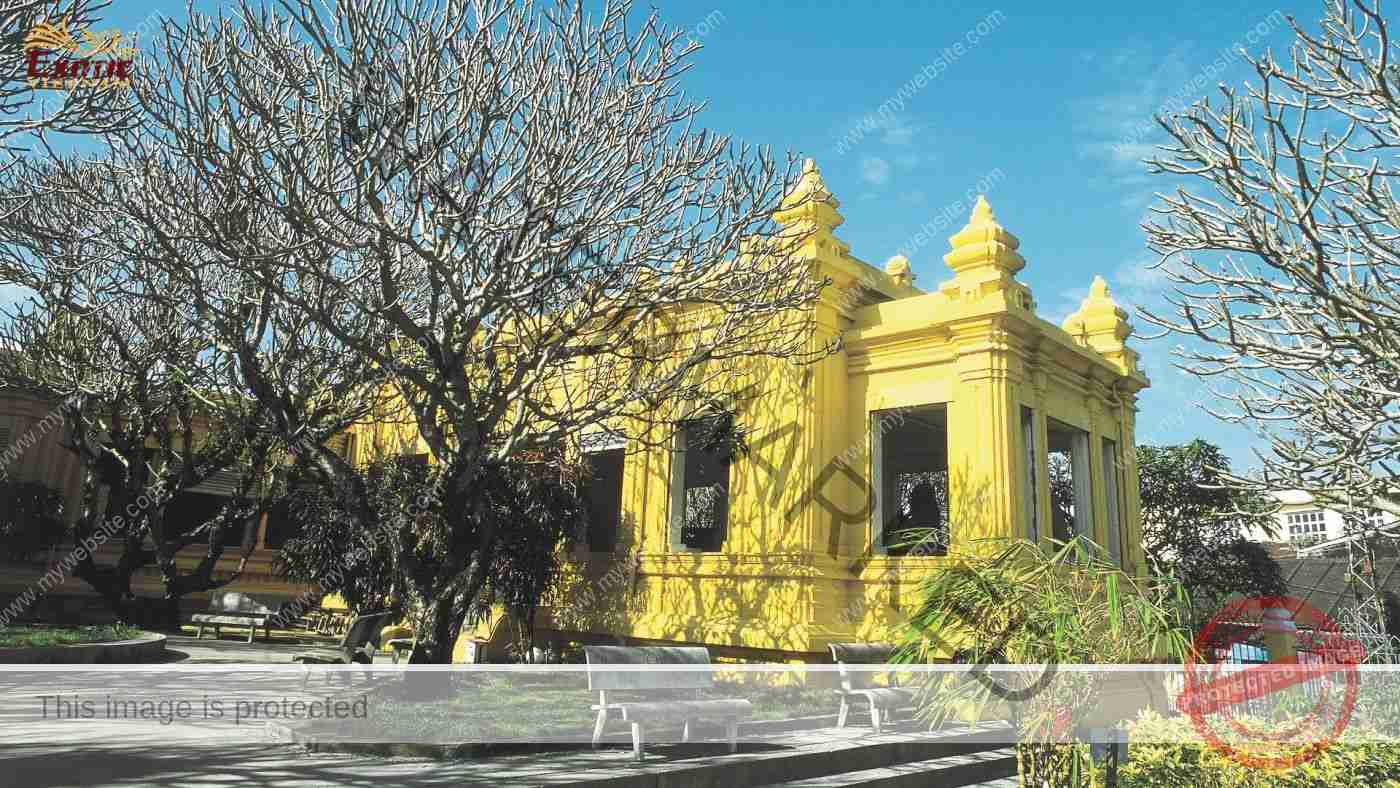
Home to the world’s largest exhibition of Cham sculptures, the Museum of Cham Sculpture displays nearly 300 terracotta and sandstone artifacts from the 7th to the 15th centuries. Photo: Exotic Vietnam
Cham Sculpture Museum
The museum was established by French academics in 1916 and contains the largest display of Cham art anywhere in the world with more than 300 artefacts ranging from the 4th to the 14th century. With a beautiful setting, the complex is open land in design, providing an environment in which the artefacts can be exhibited to their best advantage. There are numbers of rooms including My Son, Tra Kieu, Dong Duong and Thap Man, each dedicated to a different period of Cham art dating from the 7th to the 15th century.
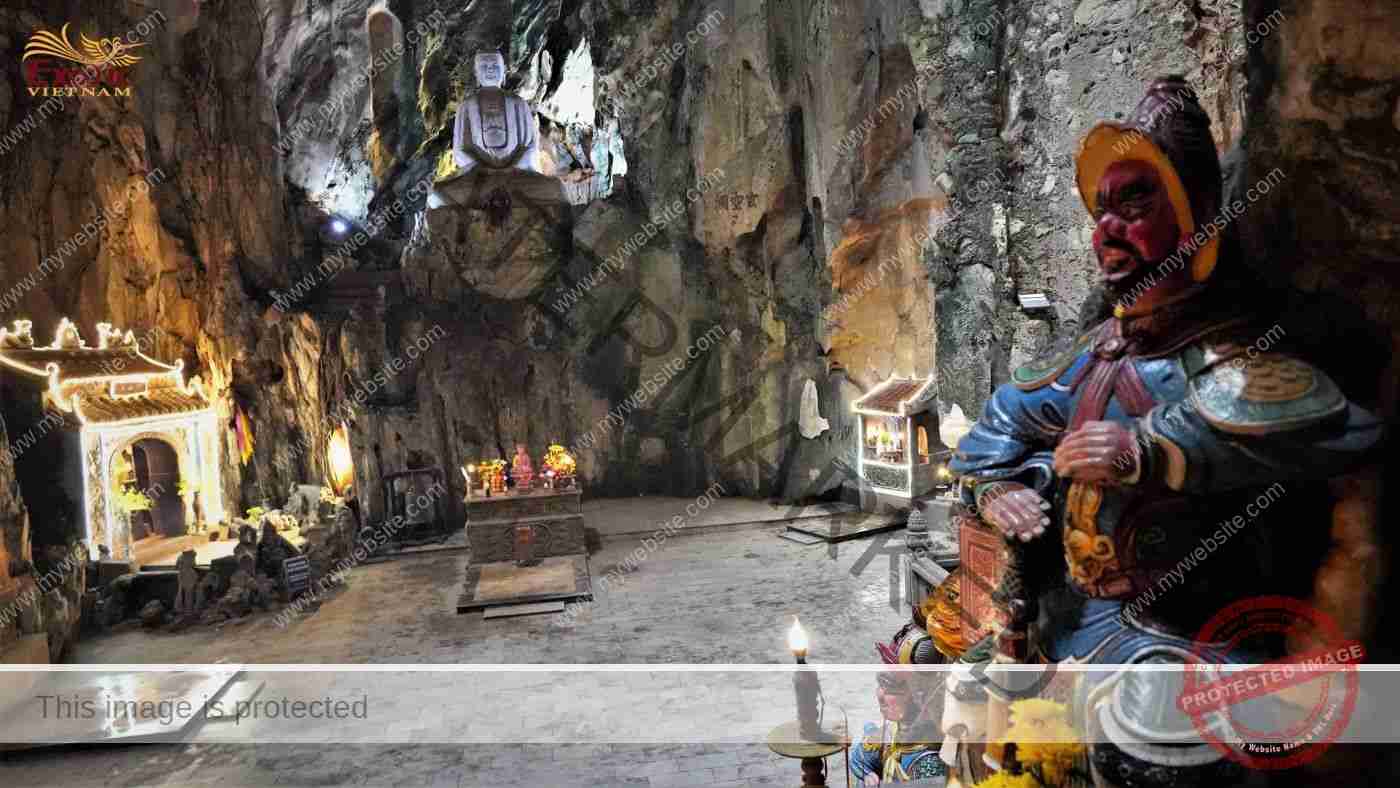
Marble Mountains are a cluster of five marble hills named after the elements metal, wood, water, fire, and earth. Photo: Exotic Vietnam
Marble Mountains
They consist of marble hillocks by the sea. Each is said to represent one of the five elements of the Universe and named accordingly: Thuy Son (Water), Moc Son (Wood), Hoa Son (Fire), Kim Son (Metal) and Tho Son (Earth). The largest and most famous Mount Thuy Son has a number of natural caves in which Buddhist sanctuaries have been built over the centuries. Also an important religious spot for Cham, the peaks became havens for communist guerrillas during the war owing to their commanding view of Da Nang airbase. Mount Thuy Son is a popular pilgrimage site, especially on days of the full and sliver moon and during the Lunar New Year. It is located about 8km southeast Da Nang.
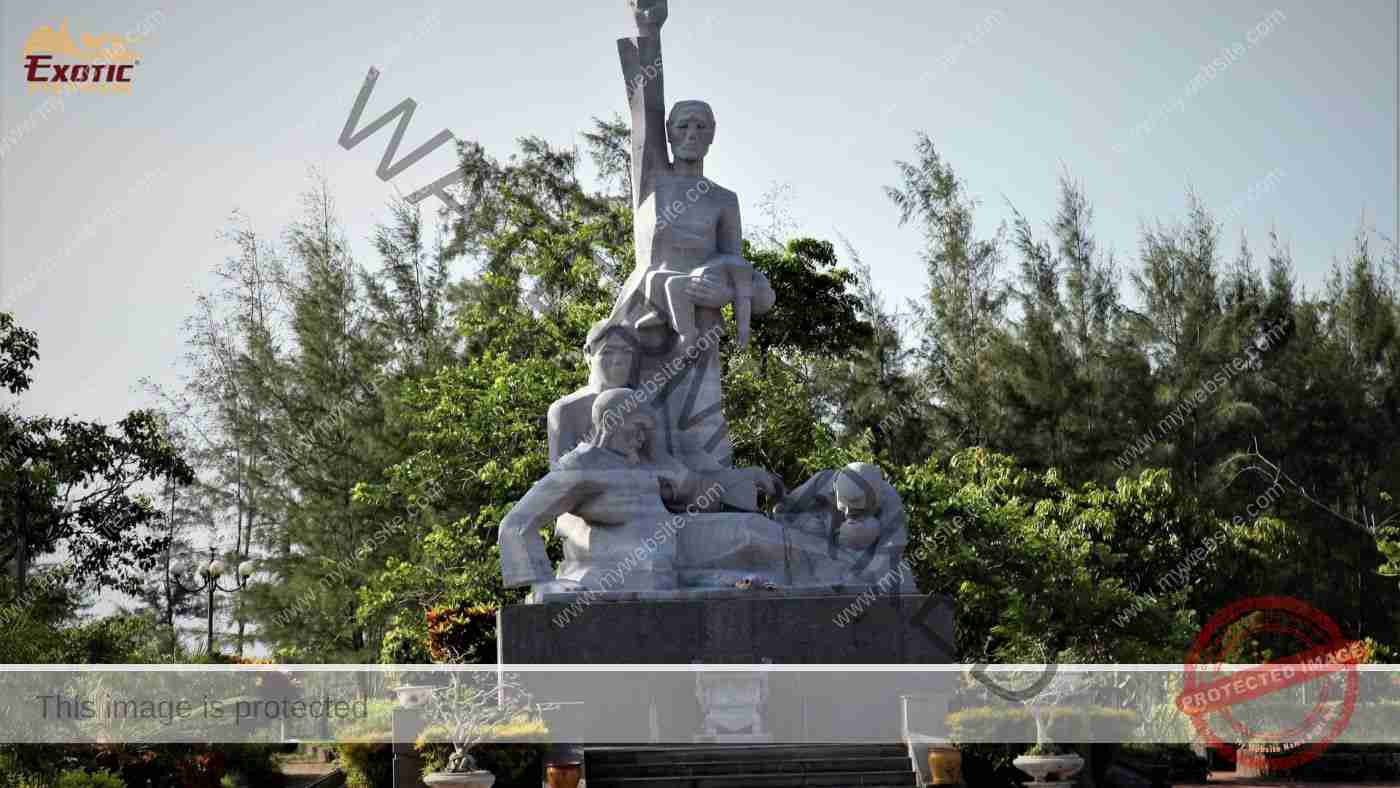
The My Lai massacre was one of the most horrific incidents of violence committed against unarmed civilians during the Viet Nam War. Photo: Exotic Vietnam
My Lai Massacre
About 150km outh of Da Nang, the villages of central Viet Nam known collectively as My Lai have been stamped by history as places of horrific acts of war. More than 500 people, many of them women and children, were slaughtered here by American G.I.s on March 16, 1968. They were ordered out of their homes, lined up in ditches and shot. Now it is a peaceful countryside where visitors can take a visit to the museum of the Son My massacre and a stroll around Co Luy Hamlet. They will enjoy the pretty scenery of villages, paddy fields and coconut gardens and have a chat with friendly villagers, some of whom are survival witnesses.
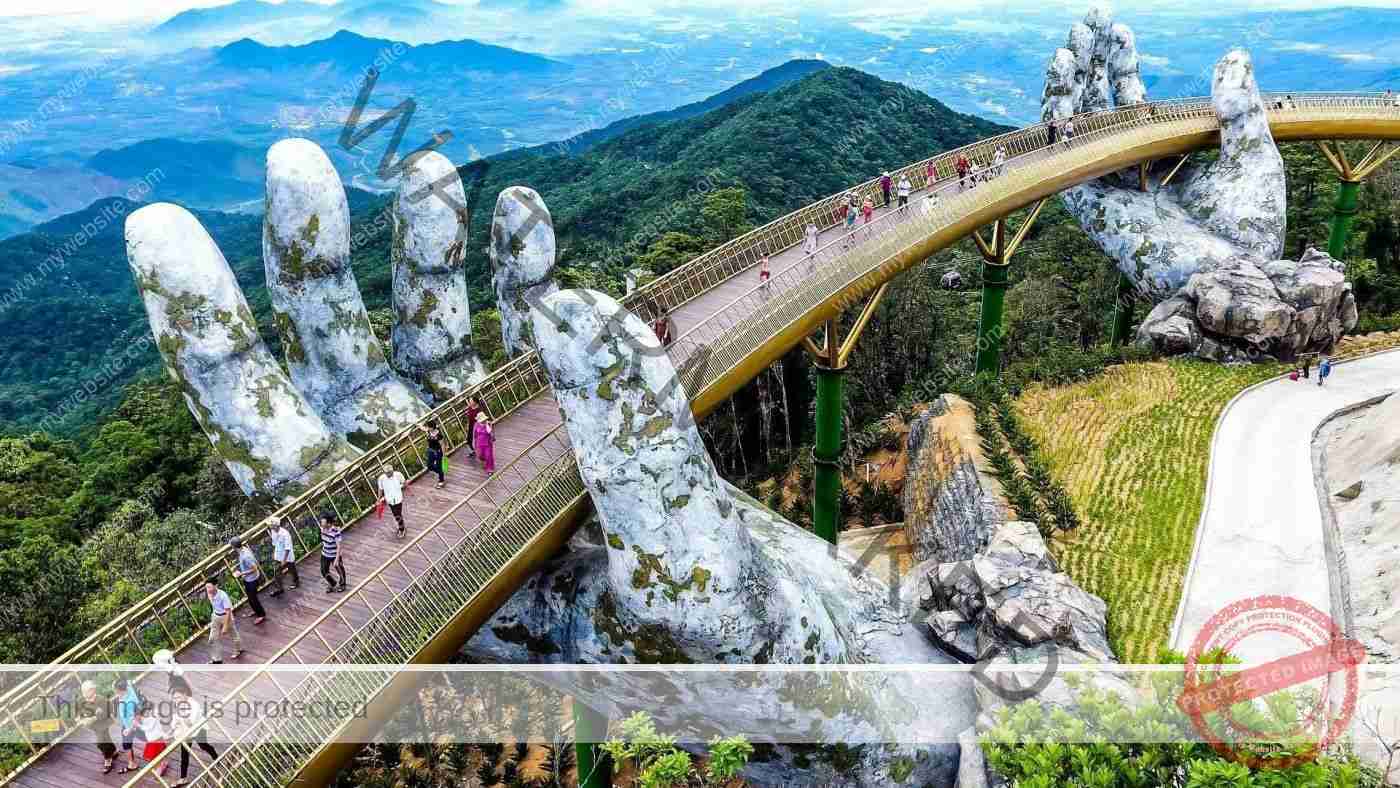
Mount Ba Na has become a modern tourist area with many records on forest land belonging to the former Ba Na – Nui Chua Nature Reserve. Photo: Internet
Mount Ba Na
40km west of Da Nang, known as as a summer retreat by the French at an altitude of 1,489m on the Ba Na – Nui Chua mountain, built in 1920 in the perfect combination of waterfalls, forest and colonial-style villas. In 1986, Ba Na was recognized as a natural reserve, in which tropical forest and rare animals are protected, including many species listed in the Red Book of Viet Nam.
In 2007, the huge tourist project of Ba Na Hills with cable cars, entertainment complex, stylish restaurants and world class accommodations, was launched. It completely has transformed the wildness of the nature reserve into a man-made city of Guinness World Records. Considered as a “heaven on earth”, this mass tourism site serves for those who look for festivities, recreations and relaxation and cuisine in the clouds. Here are the top things to do check-in in Ba Na: the French Village, the Golden Bridge, the Jurassic Park and the Wax Museum.

Over 300 years, Non Nuoc Carving Hamlet is famous for its sophisticated marble sculptures. Photo: Exotic Vietnam
Non Nuoc Carving Hamlet
On the southern side of Thuy Son, the hamlet is a few meters west of beautiful Non Nuoc Beach. The marble carvings made here by skilled artisans would make great gifts for tourists to send home; even it is entertaining to watch the carvers at work. A wide variety of articles are sculptured in marble, including Buddhist and saint statues, sacred animals, Cham-style statues, etc.
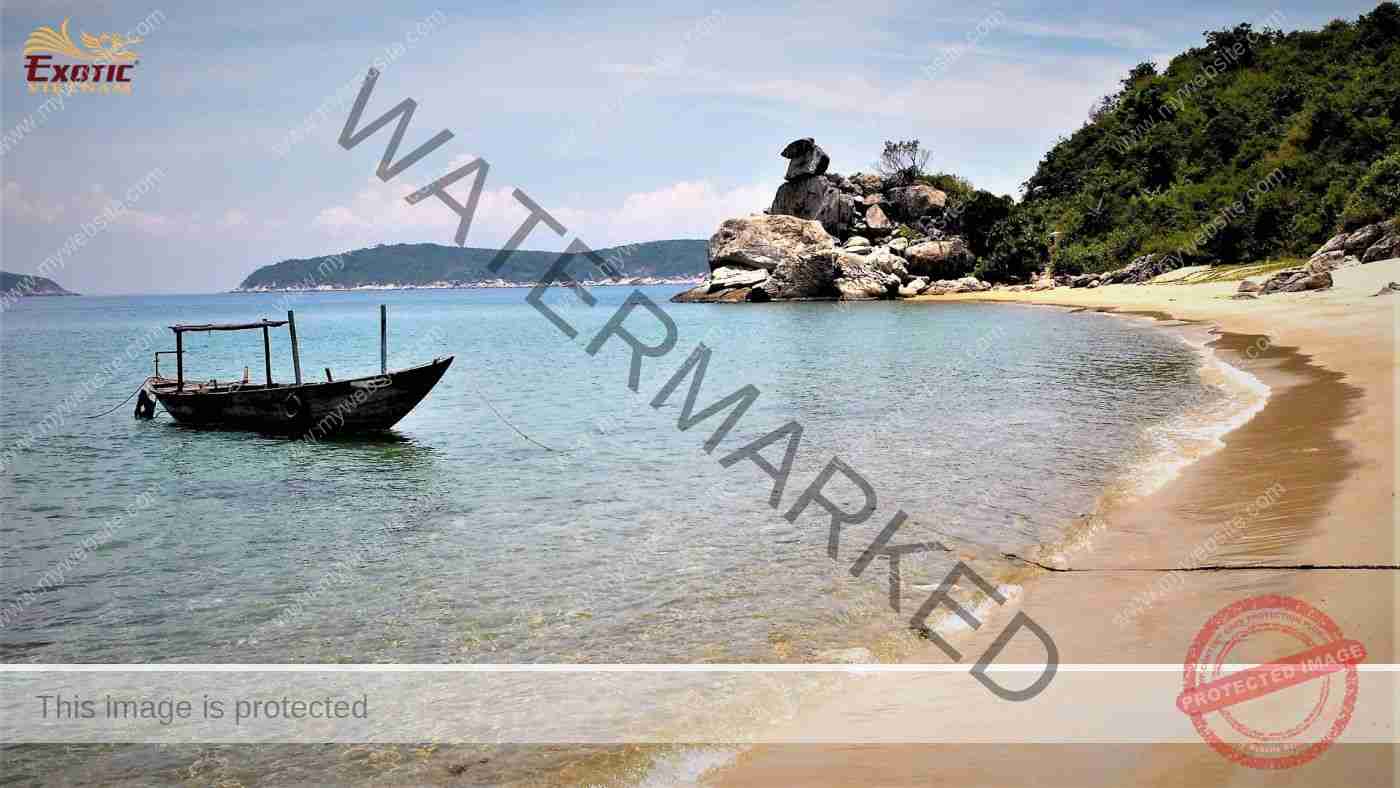
Cham Islands are renowned for its forested mountains, sea creatures, fishing villages, white sand beaches, turquoise waters and historical relics. Photo: Exotic Vietnam
Cham Islands
Around 20km off the coast of Cua Dai, Hoi An (20 minutes by speedboat), the Cham Islands were recognized by the UNESCO as a world biosphere reserve in 2009. The islands are home to 950 aquatic species, including rare fish and corals. There are a total of 8 islands in the Cham Islands called Hon Lao (largest and only inhabited, an area of 1,317ha with a hilltop elevation of 517m), Hon Cu, Hon Kho, Hon La, Hon Dai, Hon Lo and Hon Tai. The islands offer pristine white-sand beaches, granite cliffs, and coral reefs, ideal for camping, swimming, sea trekking, snorkelling and diving. The best time to visit Cham Islands is from March to August which is the dry season with sunny sky & mild wave.
TEAM BUILDING IN QUY NHON
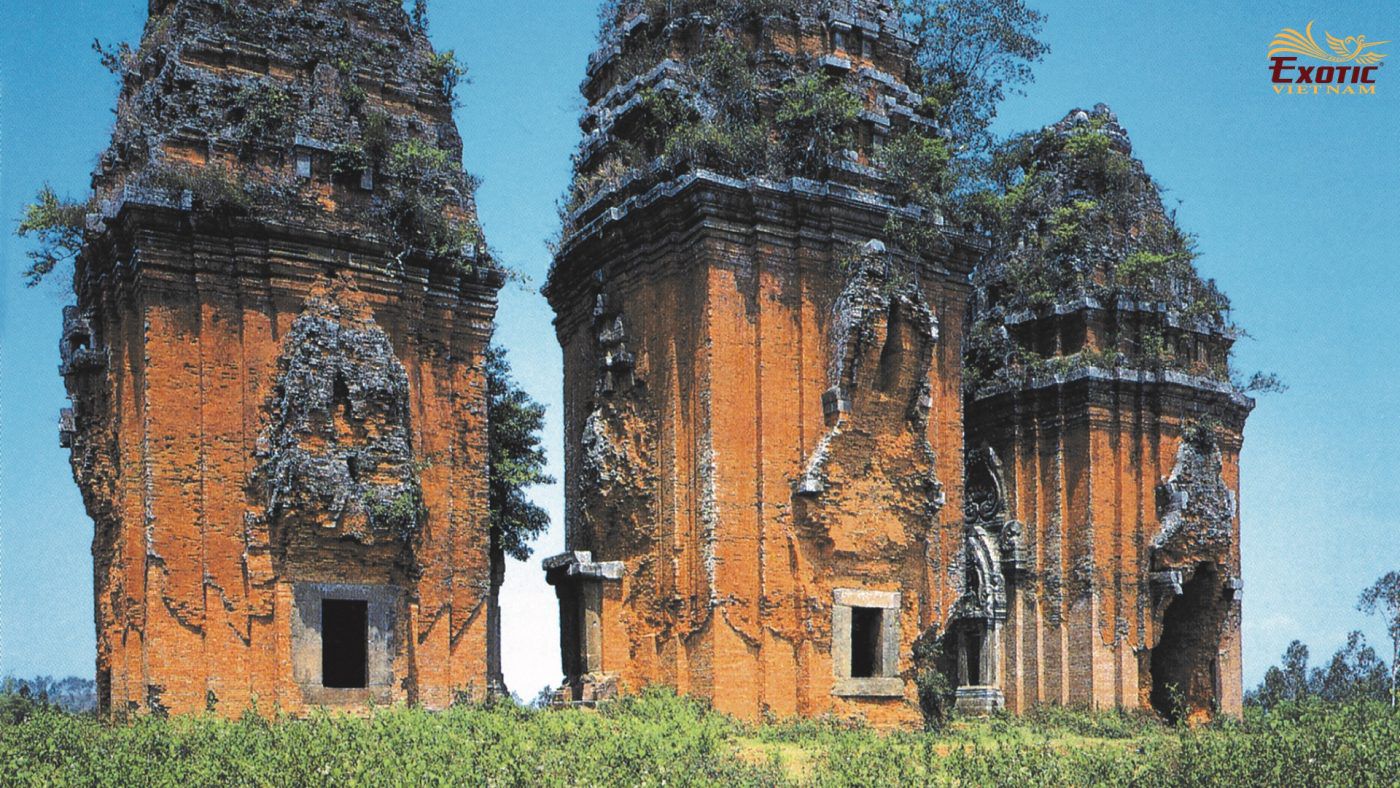
Surrounded by stunning beaches, breathtaking cliffs and rustic countrysides, Quy Nhon is considered a little-known land. From historical sites, natural attractions to fresh seafood, all bring visitors unexpected pleasures. Photo: Exotic Vietnam
Location: 690km north of HCM City (1 hour by plane or 12 hours by train), 170km from Pleiku (3 hours by car), 240km from Nha Trang (4½ hours by car), 300km from Da Nang (6 hours by car).
Introduction: Quy Nhon is the capital of Binh Dinh Province which lies right in the middle of Central Viet Nam. Visitors will have a chance to witness the local traditional martial spirit and the famous Sa Huynh civilization dating back to the first millennium BC. Moreover, they will explore remnants of fascinating Cham culture and then revisit to the splendid Cham Kingdom which developed in the region of Vijaya during the period from the late 10th century to the late 15th century. The survival of temples and towers marked its golden history. The variety of sculptures carved from sandstone to decorate the towers of Duong Long, Banh It, Canh Tien, etc. together with the varied motifs carved into brick walls give Cham monuments subtle beauty.
Highlights: Tay Son Museum, Ky Co Beach, Xanh Islet, Duong Long Tower, Doi Tower, Banh It Tower, Canh Tien Tower.
Facilities & services: martial art show, diving, world class hotels and restaurants.

Tay Son Museum displays over 11,000 artifacts related to the Tay Son uprising. Not only the exhibits, the demonstrations of martial arts performed with a bamboo stick is always attractive to viewers. Photo: Internet
Tay Son Museum
Tay Son Museum is dedicated to Nguyen Hue, a national hero of the 18th century. Nguyen Hue was one of the three Nguyen brothers, who led the Tay Son Instruction in 1788 to defeat the Qing invaders and became King Quang Trung in the same year. The museum was built in 1979 in Nguyen Hue homeland in Tay Son District, 45km from Quy Nhon City. Visiting the museum, tourists will enjoy Tay Son martial art demonstrations. Once a year, on the 5th of the lunar 1st month, Dong Da Festival is hold in this museum to memorize the Nguyen Hue’s glorious victory.
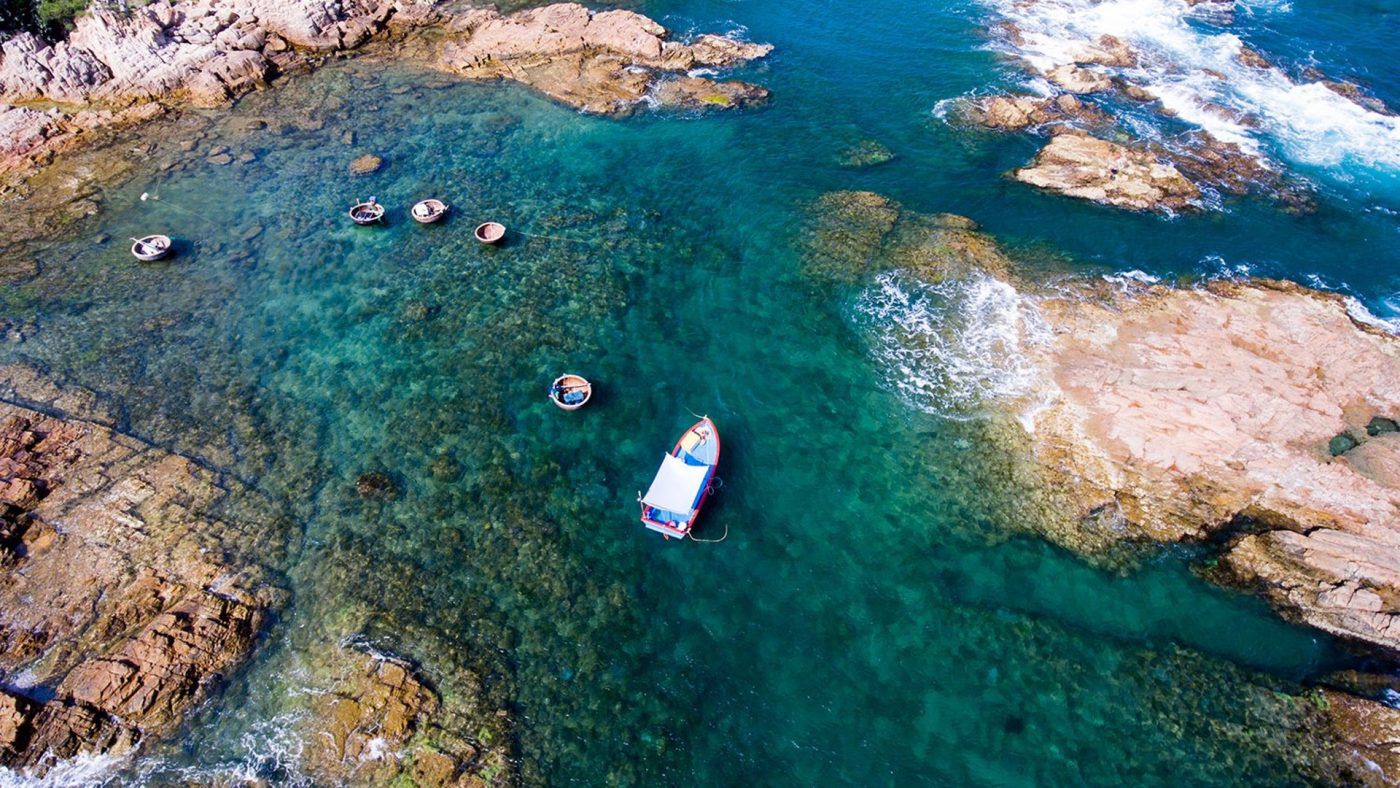
The delicate combination of smooth sands, rugged cliffs, hidden coves and emerald waters makes Ky Co Beach a rare gem. Photo: Internet
Ky Co Beach
Starting from Eo Gio, 25km northeast of Quy Nhon, visitor can take a 20-minute boat ride or enjoy a shuttle tram driving on zigzag winding mountain road (6km) with the spectacular panorama of village and ocean to get Ky Co Beach. Located on the eastern edge of Phuong Mai Peninsula, Ky Co is a crescent-shaped sandy beach stretching 500m long and 80 wide with 3 sides leaning against high cliffs. The large cracked granite blocks naturally make up amazing pools and gorgeous caves as the tide recedes. Crystal clear turquoise water, smooth white sand, magnificent rock formations of all shapes and sizes in harmony with the clear blue sky give Ky Co Beach vivid colors like a great natural picture. That is why people call it “the Maldives of Viet Nam”. There is nothing more wonderful than swimming, participating in water sports and enjoying fresh seafood with family, friends and colleagues while immersing in nature and relaxing your mind. From Ky Co Beach, visitor can rent a canoe to explore the coral at Bai Dua, Hon Kho or Hon Sao islets nearby. The best time to visit Ky Co is from April to September.
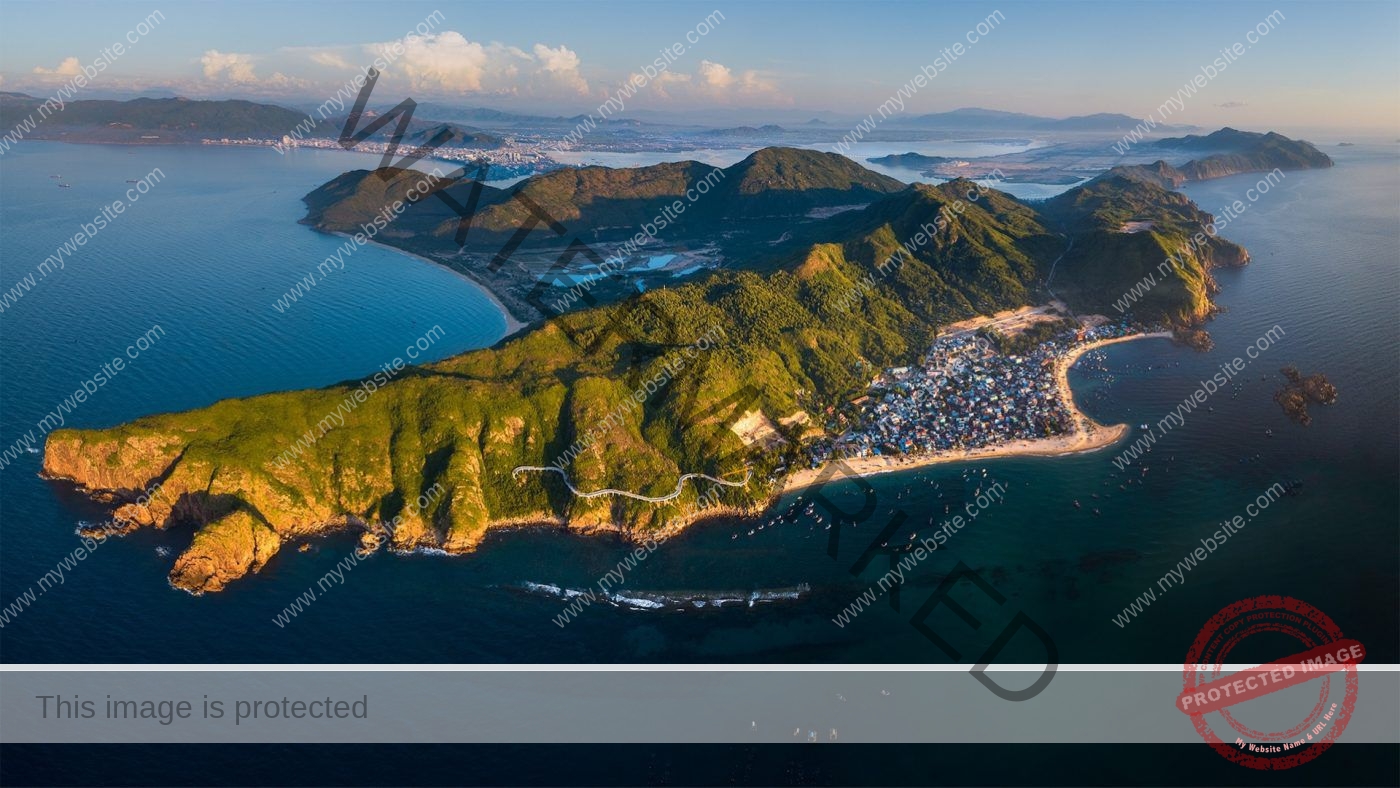
With its untouched beauty, Xanh Islet impresses visitors with “greens” of both sky, water and vegetation. It’s ideal for your dreamlike holiday here with much water activities. Photo: Internet
Xanh Islet
About 22km from Quy Nhon City and 6km from Song Cau Town, Xanh Islet (Cu lao Xanh) is also known as Van Phi Islet. Its administrative boundary belongs to Nhon Chau commune, Quy Nhon City, but its geographical distance is closer to Song Cau Town, Phu Yen Province. There are many ways to access Cu Lao Xanh, including hiring fishermen’s boats (30 minutes by boat) in Vinh Hoa Village, Song Cau Town, or at Ham Tu Wharf, Quy Nhon City (30 minutes by canoe, 2 hours by boat). The island has an area of 365 hectares and a population of around 2,300 consisting of three villages. Surrounded by the island, many magnificent beaches are ideal places for those who indulge into blue crystal water and snorkel to explore colorful coral reefs. Moreover, nothing is greater than climbing up to the visit a 129-year-old lighthouse to take in the panoramic view of the whole island. Build on the hilltop of 120m, this 19-meter lighthouse was built in 1890 by French. There also are lots of spots on the island for you to take photos, get insight into the idyllic life of the locals, and enjoy fresh seasonal seafood. The best time to visit Xanh Islet is from April to September.
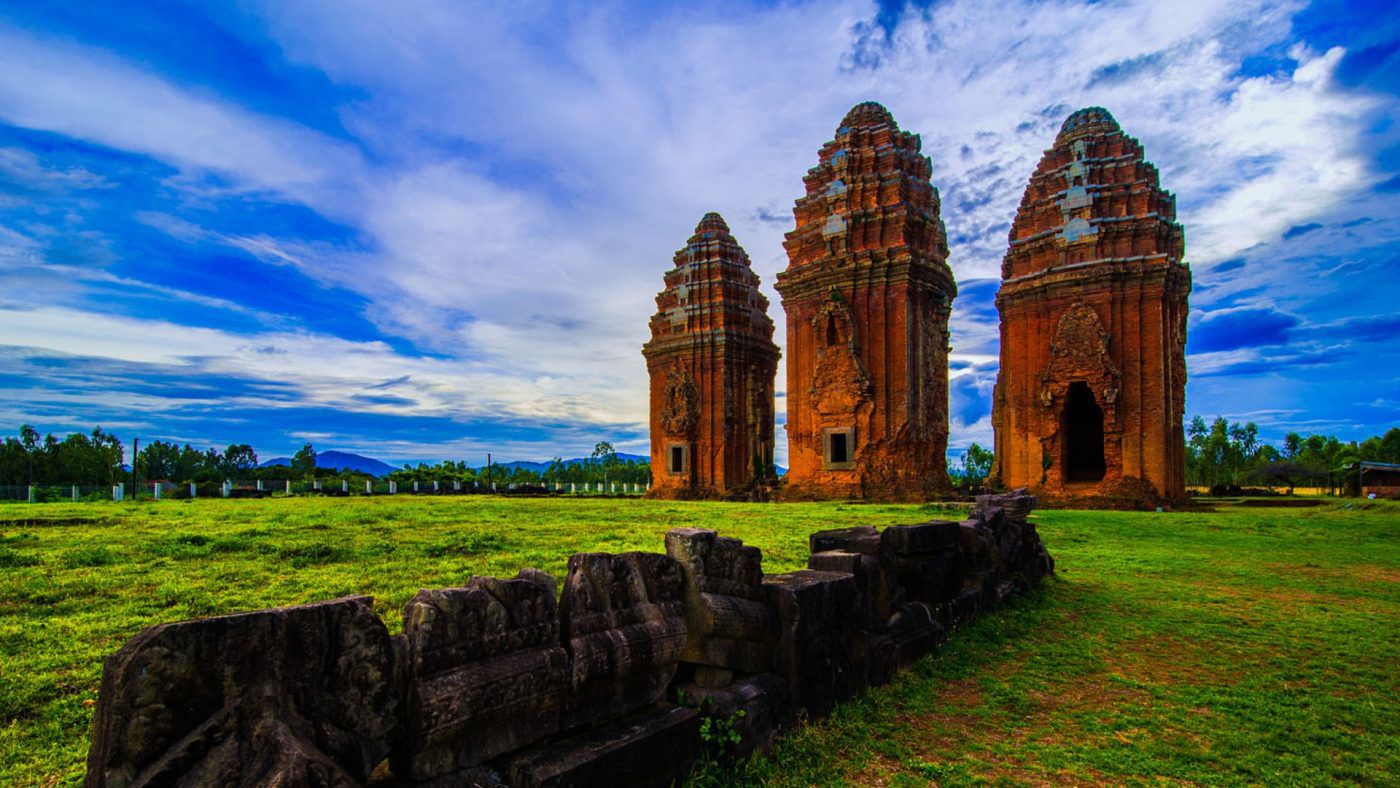
Considered as the tallest brick tower in Southeast Asia, Duong Long Tower with the main tower 39m high was built at the end of the 12th century, this is the most brilliant period of Champa culture. Photo: Internet
Duong Long Tower
Located 50km from Quy Nhon City, Duong Long Tower (built in the 13th century) means the Irovy tower designed in Khmer style. The complex tower is rather famous for its significant size and ancient architecture. Nowadays Duong Long remains only 3 towers (the largest one in the middle is 24m high and the others are 22m). From a distance the towers look alike a giant bamboo bud. The brick towers were decorated in different decoration with granite ornamentation of elephants, bas-reliefs of women, dancers, standing lions, monsters and various other animals.

Strongly influenced by Khmer art of the 12th and 13th centuries, the Doi Tower has the appearance of Khmer temples in the Angkor Vat period with a square body and curved top. Photo: Internet
Doi Tower
Within walking distance from the city centre, Doi tower was build in the 12th century and restored in 1996. The tower has a pyramid shape with two towers: one is 18m high and another is 22m. The tower is square in the middle and curved on the top. It was decorated with faked doors and pillars. Affected by Khmer architecture, the tower is made of stone and carved with dancing monkeys, sphinxes, etc. Inside, the towers taper upwards for 20 metres, like giant red brick chimneys, before opening to the sky. Tower structure is quite unique, especially the techniques of stacking and connecting rocks together strongly.
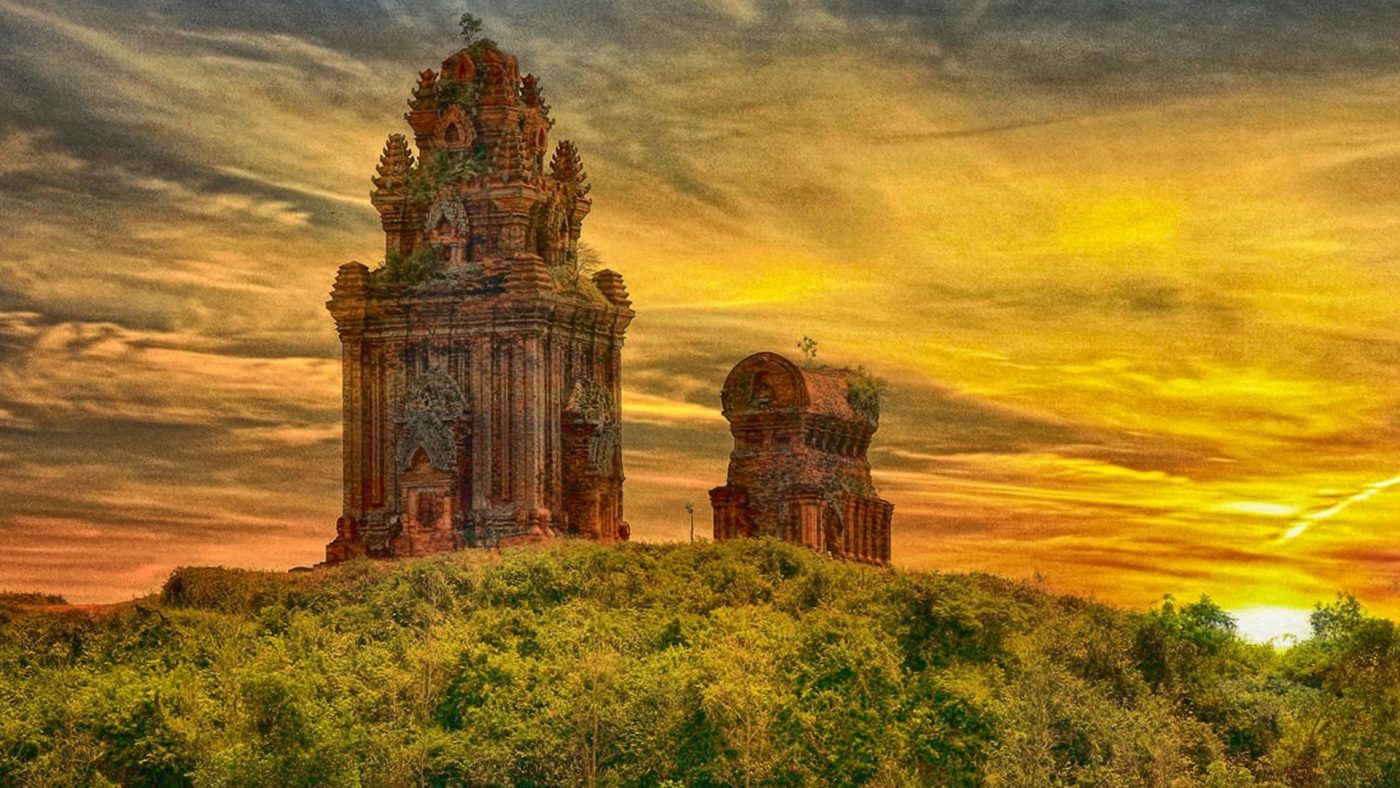
Banh It Tower is an architectural complex scattered on a 75m-high hill. Although each work is not very large, the architectural overall of Banh It is a monumental and majestic space. Photo: Internet
Banh It Tower
Banh It tower or also called Silver tower is 25km from Quy Nhon City. The local people named the tower by its shape. The four surviving towers in this group were probably built towards the end of the 11th Century. The main tower and the adjacent repository are at the very summit of a hill overlooking the Highway 1, the town of Binh Dinh, and a river. Two smaller towers are situated at lower levels on the hill, to the south and east of the main tower. From Banh It tower visitors will catch the panoramic views of a fertile countryside. According to archaeologists, the tower was used to be surrounded by a wall decorated with dancer bas-reliefs. Nowadays, that wall remains only 3 bas-reliefs of dancers. The tower was absorbed the art ideas from Indonesia and Cambodia although it is not as big as Angkor Wat or Bayon. Banh It tower houses of a few statues and sculpture from the late of 19th century. One of the most beautiful statues is statue of Shiva.

Although Canh Tien Tower is not tall, the differences can be seen from other Cham Pa towers in Viet Nam. It is a solo tower and its four corners of the walls covered with many carvings. Photo: Internet
Canh Tien Tower
Built in the 16th century, Canh Tien is 27km west of Quy Nhon City though it used to be in the central of Do Ban town. The remaining of the town is only a wall in Quy Nhon. Inside Do Ban town was a towered architecture, and Canh Tien is one of them. Normally, Champa-style tower has a group of 3 towers but Canh Tien has only one. It is an imposing tower with giant pillars, a cubic and layered architecture. Canh Tien has 2 parts of an antechamber and a sanctuary hall. The most significant thing of Canh Tien tower is the structure and the shape of faked doors with their layered structure and decoration.
TEAM BUILDING IN PHU YEN
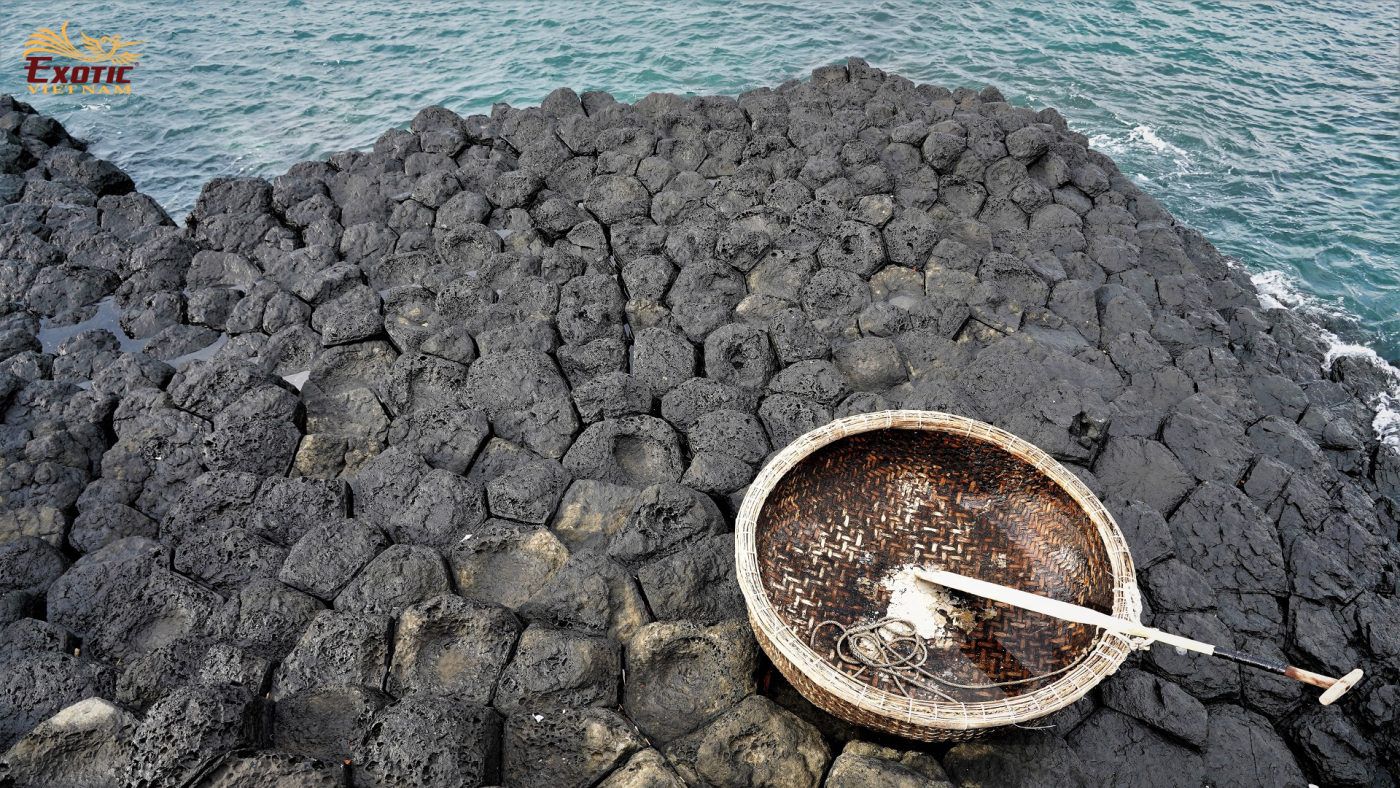
Endowed with a long coastline with amazing coves, rich lagoons, stunning beaches and pristine offshore islets, Phu Yen is a hideaway to indulge in crystal clear water, explore spectacular nature and enjoy fabulous fresh seafood. Photo: Exotic Vietnam
Location: 560km north of HCM City (1 hour by plane, 10 hours by train/ car), 120km from Nha Trang (2½ hours by car).
Introduction: Phu Yen is a rich and peaceful land leaning against the Truong Son range with many mountain branches spreading out to the sea. Phu Yen is famous for the mounts right in the city (Nui Nhan, Chop Chai), many emerald lagoons along the seaside (Cu Mong, Xuan Dai, O Loan, Vung Ro), small coastal islands (Hon Chua, Hon Chua Island). Hon Yen, Mai Nha), pristine beaches (Bai Xep, Bai Mon, …) and countless majestic rocky capes (Da Dia, Mui Dien, Mui Yen, …). Phu Yen is also famous for historical sites such as No-number boats in Vung Ro, An Tho citadel, Mui Dien lighthouse, Mang Lang church, etc. promising to be attractive destinations for visitors of all ages. The ideal sightseeing season to Phu Yen is from late January to early September every year.
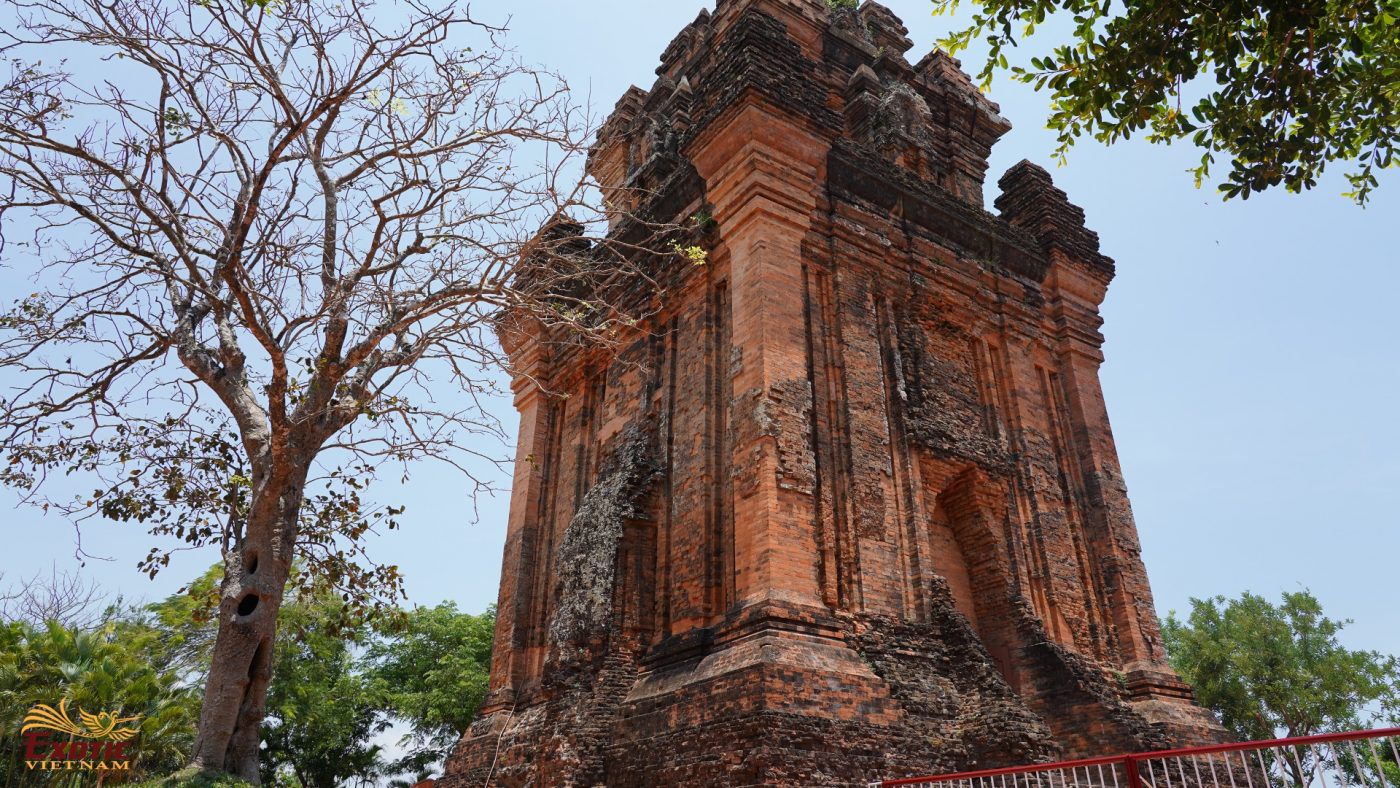
Located on the Nhan hilltop at an altitude of 60m, Nhan Tower is an architectural work built by the Cham people in the 12th century. Standing at the foot of the tower, you can admire the whole Tuy Hoa City and the winding Da Rang River. Photo: Exotic Vietnam
Nhan Tower
On hilltop right at the heart of Tuy Hoa city, there is an ancient tower of Cham people which is called Thap Nhan (Nhan Tower), constructed at around late 11th Century. This is one of the biggest towers of Cham people along the Central Coast. The tower has square structure with each side of 10m and the height of 23.5m including 3 main parts: the base, body and roof. The tower has the door forwarding the east. The landscape of Nhan Mountain – Da Rang river is considered as the symbol of Phu Yen.

With strange rock formations along the coast, Da Dia Reef like a giant honeycomb. Rocks are dark basalt columns that have almost flat surfaces and different shapes such as pentagons, hexagons, polygons, etc. Photo: Exotic Vietnam
Da Dia Reef
About more than 40km away from Tuy Hoa city, Da Dia reef is the most unique and interesting beehive-like formations along the coast of Viet Nam. It has the width of approximate 50m and the length of more than 200m which is a natural beauty spot which is rarely found. Stones here are placed in columns with hexagonal shapes (6-sided), stacked alongside one another. Each column varies in height from as short as 30cm right up to lengths greater than 2 metres. Some rise to the sky vertically while others lay on their side on top of each other. No definite count has been made of how many stones are in the collection, but there is suspected to be over 35’000 piece.
Geologists said that Da Dia Reef crystallized within a basalt lava flow, slowly cooling. When the lava flow begins to cool from the inside, it contracts and fractures. When cooling rates are fairly uniform, with the heat from the lava escaping at regular intervals, it contracts and fractures fairly evenly, leading to tall, well-developed, generally hexagonal basalt columns.
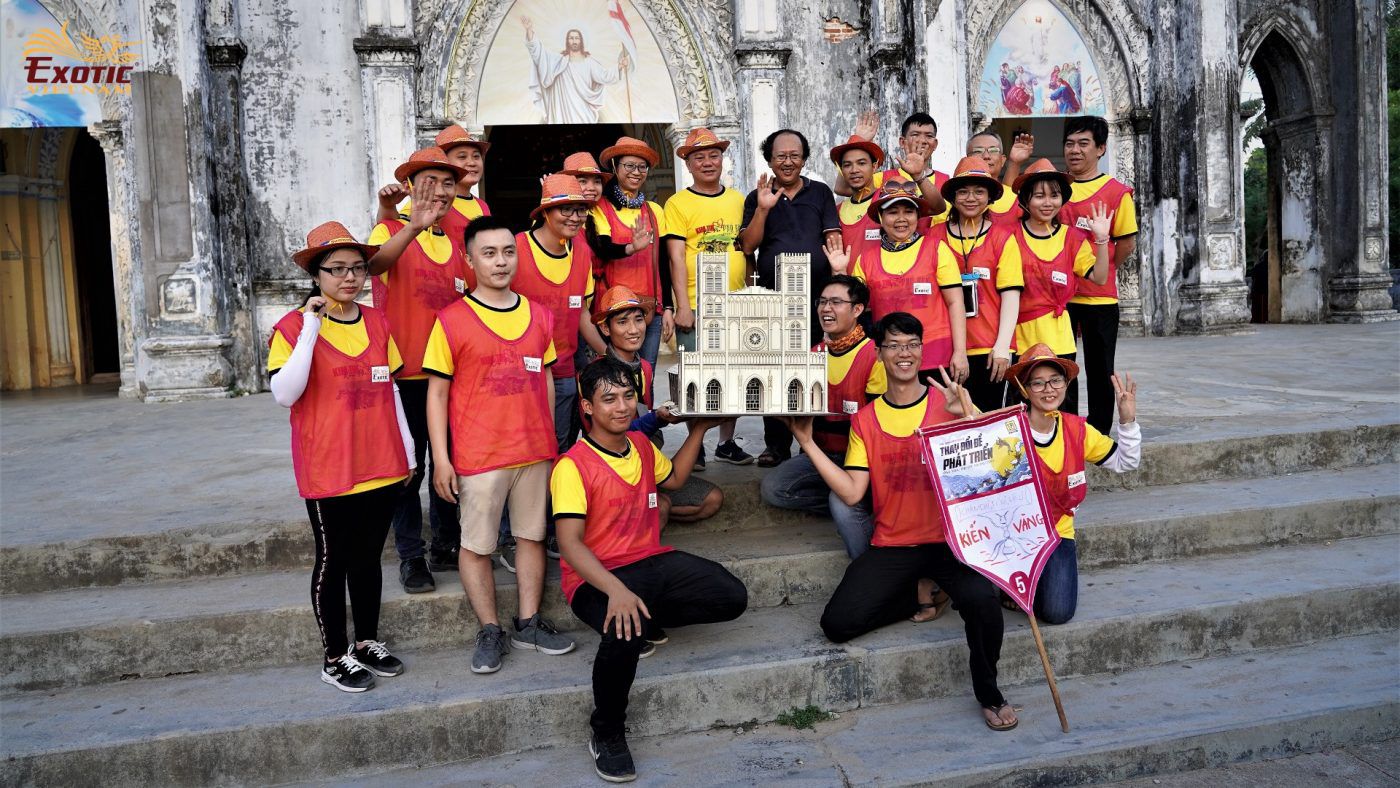
Built in 1892, Mang Lang Church, one of the oldest churches in Vietnam, here also keeps the first printed book of Vietnamese script. The team building activity organized by Exotic Vietnam helps your team build a 3D model of this church. Photo: Exotic Vietnam
Mang Lang Church
35 km from Tuy Hoa, Mang Lang Church was built in 1892 by Joseph de La Cassagne, a French priest, who was called Co Xuan by the locals. Built on an area of 5,000 sq.m, the ancient church in grayish color, surrounded by green gardens, looks magnificent against the blue sky background. The church was designed in the Gothic architectural style with two steeples. Inside it features colorful stained glass windows, wood-paneled ceilings and ancient lanterns. The two sides of the church’s lobby were designed in an eye-catching pyramid style.
To the right of front yard is a built-up hill, where you can explore an interesting exhibition in its cave inside. The first book to be printed in the modern Vietnamese script is housed here. Written by Alexandre de Rhodes, a French Jesuit missionary, the book was printed in 1651 in Rome, is the catechism book “The eight-day teaching”. The cave also displays pictures of the church in the early days of construction and the documents about the life of Saint Andrew Phu Yen, a Catholic protomartyr of Viet Nam, executed in 1644.
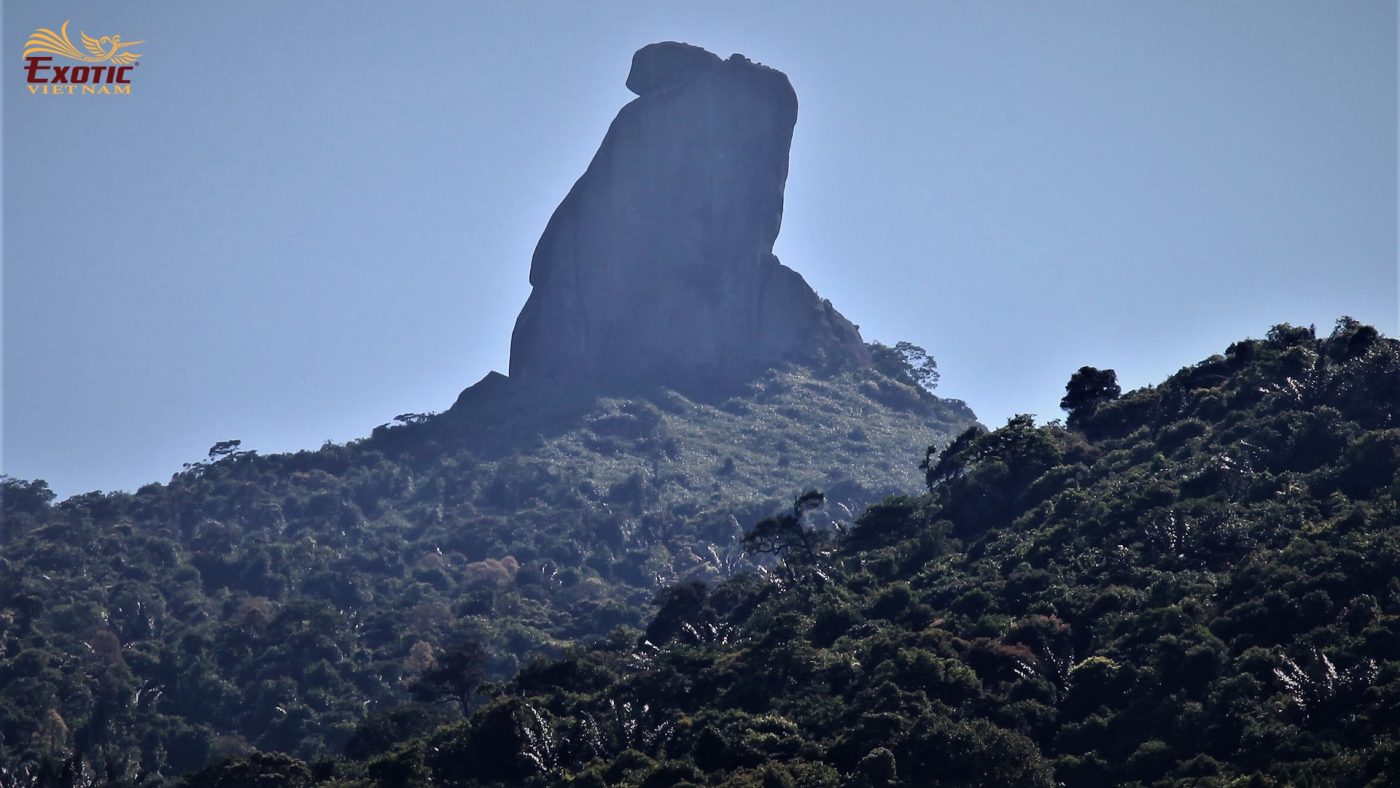
Mount Da Bia with a 76m high towering rock at an altitude of 706m is a glorious destination after you conquer 2.5km of zigzag stairs under the forest canopy. Photo: Exotic Vietnam
Mount Da Bia
About 35km from Tuy Hoa City to the south, Mount Da Bia (or called Thach Bi Son) has the height of 706m which is imposing in the North of Ca Pass range. On the top, there is a giant stone block with the height of 76m with particularly-interesting shape. From long time ago, Da Bia is considered as a holy mount with the name of Lingaparvata (it means Linga – the mountain god who was the embodiment of Siva God in the belief of Cham people), in the ancient book of China, it is transcribed as Lang-gia-bat-bat-da. Mount Da Bia is closely linked to many legends. Especially the event in 1471, King Le Thanh Ton on his way to reclaim the land to the South, the king carved letters in the big stone block at the top of the mountain. From that time, the mountain is called Mount Da Bia (Stone Stele) or Thach Bi Son.
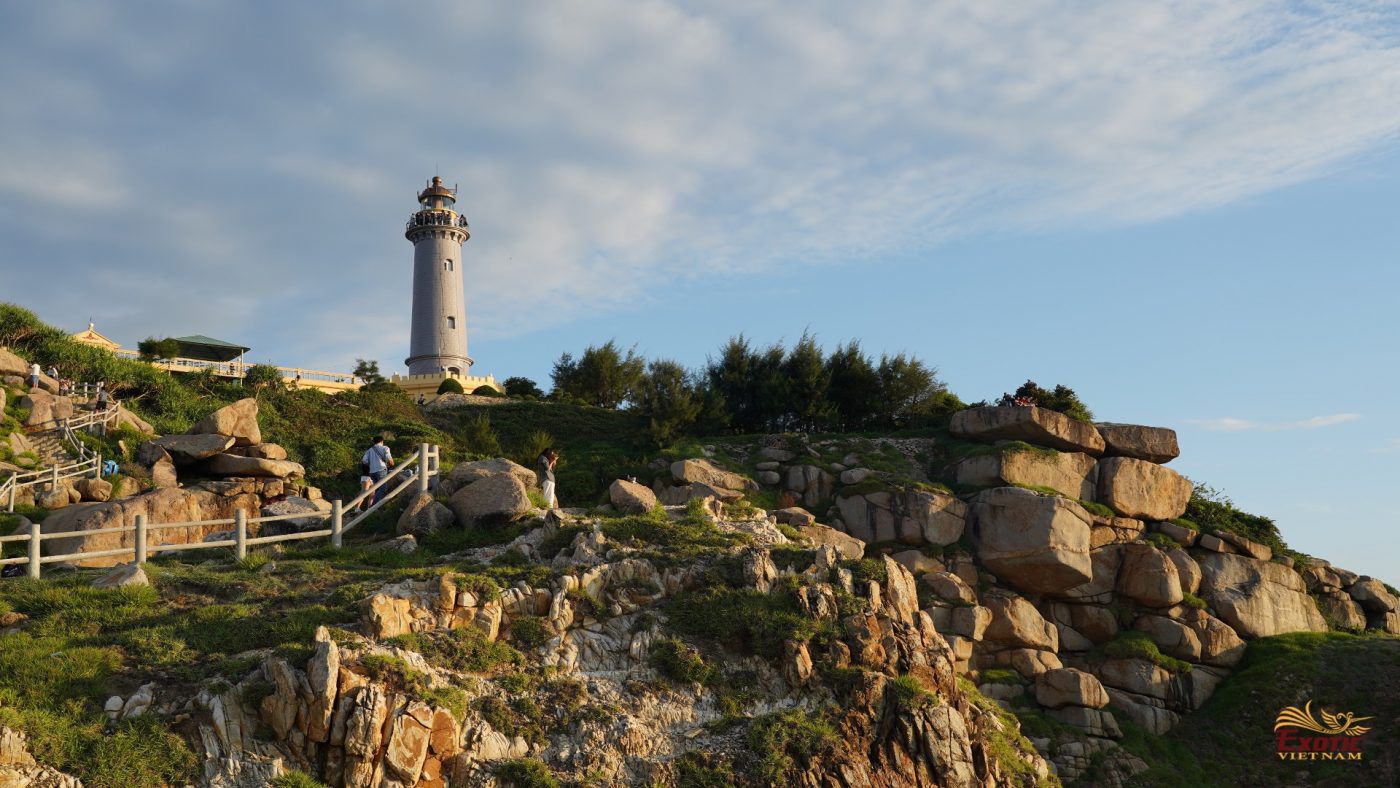
Blessed with strangely shaped granite blocks and impressive panoramic sea views, Cape Mui is one of Vietnam’s most fascinating attractions, where visitors can catch the first sunlight into the country when the headland is at the easternmost point. Photo: Exotic Vietnam
Cape Dien
About 35km from Tuy Hoa City to the south, Cape Dien (or Mui Dien) is also known as Mui Dai Lanh, Mui Ke Ga, Cap Varella. In 1890, the French built a lighthouse for the purpose of navigating ships operating in the sea into Vung Ro Bay. Through the war, the lighthouse was ruined and was re-built and operated again in 1995. This is one of eight lighthouses with the age of over 100 years among 79 active lighthouses in Viet Nam. Cape Dien is gradually considered as the second furthest point to the East, after Cape Doi in Van Ninh, Khanh Hoa and is one of the places to welcome the first dawn on the mainland of Viet Nam.
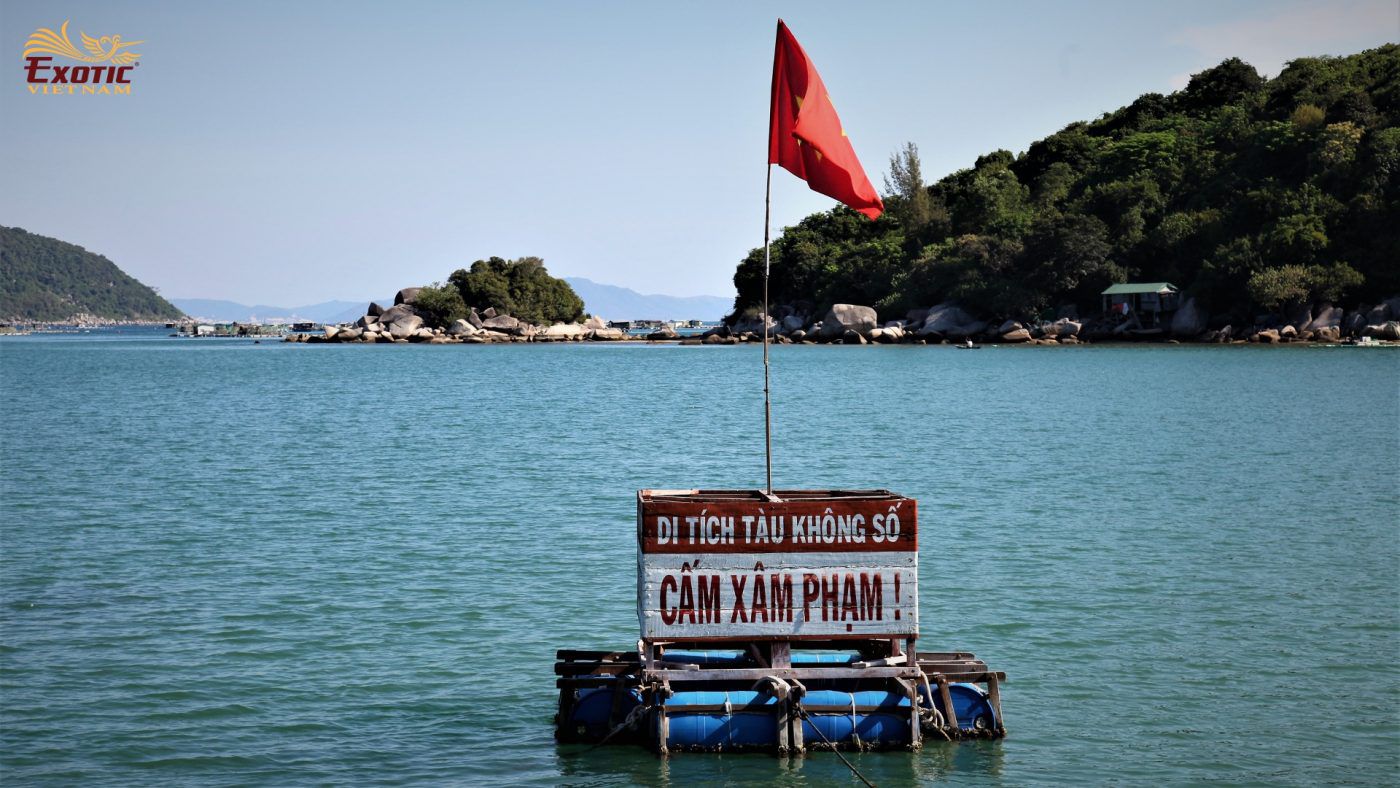
Surrounded by high rocky headlands and rugged jungle ranges, Vung Ro Bay is known as a place where weapons were supplied from the North by ships during the Viet Nam War. Photo: Exotic Vietnam
Vung Ro Bay
About 35km from Tuy Hoa City to the south, Vung Ro Bay covers an area of 1,640ha of water surface and the depth enough to receive the ships with capacity of more than 5,000 tons which is covered by mountain ranges of Ca Pass, Mount Da Bia, Hon Ba in 3 directions of north, east, west. Especially, Vung Ro was one of important secret ports of Ho Chi Minh Trail on sea where received hundreds of tons of weapons transported by ships without ID number from the North to support the Southern battlefield in the years of the Viet Nam War. The transportation to Vung Ro in the period from 1964 – 1965 was a historical event that shows the tenacious fighting spirit of soldiers and people of Viet Nam.
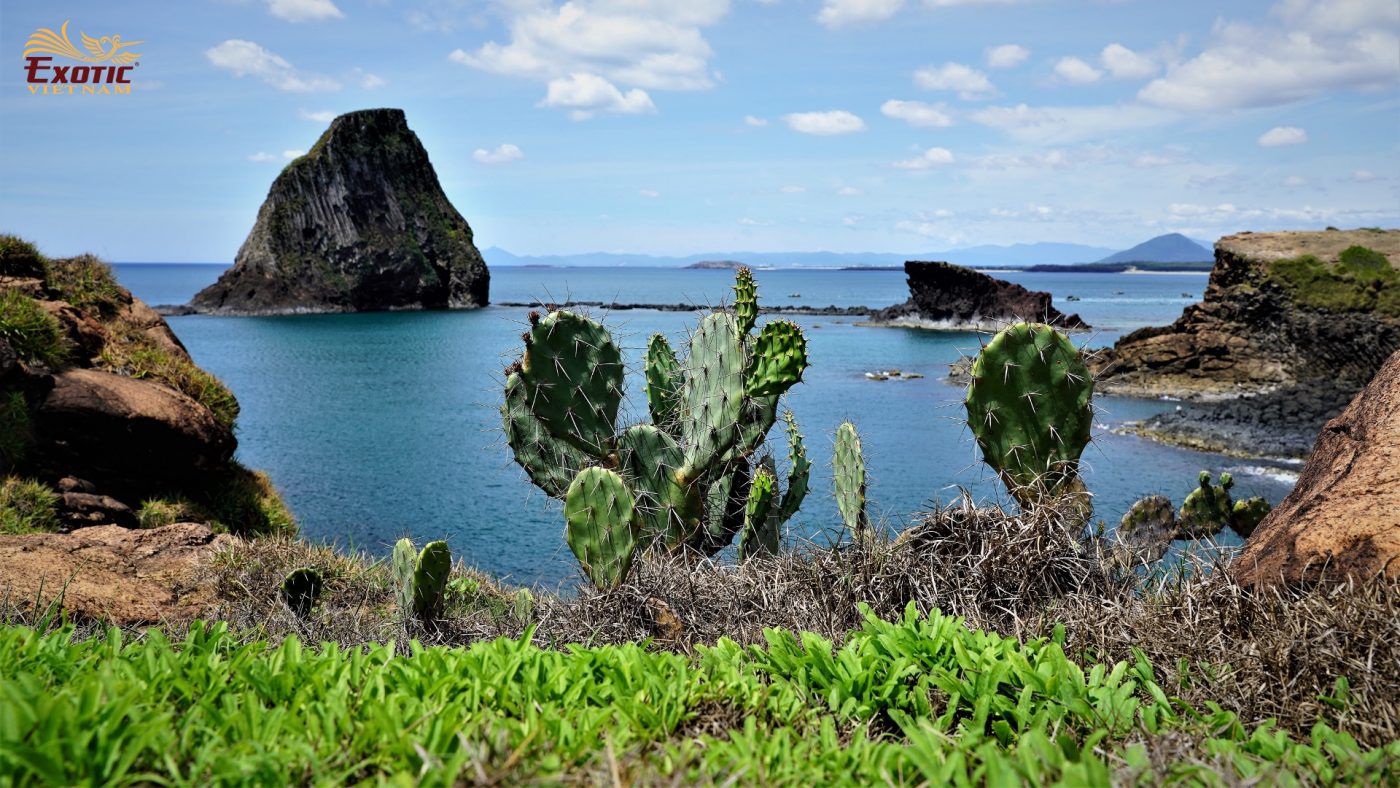
Dotted along the coastal waters near Tuy Hoa City, the islands in Phu Yen are mostly uninhabited and known with white sands, amazing rocks, crystal clear waters and colorful corals. They are an off-the-beaten-track holiday destination for those who seek their retreat remote, rugged, relaxing and remembered. Photo: Exotic Vietnam
Islands in Phu Yen
Long Thuy beach is about 7km north of Tuy Hoa city. It is considered as a famous and beautiful beach of Phu Yen with white sand, pure water and small waves. From this place, the visitors can travel on ship to visit many islands around where have beautiful scenery with diversified sea ecology.
- Hon Chua: About 3km from the mainland, this place remains untouched. Chua Island is surrounded with coral reefs including many kinds of colorful, diverse and rich coral. Coming to Chua Island, tourists will be immersed in the fresh air with blue sea, white sand, sunshine and can join fishermen to catch fish, squid, sea urchins, etc.
- Hon Mai Nha: About 3km from the mainland, this is the largest island in Phu Yen province with an area of 130ha. The island offers travellers the opportunity to go swimming, relax on the golden sand and trek to hilltop to get a panoramic view of grassland with lots of cactuses and wild trees and waves slapping against uniquely shaped rocks.
- Hon Yen: About only 300m from the mainland, Yen Island can be reached by foot when the tide is low. It’s a place that you can merge yourself with the sea, winds and the sun. Yen Island not only owns colorful coral reefs, spread over an area of 30ha but also has its unique aquatic system.
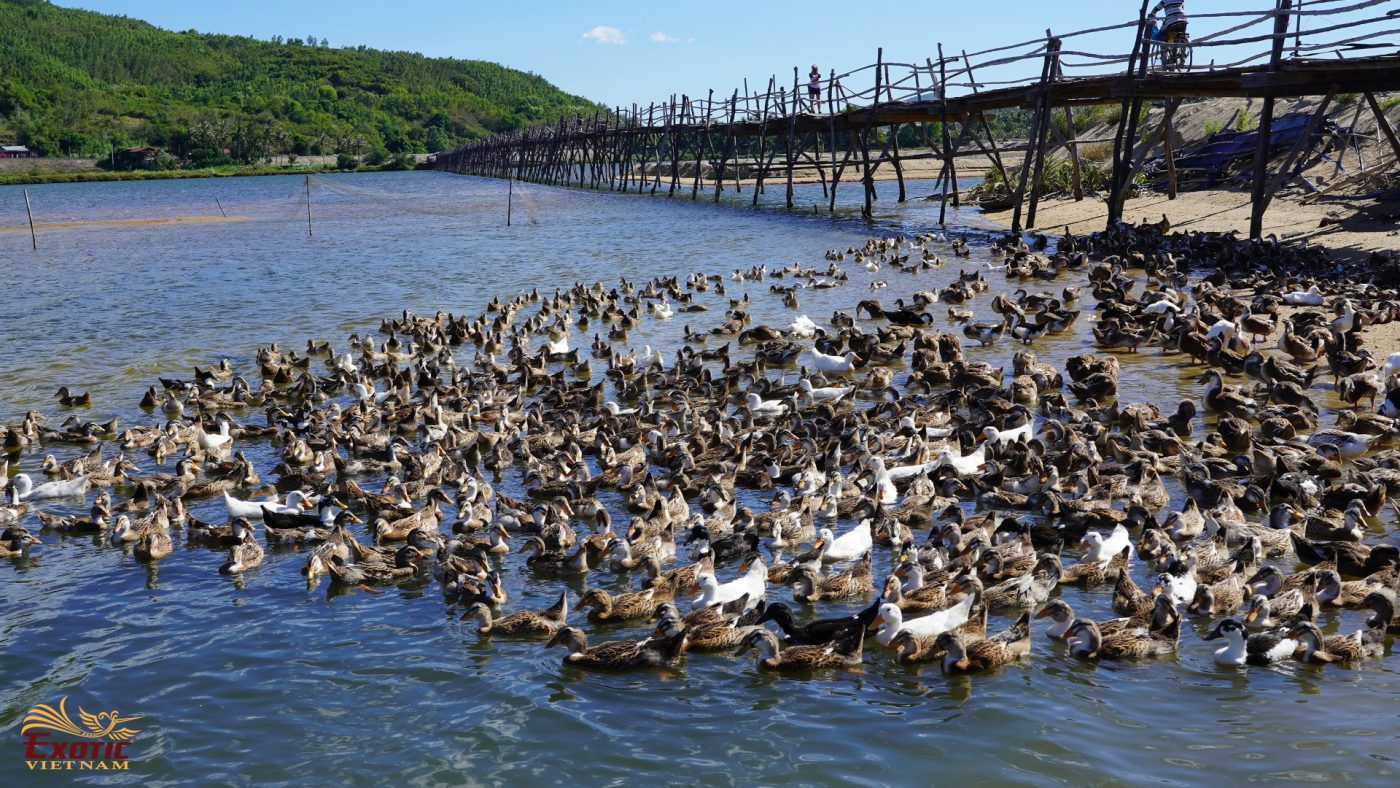
Ong Cop Bridge is raw brush strokes to paint a genuine picture of the countryside in Phu Yen that will make you feel instantly calm. Visiting the bridge, visitors can see the immense transparent lagoon and the idyllic life of the local people. Photo: Exotic Vietnam
Ong Cop Bridge
About 35km from Tuy Hoa, Ong Cop Bridge crosses Ky Lo River. It’s the longest wooden bridge in Viet Nam with a length of 570m and 1.5-1.8m wide. This small bridge is only for pedestrians & motorbikes from the two banks. The bridge was built by local people in 1998. Every year it has to be repaired or even newly re-built it due to the flood season washing away the bridge. Nowadays, the bridge is the adornment of the rustic landscape of the Phu Yen lagoon area and becomes a very famous check-in place for young tourist.
TEAM BUILDING IN NHA TRANG
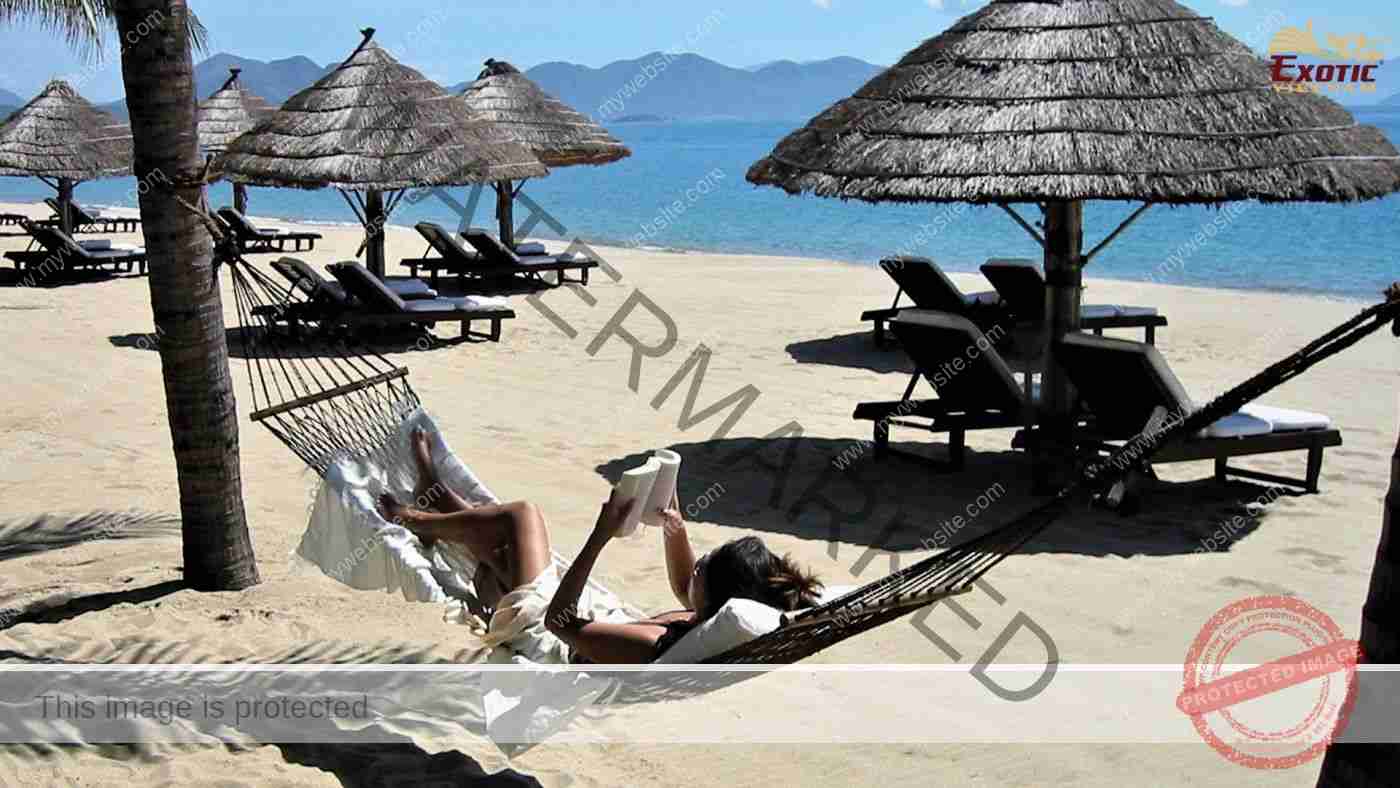
From frolicking in the water to action-packed adventures, Nha Trang offers many things for everyone to enjoy or nothing to do except spending a lazy day in the shade of a palm tree on the beach. The scenery is so fascinating, the clear blue sky is filled with light, the fresh seafood is skillfully processed, etc. you never want this warm and happy life to end. Photo: Exotic Vietnam
Location: 450km north of HCM City (8 hours by car or 1 hour by plane or 8 hours by train), 185km from Buon Ma Thuot (4 hours by car), 215km from Da Lat (4½ hours by car), 235km from Quy Nhon (4 hours by car).
Introduction: Nha Trang is considered to be one of the most beautiful bays in the world. It is endowed with vast tranquil beaches, beautiful islands and the finest climatic conditions. It is perfect for leisure makers, sightseers and event planners. You can find everything you need in one of the most beautiful beaches in the world: luxurious resorts, top class restaurants, theme parks, golf courses, water sports, as well as imposing attractions including the Cham towers of Po Nagar, the white Buddha statue, the Mountain Cathedral, the Ocean Institute and a Museum to Alexandre Yersin, the French Swiss researcher who found the cause of bubonic plaugue and dedicated his life to Viet Nam.
Highlights: Islands in Nha Trang, Bai Dai Beach, Cam Ranh Bay, Long Son Pagoda, Nha Trang Cathedral, Oceanographic Institute, Pasteur Institute, Po Nagar towers, Thap Ba hot springs.
Facilities & services: boat ride to off-shore islands, scuba diving, snorkeling, jet skiing, wind surfing, parasailing, international standard hotels, resorts and restaurants.
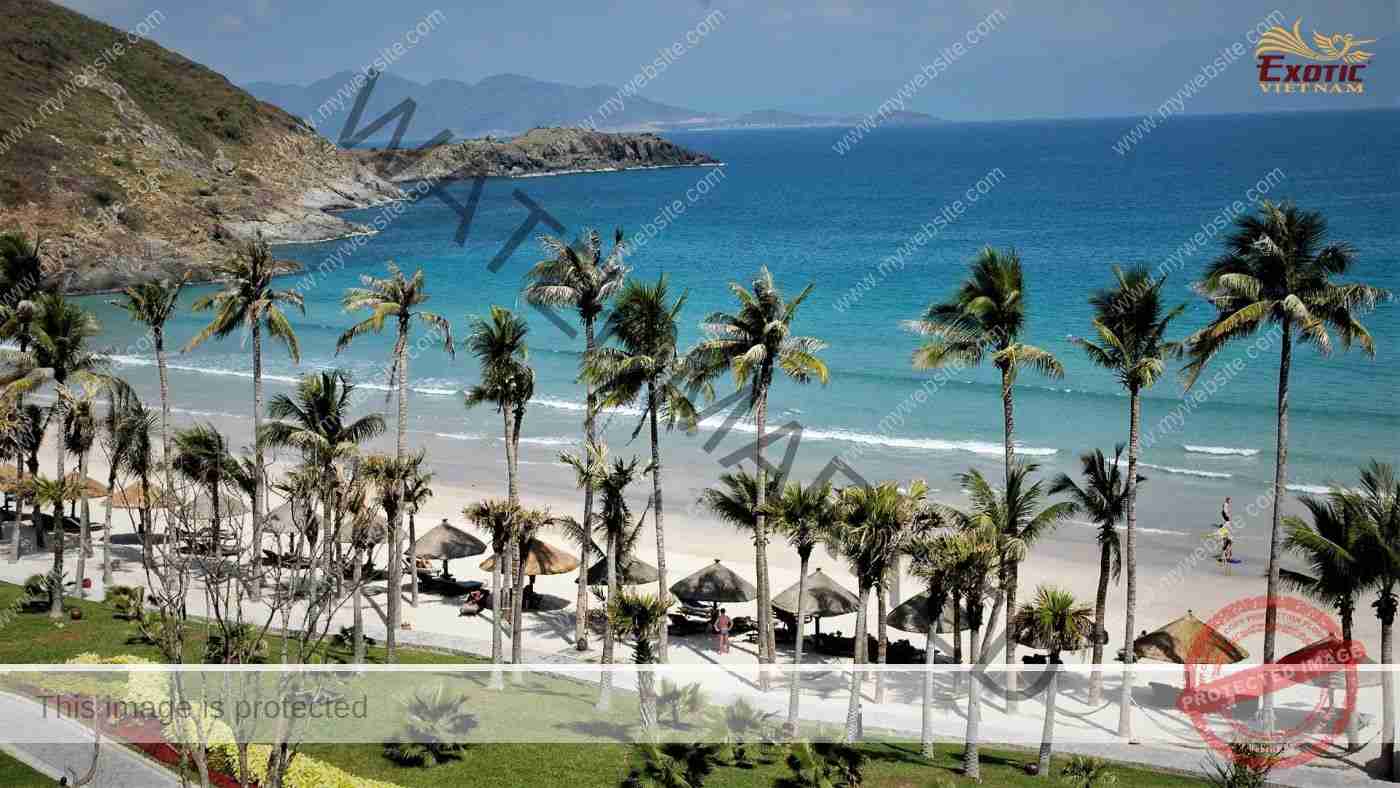
The islands in Nha Trang are not only screens to protect the city against strong winds, but also provide habitat for a vast array of sea creatures and birds. The clear blue water and diverse underwater world ensure that aqua activities such as snorkeling and scuba diving or sea walking become impressive. Photo: Exotic Vietnam
Islands in Nha Trang Bay
The islands of Hon Tre, Hon Mieu, Hon Mot, Hon Tam and Hon Mun are just a few kilometres from Cau Da Wharf. The water is clear and the marine life is diverse enough to ensure marine sports such as snorkeling and scuba diving. After a swim or a dive, visitors may go punting to explore fishing villages on the islands, tasting local seafood specialties, watching fishermen go about their daily jobs or simply enjoying completely unspoilt scenic beaches.
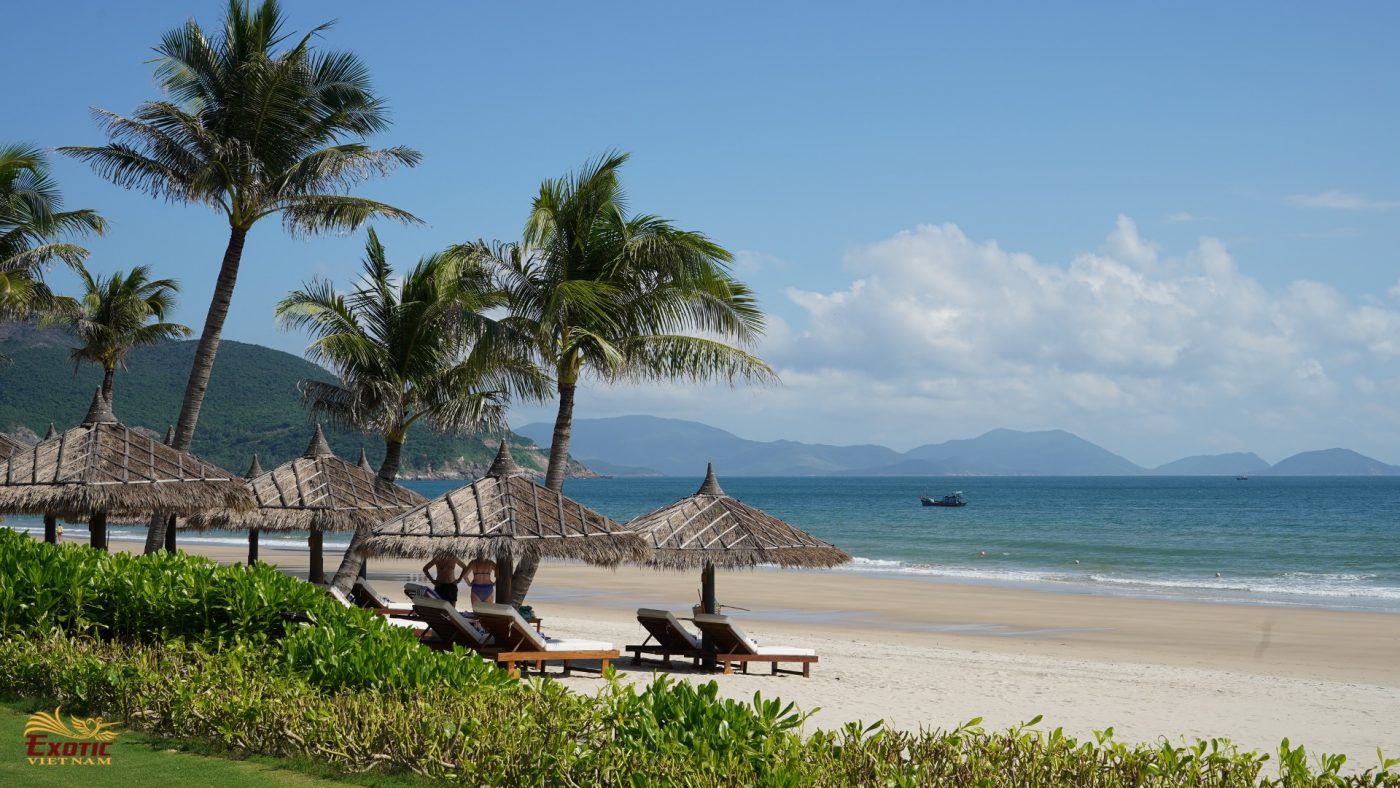
Previously, Bai Dai Beach was a deserted beach in the south of Nha Trang, now it has transformed into a resort town with dozens of large-scale resorts. Fringed by a long stretch of the white sands, Bai Dai Beach is a place where you can enjoy the sun and wave or get involved in leisure facilities at the beach. Photo: Exotic Vietnam
Bai Dai Beach
Located between Cam Ranh airport and Nha Trang city, the heart of Bai Dai is only about 20km south of Nha Trang. Stretching over 15km, this stretch of sand is part of Cam Ranh peninsula with one side overlooking the East Sea and the other being Thuy Trieu lagoon. No doubt this is really a very beautiful beach with flat coast, clear blue water and calm waves. Bai Dai Beach impresses with its beauty and combination of colors: absolutely white sand, fair blue sky and wonderfully clear water, which contains the entire color spectrum from powder-blue to dark blue.
With a land fund of nearly 800ha, approximately 40 luxury resort projects have been licensed by authorities. Some of them have been put into operation such as: Vipearl Long Beach, Duyen Ha, Fusion, Maia, Mia Resort, Eurowindow, Alma, Riviera, Selectum Noa, etc. What could be more wonderful than being immersed in the clear blue sea, resting by the whispering green coconut trees, or participating in vibrant team building activities and enjoying a great meal with fresh seafood dishes.
The title of “Resort Capital” in Viet Nam is soon becoming a reality in Bai Dai Beach. In 2017, National Geographic Magazine (US) continued to vote Bai Dai, Cam Ranh in Khanh Hoa province as one of the 10 most beautiful beaches on the planet. For many years since 2010, Bai Dai has always maintained this appellation.
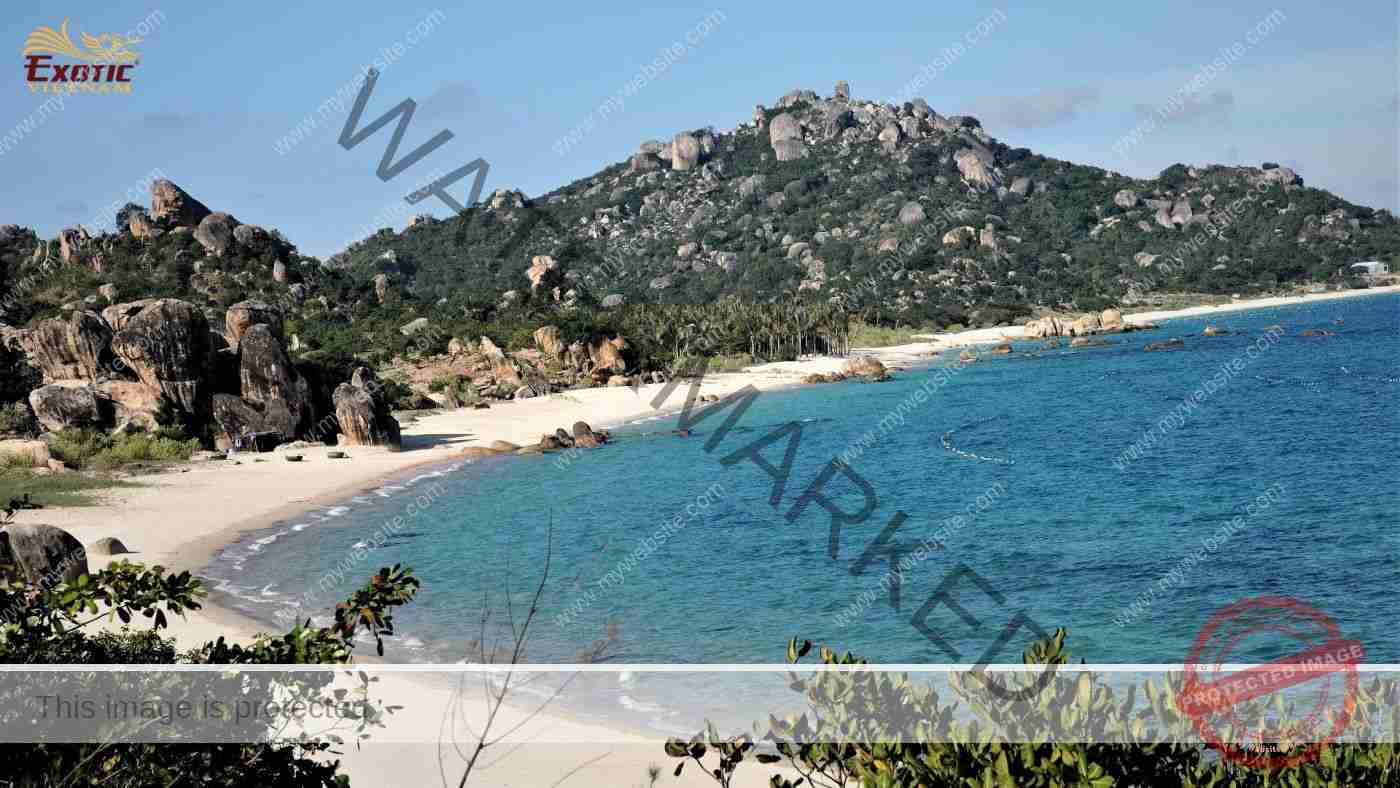
Regarded as Southeast Asia’s best deep-water refuge, Cam Ranh Bay has a long history of military use from the US to the Soviet Union. Today is known as the submarine base of Viet Nam and a few small tourist projects have been built. Photo: Exotic Vietnam
Cam Ranh Bay
Located 60km from Nha Trang city, Cam Ranh Bay has an area of about 60 sq.km. The narrowest place is about 10km and the widest is 20km, the average depth is from 18 to 20m. It is considered one of three best bays in the world along with San Francisco in USA and Rio De Janiero in Brazil.
Previously, Cam Ranh was known as a military port rather than a tourism site. There are many beautiful coral reefs and fish beneath the bay. But the most amazing is that granite formations formed by the erosion of wind and sea. The bay also owns many attractive pristine beaches adorned with rows of soaring coconut trees that make up distinctive features of the Central Coast. Cam Ranh Bay is truly a natural wonder and a perfect place for aqua activities such as sailing, fishing, coral diving, relaxing, health treatment, climbing…. It is an ideal place to build a world-class sea tourism site. However, there are different developments in Cam Ranh peninsula. Bai Dai stretch with many large resort projects has been implemented. In contrast, the southern part of the peninsula still remains unspoiled with small accommodation establishments and pristine beauties.
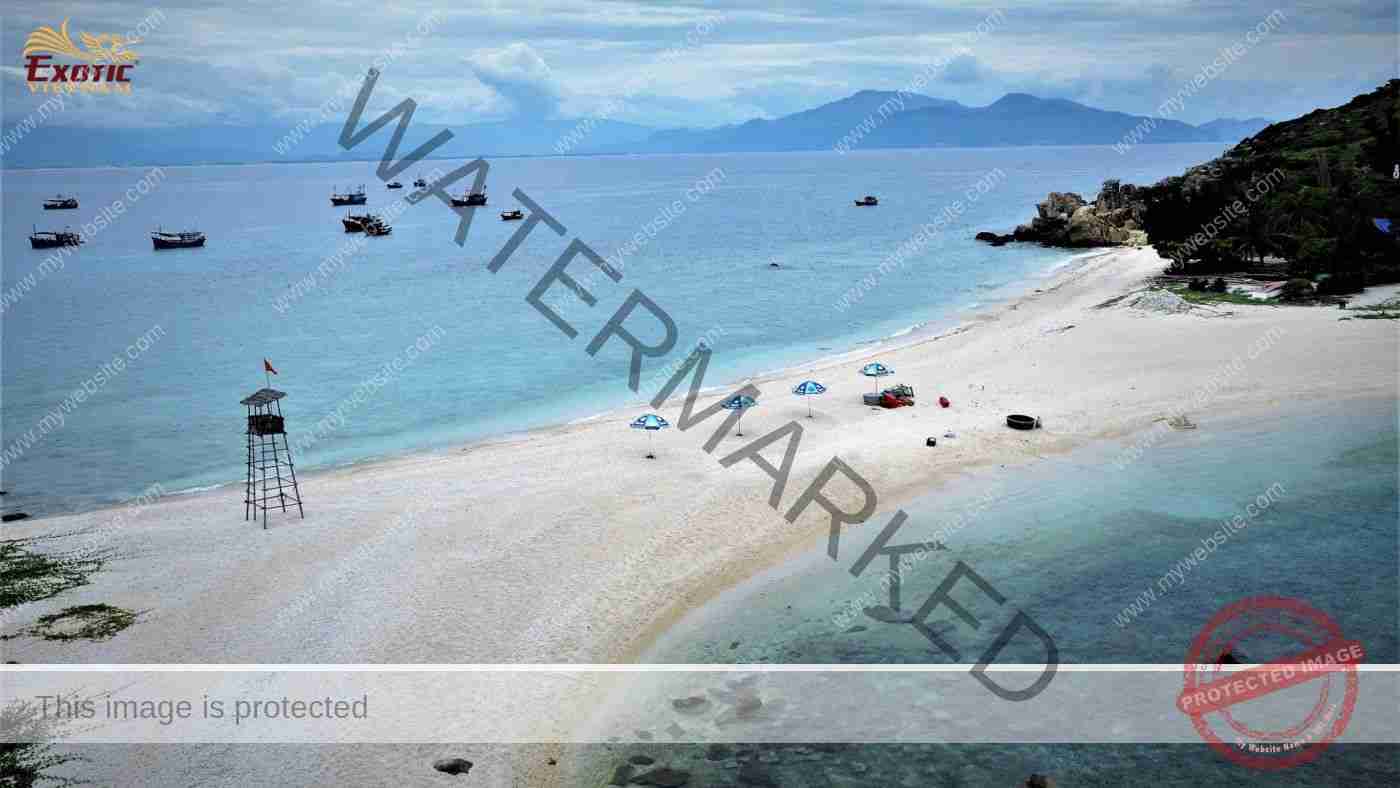
Salangane Islands are home to the most crowded swallow colonies, where visitors can learn about traditional swallow nest exploitation on the high vertical granite cliffs and encounter the wild natural beauty with coral reefs and sandy beaches. Photo: Exotic Vietnam
Salangane islands
Salangane islands, or Hon Noi island and Hon Ngoai island is about 25km south of Cau Da Wharf (about 1 hour by boat). This place is well known with the twin islands connected by a stretch of fine sand more than 100 meters long. The larger island is Hon Noi where visitors can climb to Du Ha peak, 90m high to admire the panoramic view of blue sea, rocky formations and white sand beach. On the island, there is also a temple and statue worshiping Le Thi Huyen Tram, who commanded the navy of the Tay Son Army in 1788. She organized the exploitation and export of bird’s nests as a source of finance for the Tay Son Dynasty.
Coming to Salangane islands, don’t miss visiting the Salangane cave and learn about the bird nest farming. Bird’s nests are harvested twice a year in March and August, visitors also see lots of watchtowers of the local people. The sea is so calm with turquoise water, where visitors freely swim and watch lively coral reefs and many colorful fishes. The best time to visit the islands is from March to September because of gentle wind and mild wave.
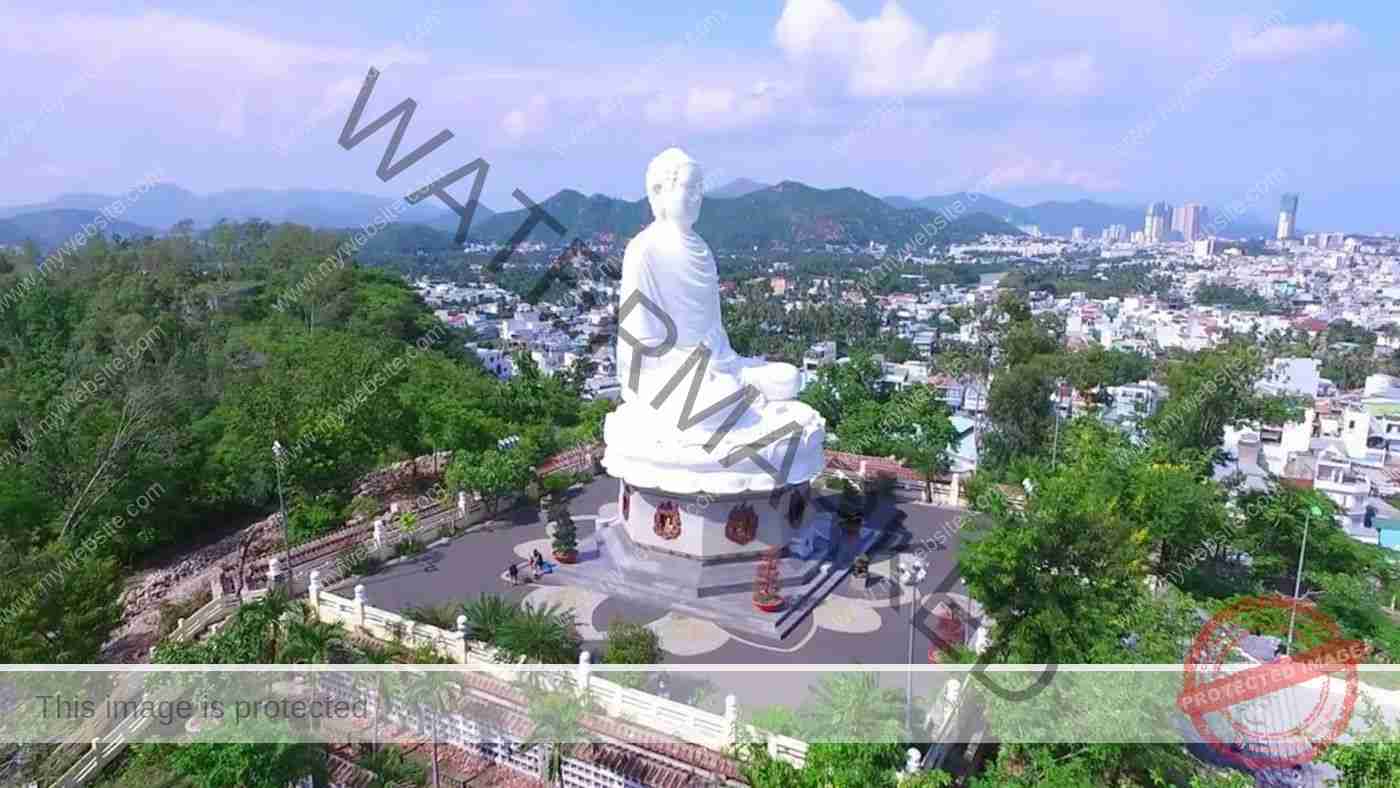
From afar, visitors have seen the giant Buddha statue of Long Son Pagoda. Walk 152 steps up to admire the large white Buddha sitting on a lotus flower. Around the base of the Buddha is carvings of monks who burned themselves to protest against the government during the Viet Nam War. Photo: Internet
Long Son Pagoda
Built in 1889, Long Son Pagoda is the main and largest pagoda in Nha Trang. The entrance and the roofs are decorated with mosaic dragons made of glass and bits of ceramic tile. The main sanctuary is an attractive hall adorned with modern interpretations of traditional motifs. At the hilltop behind the pagoda is a huge white Buddha statue seated on a lotus blossom which is visible from all around.
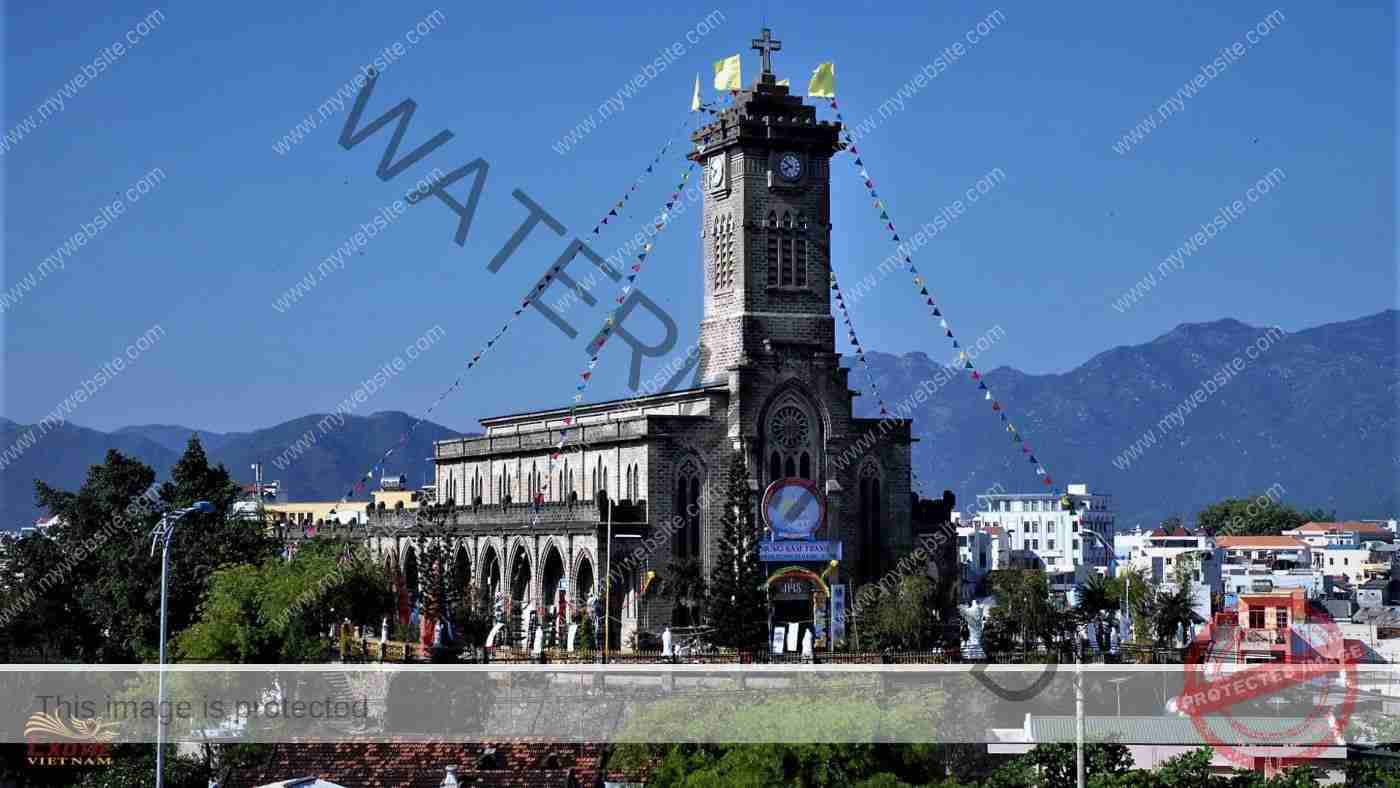
Nha Trang Cathedral is the most magnificent French architecture in Nha Trang. Priest Louis Vallet (1869 – 1945) devoted himself to building the church. You can visit his grave located at the foot of the mountain. Photo: Exotic Vietnam
Nha Trang Cathedral
Nha Trang Cathedral, built in French Gothic style and complete with medieval-looking stained glass windows, stands on a small hill overlooking the train station. It was constructed of simple cement blocks between 1928 and 1933. Three large bells were provided by the Bourdons Carillons Company in 1934, and a big clock was assembled on the tower in December 1935. Masses are held from Monday through Saturday at 5 a.m. and 4:30 p.m. and on Sundays at 5 a.m., 7 a.m. and 4:30 p.m.
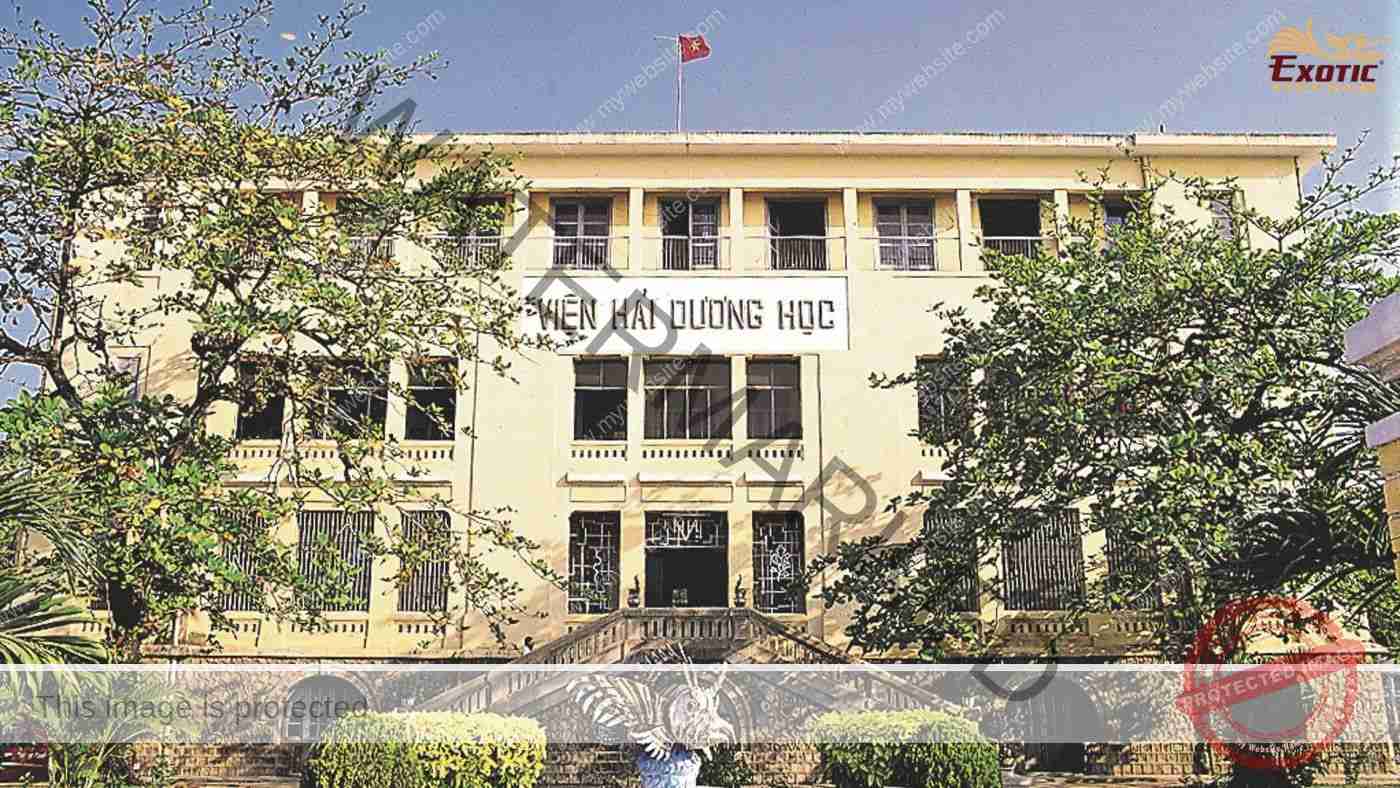
Nha Trang Oceanographic Institute displays thousands of marine specimens collected and preserved for many years, and some live specimens are kept in glass tanks. This attraction helps to raise awareness about respecting and protecting the marine environment for all age groups of visitors. Photo: Exotic Vietnam
Oceanographic Institute
Founded in 1923, the Oceanographic Institute is housed in a grand French-colonial building in the Cau Da area. It has an aquarium, a specimen room and a library. The aquarium is home to a variety of colourful live specimens of local marine life. Besides, a large hall behind the main building contains 60,000 dead specimens, including stuffed sea birds and fish, corals and corporeal remains of other marine creatures preserved in glass jars.
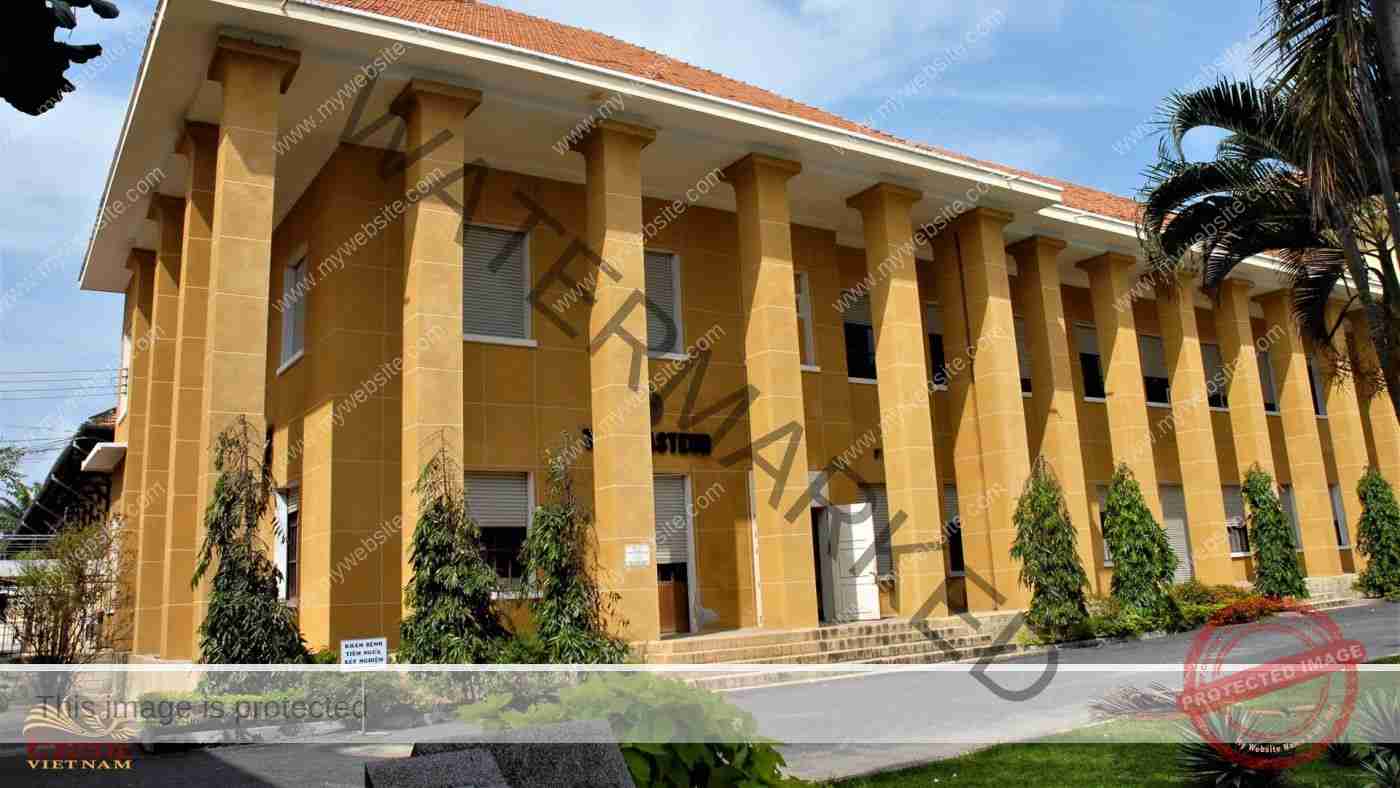
Founded in 1895 by Dr. Alexandre Yersin, visit the Pasteur Institute to find out his stories, who devoted his whole life to science, concern for those afflicted with the illness, and also to learn more his exciting exploration to new lands. Photo: Exotic Vietnam
Pasteur Institute
Nha Trang’s Pasteur Institute was founded in 1895 by Dr Alexandre Yersin (1863-1943). Dr Yersin’s library and office are now a museum located on the second floor; items on display include laboratory equipment and some of his personal effects. There is a picture of Dr Yersin above the door to the veranda. The model boat was given to him by local fishermen with whom he spent a great deal of his life. The entrance gate is located at 10 Tran Phu St.
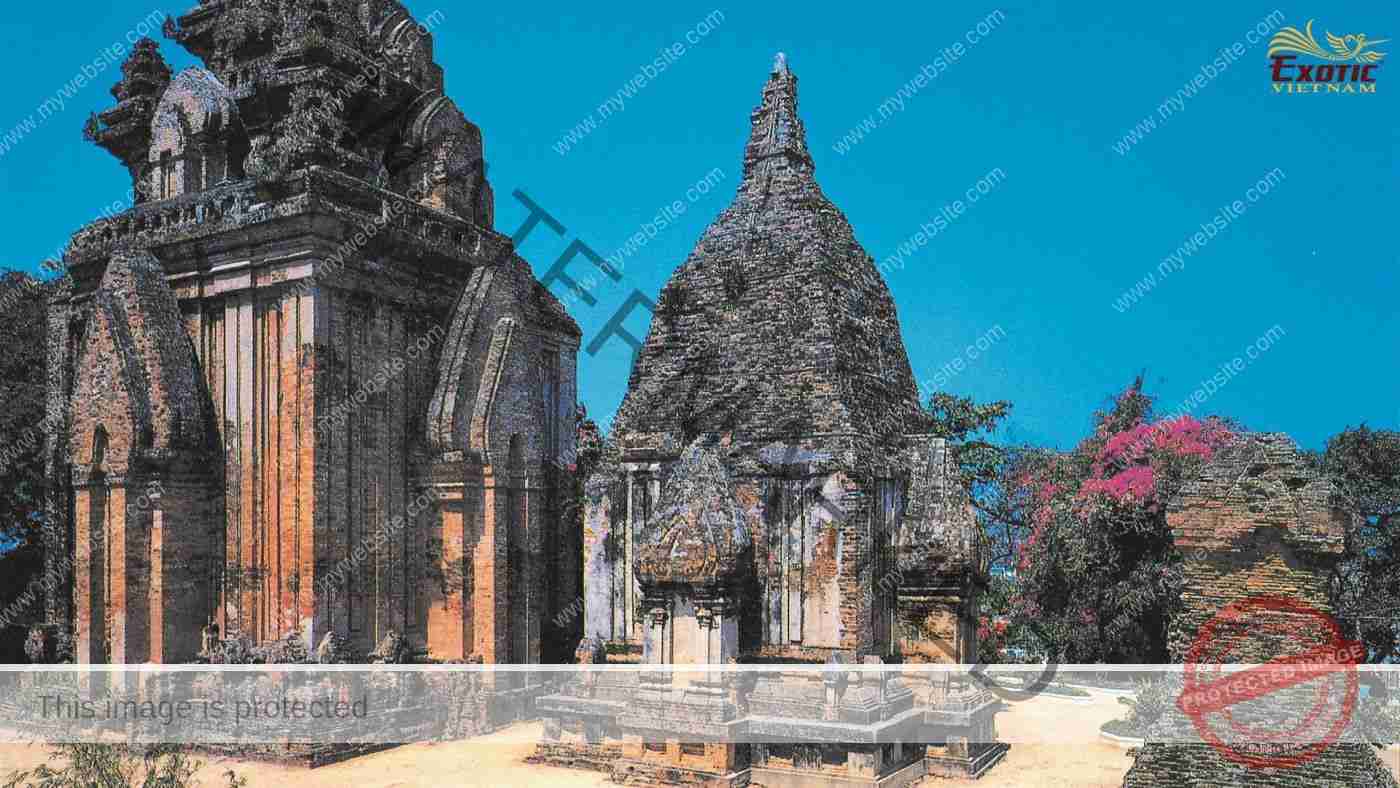
Nha Trang was known as Kauthara under the Champa Kingdom. A hilltop next to the river is home to a cluster of brick towers built by the Cham people many centuries ago. Po Nagar Towers are well-reserved with most original architectures being still intact. Photo: Exotic Vietnam
Po Nagar Towers
Built between the 7th and 12th centuries, the Cham towers of Po Nagar were used for Hindu worship. Today, both Chinese and Vietnamese Buddhists come to Po Nagar to pray and make offerings according to their traditions. Only with loose bricks and with neither plaster on the walls nor mortar between the bricks – the towers have stood for many centuries. Standing on a granite hillock by the Cai River, the towers offer a fantastic view of Xom Bong Bridge and docks of trawlers and junks.
TEAM BUILDING IN PHAN RANG

Known as a land of sun, stone, sand, and sea, and while you are there, maybe a land of sheep, Phan Rang is the most arid region in Viet Nam. The harshness of climatic conditions has created many amazing natural wonders. Phan Rang also boasts the vibrant culture of Cham people along with their outstanding architectural works and unique handicraft products. The land where your travel passion is satisfied. Photo: Exotic Vietnam
Location: 345km north of HCM City (6 hours by car), 110km east of Da Lat (2½ hours by car), 105km south of Nha Trang (2 hours by car).
Introduction: Phan Rang, the capital of Ninh Thuan Province, is located at the T-junction to famous attractions in South Central Vietnam: Da Lat, Phan Thiet and Nha Trang. Being the arid area with the average annual rainfalls of under 700mm, Phan Rang is endowed with the blue sky, red sand dunes and turquoise sea all year round. Inhabited by a large crowd of Cham people, visitors can find Cham vestiges and Cham traditional handicraft villages producing terracotta and weaving brocade. Especially Cham folk songs and dancing arts make the journey to Phan Rang unforgettable.
Highlights: Nui Chua National Park, Mui Dinh sanddunes, Po Klong Garai Towers, Ninh Chu Beach, Bau Truc pottery village, My Nghiep weaving village, etc.
Facilities & services: boat ride on the bay, tourist class hotels and restaurants.

Considered the harshest land of Viet Nam, Nui Chua National Park is famous for its biodiversity and arid landscape. There are some secluded beaches, fantastic hidden coves, picturesque rocky cliffs surrounded by crystal clear waters that are still little-known, even for those who have visited here many times. Photo: Exotic Vietnam
Nui Chua National Park
Established in 2003, the Nui Chua National Park is a dome-shaped granite mountain jutting out into the East Sea, consisting of several peaks over 1,000m tall. About 35km north of Phan Rang – Thap Cham city, the park spreads over an area of 29,860ha, of which the land part is about 22,500ha, the sea part is 7,350ha. Dominated by a semi-arid climate, the park has recorded 1,504 species of higher vascular plants, 330 species of terrestrial vertebrates, with 84 species of mammals, 163 bird species and 83 amphibian reptile species, of which 46 rare species are listed in the Red Book. Besides, it is home to a diversity of over 350 species of corals and populations of sea turtles, including 3 species: Green turtle (Chelonia mydas), Hawksbill turtle (Lepidochelys olivacea), and Loggerhead turtle (Caretta caretta).
Unspoiled rocks, smooth white sand, deep blue-black sea water, savanna-style forests full of thorns, etc. make Nui Chua National Park truly a paradise for thrill-seekers, nature lovers, and photographers who want a wild discovery. Climbing up many peaks at the elevation of over 1,000m, the journey across different terraces is not easy to conquer, requires health and endurance to overcome many personal and natural barriers. Fine white sand beaches and crystal clear waters surrounded by craggy cliffs are also incomparable treasures to allure all beachgoers. Alternatively, you can explore the undersea world with snorkeling to get lost in the colorful coral maze or immerse yourself in the passion of fresh seafood with a variety of fresh oysters, snails, fish, etc. Vinh Hy Bay and the neighboring mountains are also a great playground for team building activities with a series of survival-style activities from rafting on the bay, snorkeling at coral reefs, BBQ picnic lunches with local seafood, to hiking in the national park.
In 2021, UNESCO has recognized the Nui Chua National Park as a global biosphere reserve to promote sustainable development and protect terrestrial, marine and coastal ecosystems.
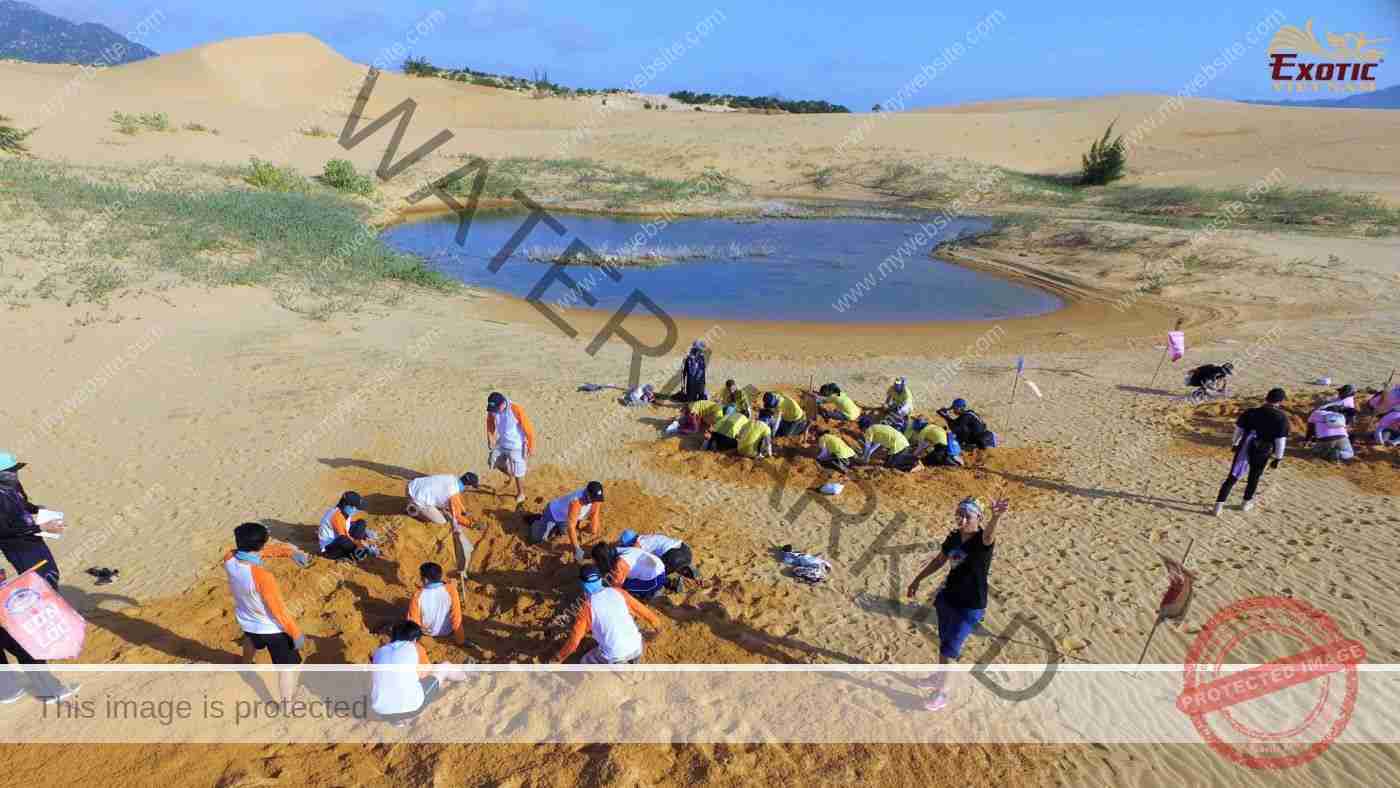
As a new hotspot near Phan Rang, Mui Dinh sand dunes provide a great opportunity to admire the wild beauty with endless sand dunes, multi-shaped rocky formations, and turquoise beaches. Or take part in the fun sport activities such as conquering sand dune on vehicles, sand boarding, kayaking, snorkeling, etc. Photo: Exotic Vietnam
Mui Dinh sand dunes
30km south of Phan Rang – Thap Cham city, Mui Dinh (Cap Pandaran) is well known for its Mui Dinh lighthouse, built by the French in 1904, located on Mount Hon Chong, 178m above sea level. The attraction of Mui Dinh is the huge rock mass that has been crushed by the harsh climate, you can even listen to the crackling sound of broken rock. The original great massif has turned into countless small blocks, all sizes, all shapes, piled on top of each other to create spectacular formations. In some places, it collapsed and threw large blocks of rock everywhere, some of which weighed hundreds of tons. Along the beach, the vast desert, covering up to 700ha, features crescent sand dunes and small oases filled with fresh water and green grass. In addion, accommodation in “Mongolian tents” and transportation by special vehicles on the sand dunes make Mui Dinh become an ideal place for team building activities.
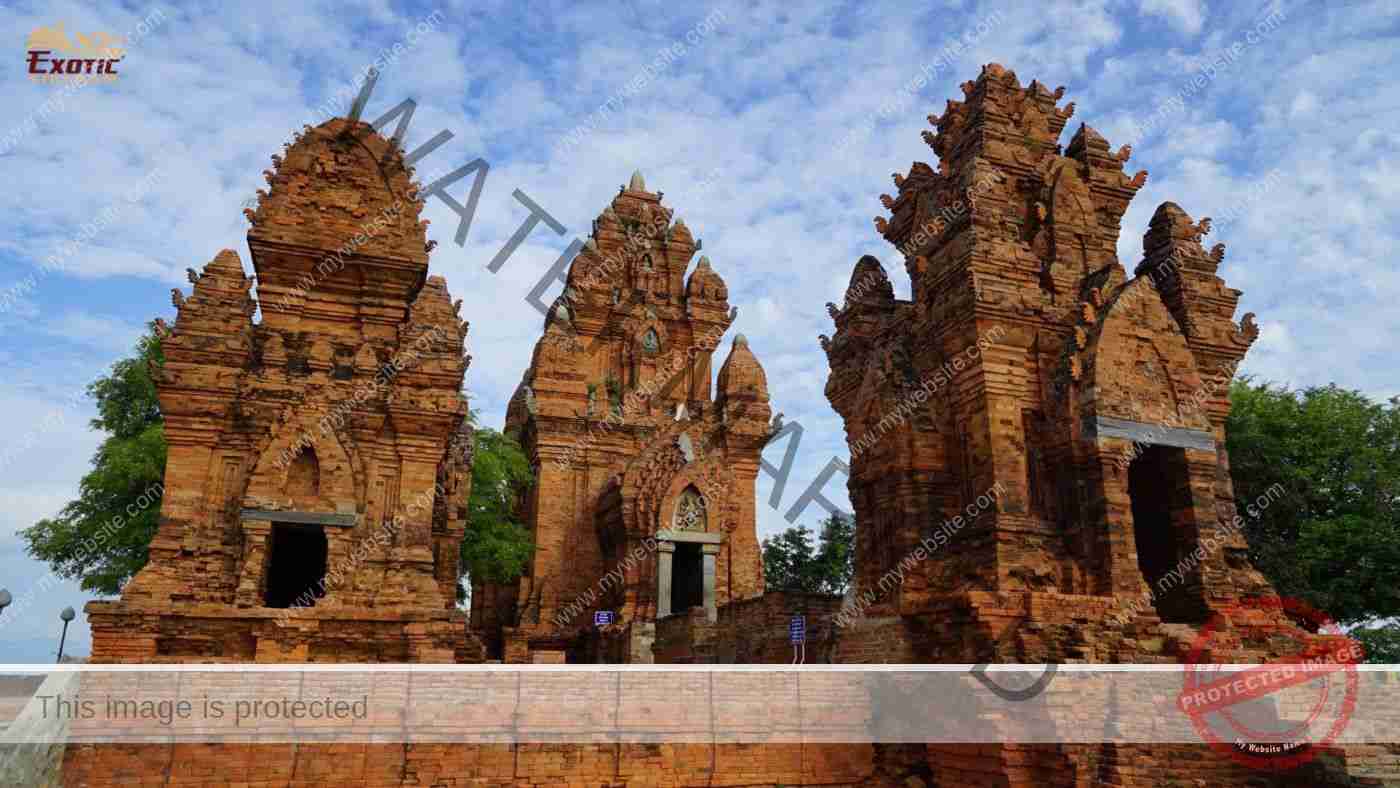
Worshiping King Po Klong Garai (1151-1205), the king who had many great merits in ruling the country, Po Klong Garai Towers are a cluster of the most majestic Cham towers left in Viet Nam. Cham people still keep their tradition of gathering at the tower on the first day of the seventh lunar month to commemorate him and in October to celebrate Kate festival, praying for a bountiful and prosperous harvest. Photo: Exotic Vietnam
Po Klong Garai Towers
Po Klong Garai towers are the most famous landmark of Phan Rang. Located 7km west of Phan Rang and near the Thap Cham railway station, the complex consists of four towers which are the remaining of a group of six towers constructed during the 13th century in the style of Hindu temples. From the top of the Cho’k Hala hill where the towers are located, visitors can see impressive views of the entire valley and surrounding countryside. The main tower was built to worship Po Klong Garai King, who, according to the legend, suffered from leprosy. Time could not have any affect on the Po Klong Garai towers, which has remained intact.
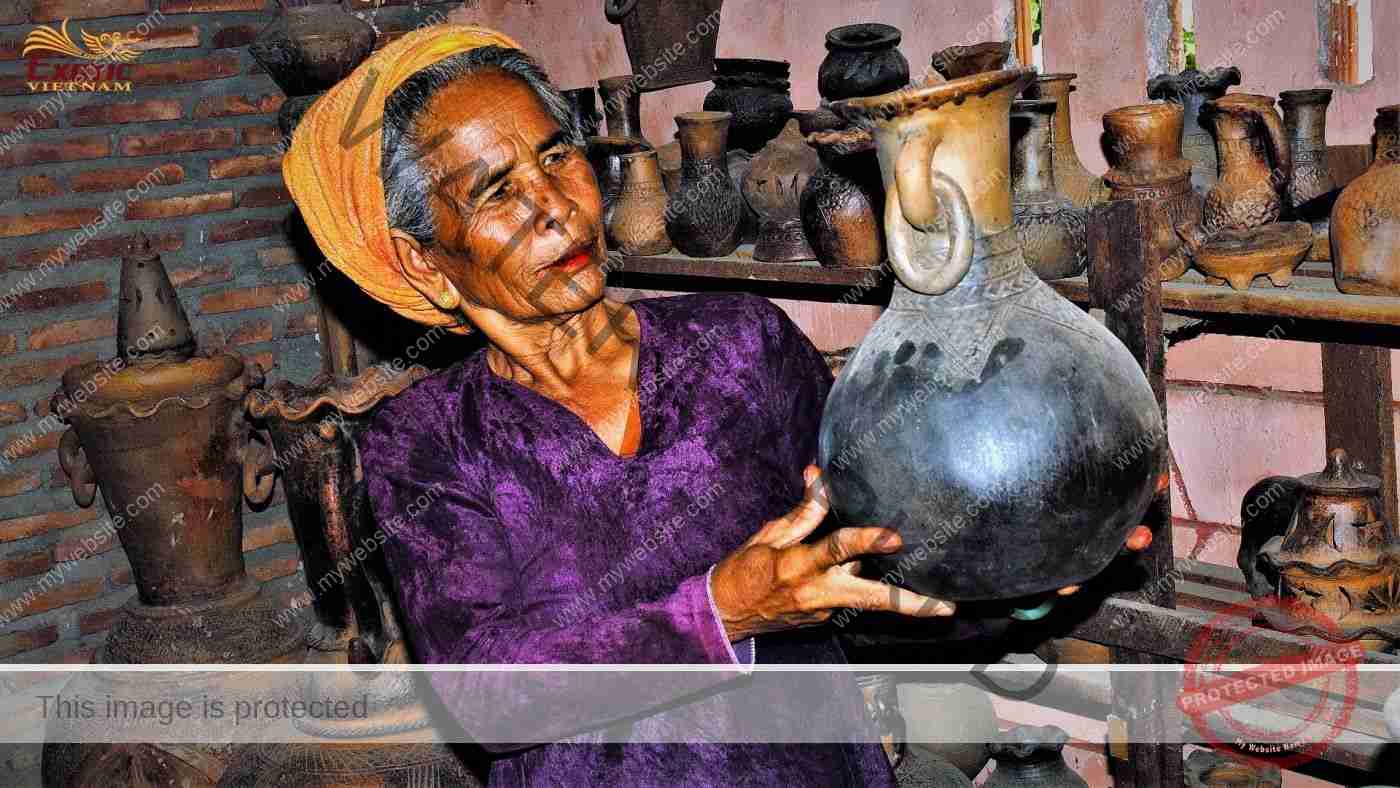
This is a traditional pottery village that still retains many of its centuries-old production techniques. Instead of using a turntable to model product, Bau Truc craftsmen put the wet clay on a stool, walk around with a stoop and shape. Decorate and polish it with bamboo sticks or seashells. Finally, they fired the pottery outdoors on flat ground to harden the clay, creating unique smoke-blackened traces of burning on terracotta. Photo: Exotic Vietnam
Bau Truc pottery village
Bau Truc pottery village of Cham ethnic minority, it is one or two oldest pottery villages in South East Asia. It is located about 10km south of Phan Rang. The small village is home to more than 400 families, of which 85% are in the traditional pottery business. The village is endowed with a special sort of clay. Local artisans say the clay, which contains 30 percent sand, helps increase baking temperatures more rapidly and prevents the items from cracking. In addition to items for daily use, such as pots and jars, the people of Bau Truc now produce a wide range of fine art articles, many of which have received international awards.
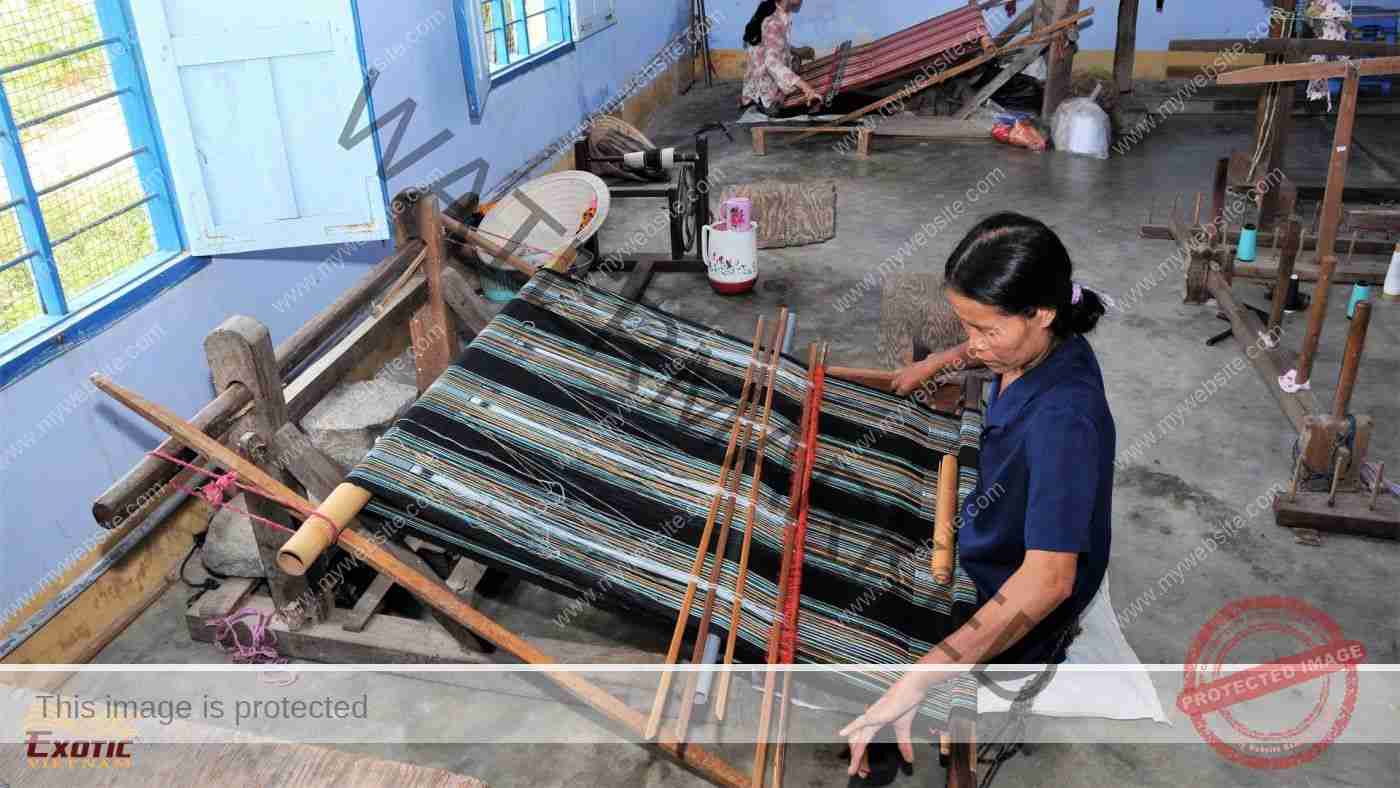
The most impressive thing about the village is that the products are mostly handmade, passed down from generation to generation. To create a brightly colored brocade, exuding the quintessence of traditional Cham culture, the women of My Nghiep village must have a keen sense of aesthetics and inspiration for a color combination. Photo: Exotic Vietnam
My Nghiep weaving village
My Nghiep village, 10km south of Phan Rang, has long been known for its traditional brocade of the Cham people. The small village is home to more than 480 families, of which 90% depend on weaving for their main source of income. To make a woven brocade product, artisans use a manual spinning device to produce rolls of thread with different colours, then put thread into a hook frame to mix colours and finally fit it into a loom for weaving. My Nghiep has also been known for sarong, called tukman, which was formerly used to make costumes for kings and queens. Sarong is considered a type of sacred fabric, thus it is never used for casual wear among Cham people. In recent years, My Nghiep’s woven products with a variety of designs have been marketed nationwide and abroad.
TEAM BUILDING IN PHAN THIET
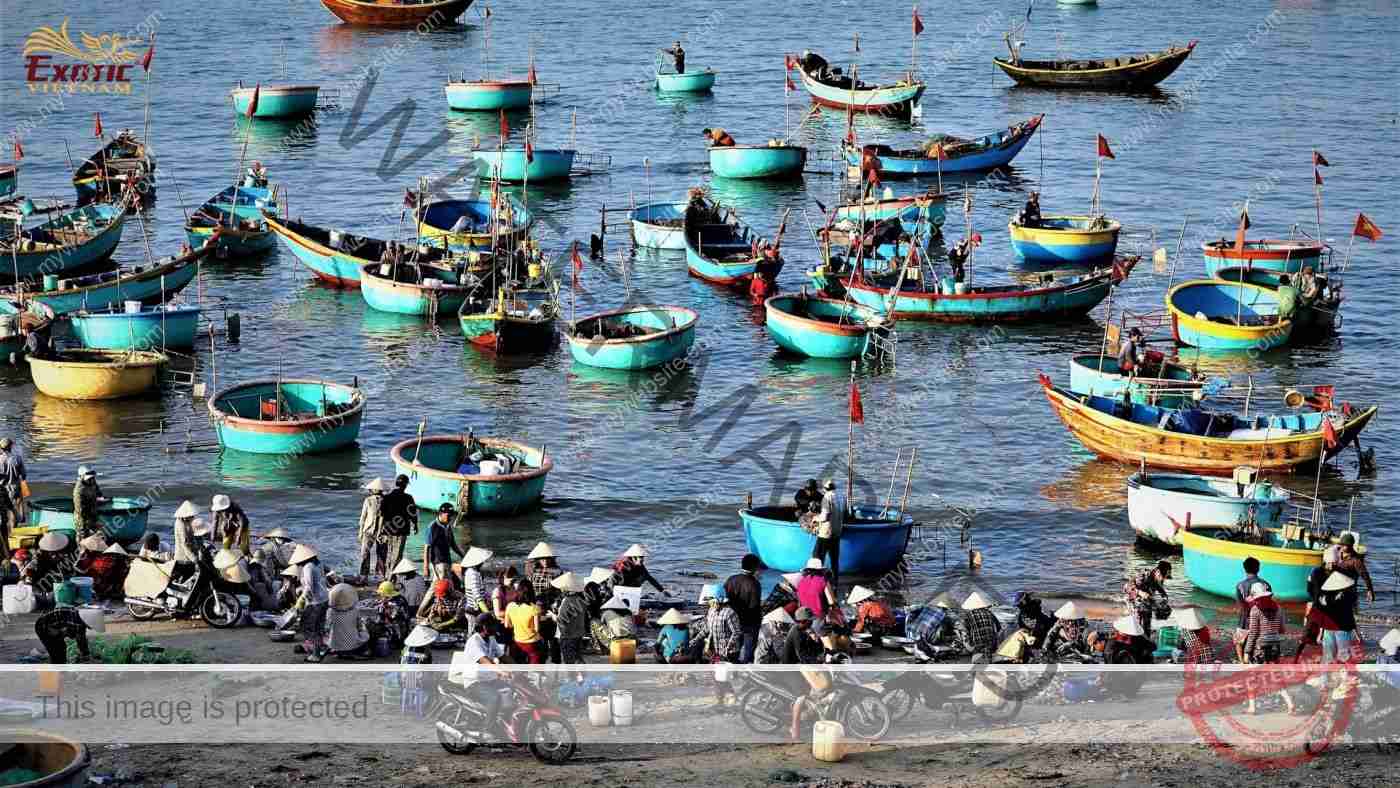
Known as a small coastal town with its traditional fish sauce, since 1995, Phan Thiet has rapidly transformed to become the leading beach resort hub in Viet Nam. Phan Thiet offers a hideaway to relieve stress and tension, and has a force of attraction for corporate team building activities thanks to its suitable travel distance, many choices of restaurants & accommodation, and diverse event spaces. Photo: Exotic Vietnam
Location: 200km north of HCM City (3½ hours by car), 173km from Da Lat via NR28 (3½ hours by car), 252km south of Nha Trang (5 hours by car).
Introduction: About 200km north of Ho Chi Minh City, Phan Thiet is formed by a long beachfront shaded with coconut trees, where many fishermen, fish sauce (nuoc mam) workshops and their fishing boats can be found. After the event of solar eclipse in 1995, Phan Thiet has become immensely popular with tourists thanks to the majestic beaches and nice seaside resorts. It now offers opportunities for aqua sports such as kite surfing, jet skiing, swimming, etc. or simply lazing in front of turquoise waters. Phan Thiet is also home to various places of interest: sand dunes, dragon fruit farms, Cham towers, the giant Reclining Buddha on Mt. Ta Cu, the ancient light house of Ke Ga.…
Highlights: Mui Ne sand dunes, White Lagoon, Cham vestiges, Lighthouse of Ke Ga, Phan Thiet Harbour, Mount Ta Cu, etc.
Facilities & services: camping sites, international standard resorts, hotels and restaurants.

Mui Ne was once famous for its enormous red and white sand dunes. These traditional fishing villages have quickly become a popular resort hub with countless projects springing up along the coast. The traditional life of the fishing community and the natural landscape suffer many negative impacts as a trade-off of hot development. However, there is still a bit of sand dunes like a quiet and peaceful corner to unwind, relax, have fun and escape from everyday life. Photo: Exotic Vietnam
Mui Ne dunes
Mui Ne is located 24km northeast of the town of Phan Thiet. It is a fishing village as well as a popular tourist spot in Binh Thuan Province. Mui Ne is famous for its enormous sand dunes. A lot of photographs have been taken here. The seasoned winds make dunes move forward and backward yearly which forms a variety of colourful sand formations. In addition, there is a small watercourse, called Suoi Tien, setting in stunning natural surroundings. Unspoiled by humans, it offers spectacular views of mountain water, majestic sand peaks coloured in red and white. Mui Ne is also an ideal place for relaxation & team building activity. Visitors can enjoy swimming in the sea or climbing to the sand dunes.

Surrounded by white sand dunes, White Lagoon consists of 2 beautiful lakes located side by side that are remnants of the sea before being invaded invaded by mobile sand dunes. Arriving at this attractive attraction, visitors are truly amazed by the high sand dunes with many fancy shapes reflecting on the calm lake surface under the bright sunlight, the pink lotus petals flickering behind the green leaves, painting a beautiful natural landscape. Photo: Exotic Vietnam
White Lagoon
This lake is located around 65km north east of Phan Thiet. The white sand dunes bordering it give the beach its name. The landscape has, however, transformed over the course of time and today greenery covers most of the white sand. Lining the edge of the lake are attractive, blooming lotus flowers.

Perched on a hilltop with expansive views of the sea and nearby Phan Thiet City, Po Shanu Tower consists of the three red brick towers with sandstone Linga and Yoni figures as the emblem of the Hindu god Shiva inside the main tower. There is also a small pagoda and the remains of an old building covering many of the military bunkers beneath. Photo: Exotic Vietnam
Cham vestiges
Built in the 8th century, a small Cham tower called Po Shanu is located about 6km from Phan Thiet on the way to Mui Ne. There are other three towers constructed in the Hoa Lai artistic style situated on a hill called the Prince Palace. Another Cham vestige is Cham Royal Family Collection. This is a collection of more than 100 precious objects once belonging to King Po Klong Moh Nai, the last Cham king ruling in the early 17th century.

Located on a small island 500m from the mainland, Ke Ga Lighthouse is a perfect place to get in touch with history while seeing dramatic views of sea, stone and sky. This is also an ideal team building playground with many survival challenges such as swimming across the sea, rafting, fishing, etc. Photo: Exotic Vietnam
Lighthouse of Ke Ga
45km south of Phan Thiet is the island of Ke Ga. This is where a French engineer constructed a lighthouse in the waning days of the 1800s. There were more and more French soldiers in the area, and a lighthouse was required to guarantee the safety of commercial and naval ships. Made of granite, the tower stands 65m tall and is the province’s only remaining example of European influence.
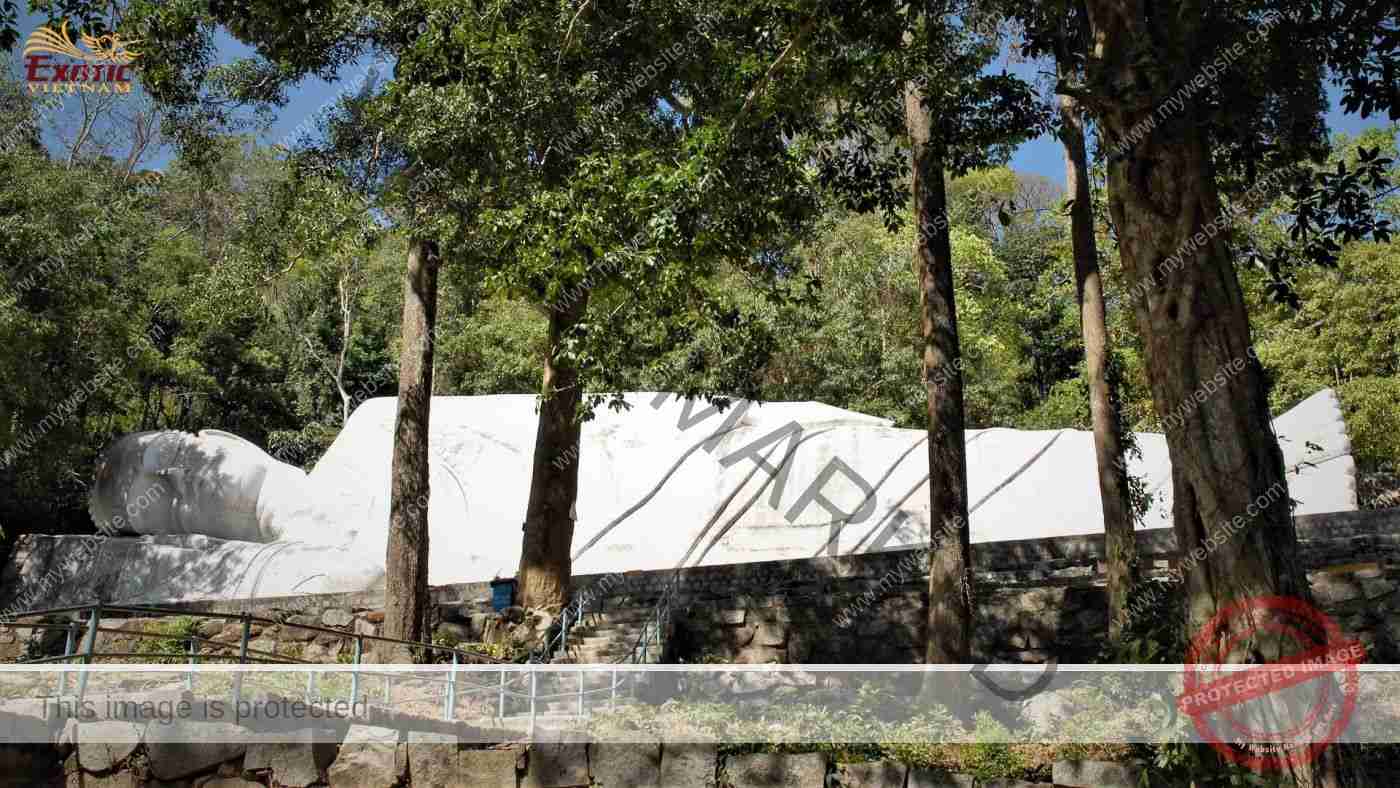
Ta Cu Mountain has lush tropical forests and a pagoda complex at an altitude of 400m. There are 2 ways to explore the mountain: hiking on steep trail under lush canopies for 2 hours or taking a cable car for 10 minutes. The big statue of the reclining Buddha in the forest is worth visiting. This mountain gives you a deep connection with both nature and self. Photo: Exotic Vietnam
Mount Ta Cu
Only 30km south of Phan Thiet on Mount Takou, you can find the elegant reclining Buddha statue, 10m high and 49m long. You can either hike up through the forest for two to three hours or take the 1.64-kilometer cable car system. Trekking offers walkers a chance to see birds, monkeys, wild flowers and other animals and plants up-close along the trail up to the peak.
TEAM BUILDING IN KON TUM
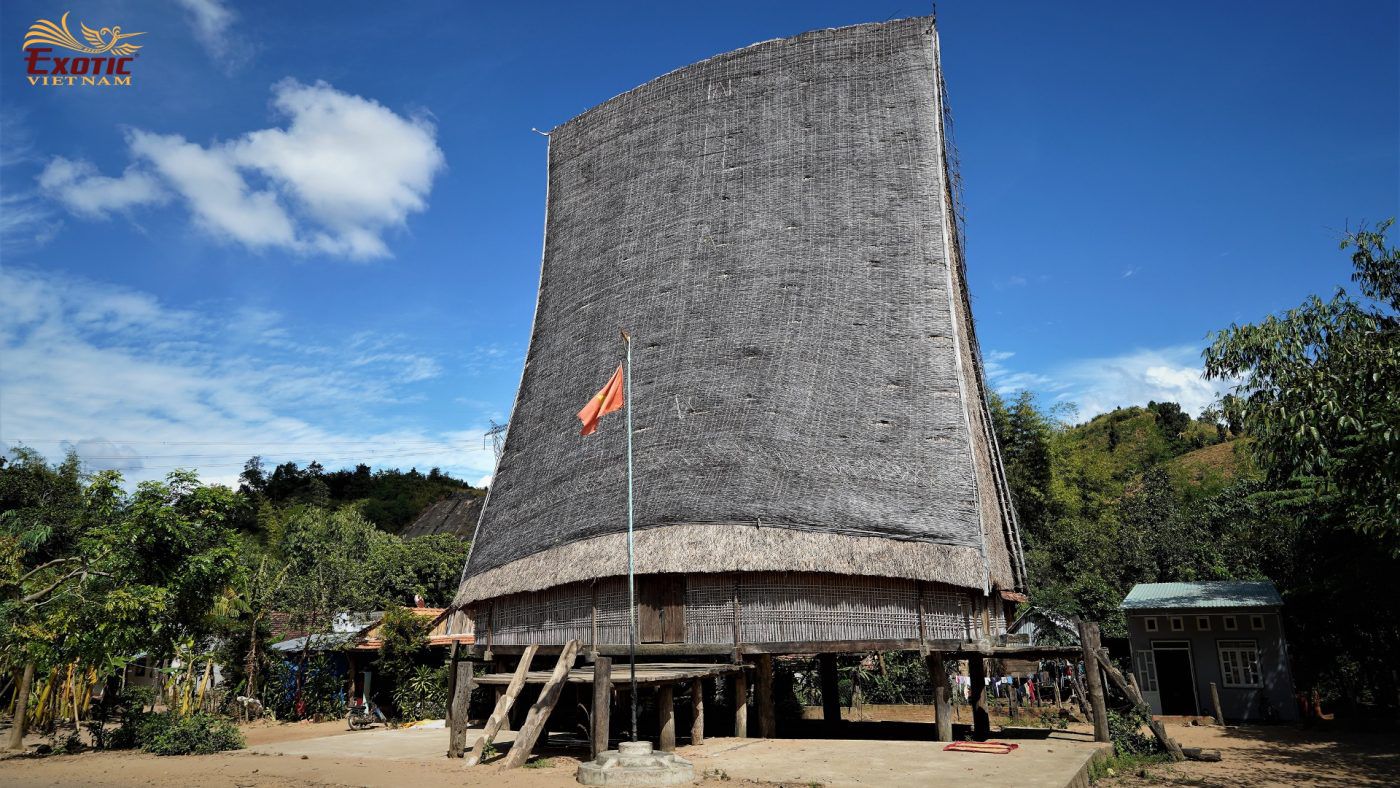
Located in a strategic position connecting the Central Highlands with Da Nang and Laos, Kon Tum lies in a mountainous region inhabited mainly by Bahnar, Sedang and J’rai peoples. Visiting Kon Tum, visitors are really surprised with communal houses, tomb statues, Ngoc Linh Mountain, Dak Bla River, gong and chime performance, and lots of famous war relics. Thankfully, everything is still intact. Photo: Exotic Vietnam
Location: 585km from HCMC (12 hours by car via NR14 or 1 hour by plane), 47km north of Pleiku (1 hour by car), 235km north of Buon Ma Thuot (5 hours by car) and 200km west of Quang Ngai (5 hours by car).
Introduction: Surrounded by high mountains, Kon Tum City is a wide valley at an altitude of 500m above sea level, built up by fertile alluvium of DakBla River. For a long time, this valley has been inhabited by indigenous Bahnar people with rich rice fields and villages. The locals call this place Kon Tum, which means “Lake Village” in Bahnar language, because of many natural ponds along the river. In the years 1841-1850, the French on their way to the highlands to missionary set up the first Christian base here. In 1893, the French colonial government established the Kon Tum administrative agency, managed by priests, and since then the name of Kon Tum has been officially used as a provincial administrative unit.
Not far from Kon Tum City in the north used to be the battlefields during the Viet Nam War where the mountain and the jungle along the Ho Chi Minh trail were a shield against American air attack. Many strategic peaks such as Chu Tan Kra (995m), Charlie (1015m), Delta (1049m), Chu Mom Ray (1780m), etc. were the intense and bloody battles that heavily damaged to both sides.
So far, Kon Tum has fortunately not been “occupied” yet by tourism industry’s giants with many projects causing negative impacts on the environment. Nature and indigenous culture here are still intact. Prominent cultural heritages of Bahnar, J’rai and Sedang groups such as communal houses and tomb statues are always handed down from generation to generation. The presence of the French missionary at the early time also left many valuable Christian architectural works to become must-see attractions in Kon Tum. The suburbs of the city are really the paradise to develop the unlimited plantations of rubber, coffee, tea, pepper as well as to preserve the primeval tropical forests.
A trip to visit ethnic villages around the city follows the scenario of The Amazing Race, or participating in trekking through the forest, dug-out canoeing along the DakBla river to the villages in the journey of Treasure Hunt, enjoying gong performances and tasting local dishes are a long-lasting experience. This is also an ideal place for a combination of team building activities and corporate CSR efforts such as raising employees’ awareness about the community and the environment. This is an opportunity to give back to disadvantaged people at ethnic villages. Exotic Vietnam, a dedicated companion, always works with businesses to organize effective events.
Highlights: The Wooden Cathedral, Kon Tum Monastery, Kon Ktu hill tribe village, Plei Phun hill tribe village, etc.
Facilities & services: trekking through jungle, white water rafting on untamed river, hill tribe village stay, tourist class hotels and restaurants.
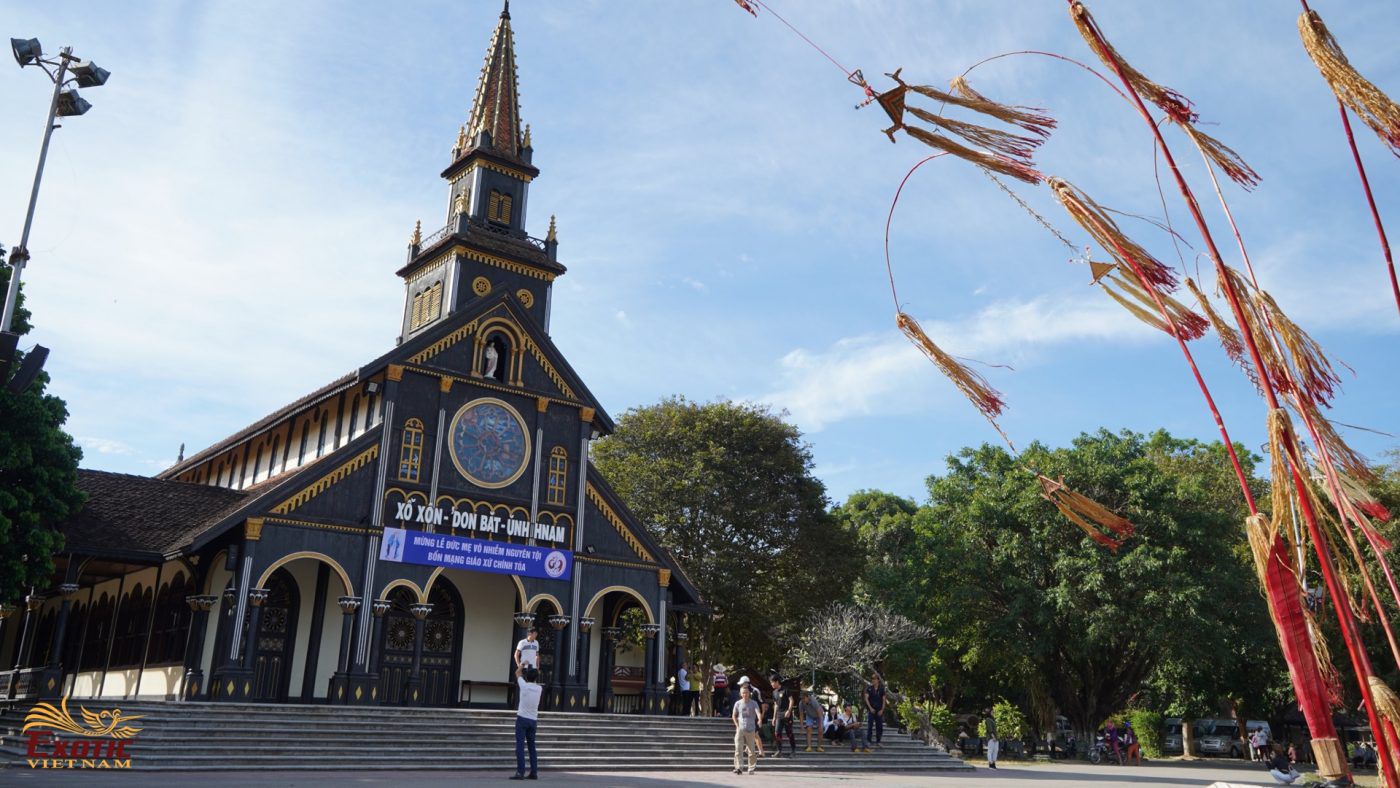
With its soaring spire, arched classical façade, and stained-glass windows, Kon Tum Wooden Cathedral is also characterized by the walls & ceilings made of soil mixed with straw, instead of using lime or cement plaster. Despite its age of over 100 years, this church built from hardwood is very well kept and captivates viewers by its unique architecture made up from a harmonious combination of Western church and stilt house of the Bahnar people. Photo: Exotic Vietnam
Wooden cathedral
The cathedral was built from 1913 to 1918 by a French priest named Guise Decrouille. All the materials were high-quality wood as rosewood and ca chit, a valuable wood once growing in abundance across the Central Highlands but rather rare these days.
The church’s architecture combines Roman and Gothic arches and features of Viet Nam’s Central Highlands styles. The whole structure stands one meter above the ground on wooden pillars like many hill tribes’ houses and communal houses. The church’s inside was also decorated in the Central Highlands style to make it suitable to the traditional culture of the people in the region. Some typical features of Bahnar tribe can be seen in the front yard of the cathedral such as communal house, ritual pole, grave statues, etc. The statues of Jesus and the Virgin Mary here are also carved directly from wood as well.
There is also an orphanage, named To Am Vinh Son 1, which is just a few steps behind. Hundreds of ethnic orphans from infants to 12-year-olds have been raised by nuns here. A cultural show performed by hill-tribe children does not provide plenty of entertainment but is a way you can share love and attention.
Thanks to its incredible designs, the Cathedral of Kon Tum – or the Wooden Cathedral is a massively popular check-in spot no visitor should miss out on. Come here to gawk at the architecture and bring home awesome shots.
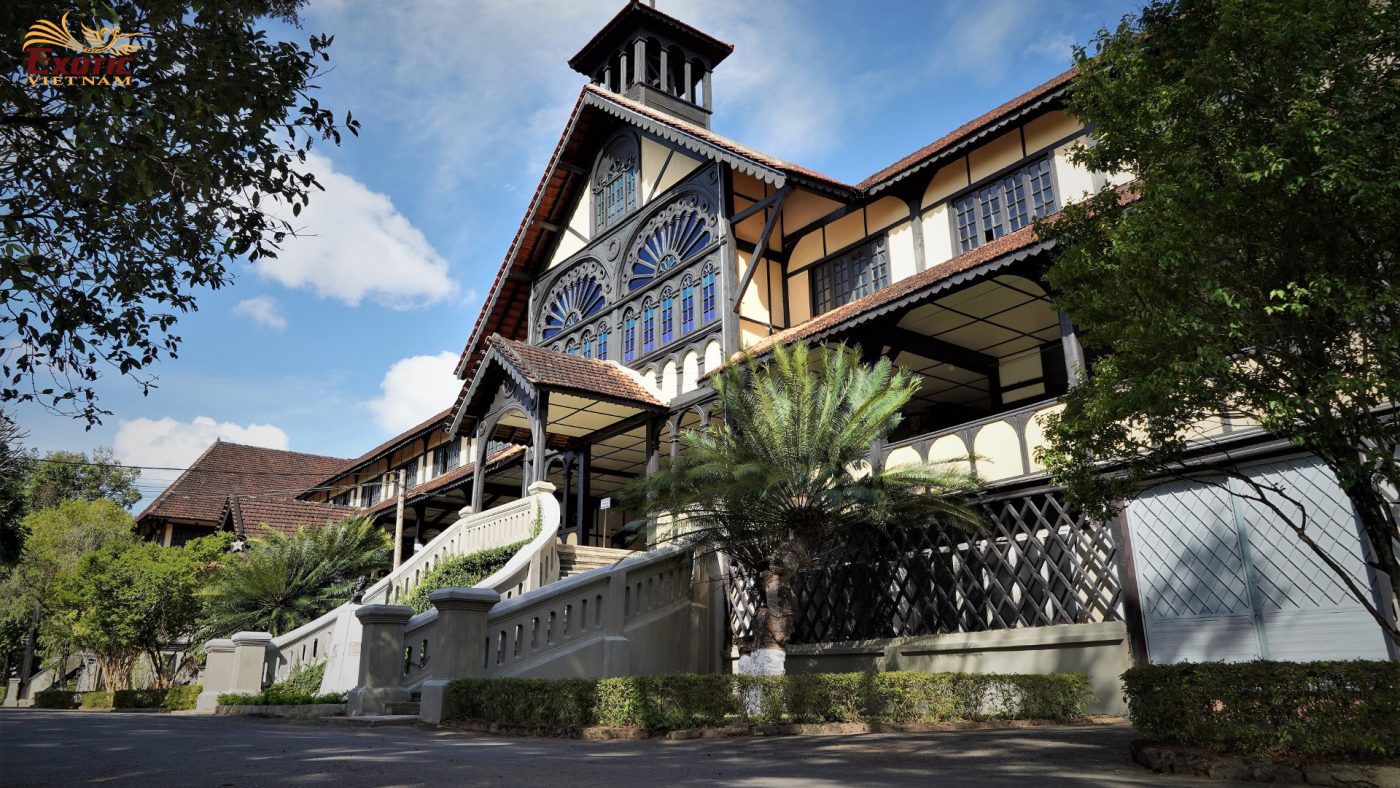
Apart from its impressive wooden architecture, Kontum Monastery is a much-loved landmark in Kon Tum for other reason: it’s a window into the past to learn about the hard journey of Christian missionaries to the Central Highlands and the indigenous culture of the Bahnar people. Photo: Exotic Vietnam
Kontum Monastery
Built from 1935 to 1938 in a 5-ha area, the Kontum Monastery was made of wood. The architecture was a mixture of Bahnar stilt-houses and European-style cathedral. The building is 100m long and has 3 floors. It is a school of bishops and priests. Inside the monastery, there is an exhibition place of Bahnar culture, one of indigenous ethnic groups making up the majority in Kon Tum. Visitors can find several wooden statues (20cm high) demonstrating daily activities of Bahnar people such as farming, drinking wine, gong show or “grave abandoning” ceremony.
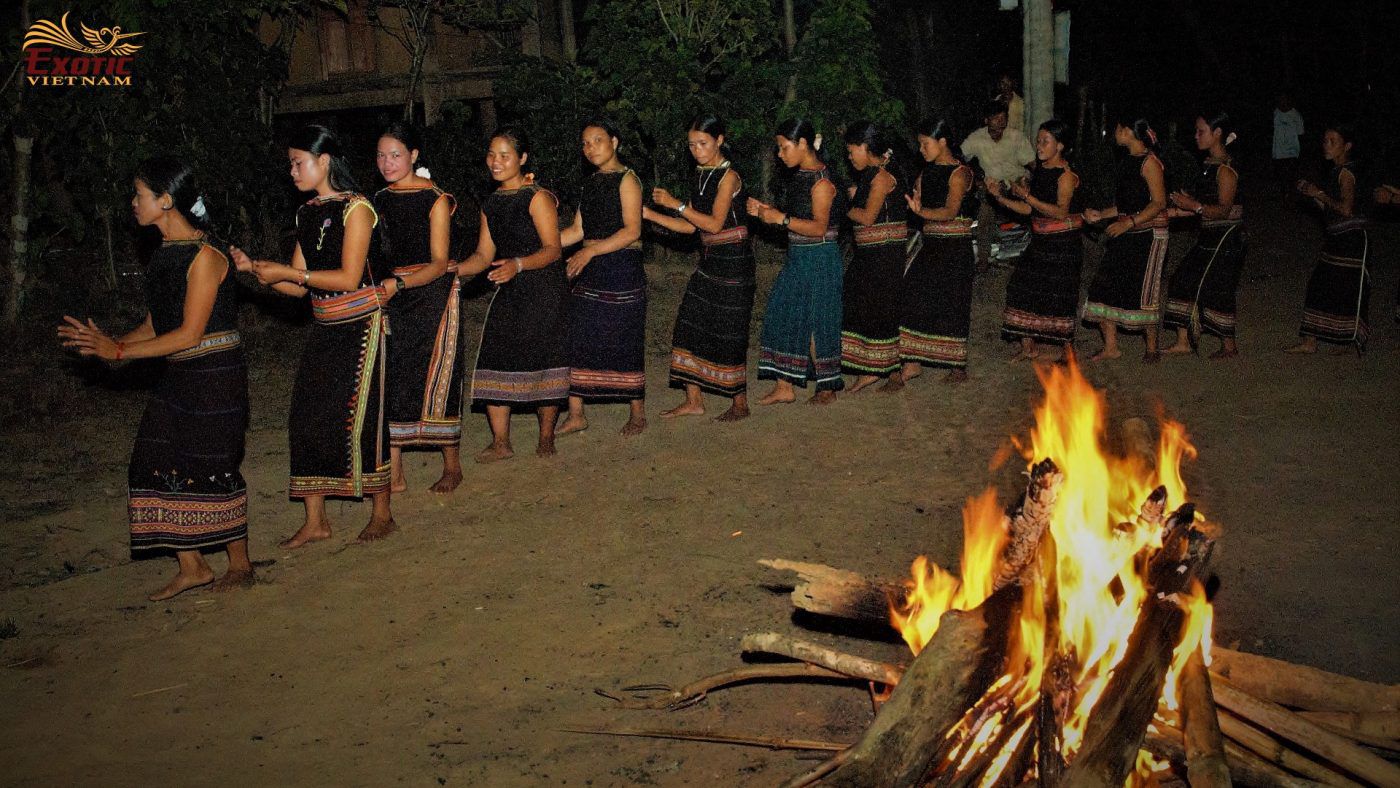
Set foot on the Central Highlands, to find the most impressive gong act, the most wonderful communal house – not only because of the villagers’ inherited experiences over centuries but also its great surroundings, the most breathtaking river sands for flocking and having fun, you must come to Kon Ktu village. That’s why many tourists call it a “5-star village”. Photo: Exotic Vietnam
Kon Ktu hill tribe village
Most Bahnar villages are located near rivers surrounded by forests and mountains. However, only a few of these villages still keep traditional characters such as Kon Ktu village.
The village is lying on the Dakbla riverside, 8km from Kon Tum. There are about 300 villagers of 60 families at the village. They earn their living mainly by farming such as rice, corn, sweet potato, cassava, etc., some fishing in the river. Right in the middle of the village, a soaring communal house that is considered the most beautiful in the Central Highlands is still used for meetings, parties, or as a place to welcome tourists, visitors can stay overnight in the communal house and enjoy Bahnar-style gong dances and performances.

Belonging to Gia Lai Province, but Plei Phun village is easy to access after landing at Pleiku Airport and traveling to Kon Tum. Not only the daily life of J’rai people, the most attractive focus here is the incredibly ornate graveyard. Entering the world of countless mossy wooden statues of all shapes and sizes at abandoned tombs, it makes people feel like they are lost in a place where the boundary between the worlds of the living and the dead became blurred. It is a spiritual journey to experience real life. Photo: Exotic Vietnam
Plei Phun village
Plei Phun village or Ia M’nong village is a one of J’rai villages located halfway between Kon Tum and Plei Ku, on the way to Yali hydroelectric plant. One of the interesting things to see here is how villagers take water from the hillside with bamboo pipes. Then visitors can come to see the communal house in the center of the village a where villagers gather in special occasions. At the end of the village there is a cemetery with wooden grave statues which are made to serve the dead.
What’s the grave statue? The dead’s relatives chop wood from the forest to make the statues. Those statues will be used on the day of “grave abandoning” ceremony. After the ceremony, all the ties among the dead and their relatives will be cut off and no more visits to the dead ’s tomb. The people here believe this would bring a new life to the deceased. The grave statues are carved according to 3 subjects: metempsychosis (such as statues of a pregnant woman, an embryo, a couple copulating, etc.), Dead’s slavers (such as statues of dancers, drummers, etc.) and other symbols (such as statues of soldiers, tanks, animals, etc.).
The village attracts many visitors who come to see the activities of not only the living, but also the world of the dead, that’s the grave statue.
TEAM BUILDING IN BUON MA THUOT
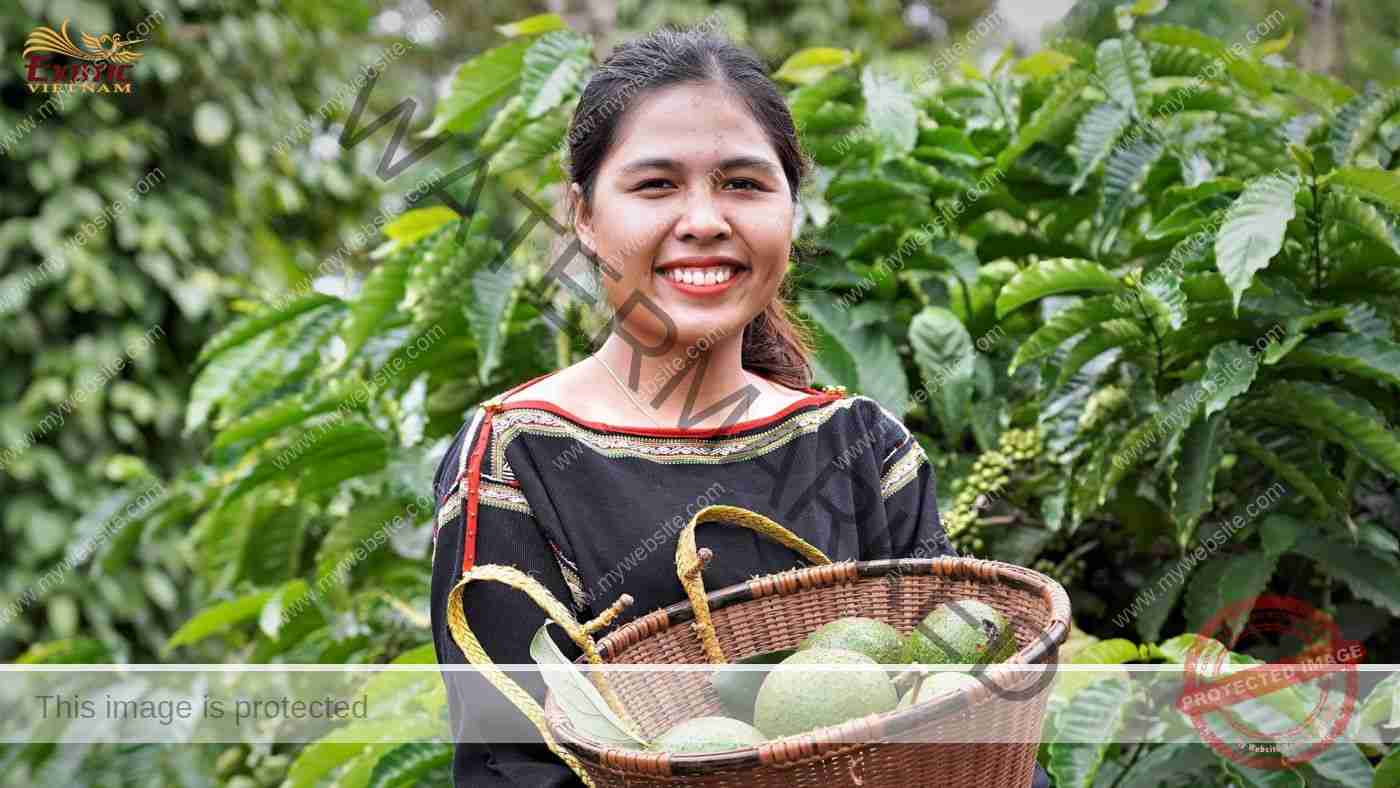
Buon Ma Thuot used to be known as a fierce battlefield with the opening battle of the campaign to end the war in Viet Nam in March 1975. The painful past is far away, the typical image of this city now features Edeh villages with traditional longhouses and coffee farms on gently undulating basalt terrain. Visiting Buon Ma Thuot you can’t miss the villages of the Edeh, Mnong, and trekking through the forest in Yokdon National Park to immerse yourself in the amazing natural landscape. Photo: Exotic Vietnam
Location: 363km from HCM City (55 minutes by plane or 7 hours by car), 182km from Nha Trang (3½ hours by car), 190km from Pleiku (3½ hours by car).
Introduction: Located at an altitude of 500m, Buon Ma Thuot is the capital of Dak Lak province and also the largest city in the Central Highlands. It is home to several intriguing and untouched minority villages. Ethnic people from the Mnong and Edeh tribes live on the shores of Lake Lak, a large natural lake formed by converging rivers and streams. Travelers can visit the villages by dugout canoe or fun trek through tropical rain forests. This area is also famous for some of the best aromatic coffee in Viet Nam.
Highlights: Dak Lak Museum of Ethnology, World Coffee Museum, Yokdon National Park, Buon Don elephant-training village, Lake Lak, Waterfalls (Dray Sap, Dray Nur, Gia Long).
Facilities & services: dugout ride, trekking, gong show, accommodation at hill tribe villages, international standard hotels and restaurants.
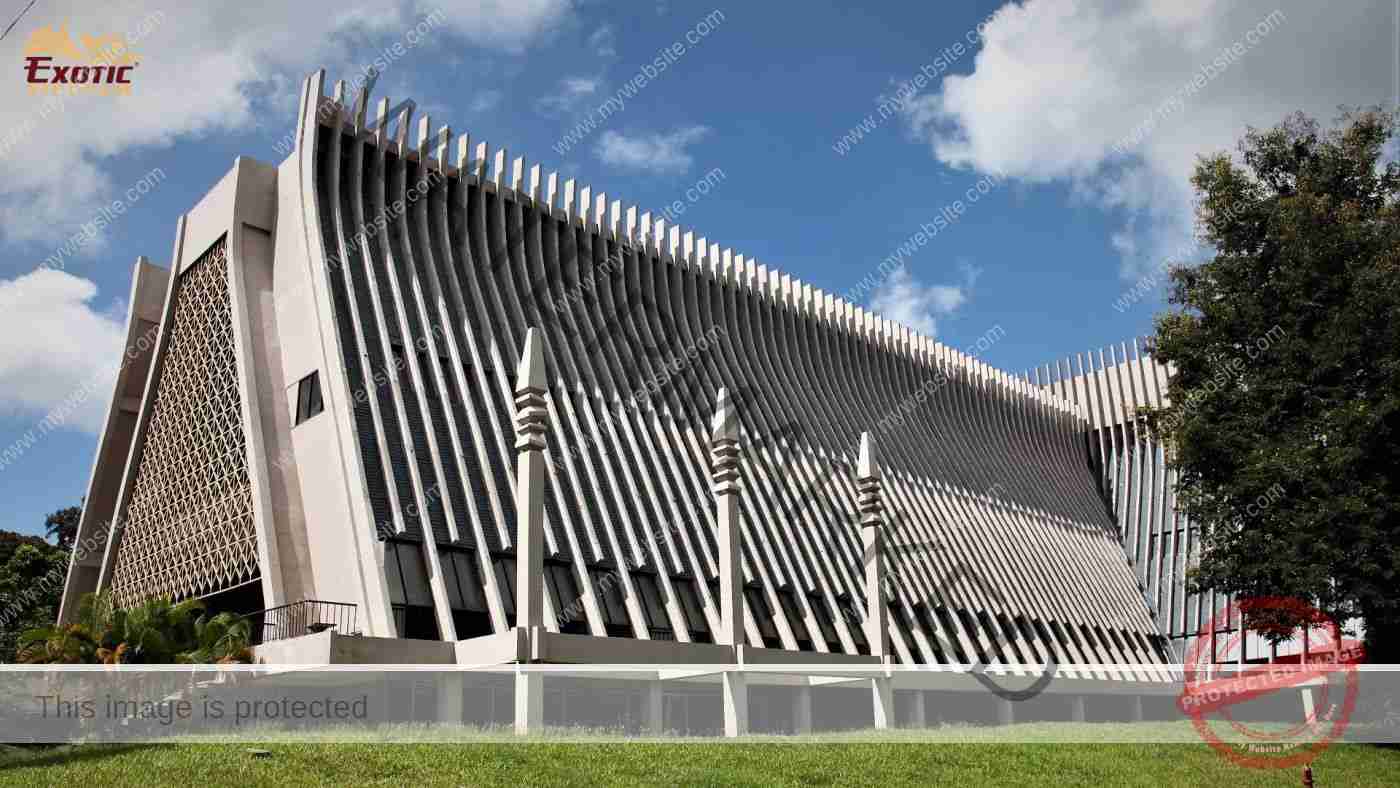
Surrounded by a shady garden on the grounds of King Bao Dai’s Palace, Dak Lak Museum of Ethnology displays various objects representing cultural values of the Ede, M’Nong and Jarai people. This is an interesting spot that helps visitors learn everything about the life and culture of ethnic minorities in the Dak Lak Plateau. Photo: Exotic Vietnam
Dak Lak Museum of Ethnology
Built in 2008, the museum has approximately 1,000 artifacts and images, It has three main sections featuring three different themes: the revolutionary traditions, natural features, and cultural characteristics of the ethnic minorities of the Central Highlands. It is a nice museum with artifacts and detailed information to know more about the local tribes of Edeh and M’nong and other hill tribes immigrating from Northern Mountains. The cultural space displays 520 objects such as models of stilt house, traditional costumes, production tools, statues at tomb houses, and collections of wine jars, bamboo backpacks, and gourds.

Through exhibits and many opportunities for hands-on experience, the World Coffee Museum helps visitors learn about the history and culture of coffee in the world and in Viet Nam, as well as admire a unique architectural work imbued with the quintessence of the Central Highlands. Photo: Internet
World Coffee Museum
Opened in late 2018, built in the Edeh ethnic long house architecture, the museum consists of 05 curving long house, with the length from 60 to 70m and the roof height at 16m. Covering an area of 45ha, the museum exhibits more than 10,000 artifacts showing the history of coffee which has been brought from Germany’s Jens Burg Museum. Except the exhibition space, the museum also has a library of light, and places for coffee drinks and workshops. Interactive spaces allow visitors to experience the coffee culture through all five senses (sound, sight, taste, smell, and touch).
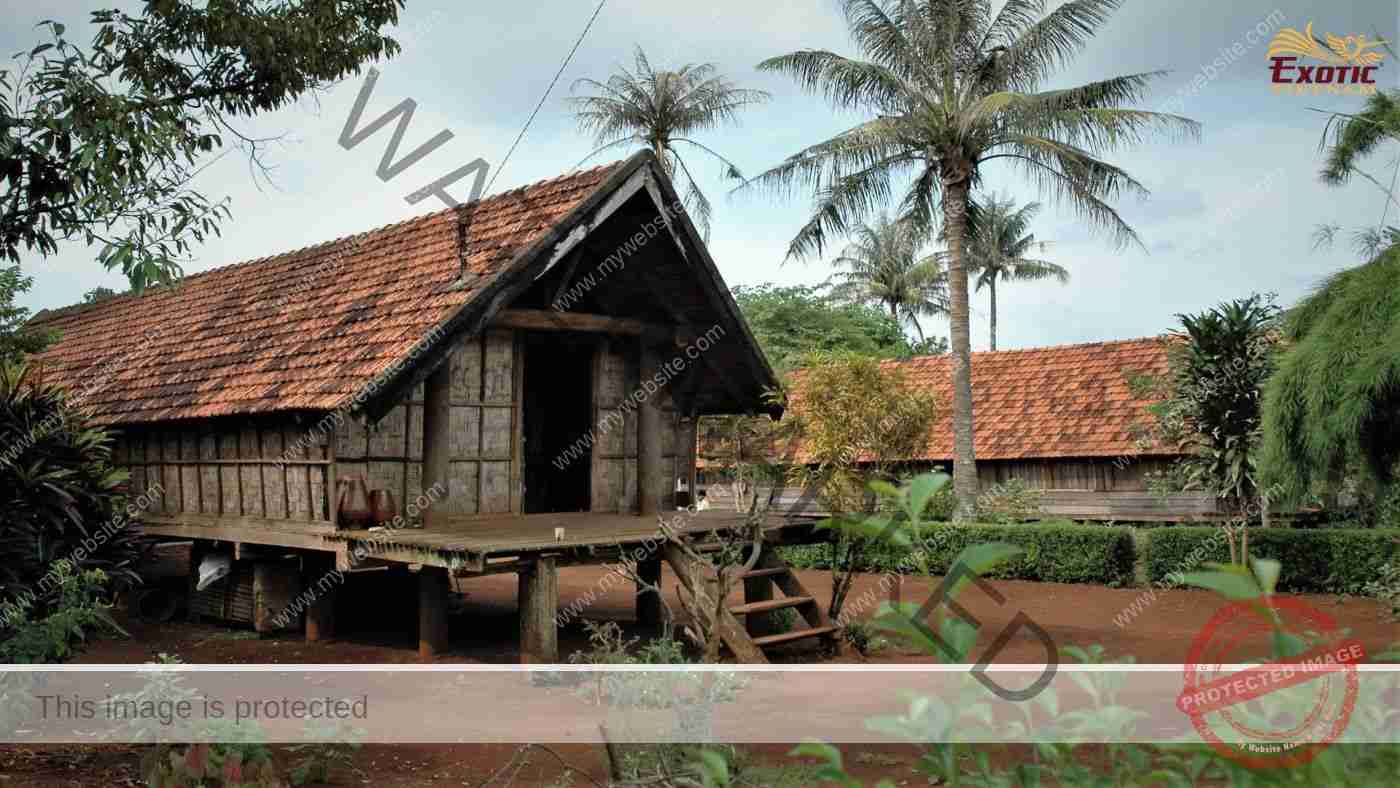
A Co Thon, or Ako Dhong means “watershed” as the Edeh people call it. Because A Co Thon village is the starting point of many streams, especially Ea Nuol, the largest stream in Buon Ma Thuot. A Co Thon village develops according to the harmonious combination of modern life and traditional values. The village still retains more than 30 traditional long houses, as a typical cultural feature of the Edeh people, where many generations live in a matriarchal family. Photo: Exotic Vietnam
Ako Dhong Village
Only 2km from the center of Buon Ma Thuot city, Ako Dhong is a village of the Edeh people, established in 1956, by the reclamation of Ama H’Rin at the upstream area of 6 streams: Ea Giang, Ea Dung, Ea Ding, Ea Pii, Thun M’nung and Ea Nuol.
The village still retains the traditional architecture of more than 30 long houses. The long house is divided into two parts: the front half is called “Gah”, which is the place to receive guests, the common living space of the family, containing items such as: master chair, guest chair, master kitchen, Kpan bench, gongs. The back half is “Ok” which is the residence of the couples and the common kitchen. The stairs leading up to the long house are decorated with two round mushrooms symbolizing the two women’s breasts, with the meaning of praising the permanence of lineage, representing the power of women in the matriarchy in the Edeh community
Along with upstream water pollution, the architectural space of Ako Dhong village is now being destroyed due to the expansion of roads, the construction of many new concrete houses, and the blooming of tourist areas with crowded services of food and accommodation. The beautiful picture of Edeh village is gradually disappear.

As a prosperous trading center in Indochina, the Lao people together with the indigenous Mnong people joined hands to build Buon Don on the banks of the Sre Pok River many centuries ago. Visitors come here to learn about the tradition of hunting and taming wild elephants in the Central Highlands. Photo: Internet
Buon Don elephant-training village
About 42km northwest of Buon Ma Thuot, closed to the Cambodian border, Buon Don is a M’nong village by the Srepok River where Lao is the language in daily communication. It is well-known as the native land of elephant hunters and trainers throughout Southeast Asia. People still tell each other about the elephant king Khun Yu Nop, a talented chief who has a knack for hunting and taming wild elephants, who has been instrumental in developing elephant raising in Buon Don. Now in Buon Don the customs and the cultural activities are originated from cultures of many tribes (M’nong, Edeh, Viet, Laos). Coming to Buon Don, visitors can trek through forests, villages and paddy fields, learn about elephant catching and taming activities and challenge on bamboo swing bridges on the Srepok River.
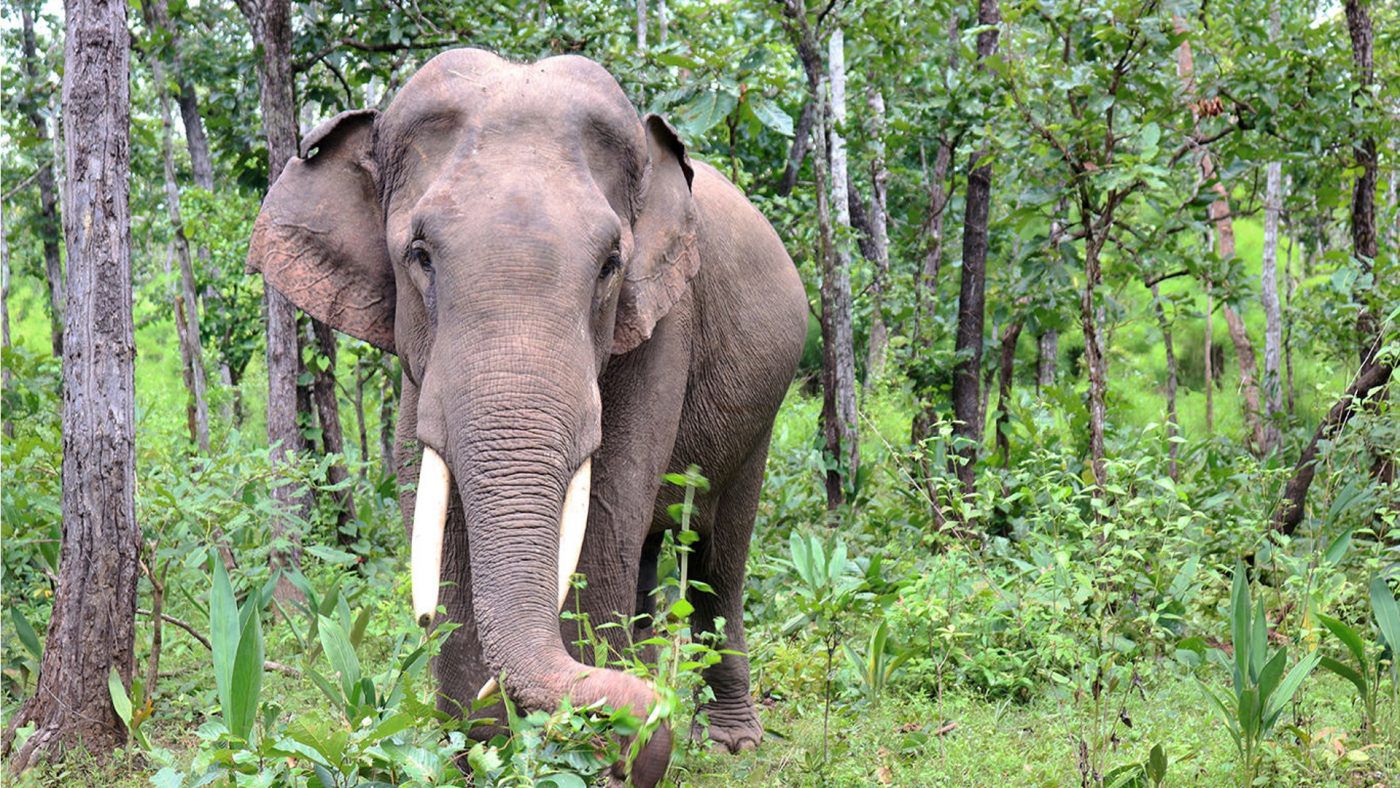
Yokdon National Park is home to many rare and precious wildlife. Elephant, buffalo and gaur are well preserved in the wild. Visitors have an opportunity to explore both the wonderful nature and traditional culture of the Mnong people here. Photo: Internet
Yok Don National Park
About 42km northwest of Buon Ma Thuot, Yok Don National Park was established in 1991. With an area of 115,545 hectares, the park is the largest park in Viet Nam. Receiving little annual rainfall, the Dipterocarp forest ecosystem is characterized by open canopies and abundant low grasslands, and almost complete defoliation in the dry season from November to April. The forest is the home of nearly 70 animal species including some endangered in Indochina as well as some worldwide endangered species. Nowadays, Yokdon has become the biggest reservation of wild elephants in Viet Nam. There are 17 ethnic groups have been living here. The locals are mostly M’nong. Visitors can drink the traditional wine from a communal jug at the same time through long straws and enjoy gong show performed by old and young villagers.
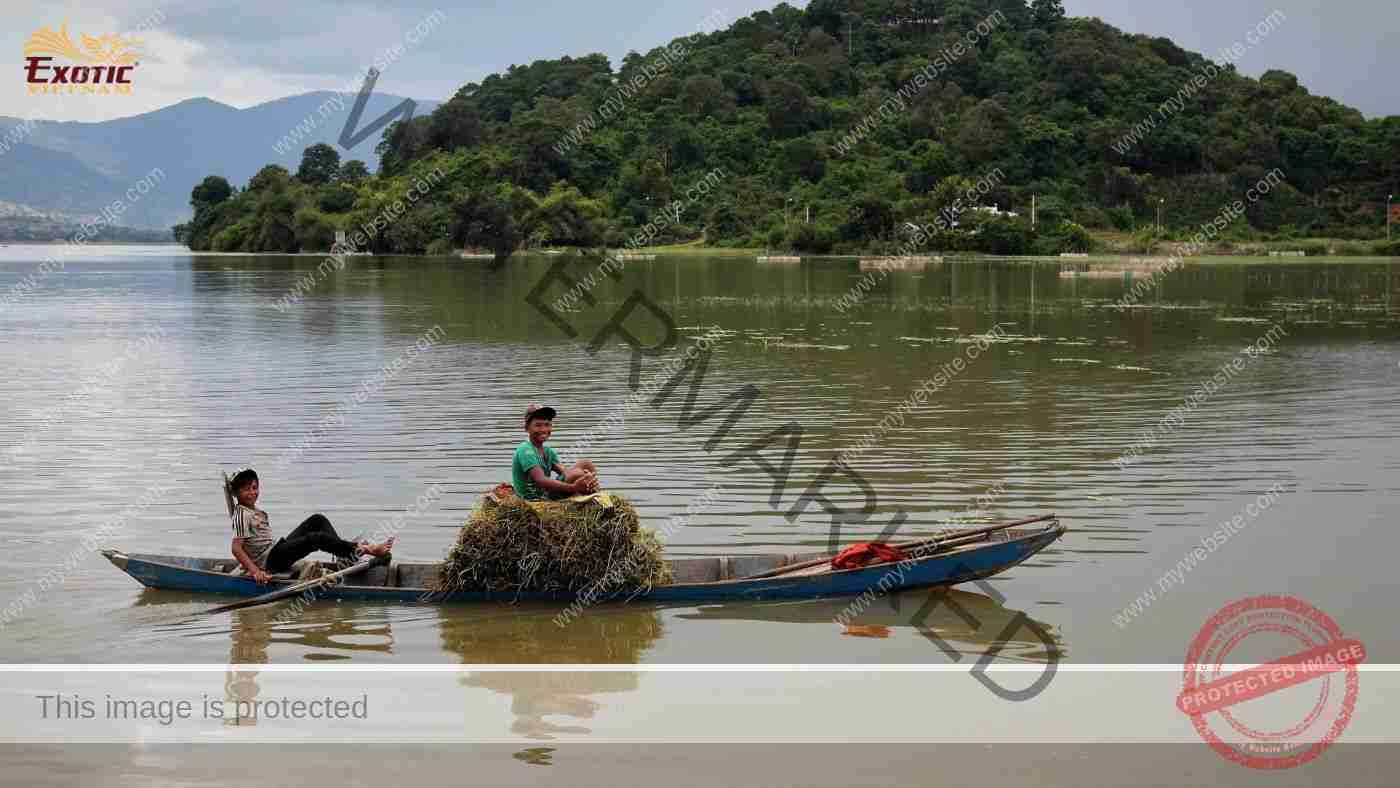
Surrounded by high mountains, Lak is a natural lake that receives water from the Krong Ana River. Not only providing water for the rice fields of the surrounding Mnong villages such as M’lieng, Jun, Lake Lak is also numerous habitats of fish, bird as well as a regulator of the climate. Mnong people live in a lot of the traditional long houses with thatched grass roofs, bamboo walls here. King Bao Dai, the last king of the Nguyen Dynasty, also built a guesthouse on the hill top by the lake. Photo: Exotic Vietnam
Lake Lak
About 50km south of Buon Ma Thuot, Lak is a 500-hectare natural lake fed by the Krong Ana River. The lake is surrounded by low mountains which make fantastic views. On the lakeside, a former palace owned by the last Nguyen King, Bao Dai, can be seen. Visitors can get a panoramic view of the valley when standing on the second-floor balcony of the palace. Most of M’nong villages (Yun, M’lieng, Le…) live around Lake Lak. M’nong villagers earn their living mainly by farming and fishing. Their culture is strongly influenced by Edeh’s. It is difficult to distinguish an Edeh from a M’nong if they don’t carry their traditional back-basket. M’nong back-basket is made of bamboo. Edeh back-basket is also made of bamboo but the bottom of the basket is formed by 4 rectangular pieces of wood. Highlights include a jungle trek, a dugout canoe cruise on the lake and a folk show of gong music & dance. An overnight stay in a local home can be arranged

Formed by a geological fault cutting into the thick basalt layer on the Sre Pok River, the cluster of 3 waterfalls Dray Sap, Dray Nur and Gia Long roared with white spray into the air, creating a blurry picture. If you are lucky enough, you will see the waterfall decorated with colorful rainbows. This is a perfect picture on the Dak Lak Plateau that has a great attraction for tourists. Photo: Internet
Waterfalls (Dray Sap, Dray Nur, Gia Long)
Along the Srepok river and near Buon Ma Thuot city, there are a chain of waterfalls such as Dray Sap, Gia Long, Dray Nur, Trinh Nu, Dray H’linh of which Dray Sap and Gia Long are the most beautiful waterfalls. Dray Sap waterfall hides itself in a primitive jungle, Dray Sap means “the fall of mist” in Edeh language. The 15m-high and 82m-wide waterfall is forming strong columns of water and white foamy clouds of spray. The echo of the waterfall can be heard from a long distance all year round. Gia Long Waterfall is named by King Bao Dai on a hunting trip to this area. This waterfall is little-known to tourists. Therefore, this site is mostly unexploited and the nearby forest is well-preserved.
TEAM BUILDING IN DA LAT

Once a sleepy French vacation town, full of ornate villas, majestic pine forests and surrounded hill tribe villages, Da Lat offers more than you think. You will feel excited, relieved and proud of yourself when you explore these treasures of history, nature and culture round Da Lat. However, you might be unaware of the other treasures that are hidden in the surrounding area, just a few kilometres away from the city. These are places that oftentimes are only known to locals, that’s why you need Exotic Vietnam. Photo: Exotic Vietnam
Location: 300km from HCM City (6 hours by car or 50 minutes by plane), 165km from Phan Thiet via NR28 (3 hours by car), 210km from Nha Trang (4 hours by car).
Introduction: Da Lat was “discovered” in 1893 by Dr. Alexandre Yersin and the city itself was established in 1912. Da Lat rapidly became popular with Europeans as a cool retreat from the sweltering heat of the coastal plains. This so-called city of love is built on a plateau some 1,500-meters above sea level, and enjoys the mild climate of an everlasting spring and marvelous landscape with waterfalls, lakes, springs, pine hills, and beautiful flowers in French built villas. One of the best ways to explore all Da Lat’s beauties, canyoning and abseling are the combination of sightseeing and plenty outdoor activities. The challenge gives you chances to discover charming scenery with waterfalls, hills, pine forest and other attractions. You will be fully equipped with high quality tools to get the achievement of excitement, courage and strength.
Highlights: French villas, Langbian Mountain, Municipal Flower Garden, Waterfalls, Bidoup – Nui Ba National Park, Madagui Forest Park
Facilities & services: golf courses, trekking through pine trees, international standard hotels and restaurants,.
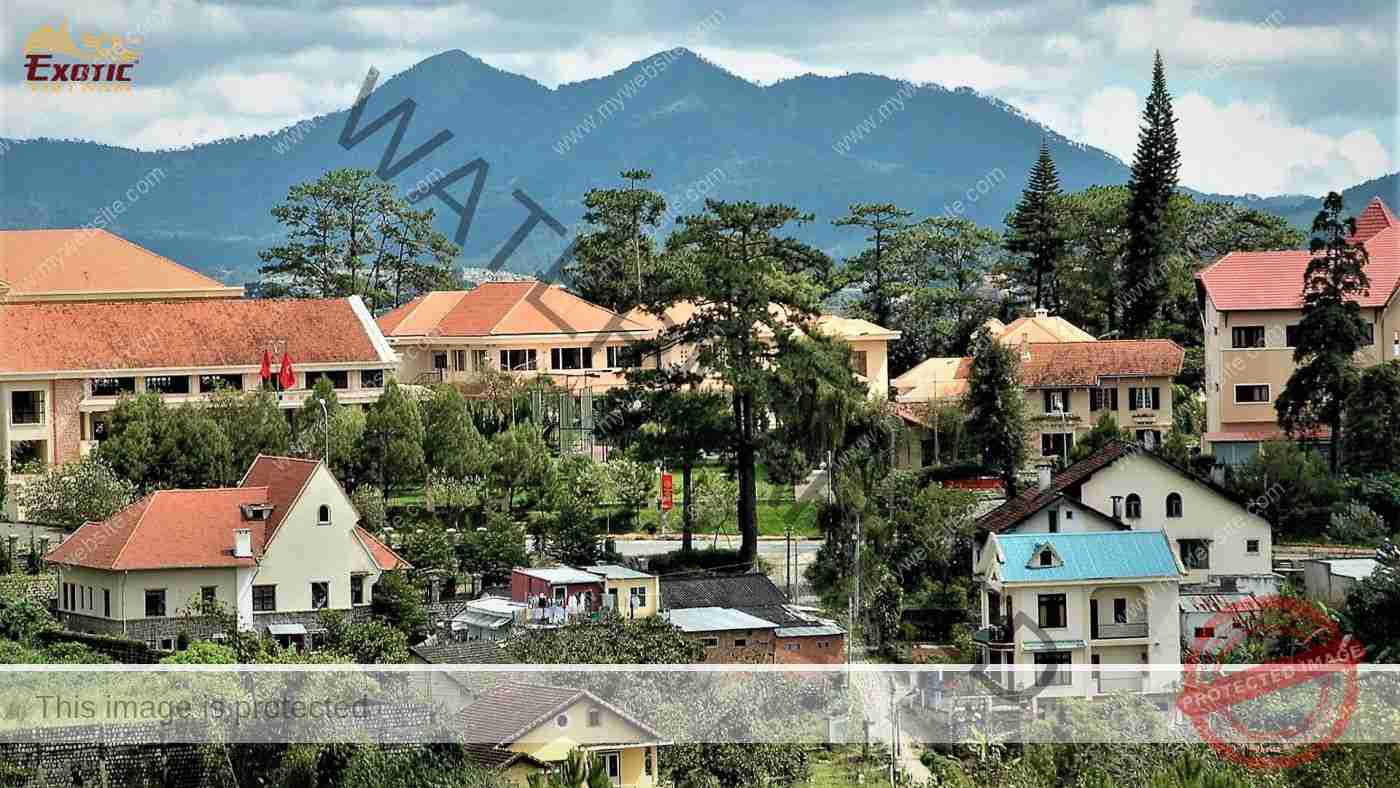
You can see ruined villas covered with moss or newly restored mansions with fragrant luxurious interiors, which is a mark of French architecture once in Da Lat. Visit these old buildings to feel how the French respects nature in urban planning and development in Da Lat. It’s really an architectural heritage in urgent need of conservation. Photo: Exotic Vietnam
French villas
Unlike the hill station retreats built by the French in the mountains of Sa Pa, Bach Ma, Tam Dao, … mostly were ruined during the war, French-style architecture in Da Lat is still intact after 1975.
With a view to limiting interference on natural terrain, the French designed the city with its wide reservoirs, winding streets, broad roundabouts, pretty flower gardens and many green patches of grass, wildflowers and pine trees. They have also built just enough density and scale of villas, Catholic churches, institutes and government buildings in harmony of nature landscape, climatic conditions and lifestyles in the plateau.
By 1945, Da Lat had over a thousand villas with classic designs, most of which were set up according to the local French architectural styles and used local materials such as bricks, tiles, wood, stone… Each villa has a spacious campus, forming a charming and distinctive whole. After 1975, many buildings were damaged due to being abandoned or misused.
Today, the city still preserves over 1,500 the ancient mansions. Especially, the roofs and chimney systems of the fireplace are very diverse and impressive with true appearance of France countryside. The charm of the ancient French villas in Da Lat reflected in the interior decoration is extremely delicate performing luxurious part of the middle class from the history.
A series of restored old villas in Da Lat allow visitors to experience how the French lived 100 years ago. However, this architectural heritage is in danger of being disrupted under the pressure of unplanned urban development and excessively planned projects that do not respect nature and the history of the current local government.

Considered to be the roof of the Langbian Plateau, Mount Langbian stands out with its legendary cloud-covered peak at an altitude of 2163m. Thanks to its lush pine forests, action-packed cliffs, idyllic K’ho villages at the base and the weather is all year cool and sometimes quite cold, Langbian Mountain offers a chance to discover many amazing attractions, enjoy gong dances and experience yourself through physical and mental challenges. Photo: Exotic Vietnam
Langbian Mountain
12km north of Da Lat, Langbian Mountain with five imposing peaks about 2000m above sea level is an ideal place for mountain climbing, jungle trekking or studying rare bird species. Two of them, as like as a couple of milky breasts, can be seen from Da Lat, which become a stunning background of almost typical Da Lat views. That’s the reason why it’s called Lady Mountain by the locals.
The mountain is home to hill tribe people where visitors can wander around their village and get insight into their daily life. The inhabitants belong to the Lat, Chil tribes as subgroups of K’ho. Traditionally, K’ho houses were built on stilts with floors and walls of raw planks or split bamboo and thatched roofs, a few of which are preserved today. They live mainly on crops, livestock, and handicrafts. Brocade woven in the village impresses with beautiful patterns and vivid color combinations. The sound of gongs is not only a way to communicate with the god and deities but also a pleasure to entertain people in the community as well as tourists.
A 3-4 hour trek or 4WD car cruise to Langbian Mountain is well worth it for the spectacular panorama of endless mountainous surroundings. Abseiling in Langbian is the challenge for those who have a strong heart to conquer the height. Enjoying the gong show, having fun with the village girls through traditional dances, tasting some fermented wine in earthen jars are interesting activities that will never be forgotten.
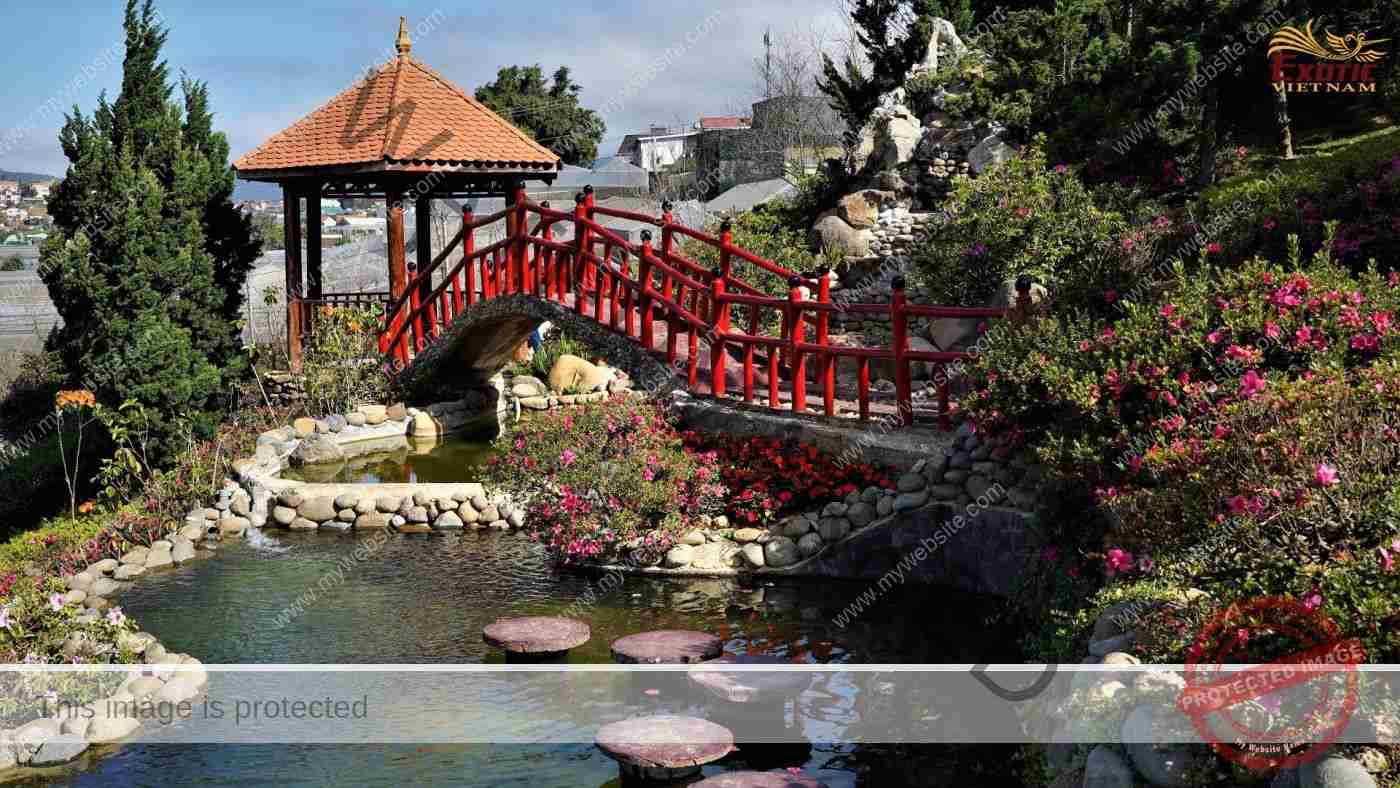
When the green areas in the city are gradually covered with concrete buildings, the City Garden is considered as a gem. Flowers of multiple shapes and colors bloomed throughout the year among the greenery draw a magnificent picture. This is a must-visit attraction for all visitors to Da Lat. Photo: Exotic Vietnam
Municipal Flower Garden
Covered an area of 7000 sq.m of perfectly manicured grounds, Municipal Flower garden is located on the northern side of Lake Xuan Huong, right in Da Lat’s city centre.
Established in 1966, the garden features more than 300 different kinds of flowers, many of which blossom all year round. It is considered a natural museum that houses a fine collection of native and exotic flowers, such as hydrangeas, fuchsias, orchids, roses, and more grown outdoors and in greenhouses. The best time to visit the park is in the morning throughout the year, especially during the rainy season to enjoy blooms flowering in the beautiful sunshine and avoid the showers after noon. Every 2 years, the gardens transform into one of the venues for the Spring Flower Fair and the Winter Flower Festival.
The garden offers a very wonderful environment and magical moments to take snapshots of vibrantly colorful close-ups of flowers. Here’s where you travel to feel a sense of purity and diversity of the natural world.
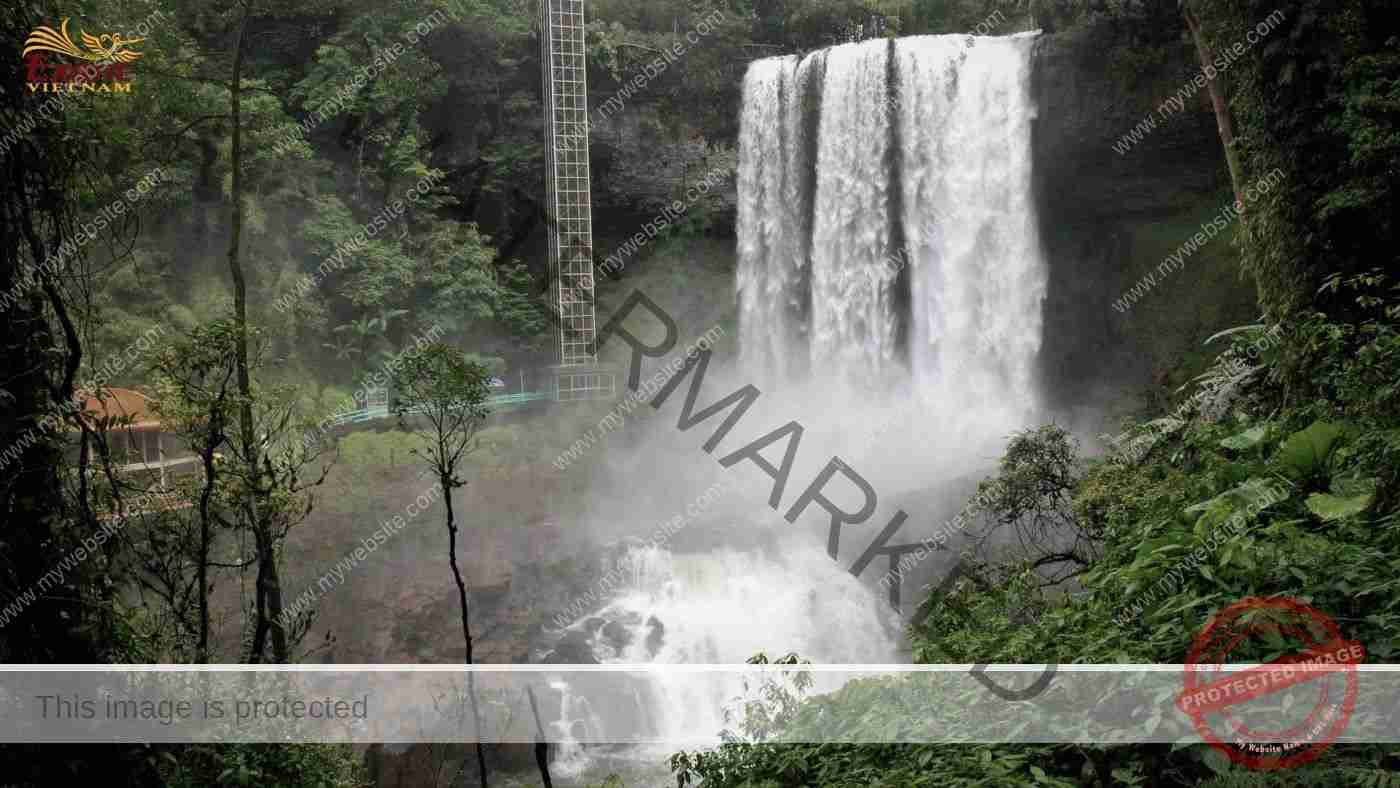
Da Lat is the best choice for those who love waterfalls. There are the breathtaking settings, with incredible waterfalls deep in rainforests or set against backdrops of dramatic cliffs and mountains. Feel extraordinary while the cool mist falls on the face or looks gaze at the pure majesty of the natural world. It’s worth spending a moment, even a few days in a jungle trek. Photo: Exotic Vietnam
Waterfalls
Located on the highest part of the terraced plateau system in the Central Highlands, where many tributaries of the Dong Nai River originate from, Da Lat becomes the convergence of a series of waterfalls, each with its own fascinating features. The attraction of these waterfalls is not only thanks to the height of decades of meters, but also the variety of different rocks on the riverbed, through the strong erosion of the flow, which has sculpted waterfalls with stunning shapes and forms.
Located at the foot of Prenn Pass, Prenn Waterfall is one of the loveliest waterfalls in Da Lat. It is about 1,120m of elevation. As approaching the waterfall, visitors will be able to notice the subtle change in temperature brought by the mist from the water falling from a height of 15m. From the path goes under the outcrop, there is a view of a pool surrounded by flowers and pipe-trees that can see through the water falling curtain. However, this waterfall is rather crowded which spoils its natural beauty.
Datanla Waterfall is located in the middle of the Prenn Pass about 5km from Da Lat. The water falls down to the ground before disappearing through layers of marble lying in a small stream. Visitors can walk easily to the waterfall. There are lots of wildlife such as squirrels, birds, and butterflies. You can not only visit the waterfall for the view, but you can also participate in adventurous activities such as high rope walk, zipline ride, alpine coaster ride and even canyoning, abseiling. Challenges are designed with varying levels of difficulty to cater to participants of all ages.
Damb’ri is 18km north of Bao Loc in Lam Dong province. In Ma ethnic language, Damb’ri means “the cascade of the Lion” or means “the stream of Hope”. Surrounded by rolling hills of mulberry, tea, coffee tree and thousands of hectares of forest, Damb’ri Waterfall is a chain consisting of the main waterfall with a height of 57m, nearly 30m wide, and the sub-falls Dasara, Daton. The total height of these waterfalls is 90m, the highest one in Viet Nam. The mist makes the area around the waterfall always cool and green all year round. It’s lucky to enjoy a colourful rainbow at pool beneath the falls in sunshiny day. It’s magnificent when viewed from a distance across the valley, but it’s also possible to get up close on steps or a lift up and down. With three impressive tiers of tumbling water set amidst beautiful natural surroundings, it’s no surprise that Damb’ri draws lots of tourists who come here to admire this breathtaking scenery.
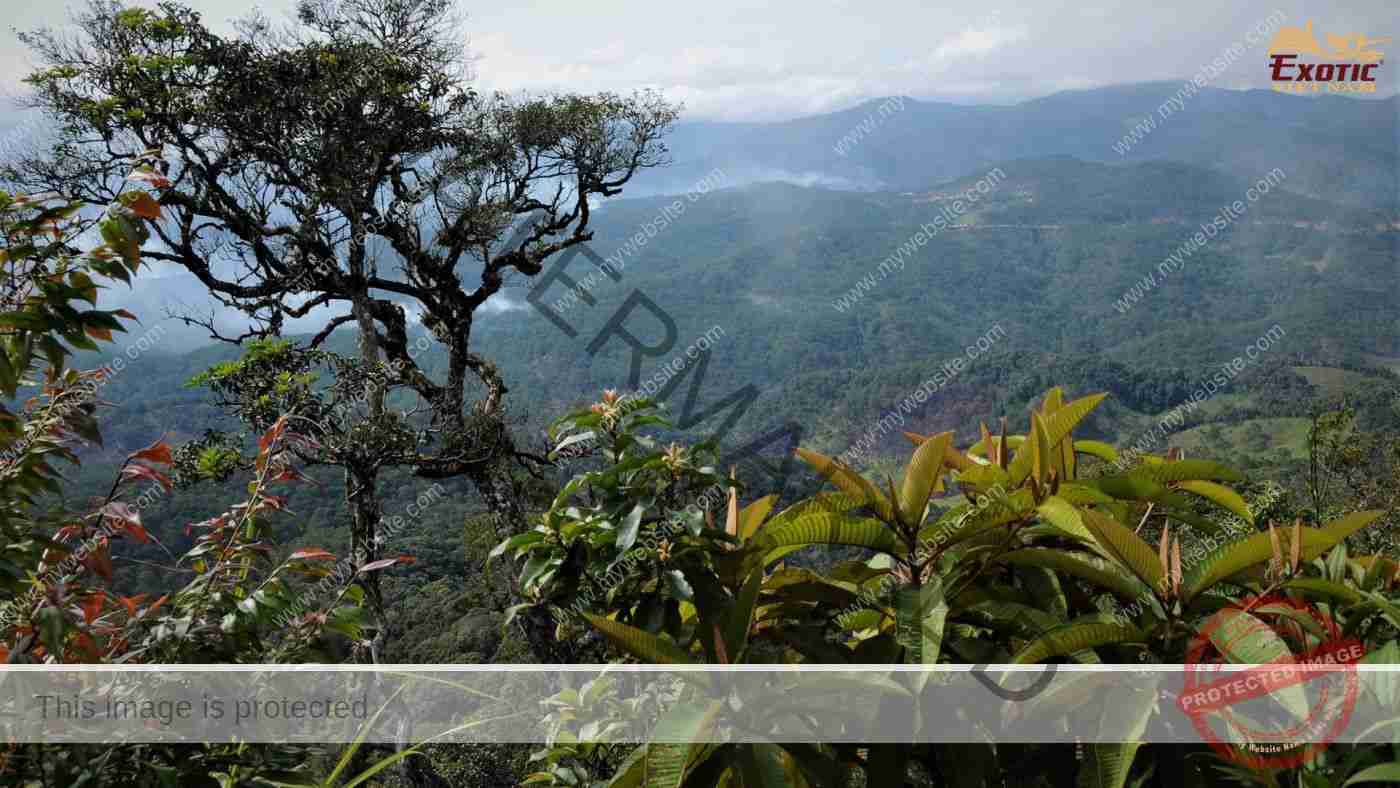
Blessed with the cool highland climate and rugged landscape, Bidoup Nui Ba National Park is evaluated as one of 221 endemic bird centers of the world and one of four biodiversity centers of Viet Nam. Within the park, several dozen species of rare or threatened plants and animals can be found, as well as old growth trees. The 1300-year-old Pomu tree (Fujian cypress) is one of the “targets” that trekkers are very eager to set foot in. Photo: Exotic Vietnam
Bidoup – Nui Ba National Park
50km from the center of Da Lat, the Bidoup Nui Ba national park was established in 2004 and is named after the two highest peaks of the Langbiang plateau: Bidoup (2,287m) and Nui Ba (2,167m). With a total area of 70,038 ha, the park aims to conserve forest ecosystems in sub-tropical mountainous climate, valuable, rare and endemic animal and plant species. Thanks to the association with the adjacent national parks and nature reserves, it helps to form a large natural area, contributing to biological conservation in the Langbian Plateau, the South Central Highlands and the South Central region.
Located in the ecological zone of Truong Son mountain range, the park includes two types of forest: coniferous forest and evergreen broadleaf forest. The forest is home to more than 1933 vascular plant species, of which 96 endemic species and 62 rare species are listed in the Red Book. More than 14 species out of a total of 33 species of conifers in Viet Nam are present here, including many endemic and rare species such as the two-leaf pine, known as living fossils, long-leaf pine, etc. and various species of orchids and mushrooms. In terms of animals, this is home to 441 species of vertebrates, 32 species listed in the Red Book including many rare animals such as scrub and black foot, red wolf, gaur, etc. and many species of endemic birds in the Central Highlands such as the star pheasant, the black-headed babbler, etc. It’s perhaps the best place in Viet Nam for birdwatching.
From lush mountains to refreshing waterfalls, the park owes part of its fame to its wealth of wild beauties. Follow Exotic Vietnam to wander through these breathtaking natural spots hidden in the park that you shouldn’t miss if you come to Da Lat – all of them will make you wow in front of the magnificence of Mother Nature.
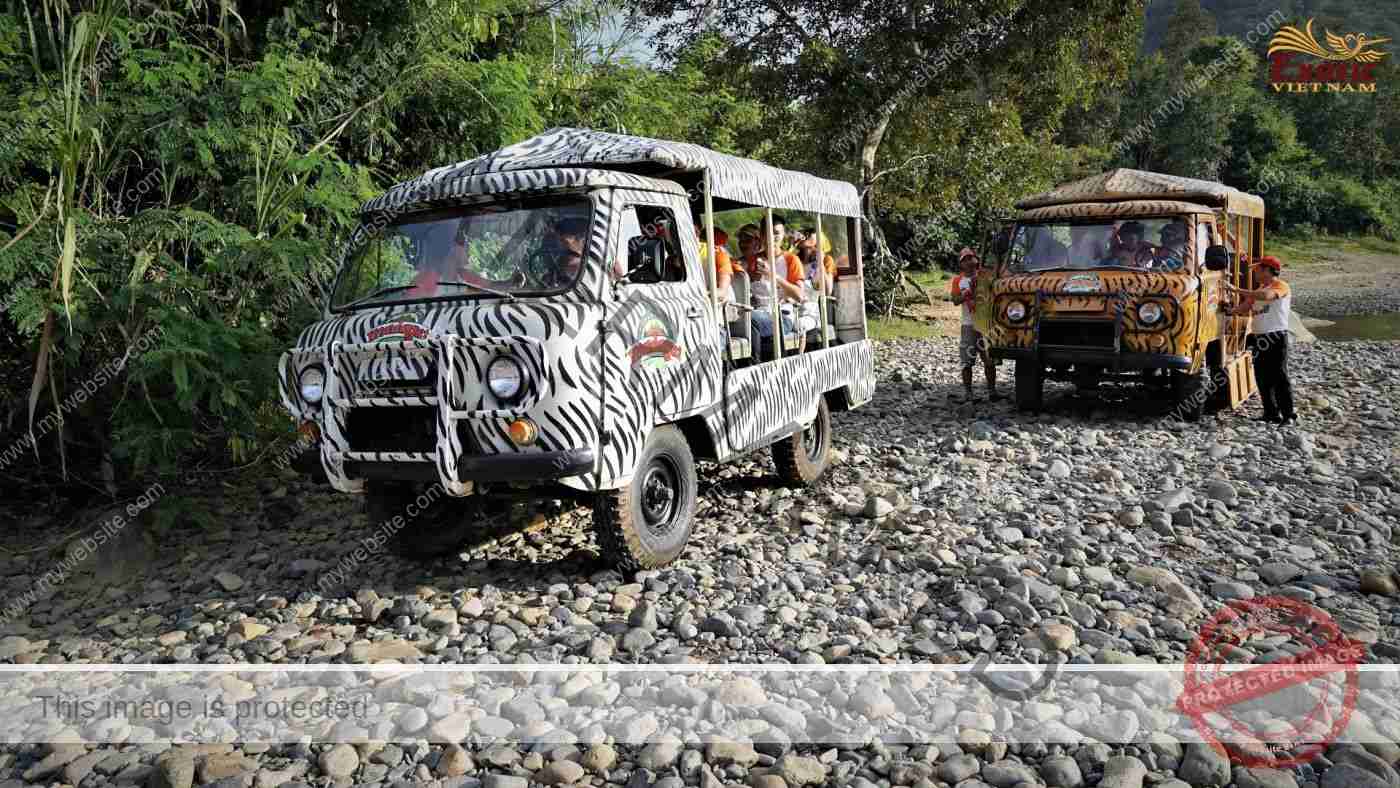
This is the ideal place to enjoy the feeling of exploring nature with many exciting activities and even survival challenge in the wilderness, but not too far from thoughtful food and rest services. Madagui Forest Park has a great attraction for businesses looking to find a playground for team building and rest according to a sustainable trend with a short travel time from Ho Chi Minh City. Photo: Exotic Vietnam
Madagui Forest Park
Located on NR20, at an altitude of 500m, in the middle of Ho Chi Minh City and Da Lat, Madagui Forest Park covers a pristine area of about 1,200 hectares endowed with stunning streams, dark caves, strange shaped rock formations, along with rich flora and fauna, and the warm, humid and mysterious atmosphere of the rainforest.
This well maintained park features with trimmed lawns and bushes in the background evergreen trees. Several trails wind through steep hills filled with greenery so that you can get up close to nature. Many rustic restaurants, villas separated by trees, multi-storey swimming pools are built scattered on the hillside in harmony with its natural surroundings.
Whether you’re looking for the best walks or a team building playground somewhere near Ho Chi Minh City or just keen to enjoy what Mother Nature has bestowed upon us, Madagui Forest Park gives a list for you such as rafting, hiking, climbing, camping, and so on with excellent services, great comfortability along with unique & exotic experiences.
TEAM BUILDING IN DAK NONG
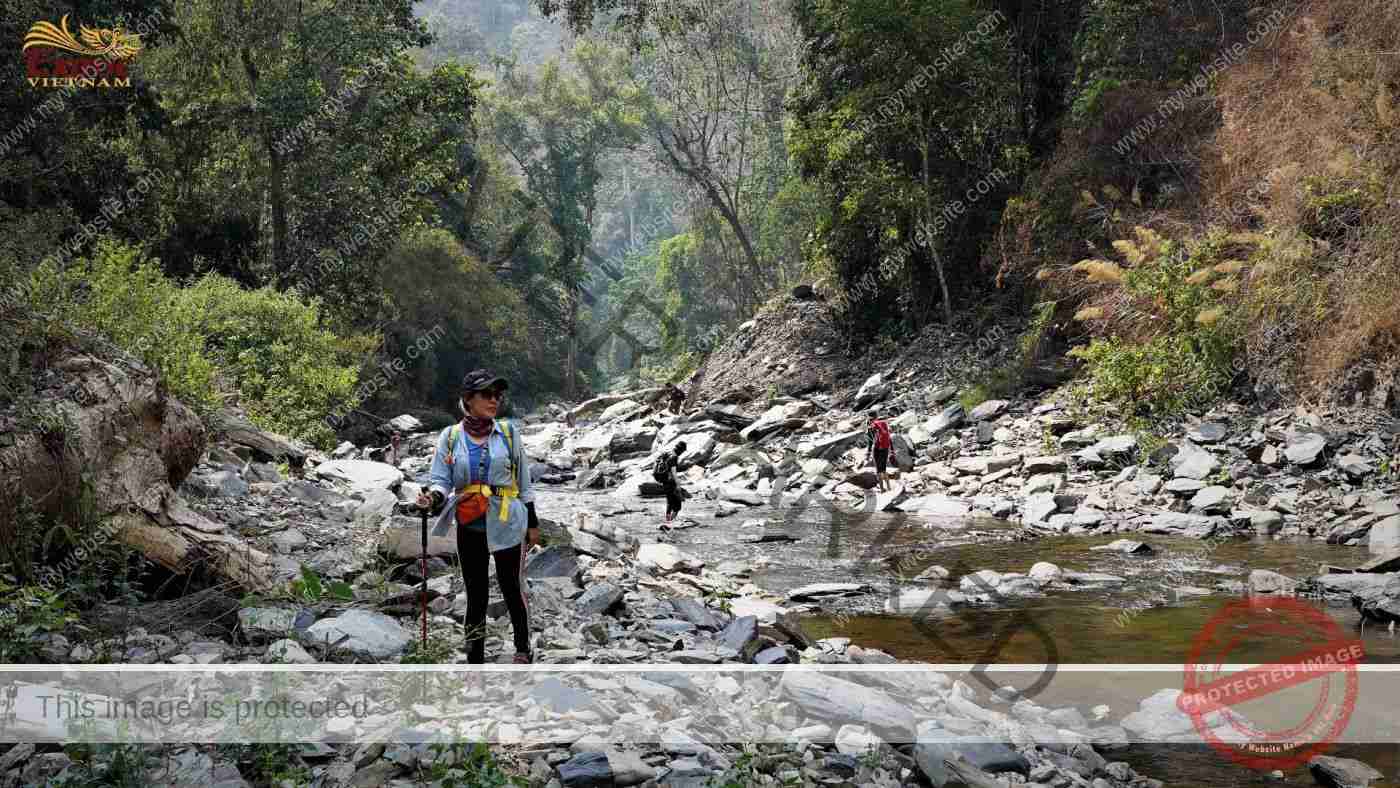
Most of Dak Nong Province, known for its geologic heritage including abundance of volcanic craters, lava caves and a network of beautiful waterfalls, etc. has been recognized as a UNESCO Global Geopark in 2020 for its extraordinary landscapes and people. Coming to this plateau, it’s easy to feel nature always being with you. It’s worth it to breathe in fresh oxygen-filled air, admire the rough natural surroundings of lakes and vast forests, explore the breathtaking volcanic sites being still alive through thousands of years, and so on. Photo: Exotic Vietnam
Location: 230km from HCMC (4.5 hours by car via NR14), 125km south of Buon Ma Thuot (2.5 hours by car), 190km west of Da Lat (4 hours by car) and 215km north of Phan Thiet (5 hours by car).
Introduction: Dak Nong province is located entirely on the Dak Nong plateau, also known as the M’Nong plateau because this is where the M’Nong people live. The French called it the Central Highland at south Indochina, the reason it was called “the center”, because of its special position stretching over the land of all three countries of Central Vietnam, Cochinchina and Cambodia, a French colony at that time. Therefore, it is also known as the “Three Borders” plateau. The M’Nong people are the indigenous people with the largest population here, they call this land Yôk Luaich, which means “Grassy Hill plateau”, because of the vast grasses on the red-brown feralit soil with layer of laterite.
With the goal of preserving natural heritage, raising community awareness and promoting economic development through sustainable tourism, Dak Nong Geopark, dubbed the “Land of Melodies”, recognized in April 2020. The park is spread over an area of more than 4,700km2, accounting for more than 2/5 of the natural area of Dak Nong province, spanning 6/8 districts and towns of the province, namely Krong No, Cu Jut, Dak Mil, Dak Song, Dak G’. Long, and TP. Gia Nghia.
From Ho Chi Minh City easily reaching to Gia Nghia about 230km via NR14, the quality of traffic is very good. Travel time is 4-5 hours. Accommodation facilities in Gia Nghia meet the basic requirements for staying with a 3-star hotel system. Along with other infrastructures such as restaurants, attractive attractions, etc., Dak Nong fully meets the requirements for sightseeing and the team building event for businesses, especially eco teambuilding to raise awareness about the environment and community for the participants.
In Dak Nong, Exotic Vietnam is a reliable partner to carry out a teambuilding program in The Amazing Race format to feel the warmth of teamwork amidst the immensity of nature, or trekking trips to discover the primeval world of nature reserves with an unforgettable experience!
Highlights: Museum of Sounds, Waterfall complex, Volcanic Cave complex, Ta Dung Hydroelectric Reservoir, Ta Dung National Park, Nam Nung Nature Reserve, etc.
Facilities & services: trekking through jungle, tourist class hotels and restaurants.
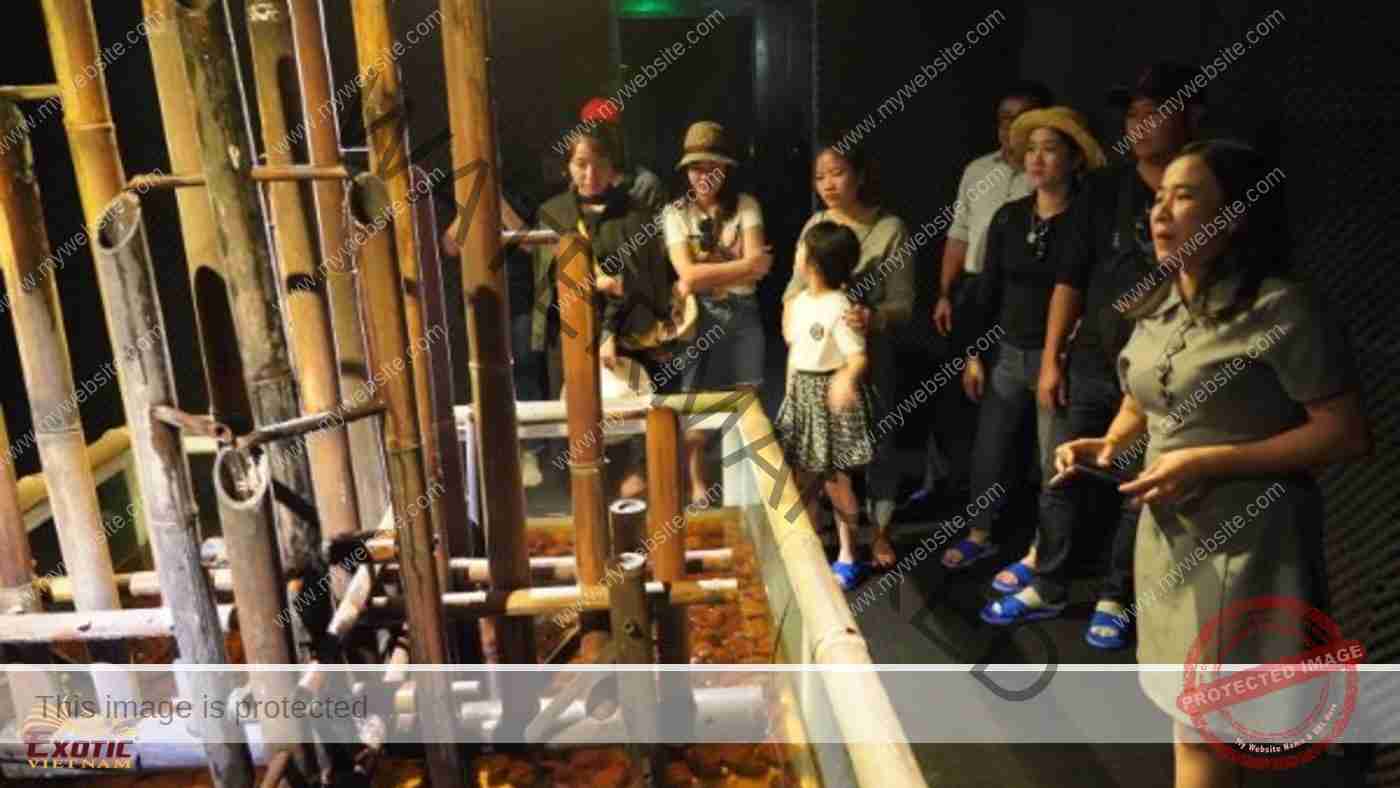
Inspired by the sounds of the Universe’s five elements (metal, wood, water, fire, earth), the Museum of Sounds invites you into the world of sounds that exist in the natural environment or the surrounding community in which we live in harmony every day. You can also see, feel and even create the sounds and noises yourself. Photo: Exotic Vietnam
Museum of Sounds
Created by a group of French artists, Scenocosme, the Museum of Sounds, or EXPLORASOUND, is located at the center of Gia Nghia. Spreading over an area of 200m2, the museum is divided into 8 separate spaces with 7 themes featuring sounds from different materials as well as performances: The Sound of Rock, The Sound of Fire, The Sound of Wind, The Sound of Water, The Sound of Wood, The Sound of Light and The Sound of Ourselves. These sounds are created based on 5 basic elements of the natural world, which are Metal – Wood – Water – Fire – Earth. With a very novel design space, combined with sound systems and LED lights, the exhibition shows a very high connection and interaction between exhibits and visitors. This is the only museum of sounds in Viet Nam and Southeast Asia.
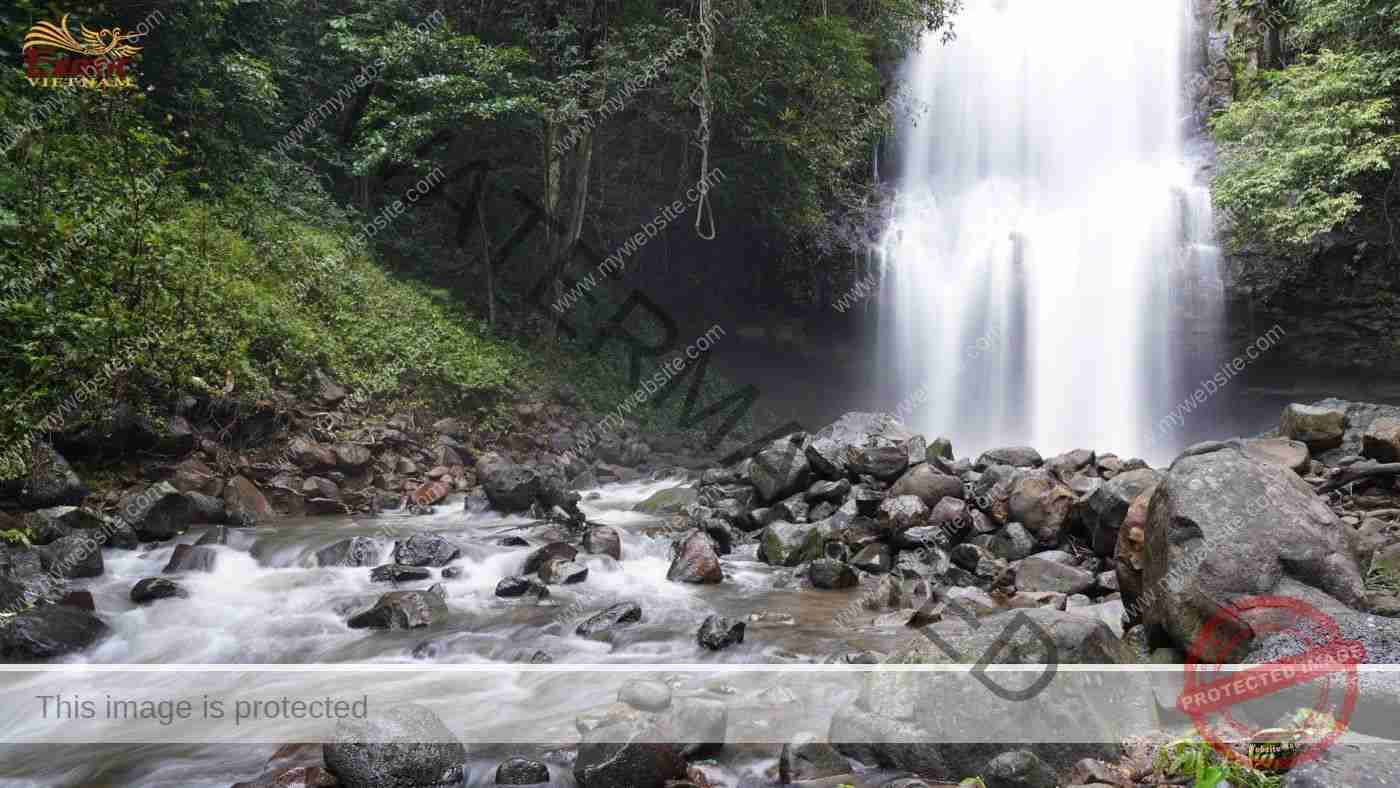
Receiving much annual rainfall, being affected by sophisticated tectonic faults, possessing a dome-like terrain as a high rooftop, and retaining multi-layered vegetation are the reasons why Dak Nong becomes a land of amazing waterfalls. If you trek hard enough, you might be able to find a water oasis at the base of the falls in even the most unexpected of places. It is a heaven to spend time swimming and pitching a tent. Photo: Exotic Vietnam
Waterfall system
Dak Nong owns countless beautiful waterfalls. The cause is that from the surface of the Dak Nong plateau at an elevation of 1000m, all four sides are steep slopes with dense networks of streams and rivers, in the north and west flowing down the Xre Pok, Prek Te and Prek Chlong rivers then to pour into Mekong River, in the east and south flows down to Dong Nai and Be rivers then to flow into the East Sea. Terrains are combined with a lot of rainfall, many faults caused by tectonic activities and the diversity of rocks have created many beautiful waterfalls: Dak G’lun waterfall (Dak R’Til commune, district district). Tuy Duc), Lieng Nung waterfall (N’rieng bon, Dak Nia commune, Gia Nghia town), Luu Ly waterfall (Nam N’Jang commune, Dak Song district), Nam Floor waterfall (Dak Sin commune, Dak R’lap district), and more.
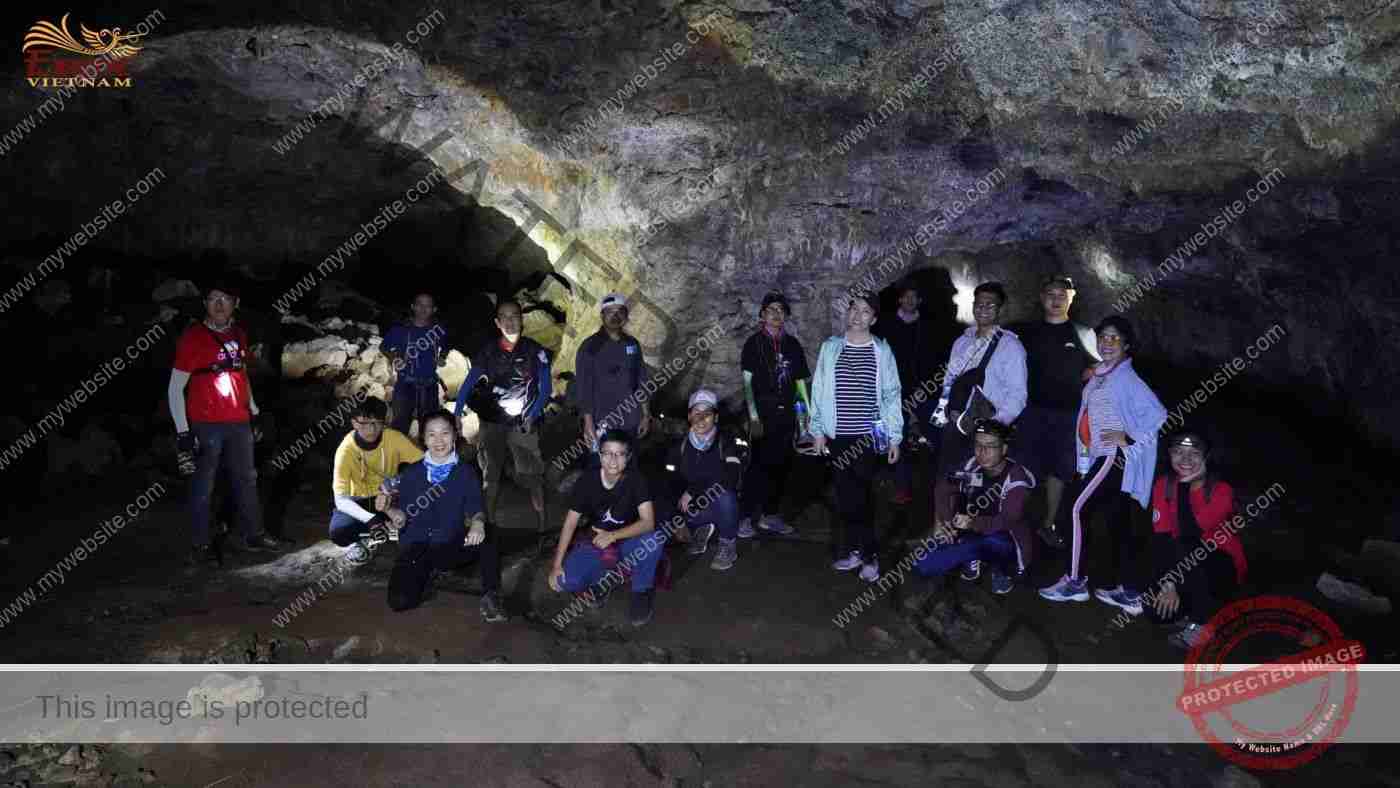
It’s the underground world inhabited by early humans that the civilized world had only known about in recent times. Volcanic caves are dark places filled with geological singularities, unusual life forms, and winding passages hidden with many mysteries ahead. It’s interesting to detect the crystallization of molten basalt through the shape of moving lava flows and dripping formations that have remained unchanged for thousands of years. Photo: Exotic Vietnam
Volcanic cave system
According to the people of Ede, Chu Bluk means volcano. Coming to Dak Nong Geopark, a land of active volcanoes in the past, not only you can discover different types of volcanoes, you also enter the underground world of a lava tube.
Dak Nong Geopark has 5 volcanoes: Nam Duong, Bang Mo (Cu Jut), Nam Blang, Nam Kar (Krong No) and Nam Gle (Dak Mil). The above volcanoes are all active in the form of eruptions, explosive eruptions or both, or fissure eruptions 10,000 years ago.
When an eruption-type volcano is active, a low-viscosity, liquid basalt flow will overflow. The upper basalt layers, due to exposure to air, should cool and harden first. The underlying basalt layers cool more slowly, remain liquid, and continue to move. During the late stages of the eruption, the lava supply gradually decreases causing the molten material to flow away but not be compensated. This deficiency creates cylindrical tunnels that extend with the flow beneath solidified basalt. The gas escapes from the lava, accumulates under the dome and supports the dome. When this gas mixes with air from the vents on the dome, creating a strong increase in heat from oxidation, this temperature is enough for the cave arch rock to re-melt, then drip down with the lava remaining. Such lava can solidify in situ to form small stalactites.
Although there are 5 volcanoes, at Dak Nong Geopark, only the volcanic cave system related to Nam Blang volcano has been studied, with a total length of 10km including 50 caves. In which, C7 cave is 1,067m long, the longest volcanic cave in Southeast Asia; C 6.1 cave where traces of prehistoric people were discovered 10,000 – 7,000 years ago; C3 cave is located in a 968m long cave system, divided into many segments separated by collapsing holes, that is also famous for its unique fossil which is a wooden mold with a diameter of 80 cm formed by lava.

Enjoy a pleasant trip to Lake Ta Dung with Exotic Vietnam. Find an enchanting spot to watch either a sunset or a sunrise across the lake. Take a panoramic photo of mirror-like waters, reflecting the islands and any clouds in the sky. After a boat ride, a leisurely walk or a team building activity beckon as soon as you disembark. Photo: Internet
Ta Dung Hydroelectric Reservoir
In the midst of the vast lake, the hills with many different shapes, sometimes drooping, sometimes rising, all gently curving to draw a giant natural painting in the core of the forbidden forest, which is Ta Dung National Park. To have this tourist landscape, Our Mother Nature has to suffer. In 2011, people blocked the Dong Nai River to build a reservoir for the hydroelectric plants Dong Nai 3 (capacity of 180MW), and Dong Nai 4 (capacity of 340MW), flooding an area up to 3,620ha. These hydropower projects have caused negative impacts for the natural and social environment along the Dong Nai river basin, such as large-sized deforestation, climate change, and biodiversity, adversely affecting people’s livelihood, and so on. The hydroelectric reservoir with 36 large and small islands creates the landscape of “Ha Long Bay in the Central Highlands”. The ideal time to visit Ta Dung Reservoir is in the water storage season, from July to December. When the lake’s water rises to a clear blue and the rains make the trees on the islands green.
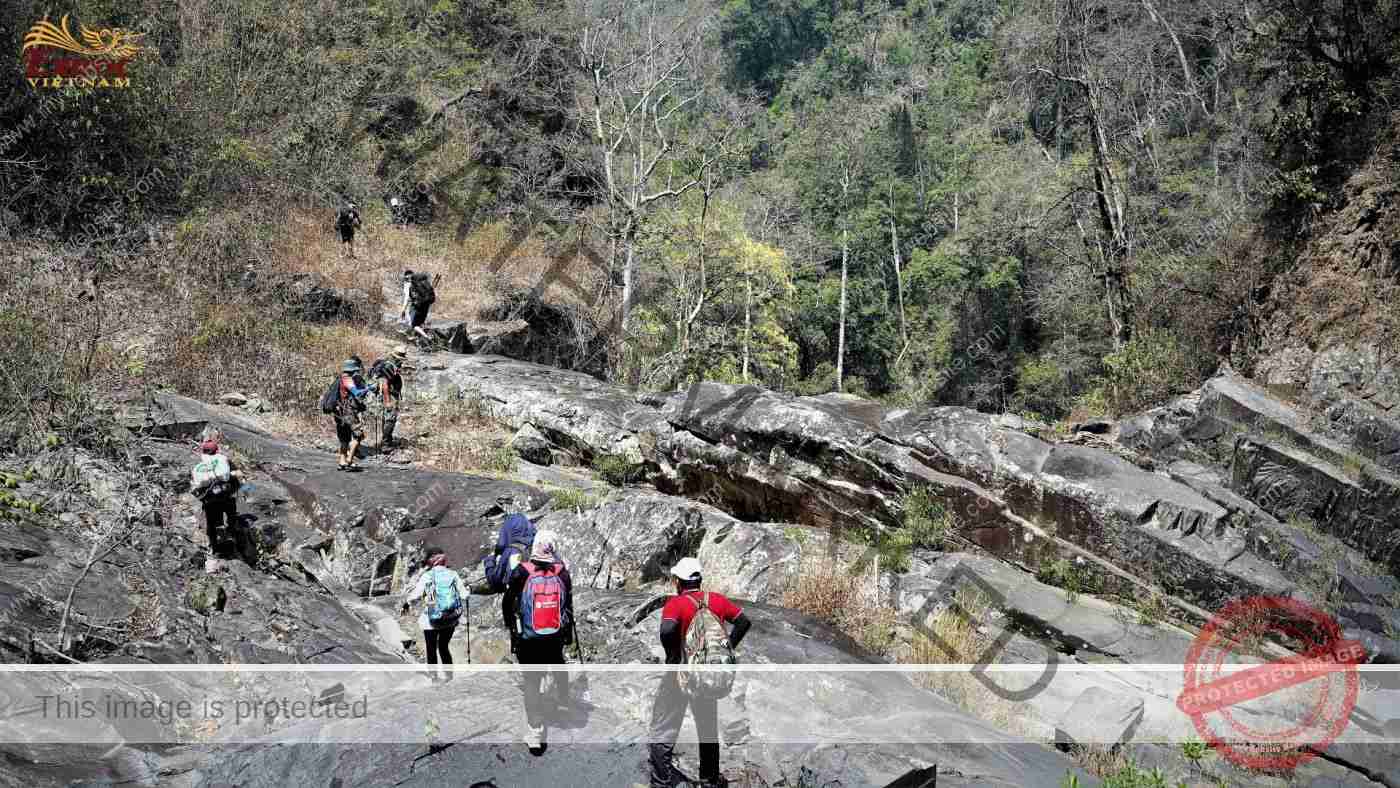
With the coverage of primary forest accounting for 48% of the area of core zone, Ta Dung National Park is ranked highly in Viet Nam for the diversity of ecosystems and habitats of wild animals. Whether you start your trek from the north or the south side of Mount Ta Dung, the park holds a lot of fascinating trekking trails. Many of these take trekkers up tall peaks, or through dense jungles to gorgeous viewpoints. Photo: Exotic Vietnam
Ta Dung National Park
50km northeast of Gia Nghia City, Ta Dung National Park was established in 2018 on an area of 20,937ha. Endowed with a large layer of forest vegetation, covering up to 85% of the core area, including primary forests accounting for 48%, secondary forests of all kinds 36% the park has suitable ecosystems for the residence, growth and development of many plants and animals. They include the following ecosystems: evergreen broad-leaved, semi-deciduous, coniferous, mixed wood and bamboo, in which evergreen broad-leaved natural forest is predominant with an area of 8416 ha, accounting for 44.6% of the garden area. This is home to 1,406 species of higher vascular plants belonging to 760 genera and 192 families of 06 different plant branches; and 574 animal species belonging to 38 orders and 124 different families. There are many endangered species listed in the Red Book of Viet Nam and the World.
Ta Dung is also the name of the largest granite massif in Dak Nong province, stretching about 15km with 3 peaks of Ta Dra, Ta Dung and Tchirke, of which Ta Dung is the highest peak, 1,982m, as the roof of Dak Nong plateau. The depth of the terrain is not too large, about 200m at the saddles between the massifs. The terrain has a continuous slope of 20-30 degrees on the slopes and the vegetation under the forest canopy is quite clear, so conquering Ta Dung peak is not too difficult, especially the starting position is already at an altitude of 700m (on west side) or 950m (on east side).
There are 2 trekking routes to choose from:
- Departure and end at Dak Plao (Dak Glong). The journey is 10km long for each turn with 5km of hilly roads and 5km of mountain slopes, for a total of 20km. Turns go and back on the same road on the west side. Tractors can be used to transport luggage and people on the road in the forest and coffee fields. Truot Waterfall and Mat Troi Waterfall are worth stopping at along the journey. The 2-day climbing program, with 1 night stay at an altitude of 1700m, by a stream with good water source, and a quite flat camping ground.
- Departure at Phi Lieng (Lam Ha) and end at Dak Plao (Dak Glong). The journey is 10km long for each turn with 5km of hilly roads and 5km of mountain slopes, totaling 20km. Uphill on the east side and downhill on the west side. Tractors can be used to transport luggage and people on the coffee field at the beginning (from Phi Lieng to the foot of the mountain) and at the end (from the foot of the mountain to Dak Plao). Bay Tang Waterfall, Truot Waterfall and Mat Troi Waterfall are worth stopping at along the journey. The 3-day climbing program, with 2 nights stay at the foot of the eastern slope and 1700m high mountain, where there are springs with good water sources, and quite flat camping grounds.
Rainy season from May to November and dry season from December to April. Weather conditions greatly affect the itinerary. The difficulty of trekking increases in the rainy season with insects (especially green and brown leeches), slippery slopes, wet condition when eating and camping overnight. The ideal time to climb Ta Dung is from December to May.

Like a hidden gem that most people don’t know about. Nam Nung Nature Reserve immerse yourself in nature landscape, fresh -bloom scent and bird chirping sound. From easy walks to serious hikes, many sides of the rainforest will be discovered. Along the trail, you encounter a rich diversity of flora and fauna, with endemic species, that end with a rewarding and refreshing waterfall. Looking down from above, the panorama of forest canopy offers a truly captivating display in the mist. Photo: Exotic Vietnam
Nam Nung Nature Reserve
45km west of Gia Nghia City, Nam Nung Nature Reserve covers an area of 21,866ha with most primary forest. The highest peak is Nam Nung or Nam Jer Bri with an altitude of 1578m. This place records the heroic history of ethnic minorities in the South Central Highlands under the leadership of N’Trang Long, N’Trang Guh… in the resistance war against the French in the early 20th century.
The reserve has 2 main ecosystems: the natural broadleaf evergreen forest ecosystem and the natural bamboo mixed timber forest ecosystem. In which, the natural broadleaf evergreen forest ecosystem occupies a large area, accounting for over 90% of the reserve.
The reserve has a very rich and diverse flora and fauna. Plants have 881 species of higher vascular plants, belonging to 541 genera of 175 plant families. In which, there are 75 rare species listed in the Red Book of Viet Nam and the World such as Rosewood, Red Wood, Honeydew, Black Star, Jackfruit Oil, Sen latex, Curved Leaf Star, Three-sided Oak, Water Oil… In the world, the three-sided oak has only been discovered in Indonesia, Malaysia and Vietnam. Animals include 58 species of mammals, 173 species of birds, 66 species of fish, 37 species of reptiles, etc. There are many endangered species listed in the Red Book, which are in danger of extinction and need to be preserved.
Regarding the natural landscape, Nam Nung Nature Reserve, hides a dense system of streams and waterfalls and the top of Nam Jer Bri mountain 1,578m high. With a 5km walk through the forest, you will reach Gau waterfall, then continue along Dak P’Ri stream to reach Bay Tang (Len Gun) waterfall. Depending on the slope of the terrain, this stream is sometimes angry with splashing water, but sometimes becomes gentle with calm moving water. Care of yourself during the rainy season when the water flows rapidly. In addition, the journey to conquer Mt. Nam JerBri 1,578m is also an interesting challenge with a long trek, through many mountain peaks. This is also an area with many war vestiges such as a helicopter airport and a reservoir built during the French period.
The ideal time to visit Nam Nung Nature Reserve is from December to May. Let’s explore this exciting destination with Exotic Vietnam.
TEAM BUILDING IN DONG NAI
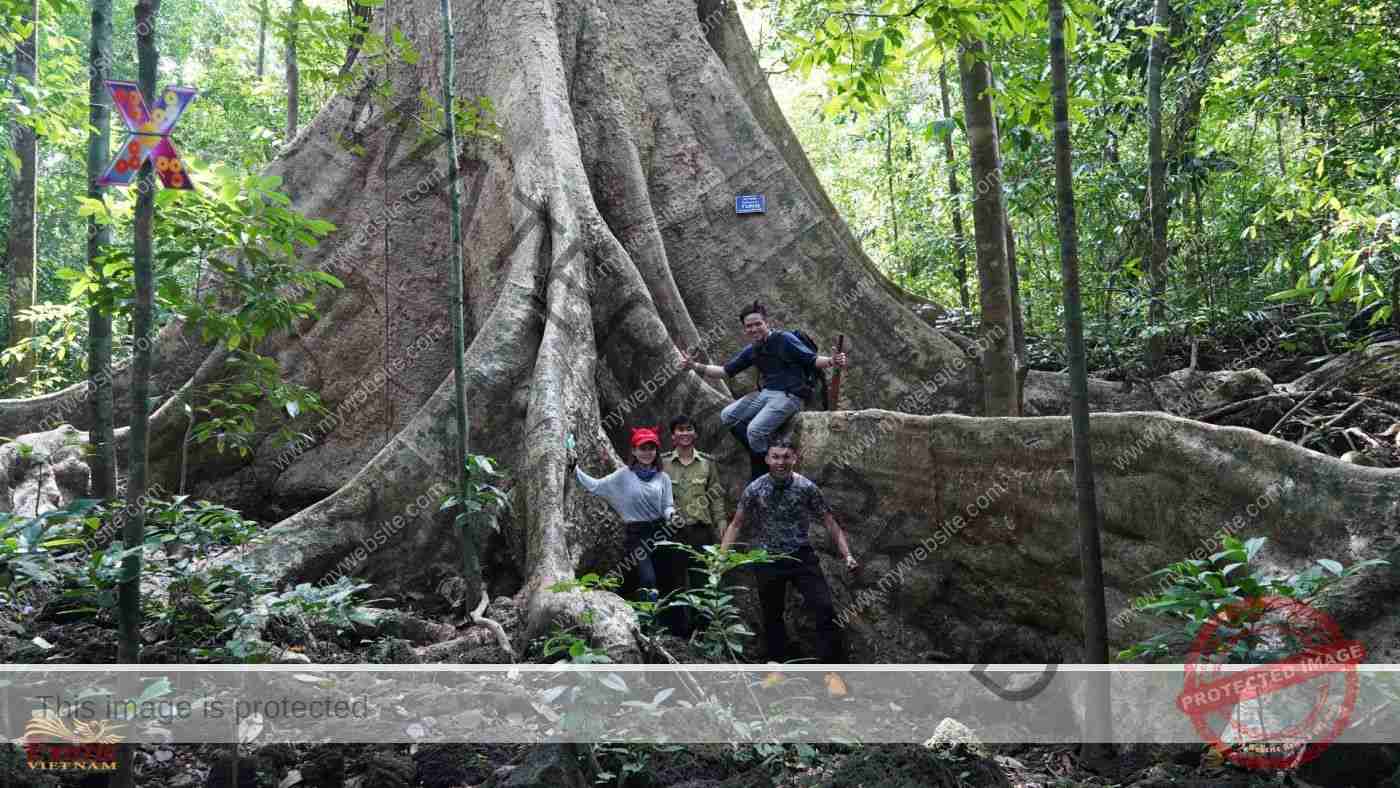
Instead of having to travel far to go to popular coasting tourist sites, spend less time moving to Dong Nai right next to Ho Chi Minh City. Find a vantage point to have a beautiful picture of the natural beauty with endless greenery in the background. Stroll around a nature reserve at your own pace to find out more about what’s all around, you might even spot a wildlife or two on a lucky day. Photo: Exotic Vietnam
Introduction: Inlaid between the lowland Mekong Delta and the mountainous Central Highlands, Dong Nai is a midland province at an average height of 100m, just a few dozen kilometers northeast of Ho Chi Minh City
Favored by nature from grey alluvium, red volcanic soil and abundant water from Dong Nai River, the Vietnamese settled in Dong Nai more than 300 years ago, turning rugged mountains and dense forests into rich villages, rice fields and orchards. By the early 18th century, the Chinese immigrants had built Cu Lao Pho in Bien Hoa into a bustling trading port attracting vessels from Japan, China and even Western countries. Today, Dong Nai is known for its large industrial parks, Long Thanh international airport project, surrounding rubber plantations, the system of lakes, dams and rivers and lots of little known volcanic sites
Many verdant natural landscapes are preserved to become a captivating destination for tourists from Ho Chi Minh City. It is also easy to connect attractions in Dong Nai with nearby tourist centers such as Vung Tau, Mui Ne or even further afield, Da Lat.
Highlights: Cat Tien National Park, Dong Nai Nature and Culture Reserve, Suoi Mo Park, Dao O – Dong Truong Islands, Buu Long Park.
Facilities & services: domestic standard hotels, rustic restaurants, and cafes.
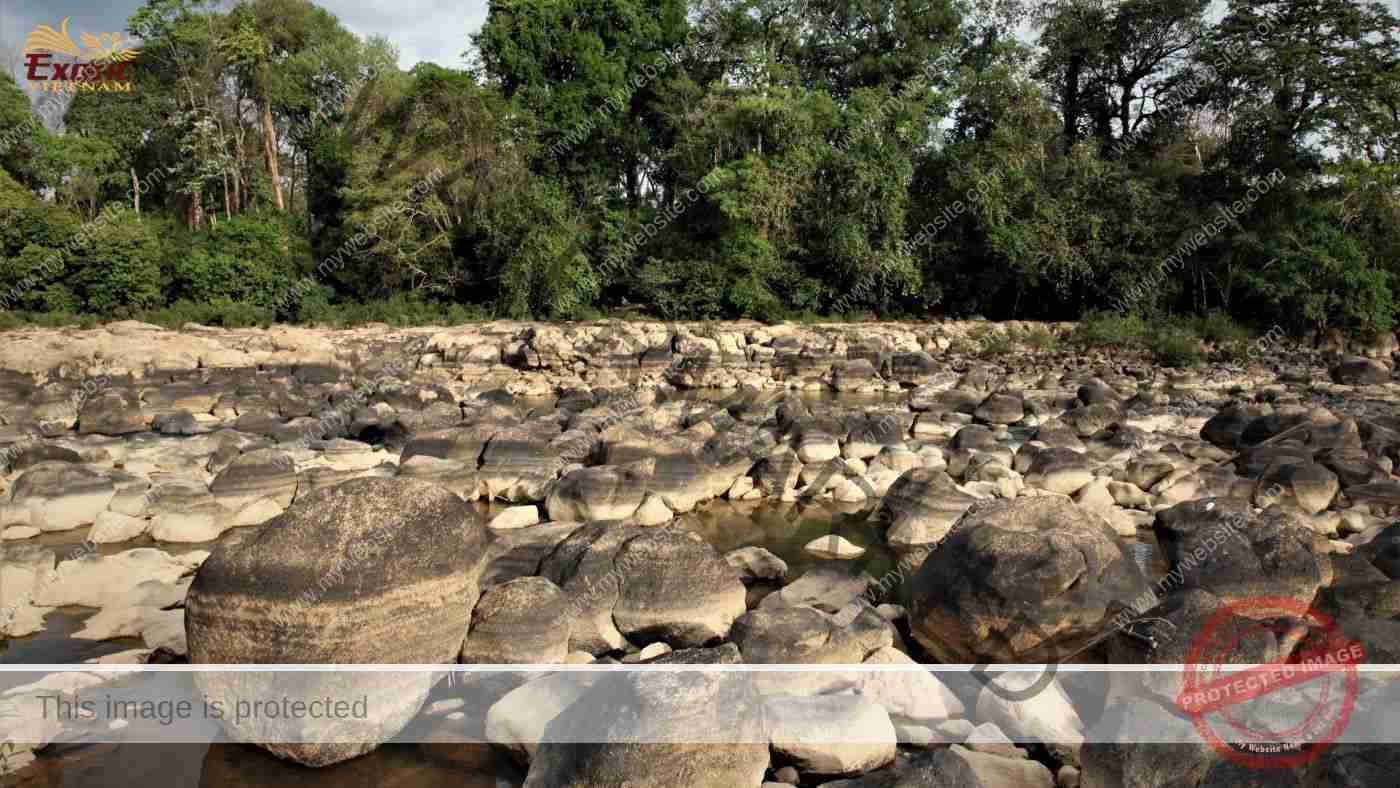
As one of the South’s most popular national parks, Cat Tien boasts some of the stunning views, attractive hiking trails, and vacation opportunities for people from Ho Chi Minh City. The park is also known for its giant trees, which are estimated to be over 400 years old, such as Tung tree (Acacia) its huge spreading roots or Bang Lang tree (Lagerstroemia) with six tops soaring straight up into the sky. Photo: Exotic Vietnam
Cat Tien National Park
Cat Tien National Park is a virgin destination during the stages of Covid-19 flu season in 2021, where you are free to breathe in the oxygen-filled air, the scent of wild flowers in the endless breeze.
Established in 1992, Cat Tien National Park covers an area of 71,350 ha consisting of three sectors: Nam Cat Tien (Dong Nai Province) in 39,627 ha, Cat Loc (Lam Dong Province) in 27,530 ha and West Cat Tien (Binh Phuoc Province) in 4,193 ha. In 2001, the park was recognized by UNESCO as the 411th Biosphere Reserve and the 2nd Biosphere Reserve of Viet Nam. In 2005, Bau Sau wetland, a flooded area of about 137km² in the park was recognized by the Ramsar Convention as the 1,499th most important wetland of the world and is currently one of eight Ramsar sites in Viet Nam.
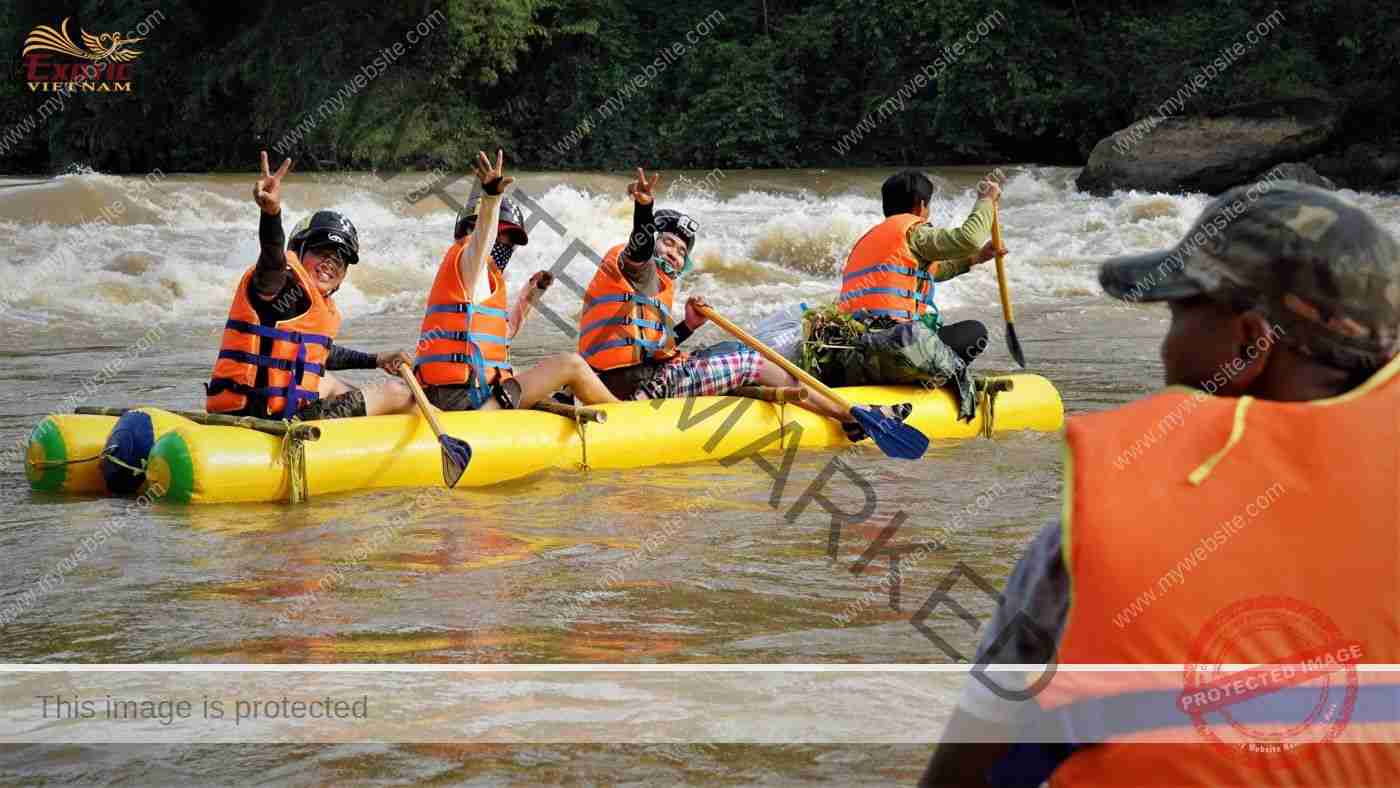
Cat Tien National Park is the ideal place for team building activities in the forest for those looking for an unforgettable feeling. Discovering the different corners of this fantastic place in a team building program gives you the ecological knowledge and the real benefit of team spirit boost. Photo: Exotic Vietnam
The park is home to various species from fauna to flora, some are listed as rare animals and plants, together with grass lands and streams. The convergence of green treasures with 5 types of forests (broad-leaved evergreen; evergreen & semi-deciduous; mixed bamboo; pure bamboo and submerged vegetation). You can also admire different types of strange mushrooms, the charming forest flower branches, hundreds of medicinal plants, precious orchids.
Dong Nai River has lots of rapids embracing the southeast side make the park become an ideal team building playground with some main reasons:
- About 150km from Ho Chi Minh City along Long Thanh – Dau Giay Highway and National Highway 20, you can easily access for a full day program, or a stopover at the midway of the journey to Da Lat or Phan Thiet (via Me Pu).
- Due to the type of evergreen & semi-deciduous forest with 5 layers of canopy, there are not many shrubs on the forest floor, you can do team building programs in The Amazing Race format or run station by station on paths through the forest (concrete or paved). More challenging, you can find a shortcut in the forest with a GPS device.
- The landscape is so wonderful, sometimes the butterflies fly, sometimes the sunlight dances under the forest canopy, and so on. More luckily, you can admire the mesmerizing dance of the peacocks amidst the grandeur and romance of the wild world.
- Many bike paths range from a few kilometers to tens of kilometers including simple dirt roads and trails of basalt outcrops and vines or shrubs. Going in the rainy season, you will experience the slime of the clay layer clinging to the soles of shoes or wheels.
- Rafting on Dong Nai River is also a breathtaking experience. The flow is regulated by hydropower plants upstream and the discharge time is announced in advance, so the river is quiet all year round. You can have refreshments at Heaven Waterfall and Ben Cu Waterfall along the rafting challenge route.
According to the criteria of eco-team building based on three main pillars (economic, environmental, and social), the team building program at Cat Tien National Park helps your company enhance its CSR efforts. The trip strengthens the relationship among your employees, fosters a sense of company pride, and gives back to the nature you visit. Your employees have opportunity to learn about environmental lessons (aesthetic, scientific, economic, etc.), and contribute to reduce non-biodegradable waste as keeping used PET bottles to refill water or being careful every step while entering the primeval world. Let’s explore it with Exotic Vietnam!
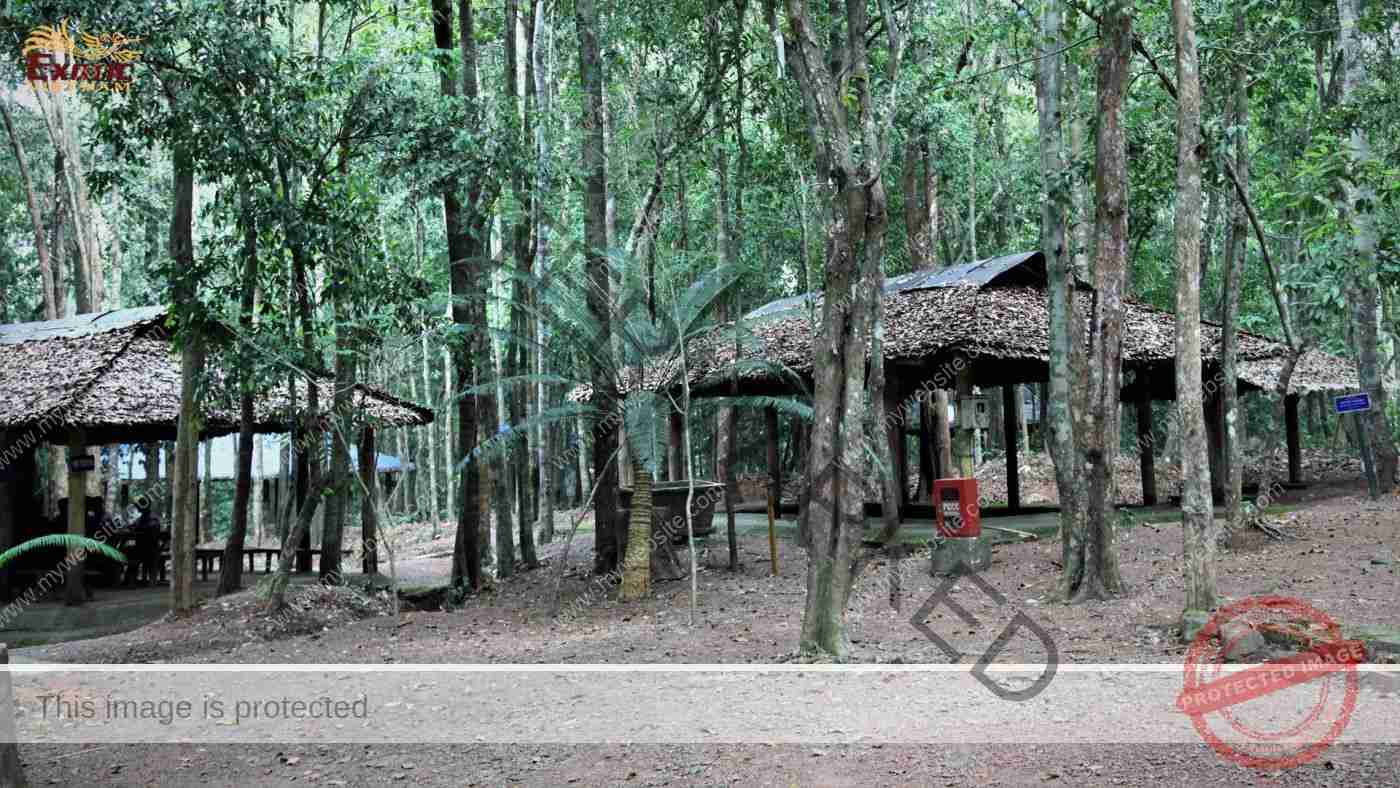
From the war relics scattered in the legendary War zone D, lots of small islands that still keep their pristine features on Lake Tri An, to the wonders of the natural world hidden in the nature reserve, etc. Dong Nai cultural and nature reserve offers you a completely new experience, through a sightseeing trip as well as an exciting team building program. Photo: Exotic Vietnam
Dong Nai Culture and Nature Reserve
Along with Cat Tien National Park, Dong Nai Culture and Nature Reserve is a vast set that covers three fifths of the area of the Dong Biosphere Reserve recognized by UNESCO in 2011. This interesting spot is 74km away from Ho Chi Minh City.
Covering an area of 100,304 ha, the reserve, known locally as Ma Da forest, has outstanding values such as the biodiversity of tropical rainforests, spectacular natural landscapes, many historical sites, and distinct cultures of 13 ethnic minorities who have lived here. With the presence of 1,401 species of plants, the ecosystem of the reserve includes many forest types: evergreen broadleaf, semi-deciduous broadleaf, deciduous broadleaf and bamboo. It is home to 1,729 species of animals, including globally threatened species such as elephant, leopard, sun bear, gaur, etc. Due to its strategic location and protected by thick forest, from 1946 to 1975 this forest was called War Zone D, where the headquarters of the resistance forces against the French and Americans (COSVN – Central Office for South Viet Nam) were secretly stationed.
Travel through the reserve is done for visitor enjoyment including biking, hiking, camping and staying the night in forest ranger station, participating in historic tours of famous war relics in all its glory. You can enjoy fishing, boating and swimming in Lake Tri An or visiting to organic farms to get insight to daily rural life of the locals. It is also a fantastic outing venue for many types of team building activities.
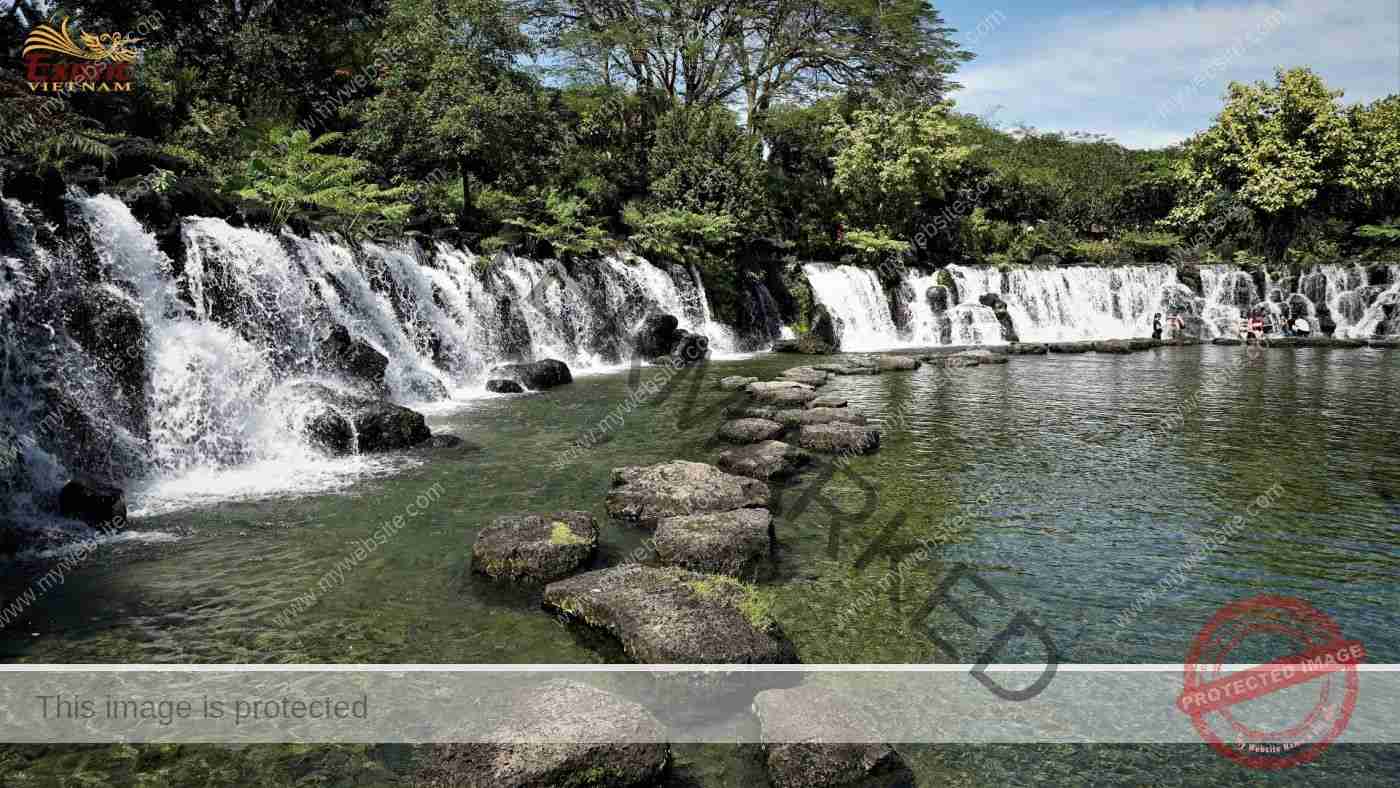
Apart from the splashing in laughter, Suoi Mo Park is also impressive with surrounding lovely waterfalls that sparkle with sunlight all day. Choose your own way to feel peaceful or relax with crystal clear waters, breezy winds and verdant backgrounds. Photo: Exotic Vietnam
Suoi Mo Park
Nestled close to Cat Tien National Park, Suoi Mo Park is 125km from Ho Chi Minh City. It’s easy to know why the area got its name – it really does look like a place lifted out of a fairy tale, Suoi Mo means a spring of mythical dreams.
Covering an area of 30ha, the park is a blend of manicured lawns, colorful flower beds that bloom all year round, and abundant groundwater resources from crevices within the basalt formations. If you are bored of crowded beaches, but still want to immerse into the beauty of the waters, here is the nice option. With a system of small dams and natural swamps, nature and humans have created a great water body of 15ha, taking up half of the entire park area.
The adult swimming pool on an area of 1,500 sq.m is surrounded by lush canopy trees and small sparkling multi-tiered waterfalls. This is a romantic space to fully capture breathtaking views while soaking in the cool and refreshing water, even with many schools of fish wandering around and nibbling at your feet. There is also a specially designed children’s swimming pool on an area of 2,000 sq.m, with colorful slides so that children can comfortably enjoy their own space.
In the water or out, you’ll be spoiled for choice with options such as frocking, swimming, camping, trekking through a national park, exploring a lava tube cave, or just in need of a new playground to take part in team building activity. Find your great way to experience what Suoi Mo Park has to offer. The park is open for visitors all year and generally very busy during the weekends.
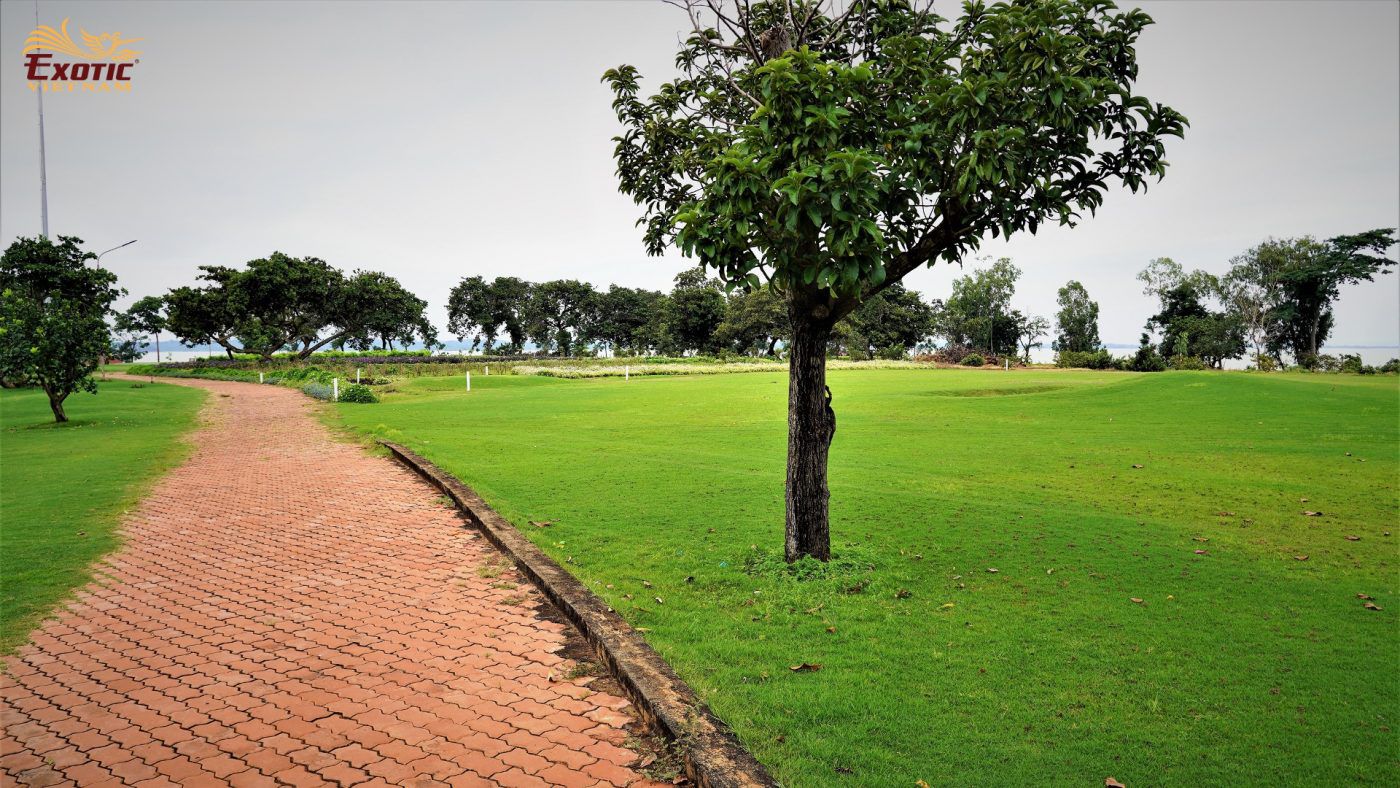
You can enjoy water sports, camping, and team building events held around the islands. The entire area has a resort-like feel, which makes it a great place to visit with family. Photo: Exotic Vietnam
Dao O – Dong Truong Islands
70km from Ho Chi Minh City, O Island or “Buzzard Island” because this used to be the home of this bird species. Surrounded by the immense water of Tri An hydroelectric reservoir, O Island – Dong Truong are two small islands about 30 minutes by boat from the pier. This area has an area of 24ha, mostly covered with trees, lots of grass and flowers and a 300-meter-long pontoon bridge connecting the two islands. With fresh, green air, refreshing water and many services such as accommodation, dining, swimming pool, etc., this is an attractive place to attract tourists to rest, entertain, and participate in team building activities.
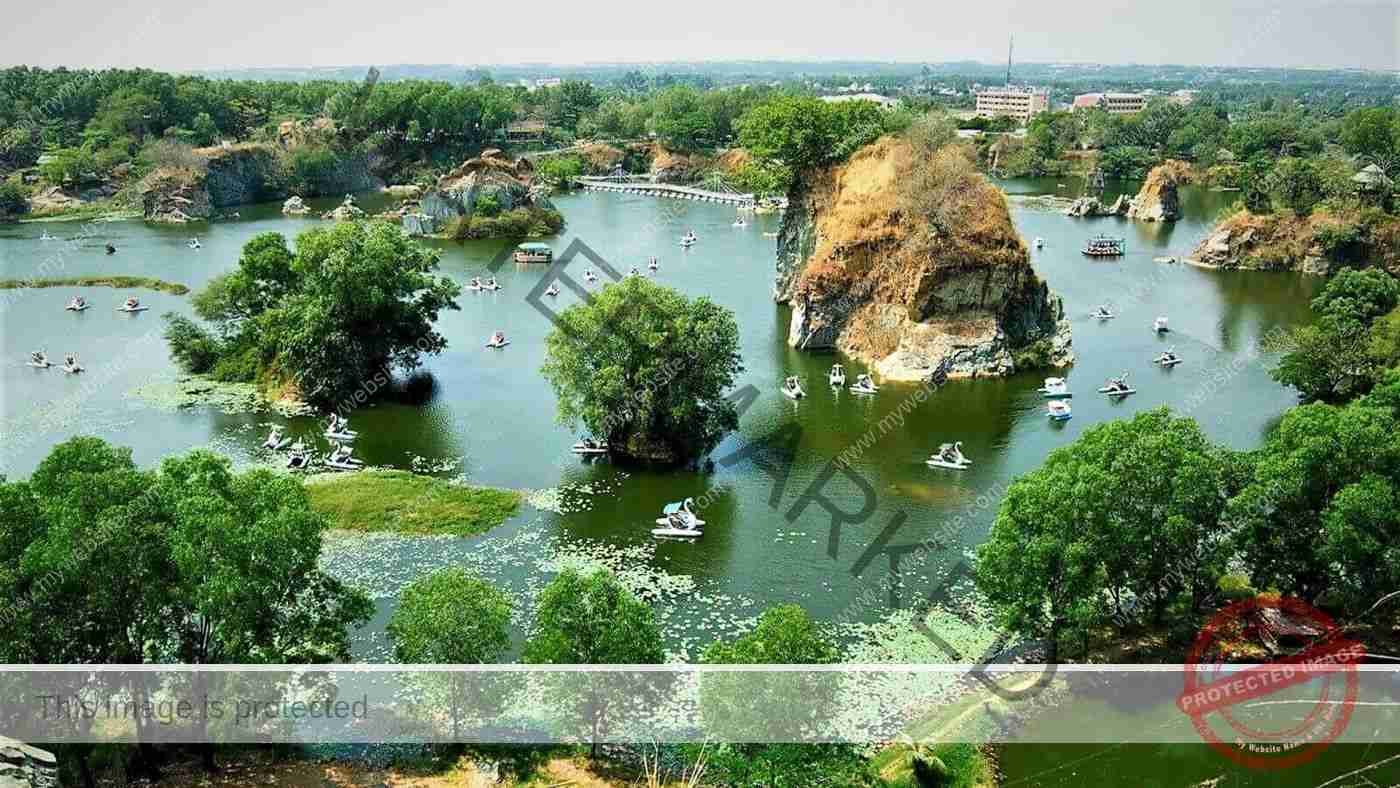
Wandering around the ancient pagodas will make you feel like you have stepped back in time. Besides experiencing other popular things to do include frocking on pool, boating on lake, sightseeing the orchids, camping overnight, etc. Photo: Internet
Buu Long Park
Located just 30km from Ho Chi Minh City, dubbed by the locals “miniature Ha Long Bay”, Buu Long Park is famous for the image of small islands rising on the calm water of Lake Long An (Hidden Dragon), which is an ideal place to escape the harsh sun of Saigon.
Originally a dense mountainous area, many monks came here to practice and build pagodas. Now you can see the ancient Buu Phong pagoda on Binh Dien mountain built in 1676, which still keeps many valuable ancient artifacts.
Due to the need to develop Saigon, the South government used to mine open-pit quarries here to make roads and build houses. This mining was stopped in the late 1980s. The mining mountain part is concave to become a lake, the unexploited rocks become small islands. The old quarry has become a giant rockery, the deepest place is about 20m, on an area of nearly 20ha.
Buu Long Park covers an area of 84 ha, including natural landscapes as mountains, lakes, caves, architectural values as pagodas, temples, … and many green patches of forests and grass. Tan Trieu pomelo village and Buu Long stone carving village with a centuries-old history are also interesting points near the park.
This is a wonderful team building destination with a spacious, green, refreshing, and very close to Ho Chi Minh City.
TEAM BUILDING IN VUNG TAU

Surrounded by calm warm waters, white sandy beaches and lush coastal forests, Vung Tau has been attracted visitors for centuries. This is the perfect place to spend a holiday to see many historical sights, do vibrant outdoor activities and sample fresh seafood and relax with hundreds of accommodation options. Photo: Exotic Vietnam
Location: 125km east of HCMC (2½ hours by car or 1¼ hours by hydrofoil or 30 minutes via Ganh Rai Bay from Can Gio)
Introduction: The French called it Cap Saint Jacques and used it as a weekend getaway. Vietnamese and foreign visitors are drawn to Vung Tau’s exticing beaches, idyllic seaside resorts, French villas and seafood restaurants. In the surrounding province there are hot springs, serene religious monuments in the mountains while Long Hai, Phuoc Hai and Ho Tram have become a popular destination for those who wish to hide away from the hustle and bustle of Ho Chi Minh City. Nearby Long Son Island offers a unique cultural treasure. The local population is dedicated to preserving traditional values in architecture and lifestyle in the island’s famous Big House. This is a place that holds great appeal for holiday makers and sightseers alike.
Your reward is an unbeatable panorama: all sky, sea and white sands with Big Mountain at one end and, at the other, Small Mountain, and a very long stretch of reserved forest and pristine beach – which extends for 50km between Vung Tau and Binh Chau.
Highlights: Con Dao Islands, Binh Chau thermal spring, White Villa, Ho Tram & Ho Coc Beaches, Museum of Worldwide Arms, Binh Chau – Phuoc Buu Nature Reserve, Long Son Island.
Facilities & services: international standard hotels and restaurants and water sports: jet skiing, parachuting, etc.
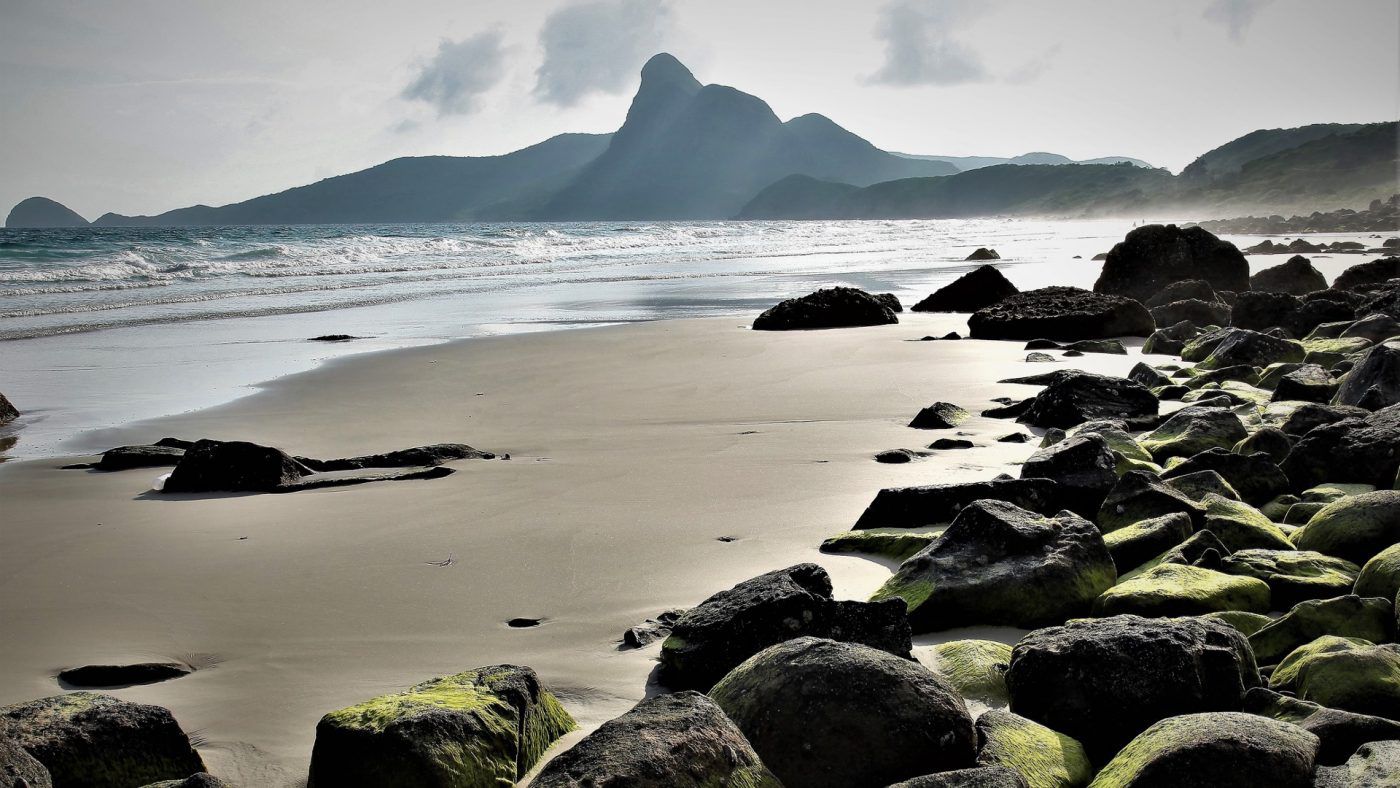
Isolated from mainland, Con Dao has a dark fingerprint owed to its colonial past. Now it’s a secluded paradise where the varied travelers can find white sand beaches, astonishing forests, stunning coves and some of the best scuba diving spots in Viet Nam. Photo: Exotic Vietnam
Con Dao Islands
About one hour by plane from Ho Chi Minh City or one hour and a half by speed boat from Tran De Port, the Con Dao Islands is a group of 15 islands surrounded by deep blue ocean and covered in thick vegetation. The largest island in the group, Con Son Island, covers an area of 51sq.km and is ringed with scenic coves, white sandy beaches and colorful coral reefs.
Established in 1993, Con Dao National Park covers an area of 19,998 ha comprising of a part of the island (5,998 ha) and the surrounding sea (14,000 ha). Many species of corals as well as sea turtles, dolphins, and endangered dugongs are found here. Hon Bay Canh Island is renowned for its turtle breeding grounds, so if you’re visiting between June and September, you may even get a chance to watch turtles laying their eggs.
The Europeans called this majestic island Poulo Condore which means “island of squashes”. From 1862, Con Son was a big prison for Vietnamese fighting French colonialism and later the American-backed Saigon government during the Viet Nam War. The prison complex or “hell on earth” such as: Phu Hai Prison, Phu Tuong Kamp, Cow Shed, American Tiger Cages, French Tiger Cages, etc. has become the must-see destination here. The Phu Hai Prison is the largest and best preserved, while the Phu Son Prison is where prominent communist leaders were held.
Today, there are many opportunities to hike into jungle, observe wildlife, dive in emerald waters and relax on deserted beaches. Con Dao is for nature enthusiasts!
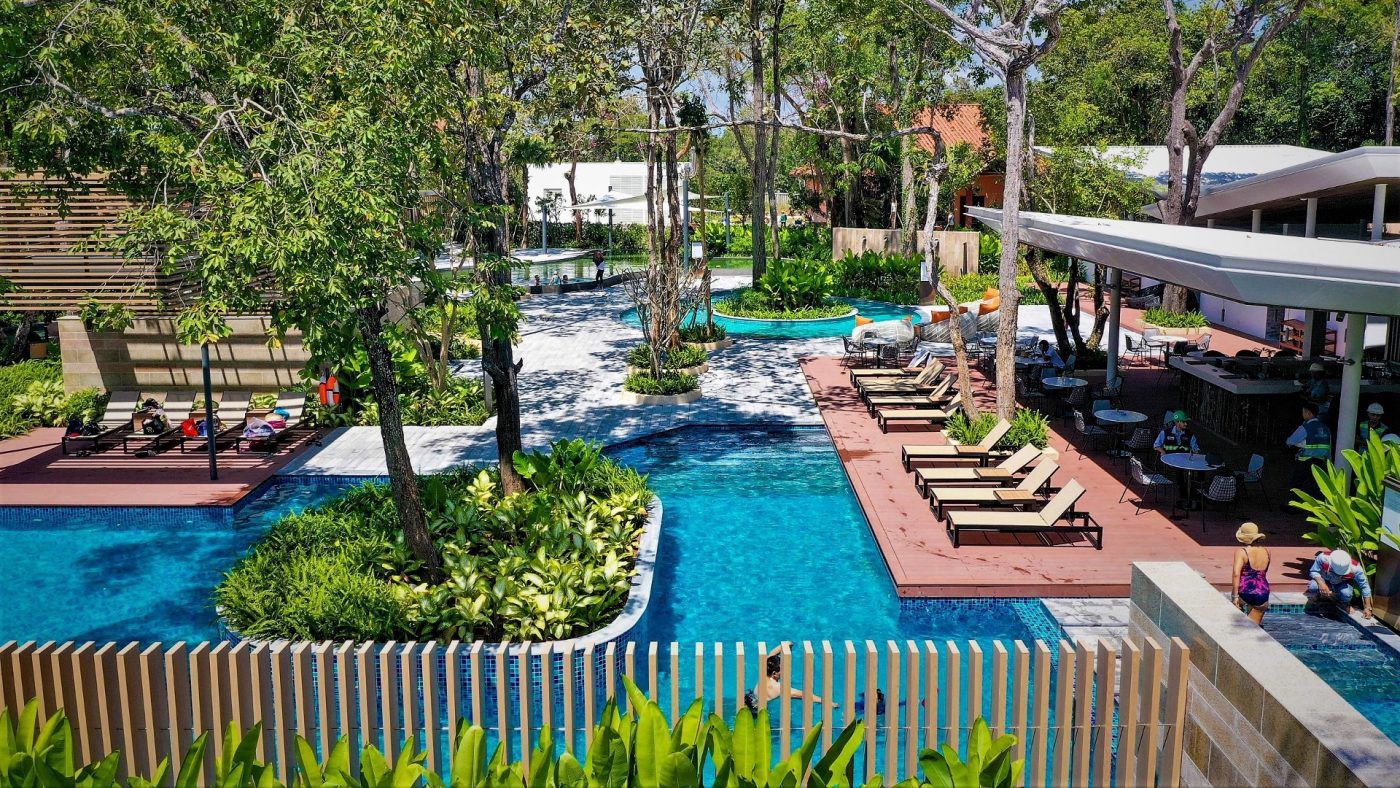
Unwind at Binh Chau Hot Spring where you can swim in the thermal waters surrounded by lush foliage. Originating from deep tectonic faults in the Earth’s crust, mineral hot springs here contain more than 24 chemical components such as: Fe2O3, NH3, H2S, CO2, etc. which are thought to have curative benefits. Photo: Internet
Binh Chau Thermal Spring
About 60km from Vung Tau, discovered by a French doctor named Albert Sallet in 1928, Binh Chau thermal spring, which is said to have curative properties for a number of diseases such as ascites, chronic intoxication, skin diseases, neurological or cardiovascular diseases, etc.
Water from a 3,000m depth is pushed to the ground by hot mineral gas pressure to form many eruptive spots with hot mineral water which will create hot water lakes and streams. There is a cluster of 70 visible gushers spout water at temperatures ranging from 40 to 82oC, forming a huge natural pool of hot water and mud.
A hot bath in a tub will make visitors feel fresh and relaxed after a long trip. Covering an area of 35 ha, the diversified topography of forests, beaches, lakes, hills and creeks also create favorable conditions for such outdoor activities, as camping, trekking, fishing, etc. Besides the area is also convenient for scientific research work on the primeval fauna and flora of tropical seas and forests.

Visiting Bach Dinh, visitors not only have the opportunity to admire the natural beauty with a panoramic view of the coast, the French architecture considered the most beautiful in Vung Tau and learn more about its history but also be admire the rich collection of ancient ceramics collected from the seabed of Hon Cau. Photo: Internet
White Villa
Bach Dinh or the White Villa was built during the French occupation. The mansion sits at the base of Nui Lon overlooking the Eastern Sea and is one of Vung Tau’s major landmark. Work on the mansion began in 1898 and was completed in 1902.
The project was approved by Governor-General Paul Doumer and he himself named this mansion Villa Blanche. In 1907, this place was where King Thanh Thai of the Nguyen Dynasty was under house arrest for 10 years. In 1916, after exiling Thanh Thai and his son Duy Tan to Réunion Island, this mansion was used again as a retreat for the Governor-General of Indochina. In 1934, Bach Dinh was ceded to be a summer retreat for Emperor Bao Dai and Empress Nam Phuong. Later on in the 1960s, Both President Ngo Dinh Diem and Nguyen Van Thieu also used White Villa for relaxation purposes.
The mansion is 50m above sea level and is designed in the style of 19th century French architecture. The garden has an open air dance floor and many statues and details of Greek mythology. The grounds of the mansion still show signs of a once glamorous lifestyle of the French governor who commissioned this building.
These days, Bach Dinh is used as a museum, displaying pottery from the Kangxi Emperor period recovered from an ancient shipwreck in the Hon Cau – Con Dao area, cannons and many valuable artifacts. Others were found through archaeological excavations in Ba Ria – Vung Tau, etc.
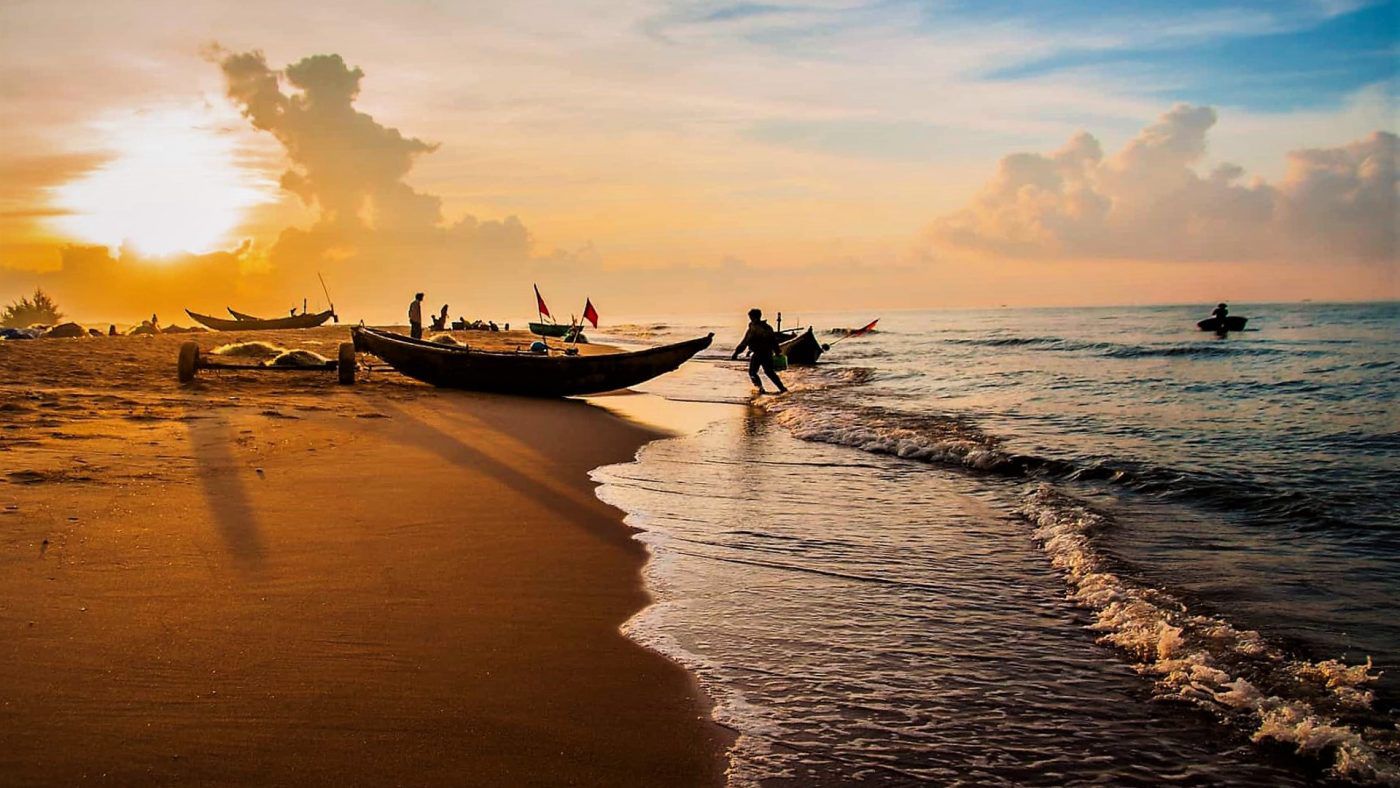
Although famous as the destination of the 5* hotel system, Ho Tram and Ho Coc Beach still retain the rustic fishing villages & seafood markets, the natural forest with its high biological value and the breathtaking landscape of lagoons, sand dunes, and so on. Photo: Internet
Ho Tram & Ho Coc Beaches
Vung Tau is so famous for Back Beach (Thuy Van) in the center of the city. Visitors always want to find something different with everything better from the clarity of water, the fineness of sand and the quality of seaside resorts. Only 40km from Vung Tau, Ho Tram & Ho Coc beaches are a coastal strip between Binh Chau and Vung Tau and a part of Binh Chau – Phuoc Buu Nature Reserve.
It stretches over 20km of fine sand backed by casuarina trees and preserved forests. Crystal water, mild waves, gentle breeze, white sandy beaches and pristine scenery make the natural landscape here more fascinating for visitors of all ages. The beach offers a wide range of accommodation options with expansive views of the East Sea, thatched seafood restaurants and camping facilities. Here is a great place for those who want to look for relaxation, sea food, team building playground, or just some quiet time away.

Located in a French old mansion, the Museum of Worldwide Arms displays antique weapon artifacts and military uniforms of countries. You have the opportunity to find colorful costumes in Medieval wars or famous machine guns in World War 2 like Soviet Maxim, German MG34, British Bren, American Thompson, and so on. Photo: Exotic Vietnam
Museum of Worldwide Arms
Opened in 2012, an extensive collection at the museum has about 4,000 artifacts ranging from guns and swords to army uniforms from the Ancient to Modern Period.
They originate from nations around the world such as the United Kingdom, France, Germany, Russia, Japan, the Netherlands, etc. Most weapons such as swords, guns, … are original artifacts dating from the 17th to the 20th century, while the clothes were restored based on historical data. Each artifact conveys interesting historical stories that are wittily narrated to capture your attention for a duration of 2-3 hours.
The museum was collected over 50 years by a British citizen named Robert Taylor. With a passion for antiques he founded the museum and widely introduced it extensively to the public.

Several trails wind through the nature reserve filled with greenery so that you can get up close to nature. The amazing biodiversity of Binh Chau – Phuoc Buu makes it a must visit for nature enthusiasts. Get ready to enjoy thrilling trek, exciting bicycle ride, or unforgettable team building activity. Photo: Exotic Vietnam
Binh Chau – Phuoc Buu Nature Reserve
Established in 1978, the Binh Chau – Phuoc Buu Nature Reserve covers an area of 10,537 ha on a fairly flat coastal sand dune terrain, occasionally exposing granite rocks such as Mt. Hong Nhung (118m), Mt. Tam Bo (130m), Mt. Ho Linh. (160m),…and many basins like oases with fresh water all year round or dried up in the dry season.
This is the only coastal primeval forest remaining relatively intact in Viet Nam. With the advantage of the Diuaceae forest, it’s a habitat for biological species, especially rare and endangered species. The reserve owns an evergreen and semi-deciduous forest ecosystem, with a diversity of plant composition, including 750 species belonging to 123 families, with many rare species in which dau cat species (Dipterocarpus costatus) is considered endemic tree species of the reserve. Regarding animals, the reserve also has 205 vertebrate species of birds, mammals, reptiles and amphibians.
With a 17km stretch of coastline, Binh Chau – Phuoc Buu Nature Reserve is a combination of forest, sea, and animals, which makes a great and majestic beauty like a masterpiece of art. You will be able to breathe the fresh air and immerse yourself in peaceful nature that can no way found in the busy town. Depending on the season, the colors of the forest may change from green to golden, bringing different experiences for everyone. It would be unforgettable to take a trek or participate into a team building activity in the forest.

Discover the real history of Long Son and long-held traditions of Ong Tran’s religious believers. Get up close and personal with nature and greenery when you embark on a bicyclie ride through rustic villages or an inflatable raft on tidal creeks full of mangroves. Photo: Exotic Vietnam
Long Son Island
There is a land in the South Viet Nam, people still hold traditional values: dressing in black “baba”, hair tufts and bare heads. There they spread mouth-to-mouth the teaching words of ancestor from generation to generation. That’s Long Son Island, 90 km southeast of Ho Chi Minh City, right at the gateway to the tourist hub of Vung Tau.
The history of settlement on Long Son is more than 100 years old when the leader named Le Van Muu (1855 –1935) from the Mekong Delta came here to escape from arrest of the French colonialists in 1900. The village was originally called Nui Nua, named after the 183m-high mountain here. At that time this was an isolated island surrounded by lush mangroves, tidal muddy mashes and vast waters. Sir Muu and the villagers have cleared the land for salt fields, rice fields and fishing in a life of sharing and helping each other to overcome difficulties. A complex of traditional massive architectural works on an area of 2 hectares including ancestral temple, school, market, guest house, etc. was erected from 1910 – 1929, called Big House by the locals.
With rivers, mountains, plains, swamps, mangroves and architecture complex of Big House, this is the venue to meet all requirements of a perfect playground for team building activities. The trip helps participants explore the spiritual heritage of Mr. Tran, not only teachings of righteous and moral life, but also sharing the difficulties and obstacles to success.
TEAM BUILDING IN HO CHI MINH

During its history of more than 300 years, Saigon has always been a prosperous city and the largest trading center in the country. Sometimes people have been using beautiful words to praise Saigon as “Pearl of the Far East”. Ho Chi Minh City, Saigon’s new name since 1976, still holds that leading position today. You can always find fun in shops, restaurants that light up every evening or explore the streets filled with long fleets of two-wheelers moving close together without a hit. Photo: Exotic Vietnam
Location: 1,760km south of Ha Noi (1¾ hours by plane from Ha Noi, Singapore, 1 hour by plane from Bangkok, and 2¾ hours by plane from Hong Kong).
Introduction: Ho Chi Minh City (formerly Saigon) is now Viet Nam’s most populous city and the economic powerhouse in Viet Nam. Saigon is the name of a fantastic river flowing through the city. This river gave birth to the Saigon – Cho Lon Port and the most buoyant riverside city in South East Asia as early as the 18th century.
Today Ho Chi Minh City, with a population of over 10 million, is the largest city in Viet Nam and one of the three biggest municipalities in the country (the others being Ha Noi and Hai Phong). The huge numbers of people and their obvious industriousness, street stalls and modern high-rise buildings create a dynamic urban area full of color and atmosphere.
Ho Chi Minh City is a focus of several unique and convenient travel lines with high class facilities and diverse tourist products, worthy of its reputation as a leading tourist center of the region and the whole country.
Highlights: landmark buildings (Notre Dame Cathedral, the City Hall, the Municipal Theatre, Reunification Palace), old pagodas (Thien Hau, Giac Lam), traditional markets (Binh Tay, Ben Thanh), shopping centres, museums (History Museum, War Ramnants Museum, Fito Museum of Traditional Medicine), Cu Chi Tunnels, Skydeck’s Bitexco Tower, Can Gio Biosphere Reserve.
Facilities & services: an international and domestic airport, international standard hotels, exhibition halls, art galleries, conference centers, international banks, shopping areas, hopon-hopoff city-tour bus, stylish restaurants, theatres, nightclubs, bars, and cafes.
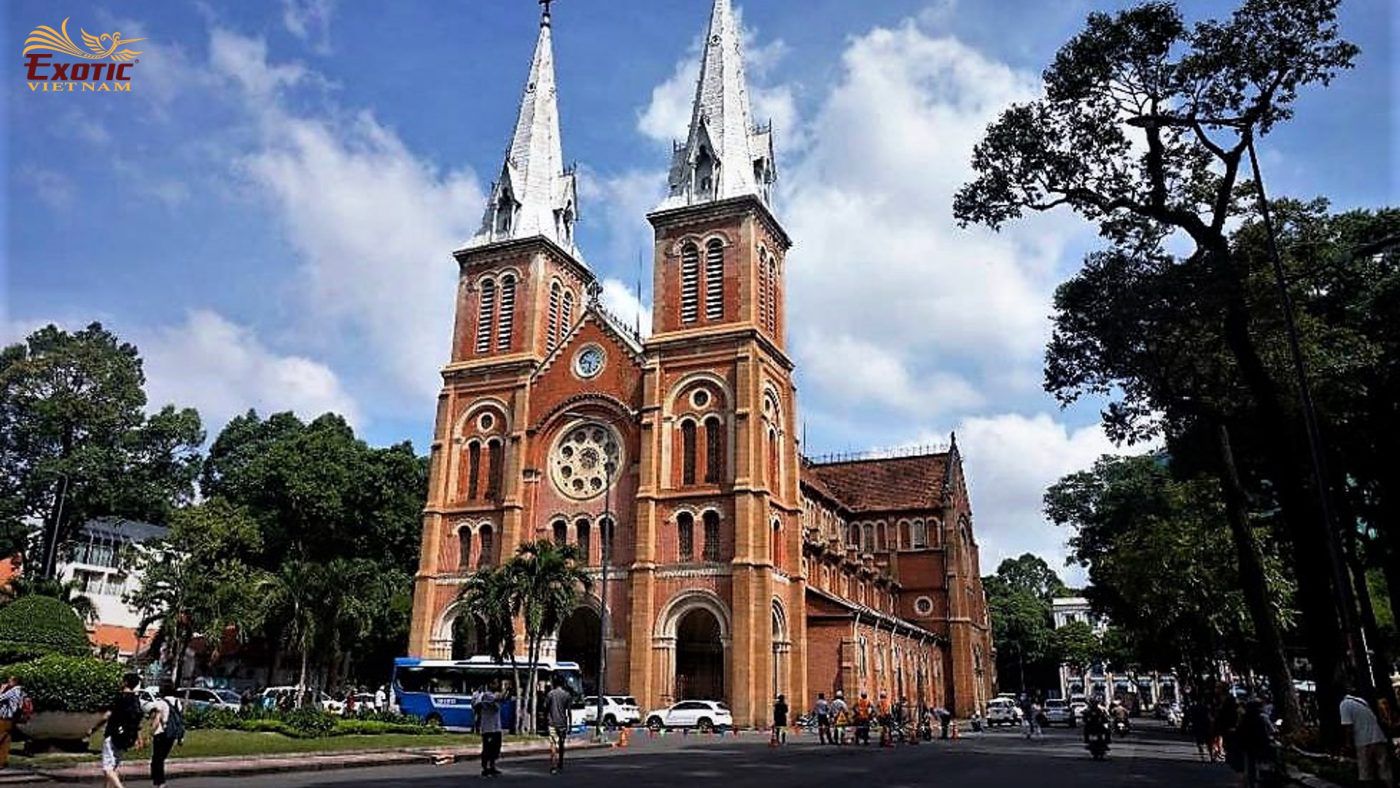
Among world’s 19 most beautiful cathedrals, the Saigon Notre Dame Cathedral is considered to be one of the finest examples of French Gothic architecture in Indochina. Photo: Exotic Vietnam
Notre Dame Cathedral
Built between 1877 and 1880 with all materials for its construction were shipped from France, Notre Dame Cathedral is located right in the heart of the city. Its neo-Romanesque style and two 36.6-metre-high square steeples made it a central landmark. In 1895, the cathedral built two more rooftops to cover the 21-meter-high bell tower, designed by architect P.Gardes. The amazing architecture with the two bell towers, each with the height of 58m, was the most beautiful sacral building in the French colonies. Outside the main building lies a small garden that has the statue of Mary – Queen of Peace. This statue, which is made from marble, was completed by the Italian Sculptor G. Ciocchetti in 1959. The church had a huge renovation from 2017 – 2021.
The church’s capacity can reach up to 1,200 people. Visitors can attend mass held three times on weekdays and Saturdays and six times on Sundays, especially a mass at 9:30 am on every Sunday in both Vietnamese and English. HCMC’s post office overlooks the square in front of the church.
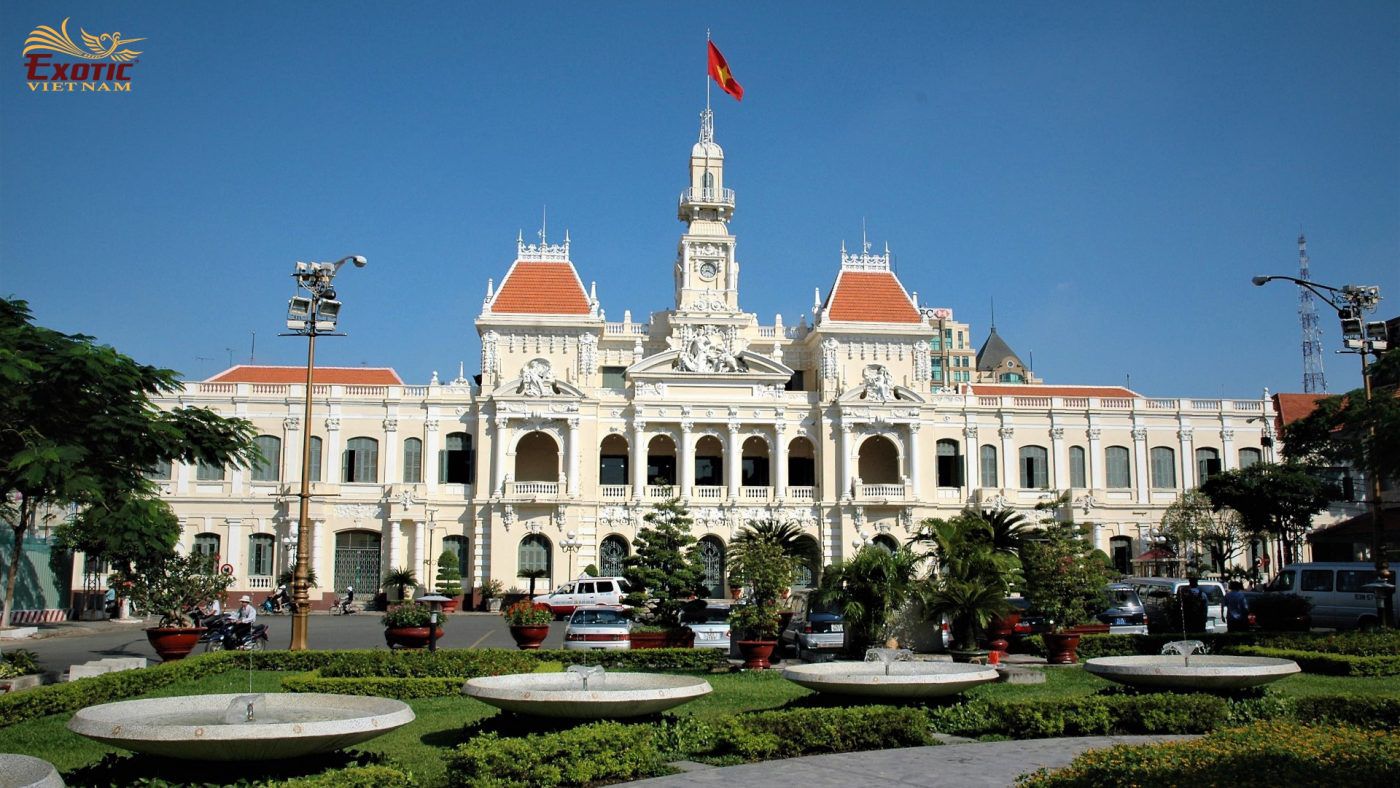
Being a typical work of architectural style, decorative arts in the early 19th century, the City Hall is used as a government building, not open to the public. It attracts a lot of tourists to take photos outside and the pedestrian boulevard nearby. The best moment to do it in the evening when its facade is illuminated by warm yellow lights. Photo: Exotic Vietnam
City Hall
Standing at the end of Nguyen Hue Boulevard, the People’s Committee building is the city hall of Ho Chi Minh City, formerly called the Hotel de Ville. In French style, the building is modeled on Paris’ own Hotel de Ville and was completed in 1908. Facing toward Saigon River, the building is notable for its ornate facade and elegant interior lit with crystal chandeliers. The small park in front has a memorial statue of Ho Chi Minh. Nowadays the building is used for the city administration in daily working and meeting occasions
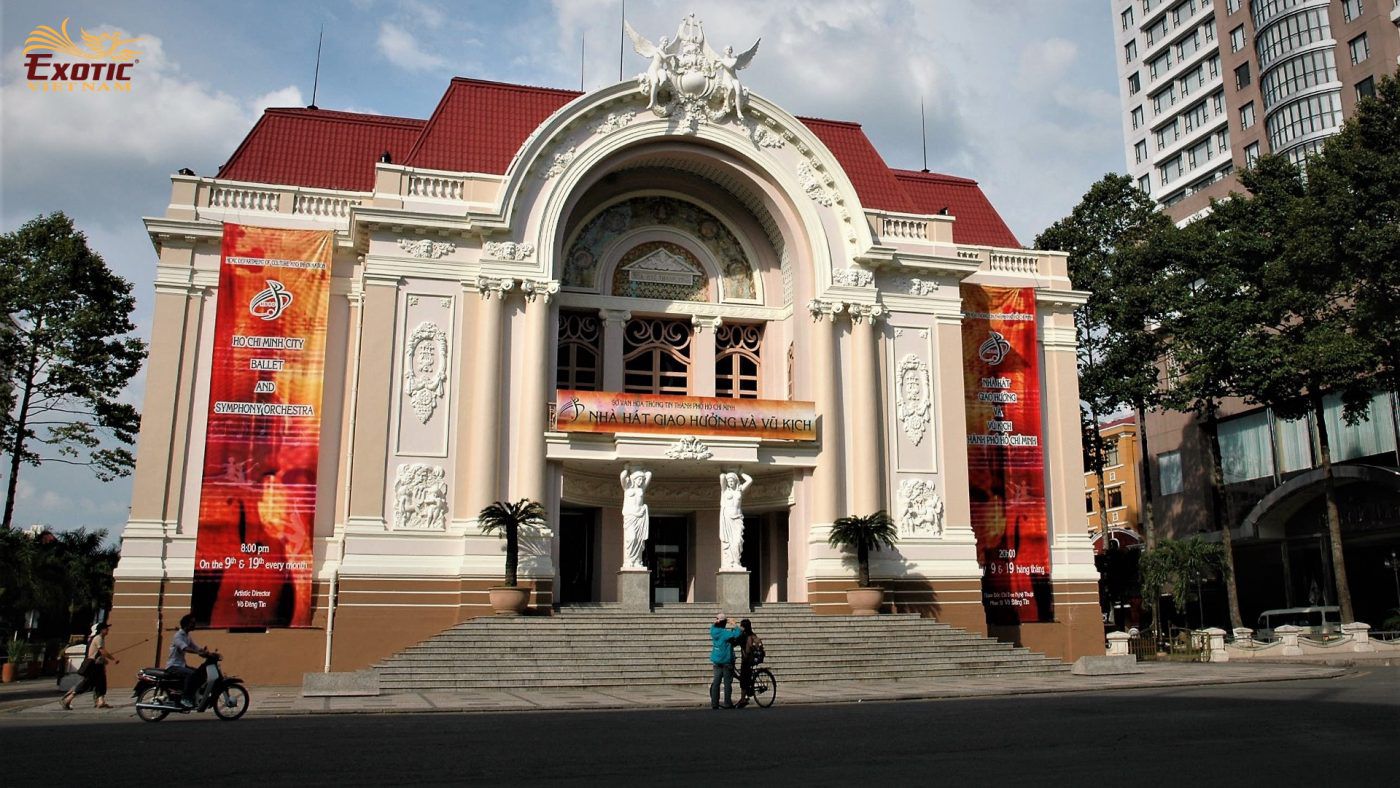
With the façade shaped like the Petit Palais, an art museum in Paris, The Municipal theatre was used as South Viet Nam’s Lower House from 1956. Adorned with many contemporary sculptures and filled with historical values, the theatre is well worth visiting & enjoying performances. Photo: Exotic Vietnam
Municipal theatre
Municipal theatre is in Dong Khoi Street just opposite Caravelle Hotel. It was built at the turn of the century and later renovated in the 1940s. The 3-story building has a seating capacity of 1800. It was built in French architectural style of which the materials were mainly transported from France. A group of French artists was in charge of interior decoration with patterns similar to those in France’s late 19th century opera houses. The theatre finished with spacious ventilation and state-of-the-art sound and light systems. In front of the theatre is a park where young people like to sit around. The theatre often offers different programs such as concert, drama, and ballet. The performance is typically at 8pm. It also has rooms for meetings, conferences, ceremonies, workshops, and other gatherings.

Not only a part of Saigon’s history, the Independence Palace, a famous architectural work of architect Ngo Viet Thu, also shows a harmonious combination between modern architectural art and the spirit of oriental traditional culture. Photo: Exotic Vietnam
Independence Palace
One of the most fascinating sights in HCMC is Independence Palace” (Dinh Doc Lap). Considered as the power symbol of the South Viet Nam government, the building witnessed every historical events happening to the Saigon Government until “the Fall of Saigon” on April 30, 1975. In a short period, it was renamed as “Reunification Palace” to engrave the unforgettable victory of the resistance to unify the country. In addition to historic value, the Reunification Palace is famed for its architecture, which is unique in Viet Nam. Located in the heart of downtown Saigon, the building was built on a area of 12ha, surrounded by immense fences and high trees in its gardens, the palace’s main building is modern architecture of the 1960’s style.
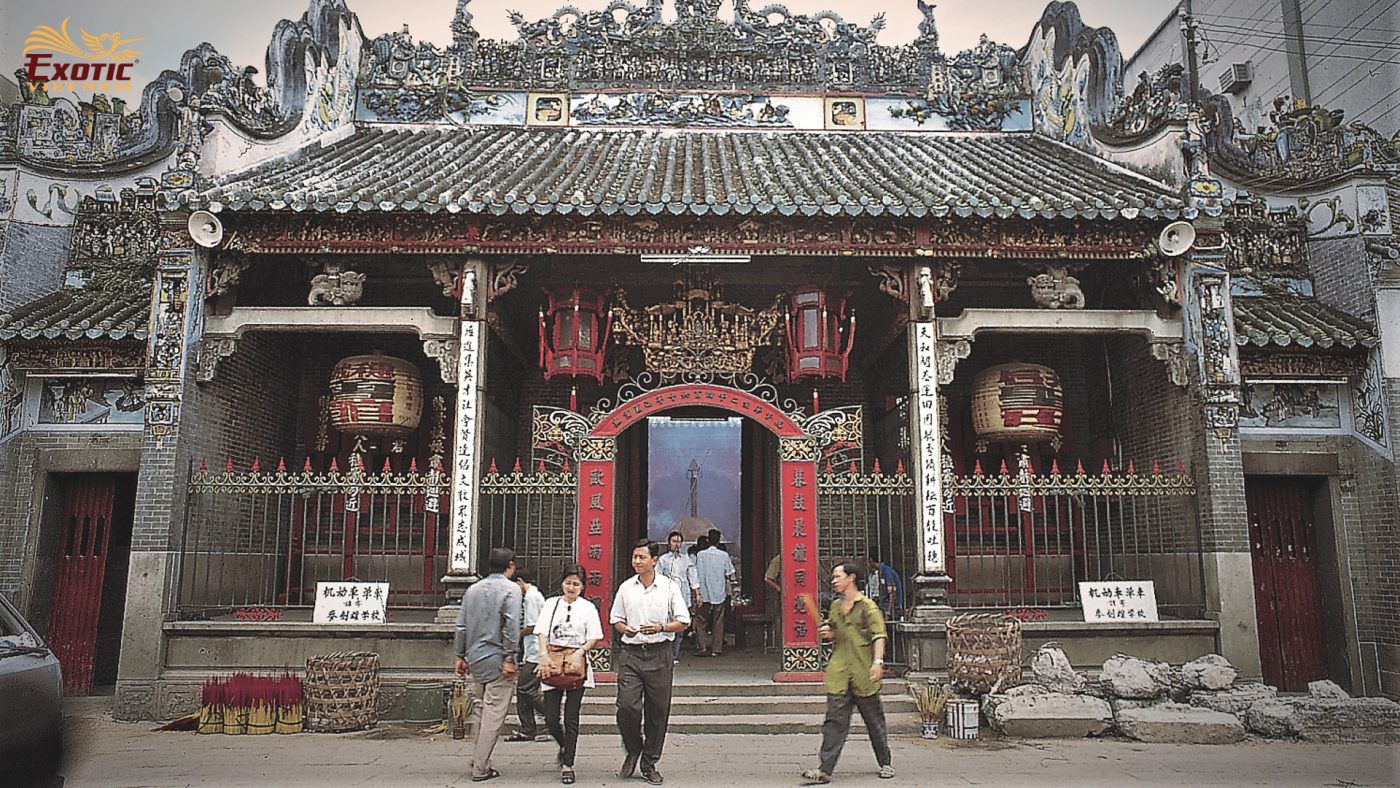
Built in the early 19th century, Thien Hau Temple is associated with the spiritual and cultural life of the Chinese community in Sai Gon. You can also come here to pray for good luck and prosperous life for your families and loved ones. Photo: Exotic Vietnam
Thien Hau Temple
Dating back to the early 19th century, the temple is dedicated to Thien Hau, the Chinese Goddess of the Sea, who protects fishermen, sailors, merchants and other seafarers. Though there are guardians to either side of the entrance, it is said that the real protectors of the pagoda are the two land turtles living here. The temple’s interior courtyard with intricate ceramic friezes is worth seeing with beautiful ceramic figurines and antiques, commemorating the arrival of the first Chinese immigrants from Canton. On the 23rd day of the 3rd lunar month, the biggest ceremony is held in Thien Hau temple to her honour. People pray to her for happiness, prosperity, and solidarity.
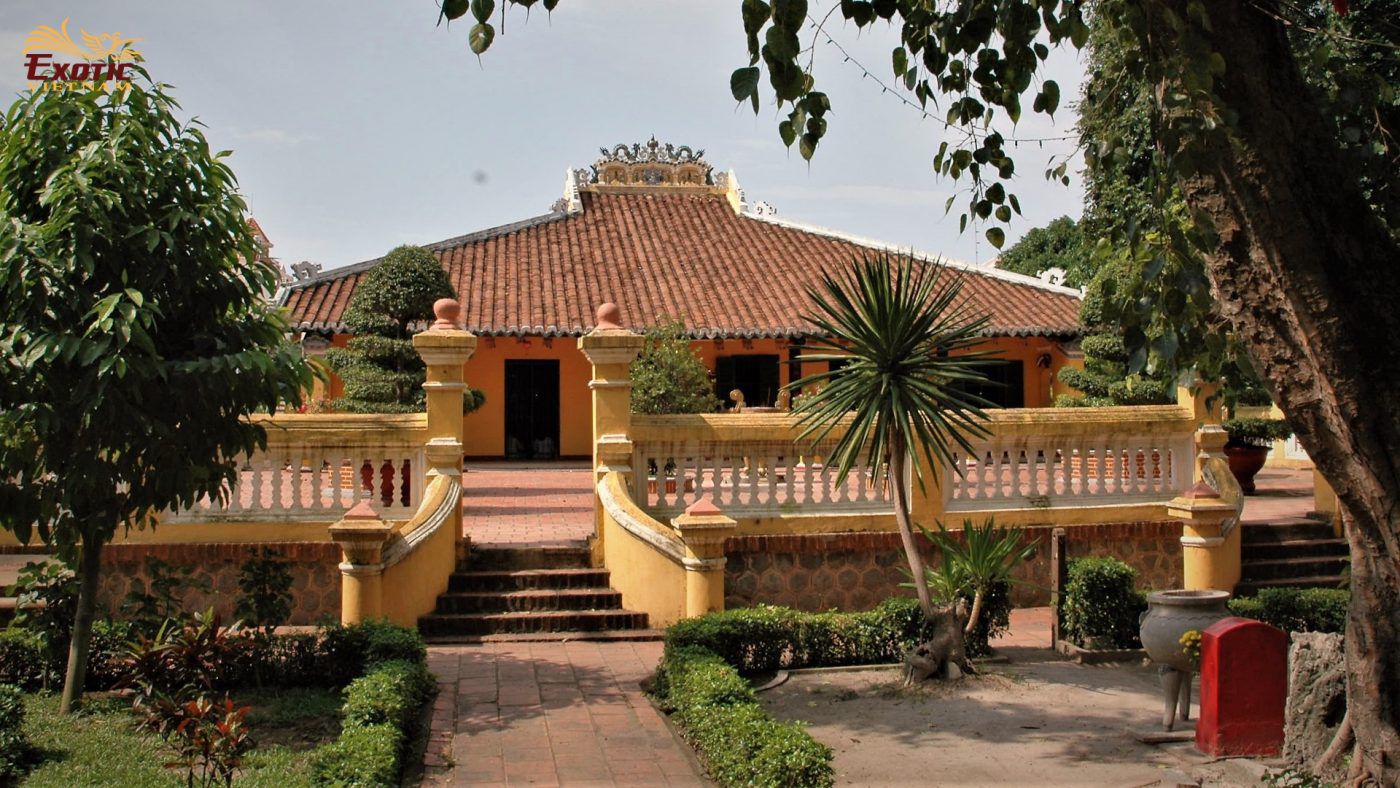
Experiencing so many ups and downs of history, Giac Lam Pagoda still preserves traditional architecture that are 300 years old. Not only visiting valuable artifacts, visitors can also share information about Buddhist philosophy from monks or try a vegetarian meal at the pagoda. Photo: Exotic Vietnam
Giac Lam Pagoda
Built in 1744, Giac Lam, the oldest pagoda in HCMC, reflects the architectural style of pagodas in southern Viet Nam. The pagoda impresses visitors with remarkable 98 carved wooden pillars, gilded descriptions in old Vietnamese characters, and 113 Buddha statues made from jackfruit wood. The Buddha statues of Giac Lam pagoda are famous for their fine sculpture. On the left of the pagoda’s main gate is a seven-story tower built in 1994 in which each level is reserved to worship a Buddha and the top level for the sacred relics of the Sakyamuni Buddha. Giac Lam pagoda is acknowledged as Nation Heritage.
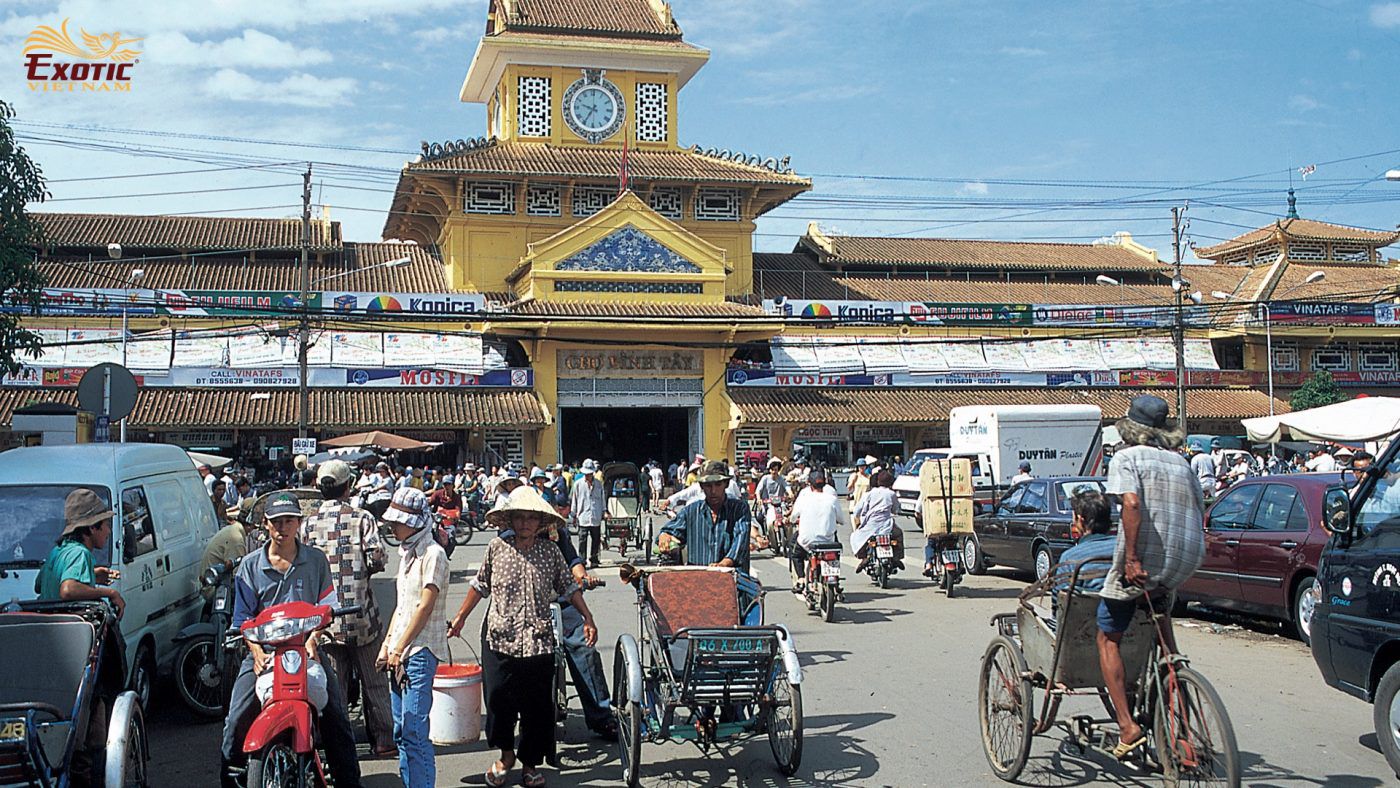
Sights, sounds, smells, countless stalls of small shops selling all sorts of things… sharing a few laughs, bargains with locals will definitely make your visit to Binh Tay Market become memorable. Photo: Exotic Vietnam
Binh Tay Market
Quach Dam, a Chinese merchant, spent money to buy over 25,000 sq.m of muddy land at Binh Tay village, leveled it, and built a new market to donate to the authorities in 1928. To serve the business, he asked for permission to build a few rows of storeyed shop houses around the market. From 2017 – 2018, the market underwent a comprehensive restoration. The founder’s memorial as a sacred place to pray for good luck in business can be found now at the middle courtyard in the market.
Covering an area of more than 17,000 sq.m, the market with four facades looks like a Chinese citadel, was built with Asian architectural style but applied contemporary Western techniques and was considered the largest market in South Viet Nam. The market was originally called Cho Lon Moi (New Big Market). After 1975, it had the new name – Binh Tay Market and has still kept the biggest wholesale market in Viet Nam dealing in a wide variety of goods made by the Chinese community and products from all over the country.
Today there are 2300 stalls in the market for food and spices, the highest percentage of which is found in household goods, ready-to-wear items, foodstuffs and other commodities. Visitors are encouraged to stroll around the market, to socialize themselves with the locals.

As a symbol of Saigon – Ho Chi Minh City, Ben Thanh Market is a familiar destination to enjoy popular dishes delicately prepared by hereditary chefs during the day as well as after sunset. Photo: Exotic Vietnam
Ben Thanh Market
Built in 1914 and known to the French as the Halles Centrales, the market, last renovated in 1986, is located right in the heart of the city where everything can be found, from vegetables and fish to branded goods and local handicrafts. Here, you also find eating stalls inside the market where you can get a taste of hawker-style Vietnamese cuisine or simply cool off with a cold drink when the bargaining becomes too much.
Ben Thanh Market at night is also an interesting hotspot to experience. From 6pm to 10pm every night, various lines of stalls are lit up with neon lights on both sides of Phan Boi Chau and Phan Chu Trinh streets. They create a vibrant street scene, showing different street foods in an eye-catching way to attract gourmets, filling the air with the scents of wok-fried noodles, barbecued fish and meats. Many locals as well as tourists gather to eat and drink in the noise and cool afternoon river breeze.
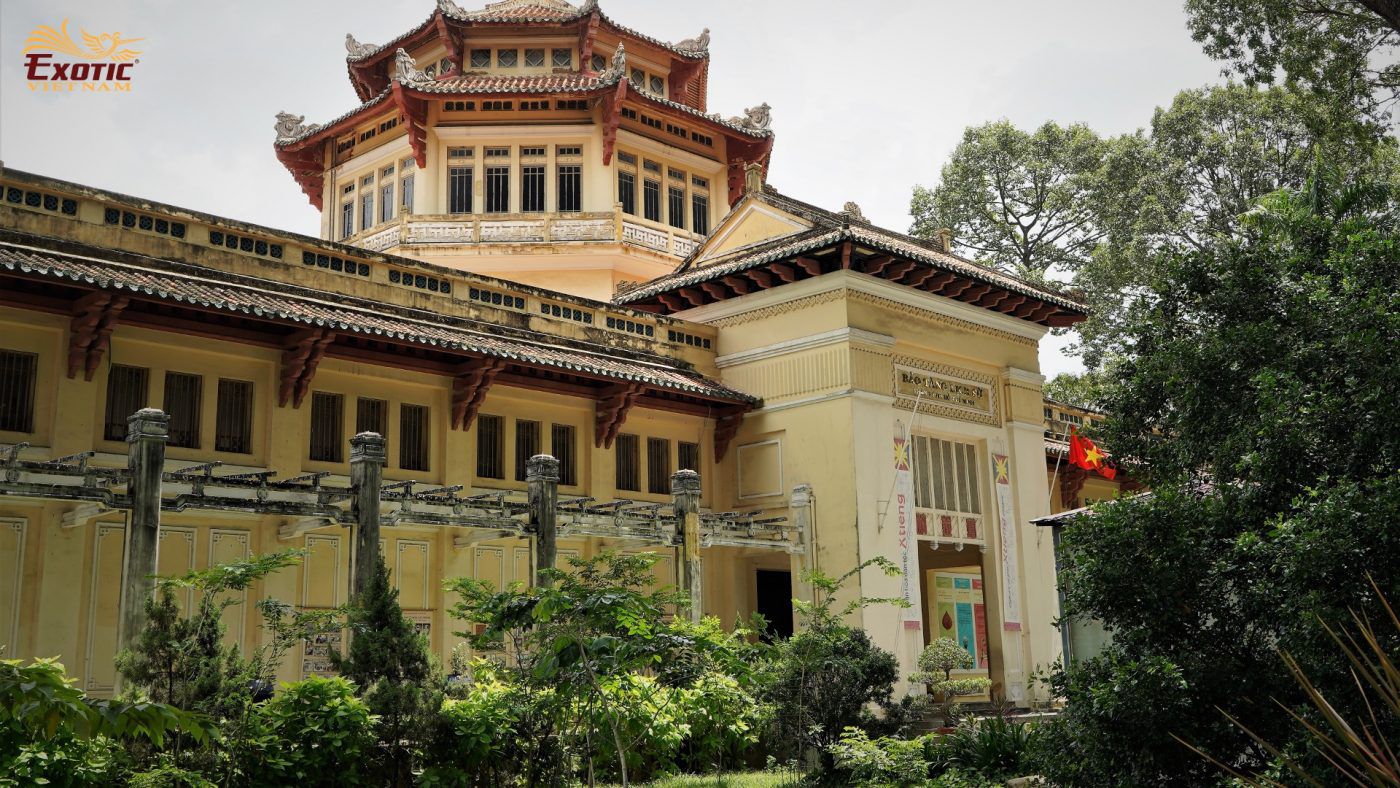
After a number of renovations, the History Museum still retains the original architecture designed by Delaval, a French architect. Through the various displays, visitors have the opportunity to experience the feeling of nostalgia in the past thousands of years and know more about the long and proud history of the Vietnamese people. Photo: Exotic Vietnam
History Museum
In 1929 this museum was built within the boundaries of Zoological and Botanical Garden to serve as “Musee blandchard de la Bross” and later became the “National Museum of Viet Nam” with a collection of ancient art from several Asian countries. In 1975 the Museum was renamed “History Museum in Ho Chi Minh City”. The museum now displays an excellent collection of artifacts representing the evolution of Vietnamese people and featuring the characteristics of its culture. The artifacts are divided into 2 groups: the Viet Nam’s history from the first human vestiges (some 300,000 years ago) until the establishment of Vietnamese Communist Party (in 1930); and the second group is represented the cultures of the southern provinces such as the Oc Eo culture, the Cham art, the culture of Ben Nghe-Saigon area, the ethnic groups in Viet Nam, the collection of Buddha statues in Asia and an ancient ceramics from Asian countries.
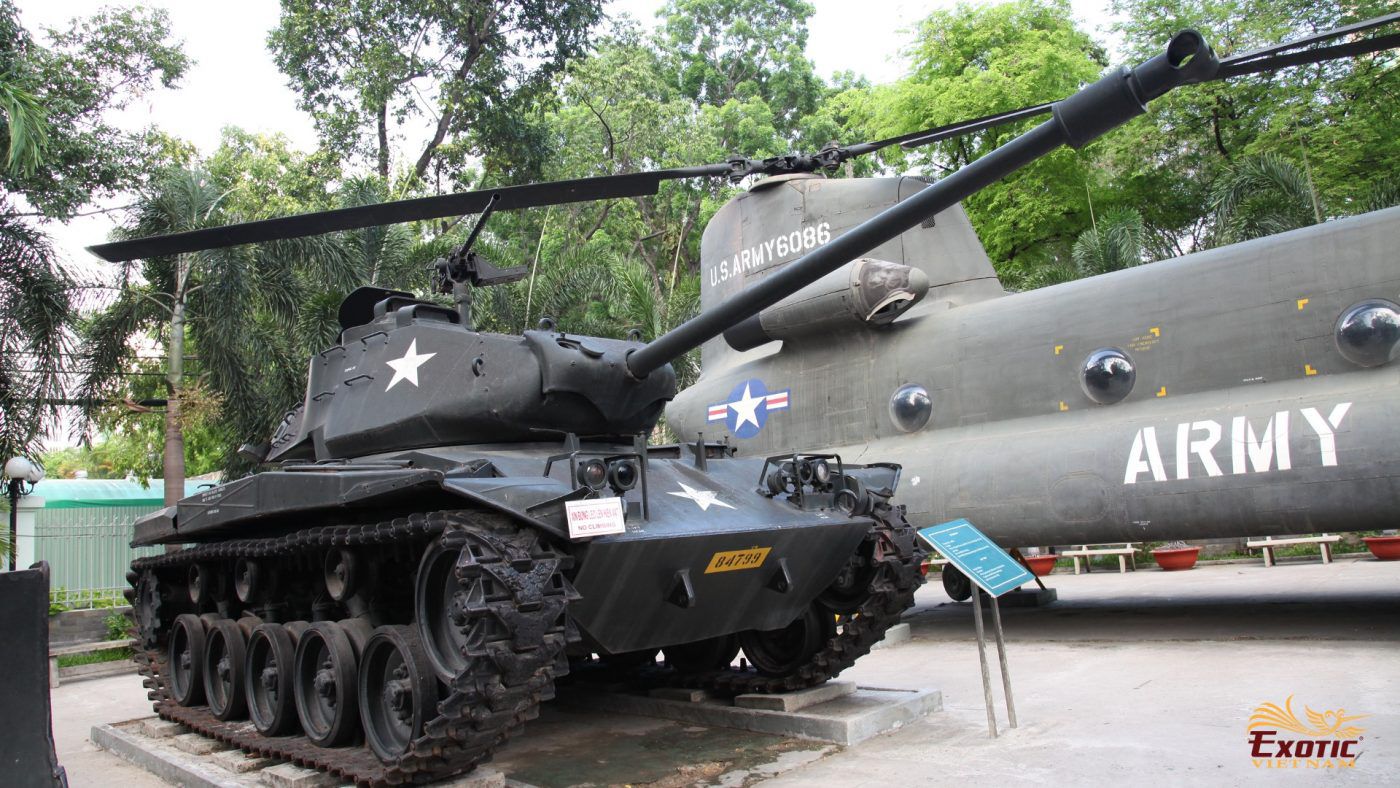
Not only war vehicles such as planes, tanks, etc. are exhibited outdoors, but also terrible artifacts and images on display inside help condemn the cruelty of war. All to remind us why peace must be treasured and preserved. Photo: Exotic Vietnam
War Remnants Museum
Established in September 1975, the museum was formerly known as the Museum of American War Crimes, then changed as the War Remnants Museum. The museum keeps things remained from the War such as tools of torture, photographs of atrocities committed during the 20th century and, in particular, the Viet Nam War. At the front yard of the museum there is a small collection of military hardware and, most interestingly, the mobile guillotine used by the French colonists to dispense justice throughout the country before World War II.
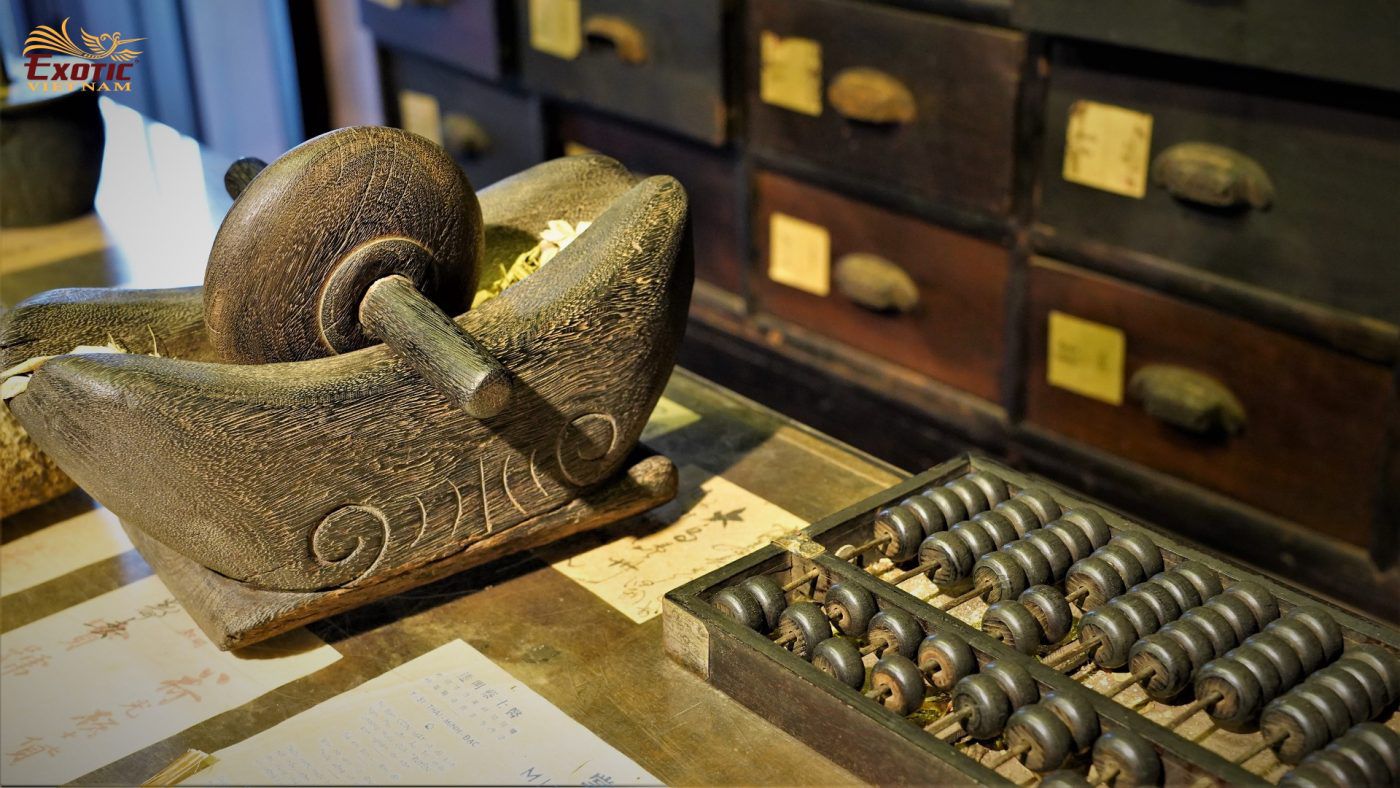
Located in the middle of a busy street, the Fito Museum of Traditional Medicine is designed in a traditional style with wooden structure and decoration. Visitors have the opportunity to learn about the theory of yin and yang, the five elements that traditional medicine treats diseases from the root, bringing high efficiency and sustainability. Photo: Exotic Vietnam
Fito Museum of Traditional Medicine
Opend in 2007, Fito Museum impresses with its striking sculptural interiors made of wood. There are 6 floors with a total of 18 rooms, covering an area of 600 sq.m. Firstly a documentary film introduces the overview of history of medicine in Viet Nam. Then the sightseeing starts from the upper floor, gradually going down to the lower floors. The museum has nearly 3,000 precious items, some of which are artifacts from the Neolithic period to the present day. Exhibits include tools used to prepare medicine, knives, mortars and pestles, documents and objects of a traditional pharmacy. A small shop with a variety of traditional medicines for common ailments is sold on the ground floor. It is truly a worth-visiting place for those who appreciate the uniqueness of Vietnamese traditional medicine.
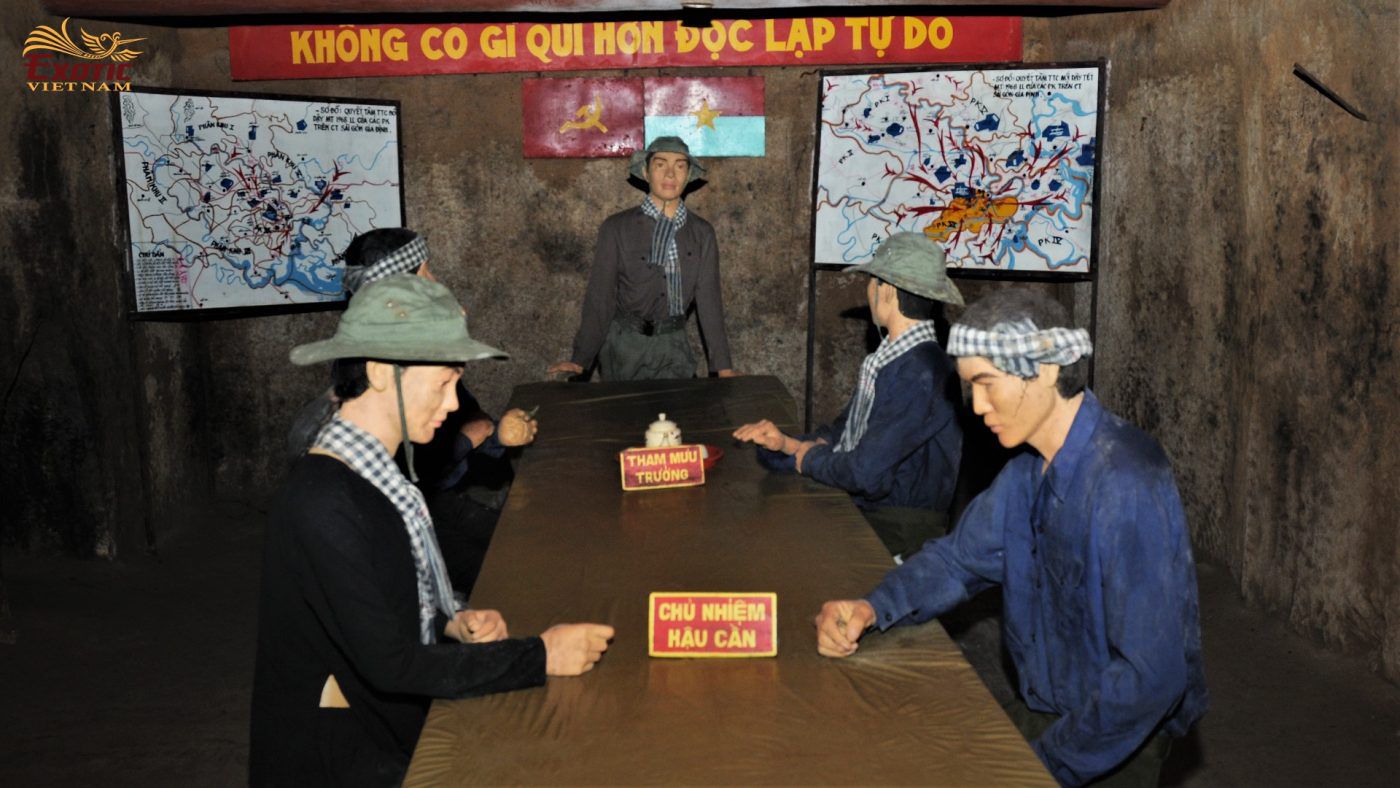
Visit Cu Chi to learn the secrets of war time such as the sudden disappearance of guerrillas while fighting, how to keep the tunnels strong against bombs, etc. Cu Chi Tunnels are an epic to be remembered forever. Photo: Exotic Vietnam
Cu Chi tunnels
About 70km from downtown HCM city, Cu Chi used to be a bitter battle ground for many years during the Viet Nam War. Visitors should not miss this intricate network of over 200km of tunnels at Ben Duoc or Ben Dinh. The digging of the tunnels began in 1946 during the anti-French resistance and continued until 1975.
The underground tunnels and bunkers were used by guerrillas as spots to fight in face-to-face combat with American soldiers, as well as a communication and supply lines, a field hospital, a warehouse for food and weapons, and a hiding place for troops before big campaigns. The tunnel system played an extremely important role for the Liberation Front of South Vietnam in the resistance war against the US to save the country, and made a great contribution to ending the Viet Nam War.
Pleasant eye-catching sights on the way to Cu Chi are green rice paddies, peasants at work and children riding aimlessly on water buffaloes. That’s great to snapshot.
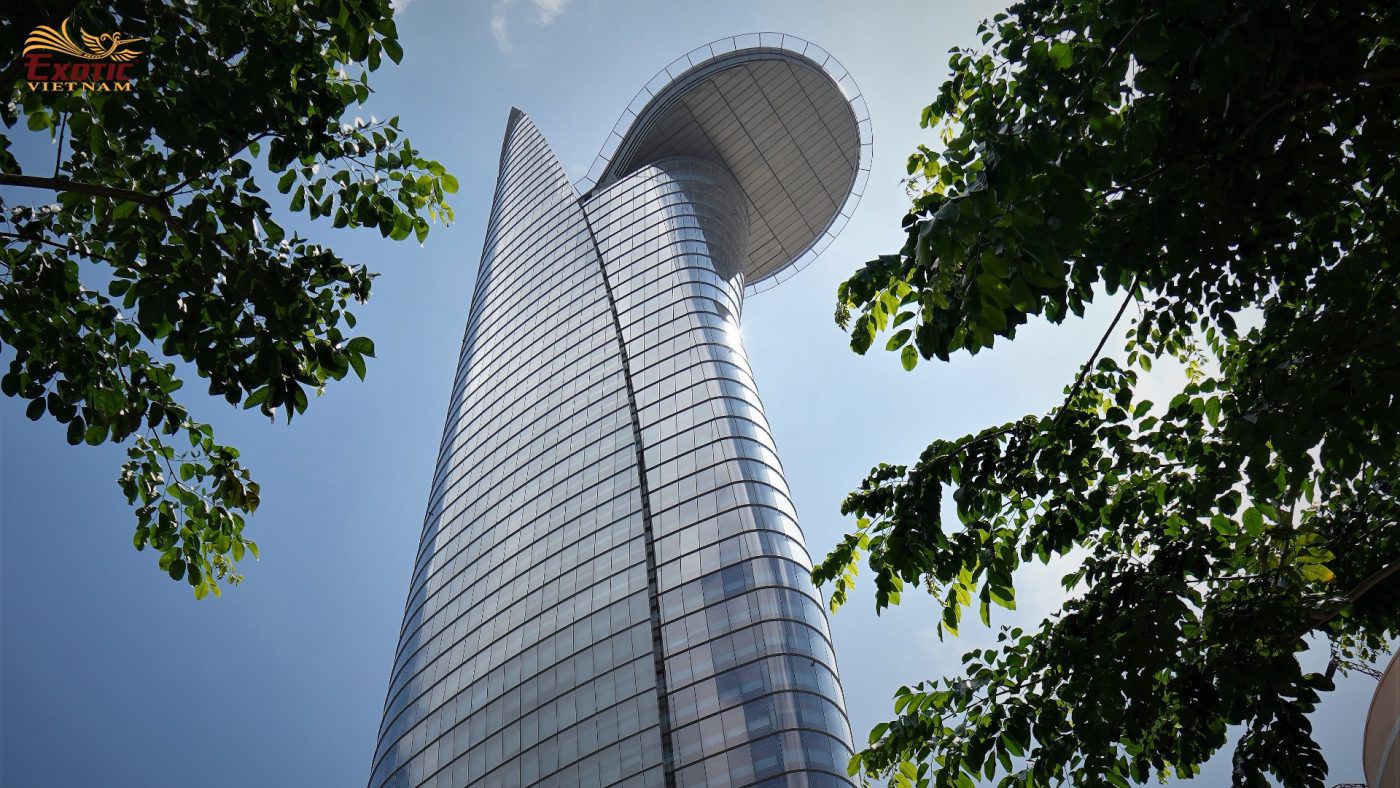
As a symbol of the beauty and rapid development of the economy of Ho Chi Minh City, the Bitexco Tower is a must-see spot in Sai Gon where visitors can enjoy a bird’s eye view across the bustling city. Photo: Exotic Vietnam
Skydeck’s Bitexco Tower
Opened in 2010, Bitexco Tower boasts Viet Nam’s one of tallest towers at the height of 262m. This building can be seen from many places in the city and has become a new icon of dynamic Saigon. Ride one of the fast lift to Skydeck at the 49th floor where visitors can admire 360-degree view of Saigon. It’s amazing to get definitely superb views of both the urban and rural parts of Saigon, the French architecture against the old Vietnamese buildings, as well as major landmarks, such as Ben Thanh Market, Opera House, Notre Dame Cathedral, and the Independence Palace. The view is more marvelous at sunset with all lights shimmering.
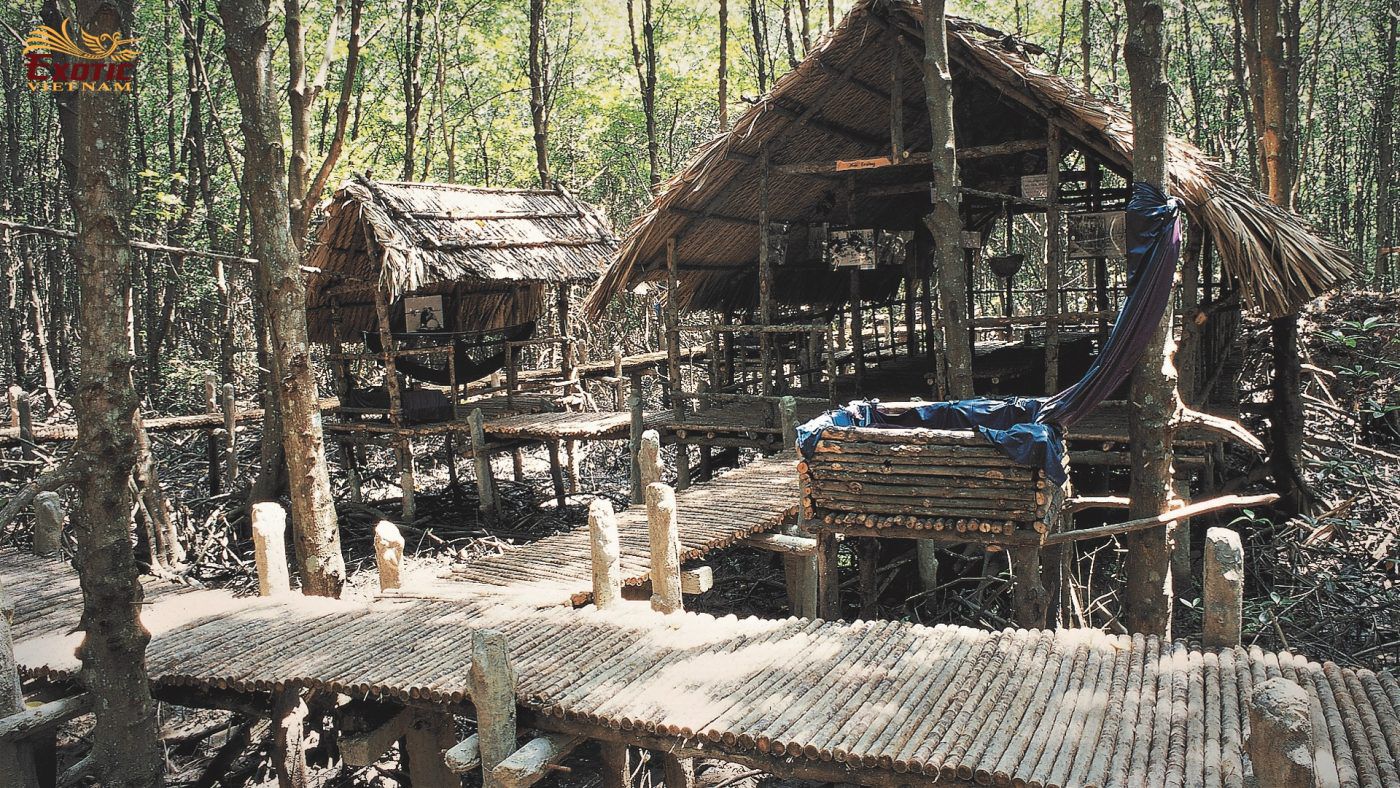
At the intersection of land and sea, mangroves are one of the most sensitive ecosystems on the planet. Explore the mangroves by boat and encounter the beautiful tidal creeks and abundant wildlife in the area including fish, monkeys, birds, etc. before it disappears under the impact of massive projects. Photo: Exotic Vietnam
Can Gio Biosphere Reserve
Recognized by UNESCO in 2000, Can Gio Biosphere Reserve is located in the coastal district, 60km southeast of the centre of HCMC. Formed by alluvium from estuaries of Dong Nai River, this brackish low-lying land covers an area of 75,740 hectares including creeks, marshes and waters strongly influenced by semi-diurnal tides (2 main cycles per day).
Regarded as the city’s “green lung”, the mangrove forest in Can Gio is home to the highest diversity of mangrove species, invertebrates, fish and shellfish species. This sensitive ecosystem is easily damaged by any very small impact. In the heart of the forest, it is worth visiting a historic site that recreates the life of aqua commandos with plaster figures, wooden houses on stilts, diagrams of major battles,etc.
In 2021, Can Gio has been approved by the authorities to become an urban centre of entertainment, tourism and commerce featuring a 2,870-hectare sea reclamation project. Luxury villas, apartments, golf course, marinas, themed parks, etc will be sprouted. A big sea dike construction to separate Ganh Rai Bay from the sea has been mentioned nowadays. These matters will cause negative effects on the sustainability of the mangrove environment that needs to be conserved here.
TEAM BUILDING IN THE MEKONG DELTA

Boat riding is a great way to visit the Mekong Delta. Drift along the large rivers and a maze of narrow creeks for its riverine beauty. In addition, you can visit orchards or raft fish farms, cook local dishes, nap in a hammock or spend a night in a homestay. Photo: Exotic Vietnam
Introduction: Formed by enormous amounts of fertile alluvium from the Mekong River and its many tributaries, the Mekong Delta, though only 12% of land area, produces about half of the country’s total agricultural output. That’s why this 40,000 sq.km delta is called as Viet Nam’s “rice basket”.
Life in the Mekong Delta revolves around the water that includes immense rice fields, seasonally flooded lotus and melaleuca lowlands, lush coastal mangroves and criss-crossed creeks bordered on both sides by dense palms, and so on. Communities of Vietnamese, Khmer, Cham and Chinese ethnic groups mostly live in cities and villages that are often built on high mounds running along rivers. In this way they can avoid flooding during high water season which is called the float season. Boats of many shapes and sizes are commonly used to travel on a maze of waterways. The main attractions of the Mekong Delta are dominated by the verdant landscape of glistening rice fields, fruit-laden orchards, chaotic floating markets where hundreds of boats gather on the river and the sincerity and hospitality of local residents.
Team building programs take people discover a riverine world on foot, on bicycle or even on rowing sampan with challenges that simulate daily life from planting, harvesting to preparing rustic style dishes. Exotic Vietnam’s team building scenarios in the Mekong Delta always bring unexpected surprises.
Highlights: My Tho – Ben Tre Islets, Cai Be – Vinh Long Countryside, Dong Thap attractions, Con Son Island, Cai Rang floating market.
Facilities & services: international standard hotels, restaurants, boat and sampan ride on the Mekong River.
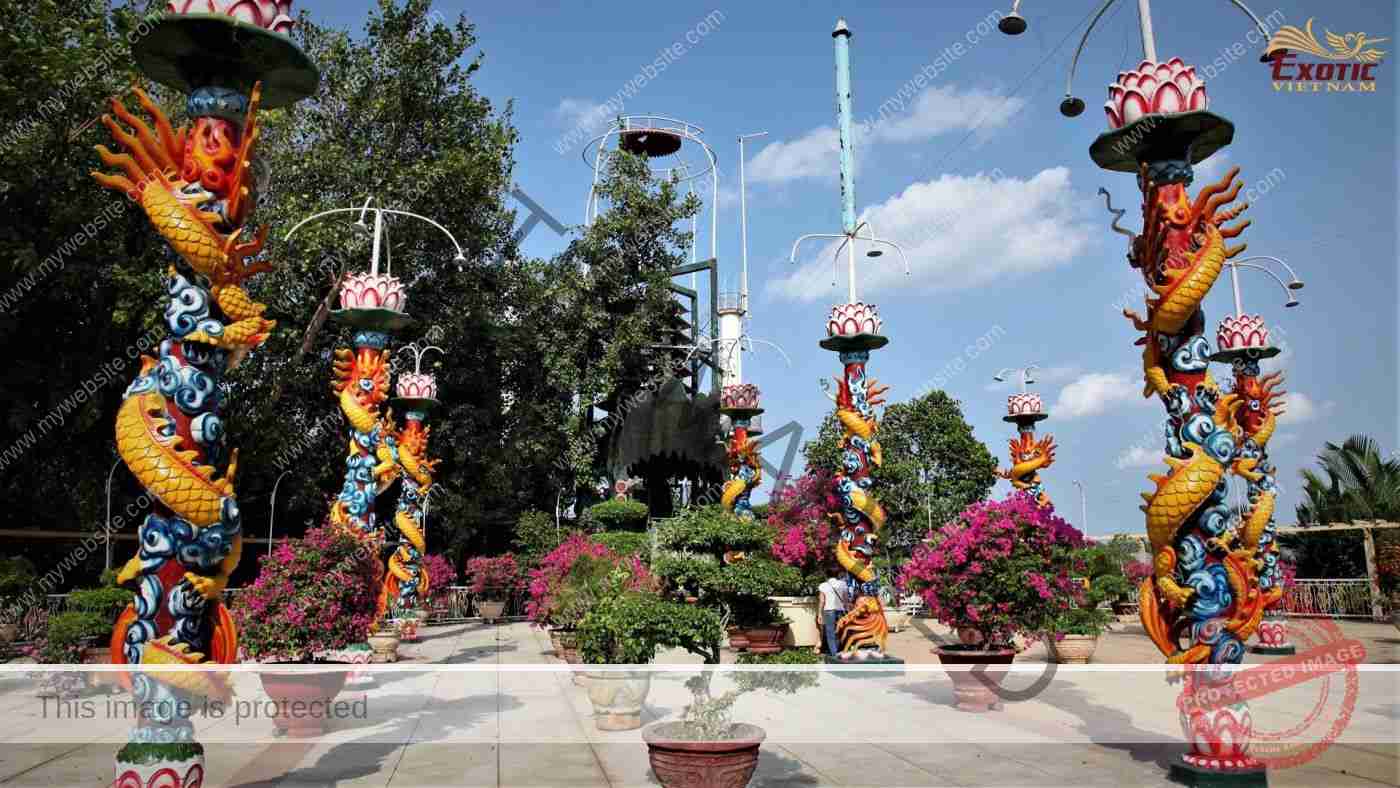
Encouraging a life of respect and love for each other, the religious philosophy of the Coconut Monk consists of the quintessence of many major religions. Believers in the Coconut Religion once reached tens of thousands of people. Come to Phoenix Islet to admire the remained architecture right at its sanctuary. Photo: Exotic Vietnam
My Tho – Ben Tre Islets
The first of the Mekong Delta’s bustling towns is My Tho. The city has a long history of commercial trade beginning in 1680 when the Chinese merchants migrated to the region. In the late 19th century, the French built a train line from Saigon, and My Tho became a vital export center for overseas rice trade. Today, vestiges of this period can be seen in the stately French mansions resting on the Mekong River’s left bank.
About 15 minutes by boat from My Tho pier, there are the 4 islet is lying between Tien Giang Province and Ben Tre Province, named after four holy animals: Unicorn, Dragon, Turtle and Phoenix. The biggest islet is Thoi Son or Unicorn covering an area of 1,200ha and the smallest is Turtle, only 65ha. Coming these islets, visitors can admire typical houses of rural Viet Nam with three parts, tiled roof in which people from different generations have lived together. Moreover, visitors can enjoy fresh air in well-tended orchards of longan, bananas and dragon fruit. Traditional trades such as alcohol distilling, coconut candy making, hand embroidering, etc. can be observed. Phoenix Islet is also known for the relic of the Coconut religion, was created in 1963 by Nguyen Thanh Nam who was known for his Buddhist and Christian harmony and prayed for peace in Viet Nam. The relic remains intact on the colorful 9-dragon courtyard and a large incense burner made from fragments of porcelain.
Spending a little more time (20 to 40 minutes) on board to the get to the river’s right bank. That’s Ben Tre countryside including communes of Tan Thach, An Khanh, Phu Tuc and Quoi Son where you can indulge in unlimited green of coconut trees. Coconut- tree is the most useful for the locals: leaves for thatch, trunks for wood, coconuts for juice, worms for foodstuff, especially coconut candy has made the name for Ben Tre Province. Visitors will discover small creeks under the shade of water coconut palms, and witness the process of taking honey, enjoy cups of tea with honey and taste some kinds of seasonal fruit. Don’t miss to take a horse-drawn cart on village paths and if brave enough, visitors could to hold a python, that is breeding as a pet, for a snapshot.
Because of the easy access location, the area serves as one of the best leading team building playground. It is great to run outdoor activities in nature that help to strengthen teamwork and communicate the company’s core values
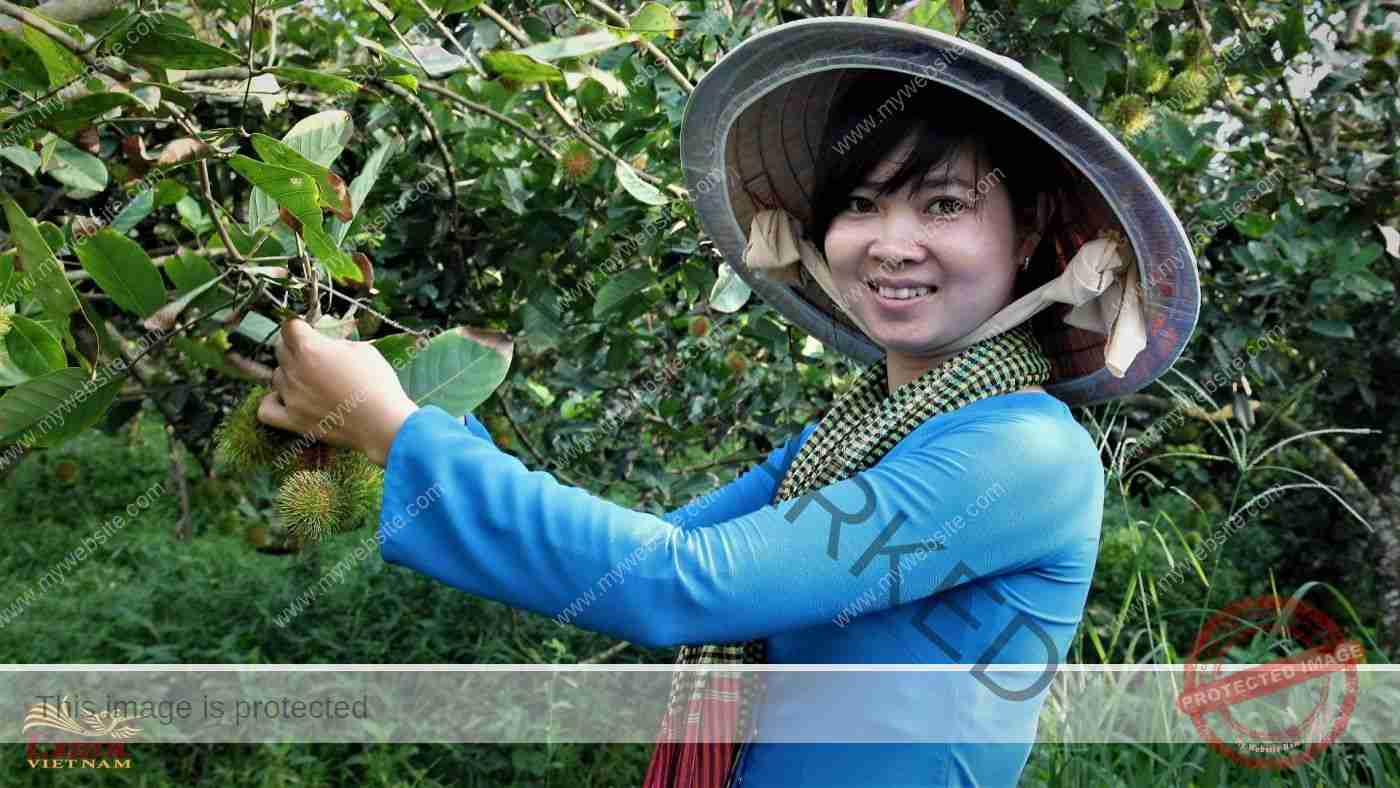
Travel deeper into the Mekong Delta to marvel at the vast rice fields and rivers at Cai Be and Vinh Long. Having a close contact with traditional rural life in Viet Nam by stopovers at orchards, or flirting with charming girls at work always proves to be a fascinating and rewarding experience for all visitors. Photo: Exotic Vietnam
Cai Be – Vinh Long Countryside
At about three hours’ drive from Ho Chi Minh City, Cai Be – Vinh Long countryside occupies a core area of the Mekong Delta. Thanks to its strategic location, in 1732 Lord Nguyen Phuc Chu erected Long Ho Palace to expand its territory to the South, in 1784 the Siamese army also camped at Tra Tan, a few kilometers from Cai Be, to confront the Tay Son army in battle of Rach Gam – Xoai Mut.
This region may be regarded as a living picture of the entire delta, due to its primordial prosperity and diversity. It becomes now an important transit point of tourism on the way to discover the whole Mekong Delta, greatly thanks to the water-land transport connection, its representative landscape of the entire area, and to the hospitality of the local people.
Starting at Cai Be town, 105km from Ho Chi Minh City, there are so many amazing places around to do and see whether you are looking to explore daily life, enjoy the river view, rest for a few days in a homestay or join team building to improve team spirit.

Cai Be floating Market once seemed to never sleep with hundreds of boats floating day and night, making it one of the most bustling markets on the river in the Mekong Delta. Although the number of ships moored has decreased a lot, the vibrant atmosphere here is still a great experience for travelers who want to explore and feel. Photo: Exotic Vietnam
Cai Be floating Market: This market is bordered by three provinces, Tien Giang, Ben Tre, and Vinh Long, one of the largest wholesale markets in the Mekong Delta. Lots of boats with a tonnage of 5-10 tons gather here for buying and selling local products which samples are hanged on wooden poles such as fruit, vegetables, flowers, big jars, etc. Cai Be floating market helps visitors have an insight into the impressive culture of the Mekong Delta, where human life and the natural environment are always intertwined. However, now due to the influence of road transport, the number of boats at this market has decreased significantly.
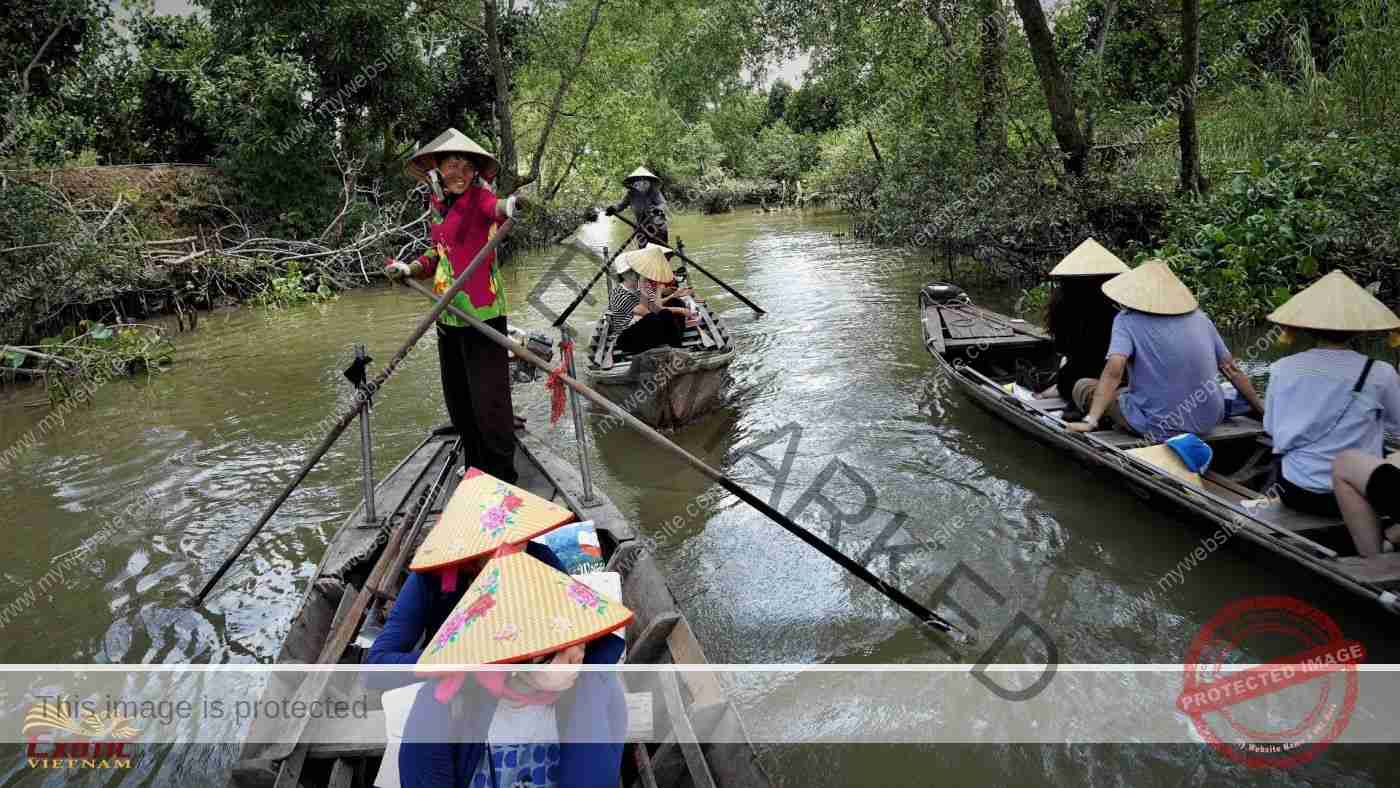
As an islet with a reputation of being a paradise of fruit, Tan Phong Islet is worth exploring nature by hand-rowing sampan, bicycling through friendly hamlets, and staying among true feelings of the people. This islet is also well known as a place you can collect handmade crafts in which a lot of effort has accumulated. Photo: Exotic Vietnam
Tan Phong Islet: A small ferry that shuttles passengers the short distance to and from Cai Be, Tan Phong islet has 1,300 ha of specialized fruit orchards, of which the main areas include over 678ha of durian, over 205ha of rambutan and nearly 150ha of longan, over 100ha of jackfruit, the rest are other crops. Thanks to abundant fresh water and fertile alluvium, fruits grown in Tan Phong are always favored by the market. In addition, with a large surrounding water surface, freshwater aquaculture has developed with aquatic products of high economic value such as Shutchi catfish, Yellowtail catfish, Crystal eyed catfish, etc. up to nearly 55ha.
In the harvest season, visitors can freely enter the garden, break it by themselves and enjoy it at the garden. The best way to see the island is to take a sampan ride on the small crisscrossed creeks or ride a bicycle in the narrow paths with numerous small bridges. You will find yourself immersed in the endless green of nature and witness firsthand the daily life of local farmers. Tan Phong islet has recently become an attractive eco-tourism destination in the Mekong Delta with many homestay options as well as profound cultural experiences.
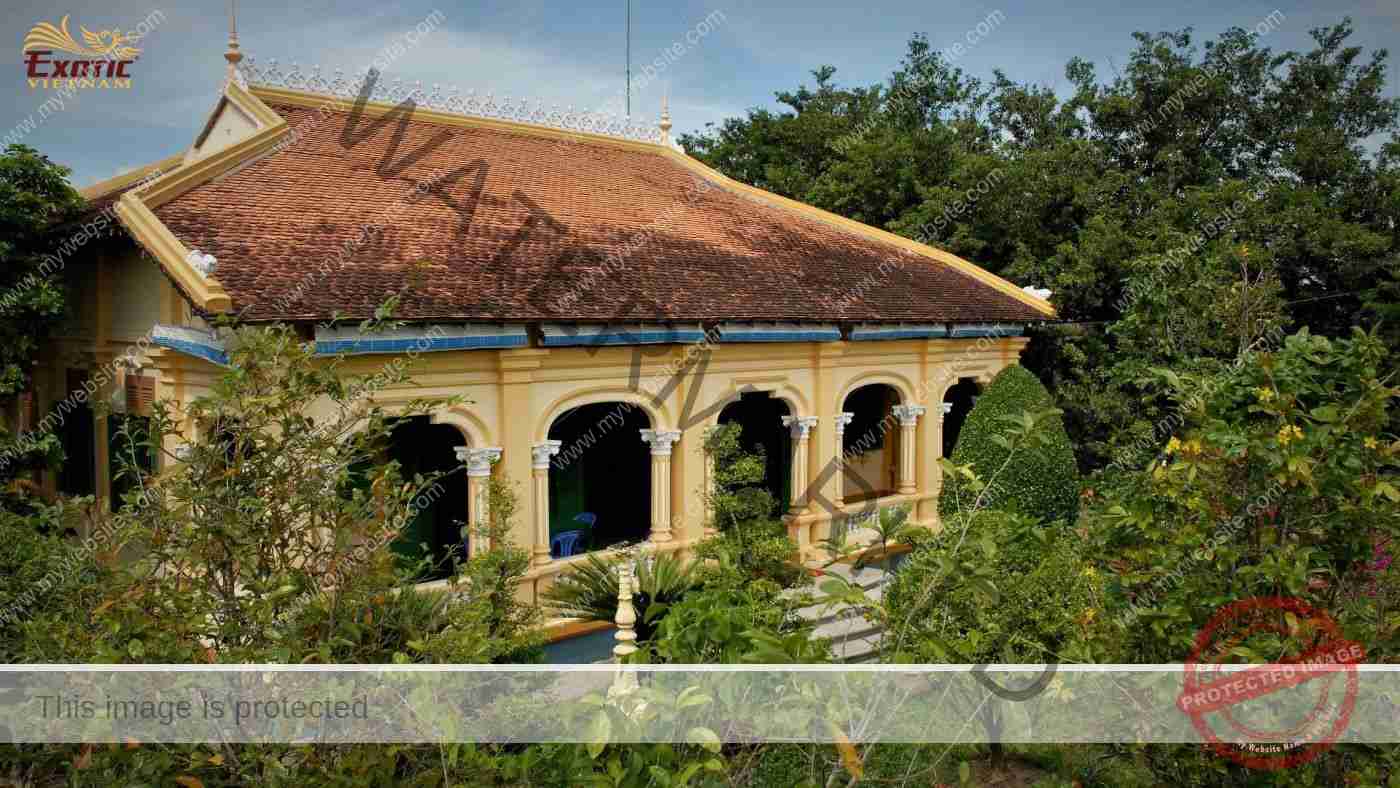
In addition to the familiar images of rice fields and rivers, discover another side to the Mekong Delta. At Dong Hoa Hiep village, there are dozens of ancient houses with hundreds of years old hidden in lush orchards. Come and spend the night in these quaint houses, where you can admire architectural marvels and listen to countless stories about the past. Photo: Exotic Vietnam
Dong Hoa Hiep Ancient Village
Dong Hoa Hiep is attractive with the poetic landscape of ancient houses under orchard canopy all year round by the winding Cai Be river. Currently, the village still retains 7 old houses built 150 to 220 years ago and 29 houses built 80 to 100 years ago, where local people have lived. The architecture of the ancient house is a blend of traditional Hue architecture with exquisite wood carvings, French colonial architecture with many decorative patterns and the liberal way of life of the Southern people. The old houses here are not close to each other, not full of high-walled gates, but scattered and interwoven with luxuriant fruit gardens and rich alluvial creeks.
The first is the old house of Mr. Xoat (An Thach hamlet). This is the oldest house in Dong Hoa Hiep, built in 1818. Although the house looks from the outside with Western facade, but the inside shows Hue’s wooden house combined with Southern folk architecture. Built in 1838, Mr. Kiet’s house (Phu Hoa hamlet) bears the mark of an ancient house in the Red River Delta with 5 compartments and 3 wings and many columns. Or Mr. Duc’s, Mr. Tong’s, Mr. Vo’s… each house is a unique architectural work with its own imprint. In 2003, JICA Japan organization restored and received the certificate of Cultural Heritage awarded by UNESCO Asia to Mr. Kiet’s house. Dong Hoa Hiep Ancient Village was honored to be recognized as a National Relic by the Ministry of Culture, Sports and Tourism in 2017. This ancient village has become one of the hotspots attracting a large number of tourists. They can rest and experience the daily life of one of the rich families in the Mekong Delta in the past.
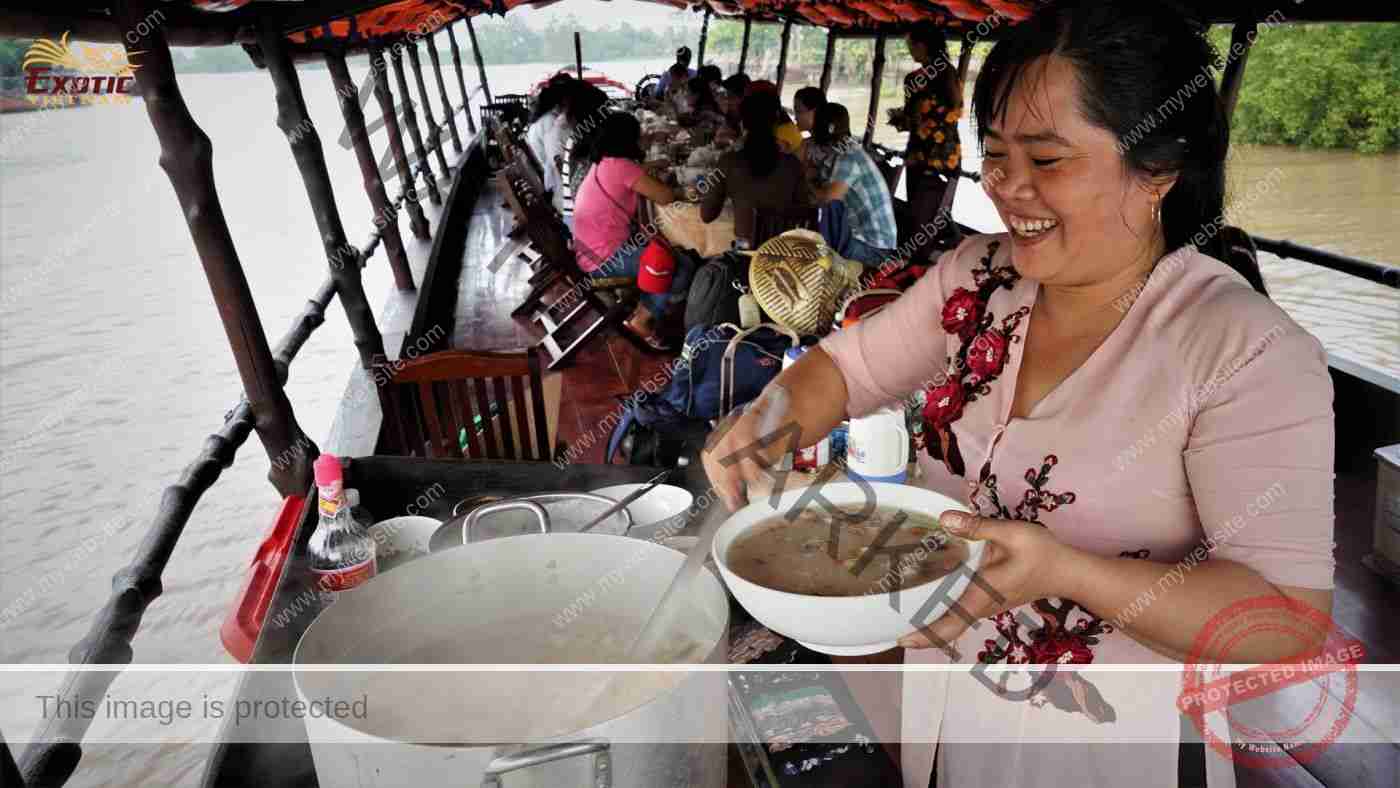
A boat takes you to An Binh Islet where the maze of shady creeks will surely fascinate anyone. Have a chance to mingle with local peasants, learn the secrets of their bonsai gardening and take a look at local products. Typical Vietnamese dishes at a local home are ready to serve for your taste. Photo: Exotic Vietnam
An Binh Islet: From the middle of the Mekong River emerges an islet named An Binh. Covering around 60 km.sq, the islet has 4 villages: An Binh, Binh Hoa Phuoc, Hoa Ninh and Dong Phu. The soil here is fertile and rich, which brings advantages to the islet. The first households to serve tourists in the early 1990s appeared such as Sau Giao, Tam Ho, Muoi Huong, and so on with tourism products being the value of their own lives. An Binh attracts with its flower gardens, fresh fruits and and the peaceful life of farmers. Visitors can visit longan, mango orchards and have a rest in hammock or stay overnight in a wooden stilt-house or in an old French style house. Today Ut Trinh’s like-resort homestay service and her fleet of wooden boats are always high appreciated in this islet.
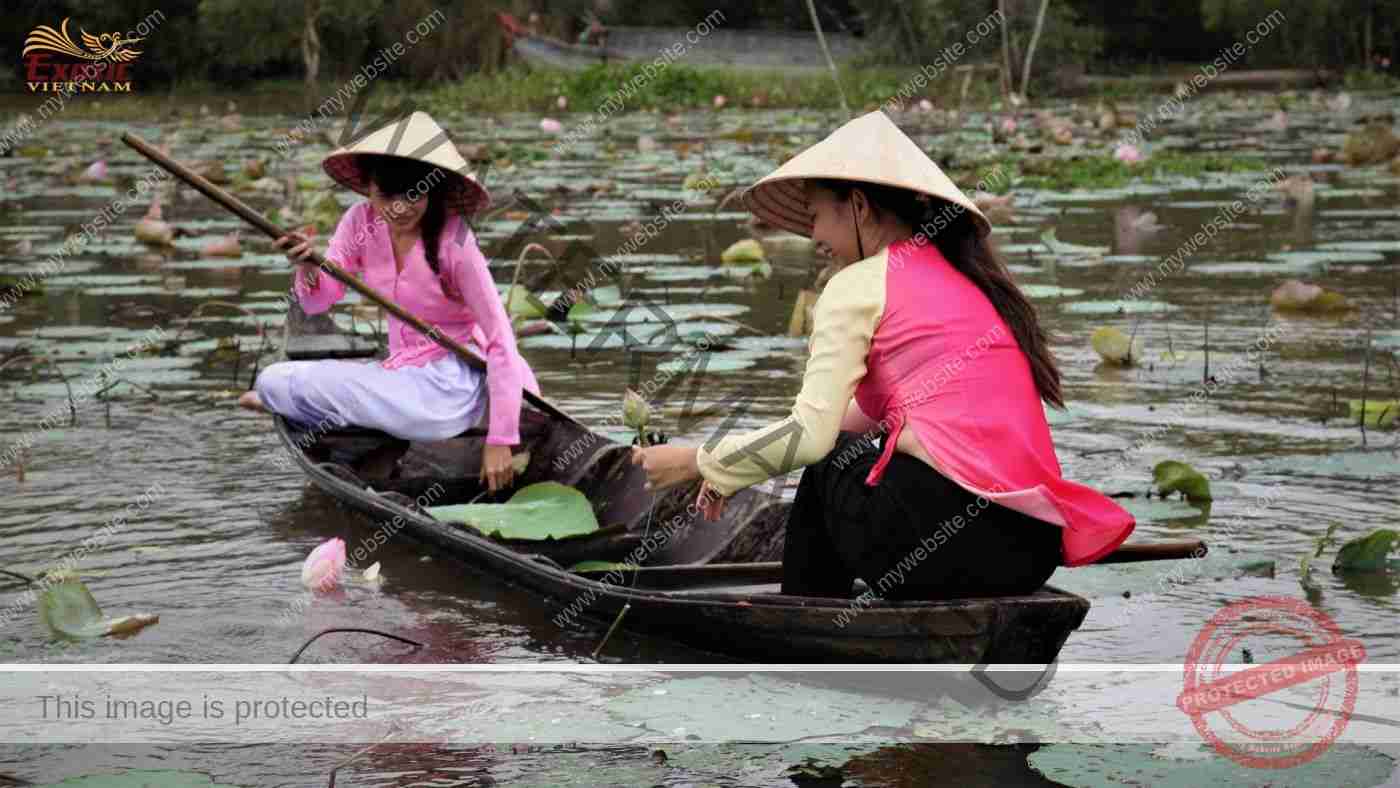
Vast flooded lowlands to colorful flower gardens, or Oc Eo archaeological site to the guerrilla base during the war against the French and Americans, etc. Head to Dong Thap and discover the unique natural, cultural and historical charms of the region known as the land of lotus. Photo: Exotic Vietnam
Dong Thap attractions
Located between the Mekong and Bassac Rivers, Dong Thap province benefits from large rivers and a network of innumerous creeks that cut through the alluvial surface. The plain is regularly filled with fertile alluvium, fresh water all year round and no salinity during the dry months, that’s why from the early days the Vietnamese have set foot on this area with a long history of land reclamation, but without disrupting the balance of nature.
From the paddy fields, melaleuca forests to archaeological sites for thousands of years, or the ancient house mentioned by Marguerite Duras in her novel The Lover, Dong Thap is known for both its cultural and natural splendors. It is a perfect hideaway for those who have a cultural interest and enjoy experiencing nature. You can start from Cao Lanh, the capital of Dong Thap province, 160km far from Ho Chi Minh City to visit many attractions.
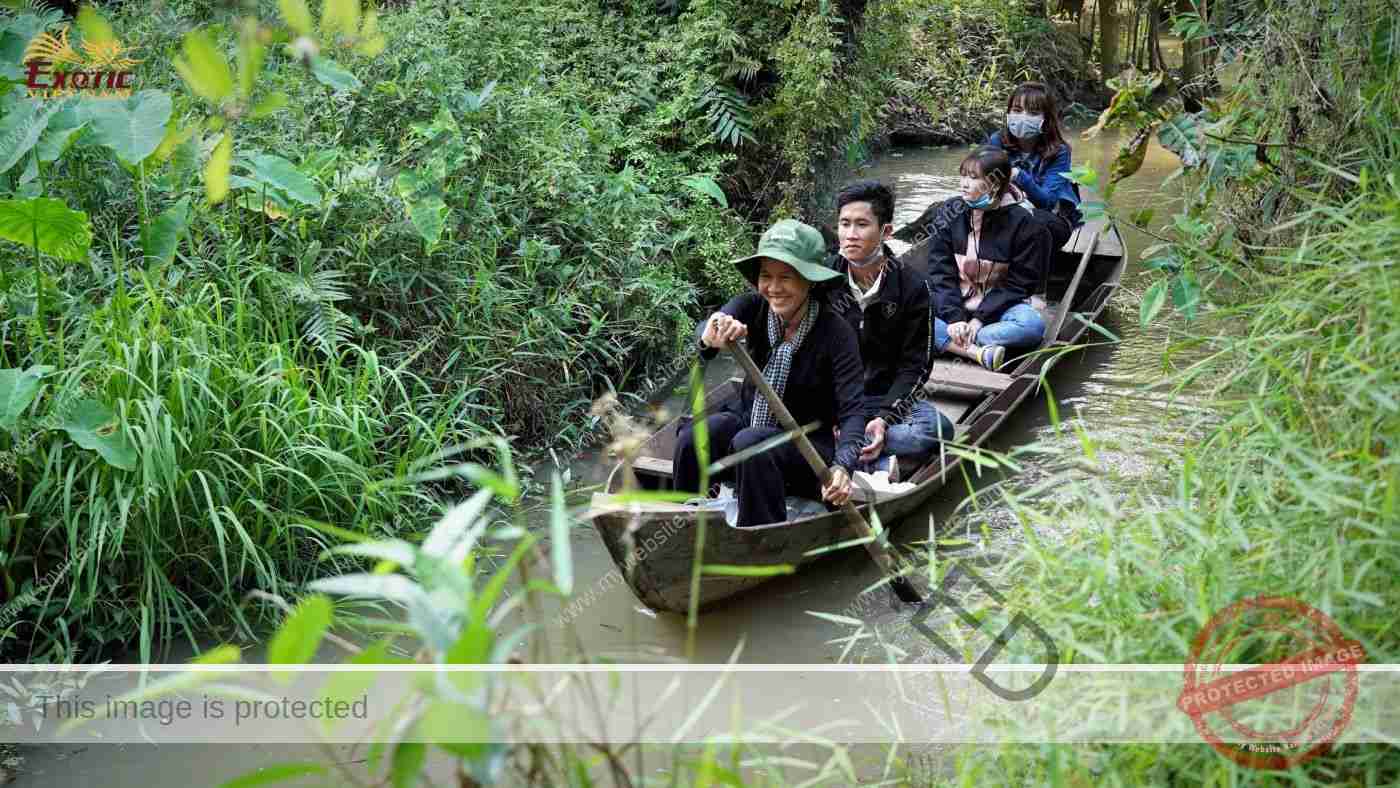
As a guerilla stronghold during the last war, Xeo Quyt comprises hollow marshes with bushy melaleuca forests. Visitors will enjoy a hand rowing sampan cruise through a small curvy creek. Going through each bend will encounter surprises hidden in the canopy of vines or secret underground tunnels. Photo: Exotic Vietnam
Xeo Quyt melaleuca forest: As a former wild submerged area in Cao Lanh District, Xeo Quyt was a revolutionary base during the anti-French and US resistance war. Covering an area of 50ha, now it becomes an attractive historical and ecological tourist site in the Mekong Delta. The melaleuca forests, submerged in the red brown water, are an ideal habitation for numerous kinds of birds, fish and wild animals, typical for the tropical region. The sampans take visitors to move between the melaleuca trunks covered by many thin layers like yellow paper sheets, under the interlaced vines system sticking crowdedly in the canopy of leaves. Immersion in a quiet space of trees and waters, and exploration of headquarters of guerrilla in flooded environment make your trip a unique experience.
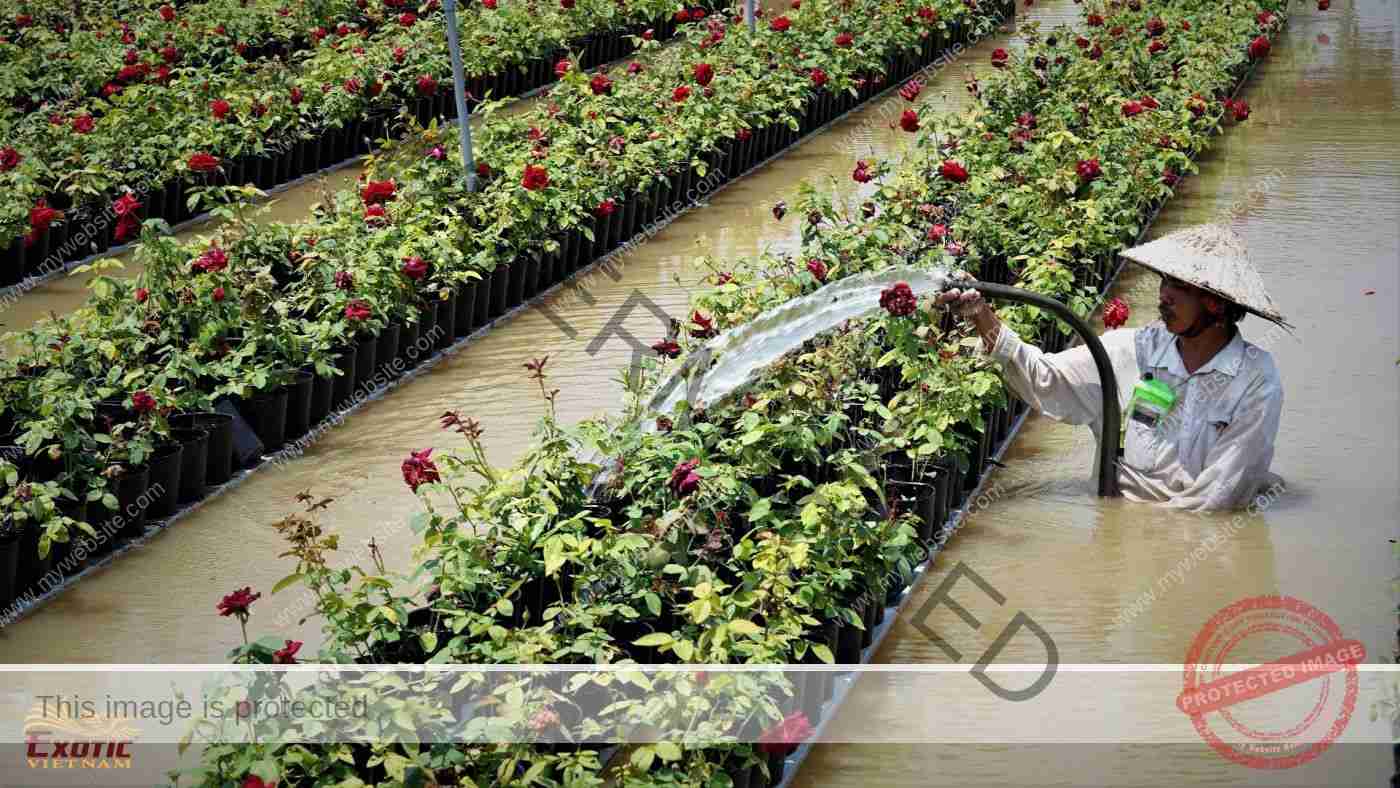
Sa Dec flower village is home to some 2,000 households that chiefly earn a living by growing flowers and ornamental trees. It is worth to see magnificent flowers in full bloom and learn about daily lives of local farmers at the most renowned flower village in the Mekong Delta. Photo: Exotic Vietnam
Sa Dec flower gardens: With an area of 313ha, Sa Dec flower gardens is a well-known for hotspot in Sa Dec for a long time. Gardens in Tan Quy Dong, an island commune encompassed by Mekong tributaries, have given the locals a very good earning for their living. The flower-growing profession was formed in the 1930s, typically the rose garden of Mr. Duong Huu Tai (Tu Ton) with over 400 valuable flowers and medicinal herbs. Now there is the abundance of domestic and foreign flower species such as chrysanthemum morifolium, Taiwan chrysanthemums, tiger tail chrysanthemums, cockscomb flowers, dahlia, hydrangeas, etc. and a wide range of orchids. Sa Dec flowers are special because they are grown on high shelves with water underneath. The farmers must wear boots or use small sampans to take care of and harvest the flowers. According to the locals, this method helps them cultivate right on the flooded lowland and immediately use the water source below to water and create moisture in the air for flowers.
In this village, visitors can feel lost in the colorful world and the magical scent of flowers and ornamental plants in any month of the year. For people with an interest in flowers this garden is an absolute delight! Sa Dec’s flower gardens are excellent places to visit. Sa Dec flower gardens are also a great playground for team building activities in a rustic style with many ways of moving such as on foot, bicycle or tram in a colorful world.
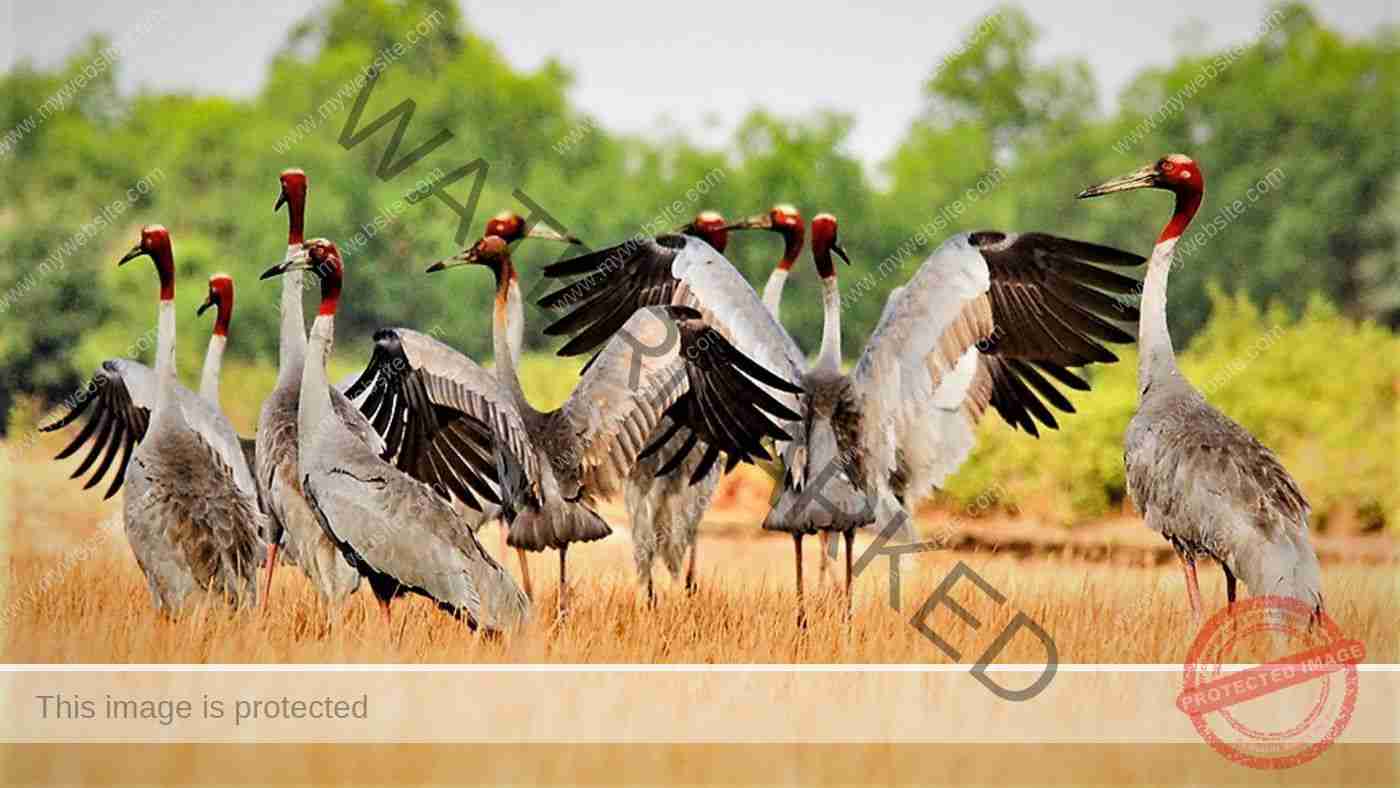
Come to Tram Chim National Park to feel the pristine image of the Mekong Delta through the flora and fauna in the flooded environment. In addition, the park also plays an important role in regulating water sources, and providing natural resources for the surrounding community. Photo: Internet
Tram Chim National Park: Just 40km from Cao Lanh, Tram Chim was recognized as a national park in 1994 and the world’s Ramsar site in 2012. Covering an area of 7,313ha in seasonally inundated grassland and melaleuca forest, the park presents the lively and typical wetland ecosystem of the Plain of Reeds.
It is home to 130 species of plants, 100 species of vertebrate animals, 40 fish species, and 147 species of water birds. Water birds accountfor about a quarter of all bird species in Viet Nam, such as grey-headed lapwing, pelican, lesser adjutant, Asian openbill stork, etc. Especially, during the dry season (from December to July) Tram Chim provides habitat for a wide diversity of wetland bird species, including several globally threatened or near-threatened species such as sarus crane.
Tram Chim is the land of the most wonderful and splendid bird sanctuary, famous not only for its panoramic green space but also for its biodiversity and seasonal changes of the landscape. Visitors will be immersed in the different spaces of Tram Chim, the vast melaleuca forest reflecting on the calm water, the lotus fields being full of fragrance, or the ghost rice fields rising high in the sky during the flood season, etc. with thousands of birds frolicking in the sky.

Gao Giong is a well-preserved miniature Plain of Reeds in Dong Thap. Annually, the water is flooded for up to 6 months continuously, which helps the ecosystem of melaleuca forest and grassland to be really a safe haven for countless species of birds and aquatic creatures. Photo: Exotic Vietnam
Gao Giong Bird Sanctuary: 15km from Cao Lanh City, it takes about 1 hour to Gao Giong by car and boat. Covering an area of 1,670ha, Gao Giong is a flooded area covered by immense swamps and primeval melaleuca forest. That is also home to almost 130 kinds of plants, 200 species of birds, and about 55 types of fish. The peaceful and quiet atmosphere, together with the endless green of forest and water surface create a strong attraction for those who want to enjoy nature. Visitors to Gao Giong also have the opportunity to enjoy local specialties such as snakehead fish – a freshwater fish, cooked with all parts of the lotus plant and a variety of green vegetables in the wetlands. The wildness of primeval forests, full of interlacing plants, and the agricultural life of the local inhabitants, ready to face annual flooding season will make your trip exotic and educational.
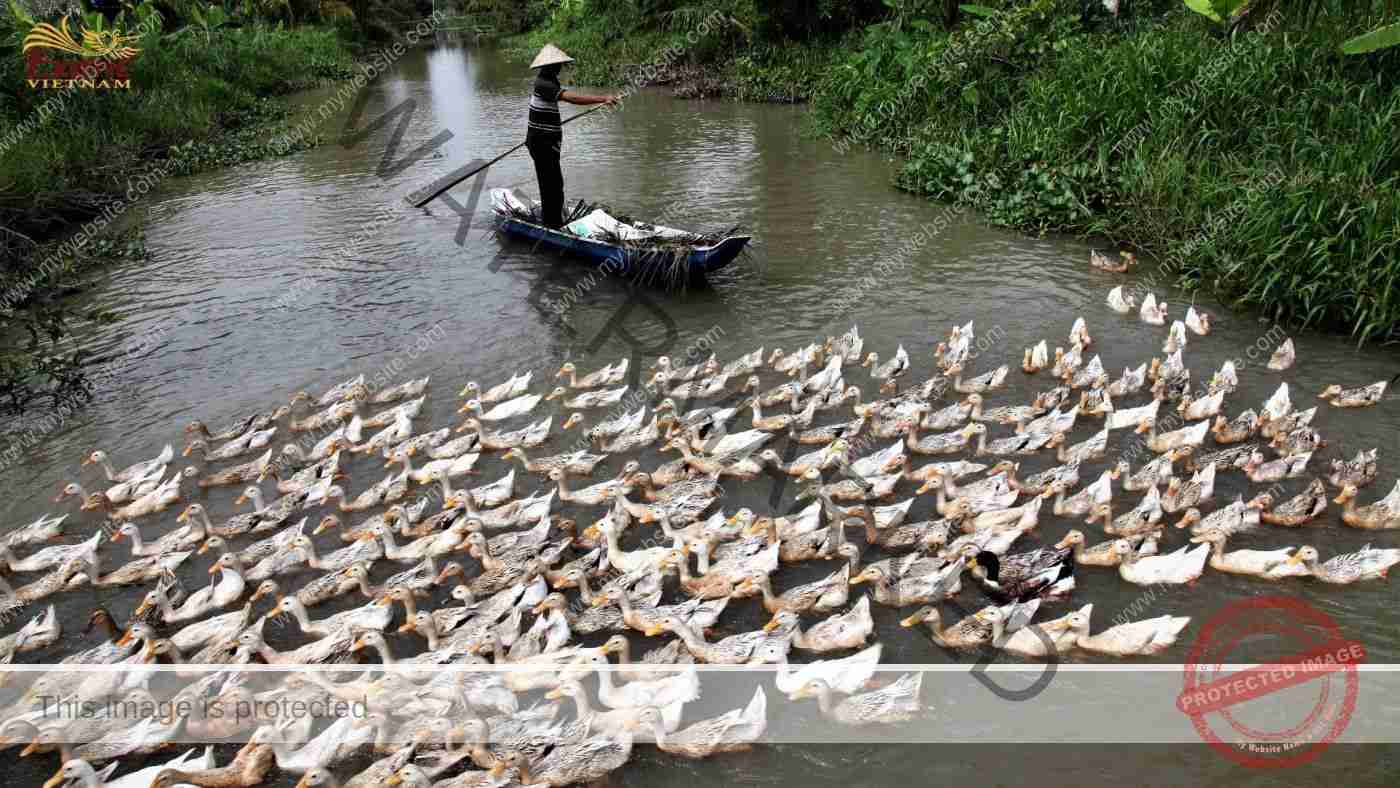
Con Son is a typical example of true community tourism in Viet Nam. Based on the abundant natural resources of the Mekong Delta and centuries-old cultural values, visitors can experience the riverine life and the genuine affection of the local people. Photo: Exotic Vietnam
Con Son Islet
About 8km by road from Can Tho centre, and 5 minutes across the Hau River, Con Son is an exemplary ecological garden with an area of 70ha. Since 2014, community-based tourism has attracted the participation of local residents who have had a long life on this islet. Each household with its own strengths, takes part in a chain of service links to serve tourists from guides, tours, cuisine, etc. based on voluntariness, responsibility, publicity and equality in benefit sharing.
With abundant water resources, there are about 50 raft houses creating a small floating village on the river. The alluvial soil on the islet is very fertile, there are many fruits and vegetables growing all year round such as rambutan, rose apple, pomelo, star apple, jackfruit, etc. You will explore many gardens, and learn the names and uses of all the different fruits and plants. Of course you will be able to taste the produce as well, the selection varies of course depending on the season. In addition, there are special things only appeared in Con Son: watching ‘flying’ snakehead fish.

Due to the negative impact of mass tourism and the development of road traffic, many traditional markets on the river have been changed. It seems to lack the authentic atmosphere where the local people gather to buy and sell together. However, visiting the Cai Rang floating market, you will be immersed in the true river trade culture. This is one of the remaining original floating markets in Vietnam, which evokes your emotions towards the people and nature of the Mekong Delta. Photo: Exotic Vietnam
Cai Rang floating market
Cai Rang Floating Market is located in the downstream of Can Tho River, about 600m from Cai Rang Bridge, which is convenient for the operation of floating market: the width of 100-120m, the length of 1300-1500m. Hundreds of boats gathering here from the dawn till before noon makes the area extraordinary animated and the water surface colorful with numerous tropical fruits. The large sized anchored boats create meandering lanes for smaller ones to weave through. All create a bustling and joyful atmosphere that can attract any tourist.
Trading from boats brings excitement to buyers when catching some sample of products that are thrown by sellers from other boats. The other distinctive feature of the floating market is the bamboo pole called “cây bẹo”, which hangs all kinds of goods to invite buyers. Visitors can be up-close to local boats and see farmers exchanging goods directly from boats. Visitors can buy fresh fruit and enjoy it on site.
With the unique cultural and economic values of Cai Rang floating market, Rough Guide (UK) tourism magazine voted Cai Rang Floating Market as one of the 10 most impressive markets in the world. In 2016, Cai Rang floating market was recognized as a national intangible cultural heritage by the Ministry of Culture, Sports and Tourism in Viet Nam.
TEAM BUILDING IN PHU QUOC
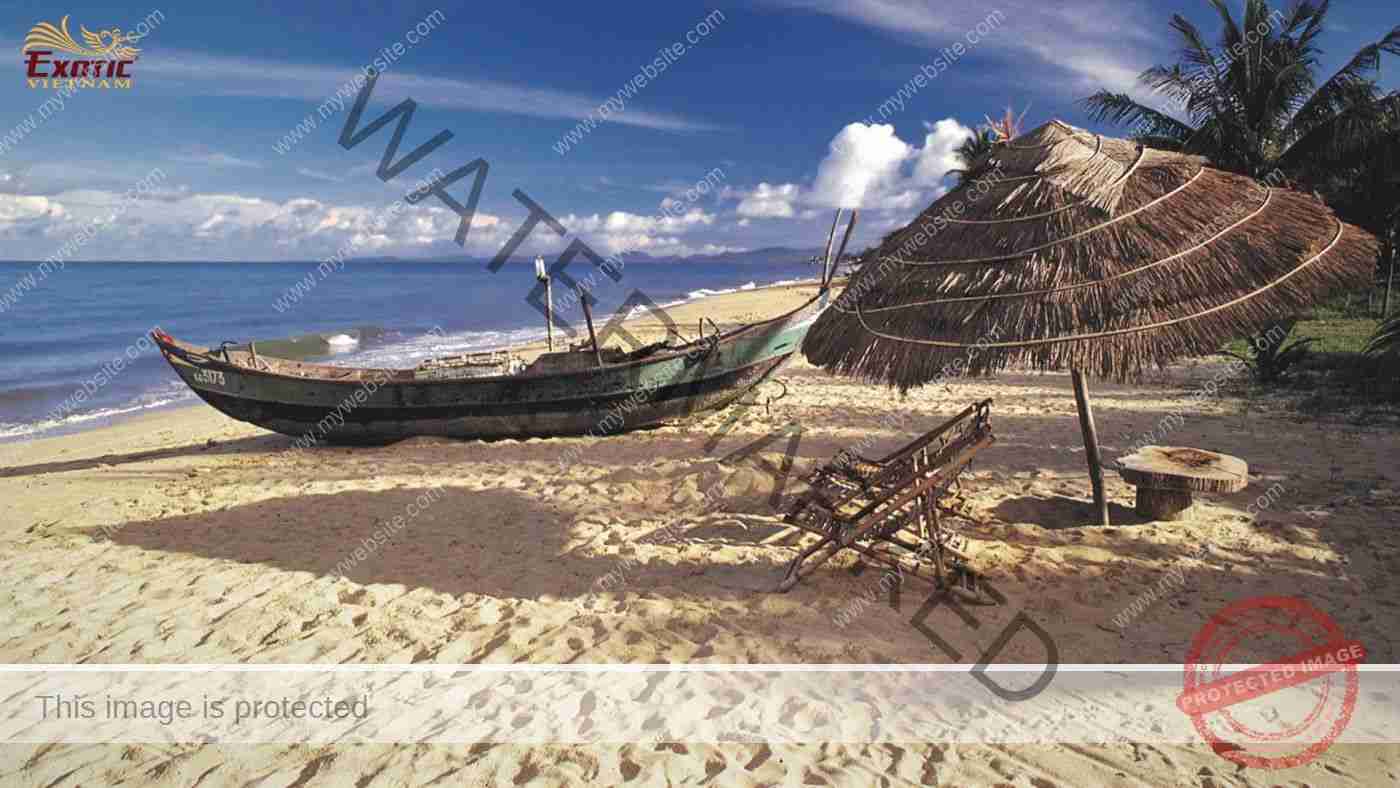
Phu Quoc meets all your interests for an impressive trip with contrasting choices: luxury resort block – thatched guest house, sleepless entertainment area – calm fishing hamlet, bright crowded town – quiet uninhabited islet, etc. There are still countless secrets about nature, history and life, waiting for your discovery. Photo: Exotic Vietnam
Location: About 1 hour by air from Ho Chi Minh City, 120km from Rach Gia (2½ hours by speed boat), 45km from Ha Tien (1 hour 15 minutes by speed boat).
Introduction:
Before the arrival of the Vietnamese and Chinese in the 17th century, Phu Quoc was known as Koh Tral, meaning “the shuttle” in the Khmer language. Mac Cuu, a Chinese merchant turned this area into a rich commercial center and named Phu Quoc. In 1708, Phu Quoc’s officially relationships with Lord Nguyen helped it to be protected from Siamese attacks.
Just 120km from Rach Gia or 45km from Ha Tien by sea, Phu Quoc Island boasts 150km of beautiful coastline and decades of idyllic islands in the Gulf of Thailand, in which Phu Quoc is the main island with an area of 567km2, the largest island of Viet Nam. Composed of sandstones, Phu Quoc’s terrain is rugged with “99 mountains” which feature the asymmetric shapes of alternating steep and gentle slopes. The highest is the 603m Chua peak, formerly Vo Quap in the north. The sea surroundings are quite shallow, with a depth of less than 10m. However, the small island cluster of An Thoi Port is completely separated from the southern tip of Phu Quoc by a strait with a depth of more than 60m.
Dominated by white-sand beaches, emerald waters and dense tropical jungle, Phu Quoc is considered a “pearl” where visitors can fully enjoy the natural beauty of sun-drenched beaches, romantic sunset, vivid marine life, diverse forest ecosystem and verdant countryside with traditional trades such as pearl farming, growing pepper, fishing industry and its famous fish sauce.
With countless big projects from record-breaking trans-sea cable car, to safari zoo, huge seaside resorts, sleepless amusement parks, elegant coastal villas, bustling shop houses, immense golf courses, etc. show that the large-scale mass tourism has been booming since 2015. Environmental pollution and coastal erosion in Phu Quoc has become a serious problem that concerns everyone from the government, investors, residents to tourists. The natural beauty of the Phu Quoc National Park and the Kien Giang Coastal and Marine Biosphere Reserve has gradually disappeared. That’s the reason why visiting Phu Quoc makes you feel all nostalgic for its green world as well as know more about the fragility of the beautiful local environment you are enjoying.
Eco Team building in Phu Quoc promises many interesting things, helping you have new experiences and raising awareness about the sea nature. Pearl Island will not disappoint you with special products: The Amazing Race, Island Survivors, Lost in Jungle, or fun activities on the beach. Tell us your team building plans and preferences and Exotic Vietnam will make with the best partners in Phu Quoc to create the best trip match for your business.
Highlights: White sandy beaches, Cua Can River, Phu Quoc Nature Reserve, Dinh Cau, Pagodas in Phu Quoc, Phu Quoc Prison, An Thoi Archipelago, Phu Quoc Safari, etc.
Facilities & services: international standard restaurants, hotels and resorts, safari park, themed parks, boat ride, fishing, scuba diving, golf course, etc.
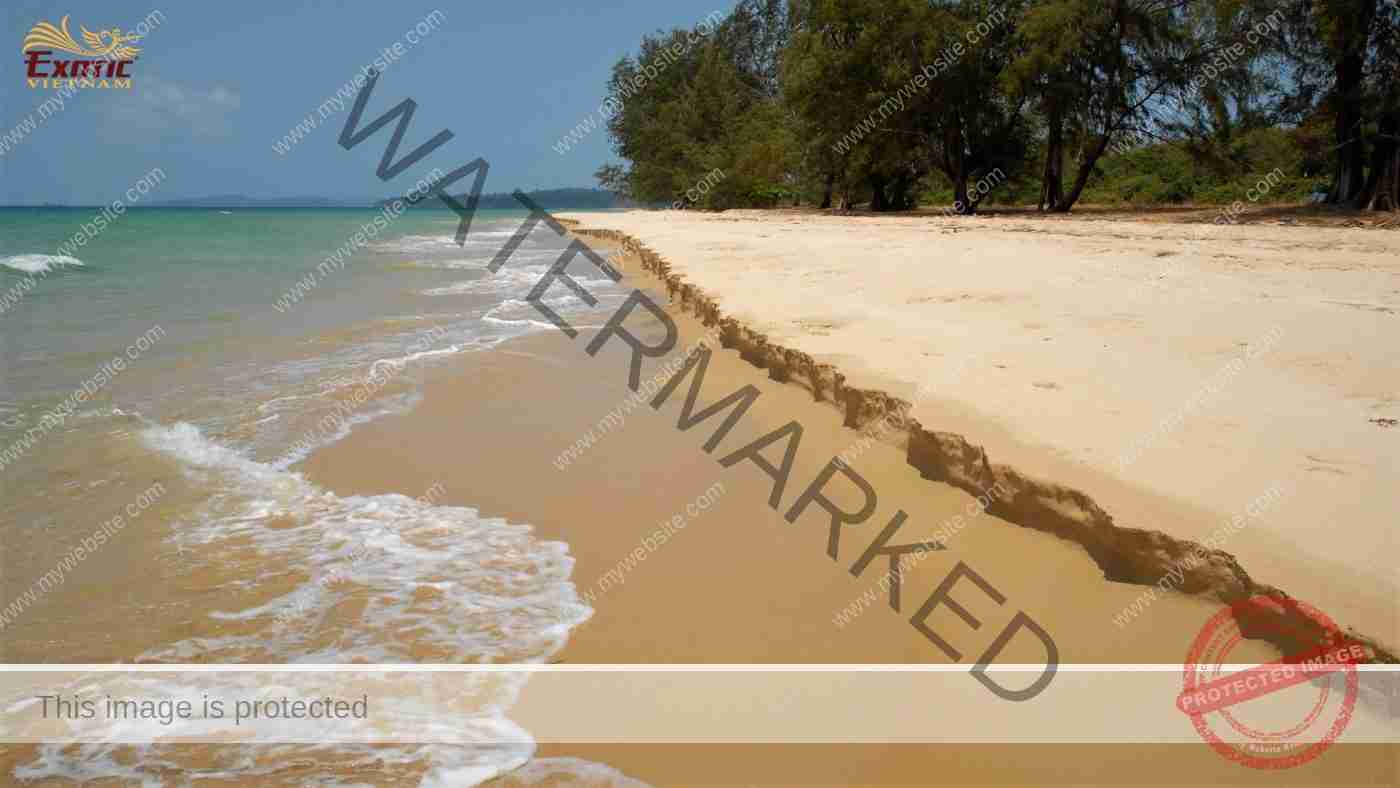
Phu Quoc boasts of plenty of different beaches, through the national park in the north, it’s clean water, natural setting and quiet environment, or just steps from west coast resorts, it’s a fantastic strand of white sands, stretching about 40km with many water sports and premium facilities. There is nothing more truly happy than to enjoy soaking up the sun, watching the sunsets, exploring the islets nearby, or just swinging in hammock under palm shades. Photo: Exotic Vietnam
White sandy beaches
Bordered around the Phu Quoc Island, there are around 20 sandy beaches. First-time visitors to Phu Quoc are often surprised that its beaches can be so sugary-white and the water so crystal-clear. The seasonal variation of wind direction also creates different wave levels for each coast. Phu Quoc beaches are all rated as the best in Viet Nam.
However, before the rapid development of infrastructure for mass tourism, there are only a few beaches left on the island, where there is no large-scale resort construction, environmental damage or presence of garbage. In general, the west coast which owns the longest and most beautiful beaches and ideal viewpoints for sunsets (Bai Dai, Vung Bau, Ong Lang, Bai Truong) and the southern end with powder soft sands caressed by gentle waves (Ong Doi, Bai Khem, Bai Sao) are densely covered with countless luxurious resorts, entertainment centres and commercial buildings, etc. Meanwhile the north coast known as secluded blue havens ringed by coconut palms, wild bushes and fishing hamlets (Ganh Dau, Rach Vem, Rach Tram, Hon Thom) and the northeast with a few small silt beaches as well rocky headlands, remain quiet and relatively unspoiled.
Trash drifting along the sea currents and landing on beaches is not only a challenge at high-end resorts but also for any deserted and romantic beach of Phu Quoc.
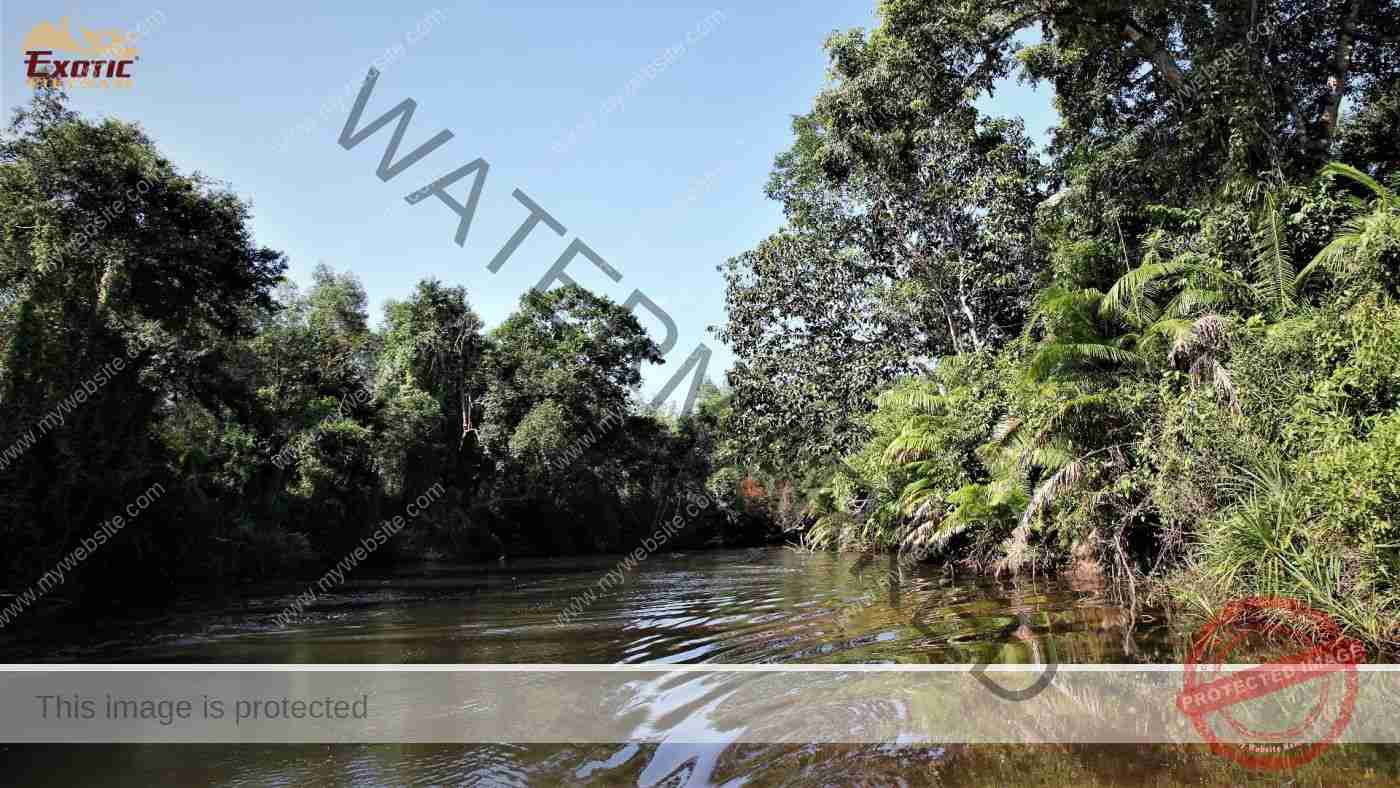
Rich in history, daily life, and natural beauty, Cua Can River offers an opportunity to visit a relic of Hero Nguyen Trung Truc, explore pepper plantation, and paddle through kilometres of winding waterways with crystal clear waters. Immerse yourself in the lazy current and soak in the stunning views of mangroves and many wildlife species. Photo: Exotic Vietnam
Cua Can River
In 1868, hero Nguyen Trung Truc built many army bases here to withstand the strong French attack for 10 months. The temple and fragments of his wooden boats can be found at Ba Trai, on the bank of Cua Can River.
With the length of 15km, Cua Can River originates from Ham Ninh forested mountain and draws down to Cua Can hamlet, 10km north of Duong Dong Town, meets the west coast of the island. In the rainy season, the waves bring sand to fill up the river mouth. River’s minimal flow not enough to prevent blockage by formation of sandbars. Boats that want to pass sandbar must come together in a group of five or seven. When the tide is low, people dig a drainage line through the sandbar, so that the river water flows into the sea, making the water line wider just enough for boats to move through. A few weeks later, it’s deposited and sealed again. The river mouth is nearly stocked up and that is the reason why it is called Cua Can.
Nowadays, the river has become one of the most popular spots on the island due to its historical interest and natural beauty, so you should take a boat trip along the water to admire the beautiful scenery. It features very clear and clean water, so you can see through the clear blue water with schools of fish swimming beneath. On both sides of the river, you can also see flocks of birds and storks chirping on the bushes, even lots of clusters of mangrove with its branches swooping down on the water. The more you move upstream, the more you will see the winding small streams hidden in the dense melaleuca trees.
If you’re looking for something that brings the team together in a memorable way, there’s nothing better than engaging people on an adventure. With incredible scenery, friendly locals and exciting adventures, Cua Can River is your perfect choice.

Phu Quoc is an island with a large area of amazing nature reserves from the national park to the marine protected area and the UNESCO biosphere reserve. They create a contrast to areas that are densely built with leisure centers and resorts. These sanctuaries give you an opportunity to see the island’s wildlife from the mountains to the seabed. Photo: Exotic Vietnam
Nature Reserve in Phu Quoc
Established in 2001 and later expanded to a total area of 31.422 ha, Phu Quoc National Park with diverse flora and fauna covers mainly the mountainous northern part of the island. There are nearly 929 tree species of which 19 newly-found species are first recorded in Viet Nam. The forest is home to many species of birds and small mammals (flying squirrels, sloth-monkeys…). As explained by the French Larousse dictionary, the famous Phu Quoc dog is a well-tamed wild canine species which has become hunters’ favourite companion. Many beautiful streams such as Tranh and Da Ban are also found in the forest as must-see attractions for many tourists.
In 2006, to protect the ecosystem of coral reefs and seagrass beds, coastal mangroves and many other rare marine creatures, Phu Quoc Marine Protected Area was established and then expanded to an area of nearly 41,000 ha. Phu Quoc is home to extensive coastal ecosystems including nearly 108 species of coral, 135 species of coral reef fish and 132 different types of mollusks, as well as migrating fish and marine mammals in its surrounding waters. Here is one of the few places in the country where wildlife enthusiasts can spot unique species like dugong, hawksbill turtle and green turtle. In 2006, this area becomes part of an area of 11.881km2 with 105 islands in Kien Giang Biosphere Reserve recognised by UNESCO.
Nature tours such as conquering Mt. Nui Chua with trekking under the dense forest canopy or swimming and diving in the clear blue water to watch the colorful coral reefs, etc. are always attractive to tourists. This is also a team building playground with many survival-style scenarios in the wild. However, the construction of too many theme parks, villas, resorts now and in the future may cause the forest area to shrink and the marine environment to be compromised in Phu Quoc.
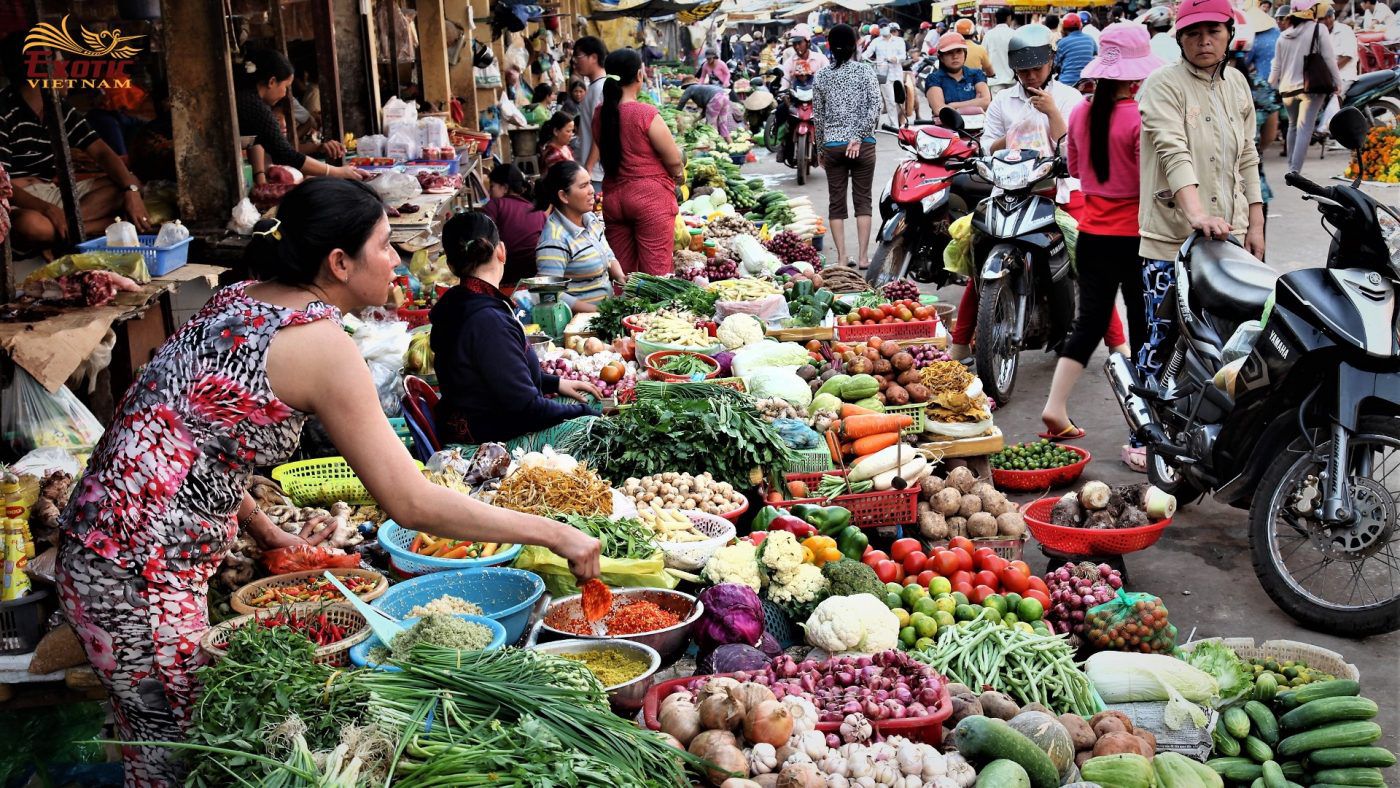
Packed with a large number of the sellers and buyers as well as travelers wandering back and forth, Phu Quoc Market is a bustling hotspot that most tourists gather here to soak up its distinctive atmosphere, learn about people’s lives and buy some sea specialties, especially dried seafood. At every corner, you’ll see something worth remembering with a photo. Photo: Exotic Vietnam
Duong Dong Riverside Market
Located on the bank of the Duong Dong River, Phu Quoc Market is convenient for both water and land transportation. Fishing boats easily dock and unload fresh catches right at the market. This bustling market includes a large house selling all kinds of daily necessities, a variety of dried seafood, souvenirs and an outdoor area specializing in selling fresh seafood with a variety of seafood such as fish, shrimp, crab, squid, snails, etc. In addition, there are many stalls serving fruit juices and Vietnamese cuisine. Famous Phu Quoc specialties such as fish sauce, myrtle wine, dried seaweed, black pepper and cashew nuts are also items that tourists often find at the market. The market is open from early morning around 4 o’clock in the morning to evening with a large number of merchants.
A nice way to get an insight into the life of a locality is by socializing yourselves in its marketplace. Everything in Duong Dong market looks so different from everything else in town: huge fish, odd fishing tools… A lively and cheerful atmosphere permeates the marketplace from vendors in conical hats sitting on the ground with their small baskets of little fruits and vegetables to salespeople at their big well-stocked stands. A walk to the market jetty where visitors can take wonderful snapshots of boats constantly loaded and unloaded in a hurry is worth trying.

Considered as the center of Phu Quoc island, Dinh Cau includes Dinh Cau Rock at the mouth of Duong Dong River and the night market with seafood feasts waiting for you. Normally, after waiting for sunset on Dinh Cau Rock, visitors quickly move on foot to the night market to pick fresh seafood and enjoy their favorite hot dishes: echinus porridge, grilled mackerel or barracuda, steamed flower crabs, etc. Photo: Exotic Vietnam
Dinh Cau
Situated by the mouth of the Duong Dong River, Dinh Cau Rock is considered the symbol of Phu Quoc where sand, sea, sun and stone blend in perfect harmony. It is not only an odd-shaped scenic beauty but also a quaint sacred holy place. From the beach, climbing up 30 stone steps is to a small shrine called Thach Son Dien built in the 17th century and undergone many restorations. Inside the shrine, there are statues to worship Uncle Tai – red shirt, Uncle Quy – blue shirt and an inscription of the Goddess in Chinese characters. As gods, Uncle Tai and Uncle Quy rule over the waters and can save boats while in distress. Before each fishing trip or on the occasion of the New Year, the fishermen come to the shrine to burn incense to pray for peace and happiness. At the top, not only visit the shrine and listen to interesting folk stories, visitors also feel the gentle sea breeze, watch sunset over the eroded rock formation and enjoy a peaceful view of the Duong Dong River.
Dinh Cau Night Market is a 300-metre pedestrian street with many stalls and tents set up along Vo Thi Sau Street about 5-minute walk from Dinh Cau Rock. After sunset, the street takes on a new look with hundreds of bright neon lights, diverse seafood selection curled up with aromatic grilling fumes and the bustling greetings of enthusiastic hawkers. There are about 100 stalls, more than half of which serve fresh seafood, street snacks and drinks, the rest are souvenirs, even “pearls”. Squid, sea snails, scallops, shrimps, crabs, flower crabs, etc. sparkle on thick ice trays and live fish, lobsters, etc. are raised in large tanks with prices listed in front of every stall. The food here always attracts gourmets because of fresh and various seafood, eye-catching display, on-site processing, acceptable price and fun atmosphere. This is a must-visit place for travelers when coming to Phu Quoc Island.
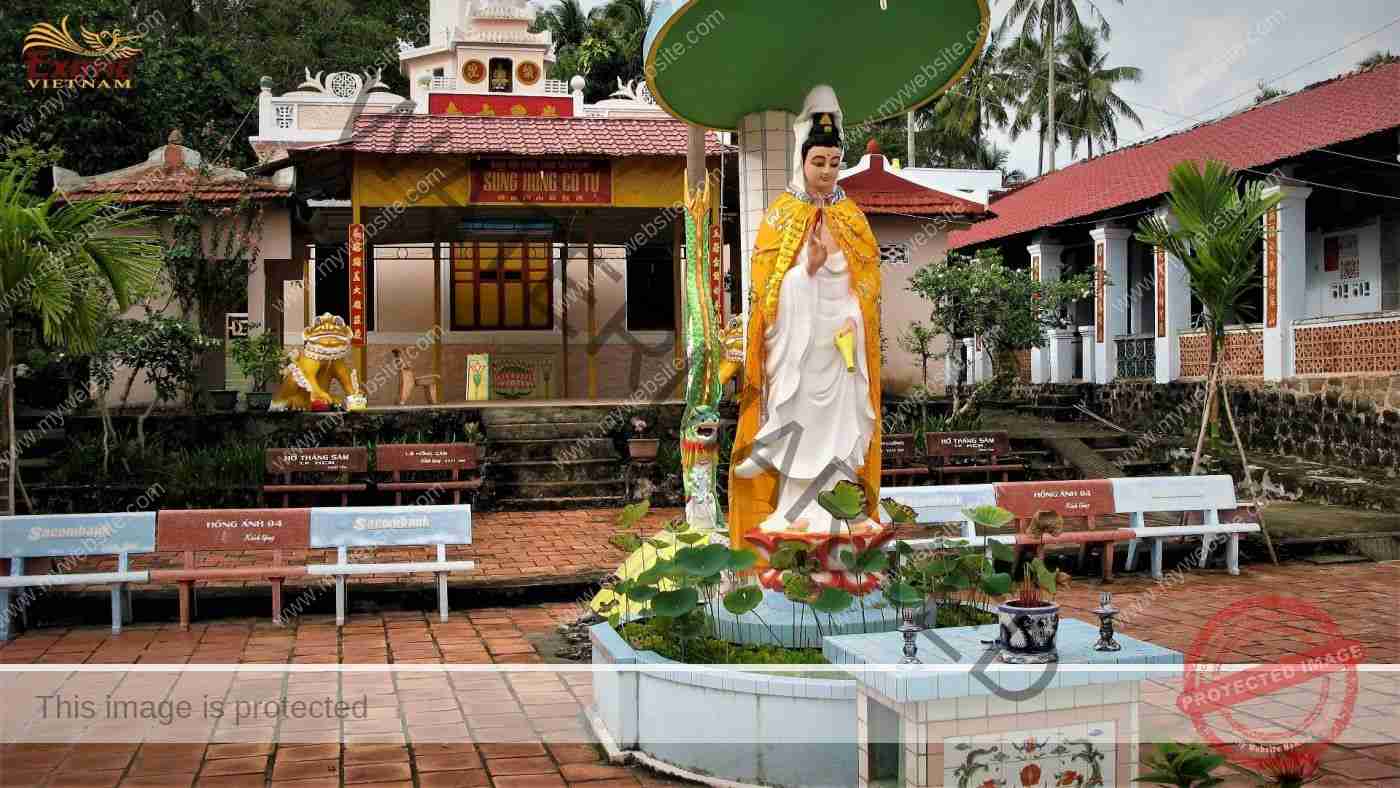
Not only is the birthplace of Cao Dai religion, Phu Quoc also has many old temples showing the people’s faith in the Buddha, helping them have a good life in the midst of strong winds and high waves. Many pagodas still retain the natural beauty which are havens of stillness for contemplation of life. Photo: Exotic Vietnam
Pagodas in Phu Quoc
Away from the hustle-bustle of the mainland, Phu Quoc is an ideal serene retreat for those who wish to while away the time in contemplation or meditation. Quite a few pagodas and shrines lie scattered across the island, in the district town and in the surrounding countryside as well.
Merged from Sung Nghia and Hung Nhan pagodas from the late 19th century, after many restorations in 1924 and 1960, the pagoda has its current state. Located at the foot of the mountain in the heart of Duong Dong town, the architectural works are built in stairs that gradually rise up along the mountainside. Behind the pedestal gate, a statue of the Goddess of Mercy stands in the middle of a lotus, next to the Bodhi tree. Going deeper to see the main hall is built on a stone foundation nearly 2m high. In the main hall there is the altar of Buddhas: Amitabha in the middle, on the left and right being Avalokitesvara and Mahasthamaprapta. Behind the main hall, Amitabha Buddha, Reclining Shakyamuni Buddha and many ancient towers are hidden in the canopy of a lush trees. Sung Hung Pagoda, with its original structure and intriguing statues, is well worth visiting.
5km from Duong Dong market, through the concrete road winding up the mountain, visitors meet a large temple located in the middle of a quiet forest, under a 300-year-old wild almond tree, konia in Vietnamese. Founded by a monk Nguyen Kim Muon in 1932, although the pagoda’s name is Hung Long Tu, but it is called Su Muon Pagoda, meaning Monk Muon’s pagoda. Everywhere offers you a lot of Buddha statues to pray for good things: a large statue of Shakyamuni Buddha in the dignified main hall, Avalokitesvara Bodhisattva and Maitreya Buddha surrounded by monks in front of the yard. Behind the temple, a statue of Shakyamuni Buddha sits in meditation by the Bodhi tree in the background of high cliffs and dense forests. Su Muon Pagoda is always an inspiration for visitors thanks to its unique blend of nature and architecture. All the rest is yours to discover and learn about the spiritual world of the islanders.

Exhibiting cruel tortures through plaster figures in a space filled with barbed wire, the Museum creates an emotion that cannot be expressed in words. It’s one of Phu Quoc Island’s most iconic landmarks, attracting mostly former prisoners and visitors who want to learn the island’s history. Photo: Exotic Vietnam
Phu Quoc Prison Museum
Located in the south of the island, 28km from Duong Dong town, this is a 20-hectare French-built prison to detain anti-French patriots. In 1956, Ngo Dinh Diem’s government repaired and established the “Coconut Tree Training Camp”. In 1967, the prison for political prisoners was built in an area of 400ha where once held nearly 40,000 prisoners, about 4,000 of whom were permanently lying here.
Surrounded by plenty of barbed wire fences from 10-15 layers with a dense lighting system, Phu Quoc prison had 12 areas numbered from 1 to 12. The additional areas as 13 and 14 were built at the end of 1972. Each area can hold about 3,000 prisoners. To guard, the prison apparatus had 4 battalions fully equipped with weapons and mobile means kept and patrolled day and night. At the sea, there was a naval convoy patrolling the outer perimeter.
Currently, only a few artifacts of the original prison remain. The prison museum with plaster figures, photos, torture tools and a monument has been newly built. In 1995, the prison was declared a national historical site and opened to the public. Visitors are impressed with the difficult life of prisoners in cramped cells, brutal punishments and extremely savage tortures they have to endure. The prison is a place to reminisce about Phu Quoc’s painful past which aims to educate current generations about the cruelty of war, be grateful to those who have fallen and appreciate the peace that everyone is enjoying.

The scenic islets of An Thoi, where are filled with an abundance of nature treasures and the warmth of its people. Freely soak up the sun on the fine sands and dip in the turquoise waters and get a taste of its local culture and cuisine. Romantic and quiet space here is waiting for your enjoyment. Photo: Exotic Vietnam
An Thoi Archipelago
Located at the southern tip of Phu Quoc island, An Thoi Archipelago has 18 islets in total as part of the UNESCO Biosphere Reserve where the nature still retains its pristine beauty with clear blue water. However, there are 5 of them have local people living. Previously, it was only possible to come here by boat, but since 2018, visitors have reached Hon Thom (Pineapple Islet) by 7,900-metre cable car. About 3km in length, Hon Thom is the largest islet in the group and is now home to a huge entertainment park. Around Hon Thom, there are pearl farms and fish farms on floating rafts where you can visit to admire the aquaculture on the water.
If you want to find secluded corners in the waters of An Thoi, head to further south about 4km from Hon Thom to the islets such as Vong, May Rut Trong, May Rut Ngoai, Rong Ngang, Gam Ghi, Xuong, Mong Tay, etc. Some of them are still really quiet and lonely, away from the crowds. These islets enchant with small beaches shaded by palms, whispering waves, turquoise waters, stunning coral reefs, and so on where you enjoy chilling on the beach, snorkeling to observe colorful sea creatures, relaxing and having a good time. Team building to promote team spirit in the tranquil and isolated settings is an interesting activity that your team mates can spend the whole day engaging in. Exotic Vietnam looks forward to welcoming your business very soon.
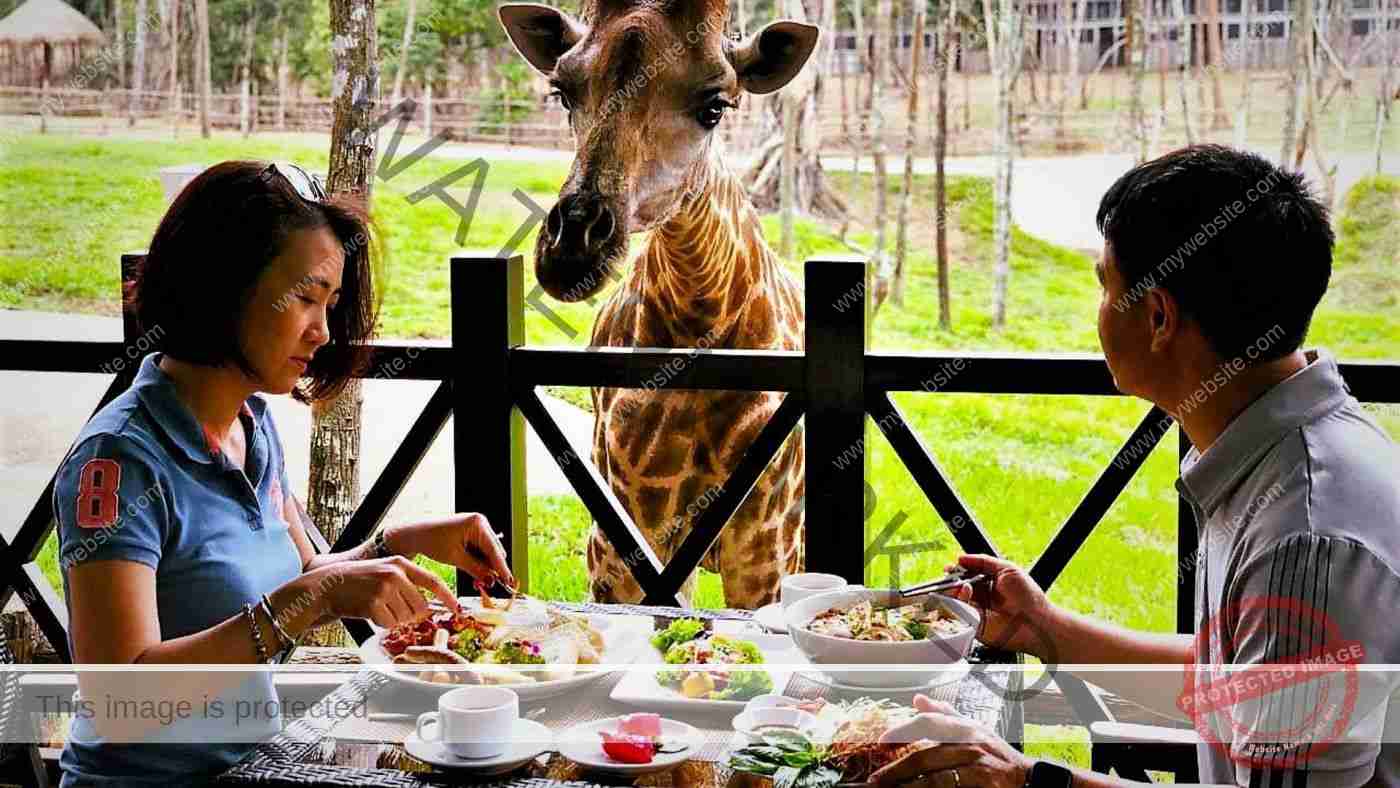
Boasting to be Viet Nam’s largest zoological park, Phu Quoc Safari collects abundant indigenous and exotic flora and fauna. Safari Park is a place you can experience an impressive journey through a fenced area, where animals roam freely within bounds and where people are “confined” to vehicles. Performances by Zulu dancers from South Africa, the animal shows same as in Thailand or Singapore or a meal before the giraffe’s daze, etc give you strange and unexpected feelings. Photo: Internet
Phu Quoc Safari
Covering a total area of nearly 380 hectares, once a part of Phu Quoc National Park, Phu Quoc Safari is home to 400 species of plants and 3,000 individuals of wildlife represent 150 different species, many of which are considered rare and threatened with extinction, in need of strict conservation.
Considered as the first semi-wild zoo in Viet Nam, this is where visitors can find Bengal tigers, Arabian gazelles, black and white lemurs, flamingos, rhinos, … in semi-natural habitats. The safari boasts of a collection of rare animals with a large number of individuals such as 200 flamingos, 100 rhinos and 60 giraffes, etc. The safari consists of two main zones: Open zoo surrounded by a moat creates habitat in harmony with nature and bring visitors the most authentic sight; and Safari Park where visitors can watch wildlife by specialized vehicles. Visitors also will have chance to experience many periodic activities such as watching animal performances, taking photograph with animals and mascots, kneading coloured dough into coloured paste animals, etc.
Although safari park markets themselves as more “natural” by giving animals more living space, this business is really harming the animals and the natural environment of Phu Quoc National Park.



















































































































































































































